
























Blending a cast into a cohesive team is a challenge for any director. Playwright Steve Pirie shared his tips with delegates at the 2024 Drama Queensland conference, as edited by Isabella Nocetti.
Aim to cast the spell, empower the artistry, and connect your artists with the story.
Theatre has the power to bring people into a vision of something new, exciting and engaging. To guide an ensemble through this process, think back to moments where you felt the spell of theatre take you. What was the hoy you felt, where did it come from, and how can you lead with this at the front of your mind for an ensemble? In the early days of your process together, you lead the culture in the room until you find a common ground together. Be open to transformation in the space.
There are many outcomes that can come from theatre, and these outcomes shift and change as objectives change manage your expectations accordingly. Is the purpose of this group coming together for training, performing or a blend?
Model the respect you have for the rehearsal room with your ensemble. Everyone is responsible for the physical space itself. Whether you find yourself in a fully equipped rehearsal room or a community hall before the local karate class takes over, establish as a group how you want to take care of this space. Keep furniture and clutter to a minimum, return things where you found them. You might think this is a redundant point, but the simple quiet ritual of sweeping a space together becomes a part of the language you develop together.
Find people who value working in teams, are open to change, are dedicated to the process of collaboration, and enjoy what they’re doing.
We’re rarely gifted with an abundance of time during a rehearsal process and working with large groups of people there’s less time in
the rehearsal space to get to know people. As a starting point, working from archetypes is a shorthand to understanding the mechanics of an ensemble’s needs. You might need Rebels, who are good observers, hold their own opinions and excellent leaders against a common struggle. In classroom settings, skeptics are common those who we think are a disadvantage with their hesitance, but who could be analytical and pay close attention to detail. Skeptics can make excellent dramaturgs. When it comes to a group’s energy, Sparks boost morale and take on responsibilities as rewards rather than burdens. If these don’t work for you, work from what you know. Are you an astrology fan? Meyers-Briggs? Use what you know to find balance in your ensemble. In an audition process, we’re not just looking for ability and suitability, but whether people are capable of simply being in a space together, listening and responding. A way to figure out who those people are is by
hosting simple consent-based exercises at the beginning of an audition and seeing who is open to the idea of the exercise and enjoying it, and who may need time to process. People who are comfortable saying yes (and no) when it’s needed is the mark of an ensemble member with potential.
The pros and cons of writing an original play or using a play text.
Existing texts:
Pros: An existing text allows you as the director to apply your vision with the ensemble’s assistance. This is not a new work, but something that has been rigorously developed. Good for you!
Cons: Selection of the play is not a democratic process. Finding work for your cast size is rarely spot on this is particularly true in large settings such as classrooms or after school organisations where there may be many more people in the ensemble than the work calls for. Cast your work creatively.
Devised work:
Pros: Ownership of ideas: for better and for worse, it’s your idea. Devised or new work allows access to the full scale of talents from the
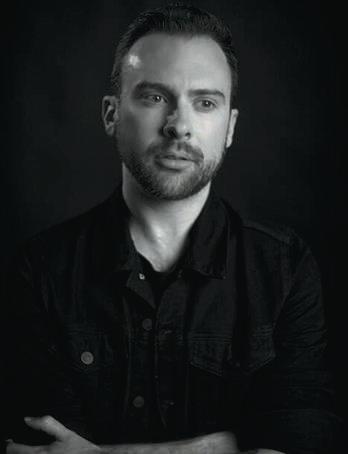
ensemble. Creating something from nothing is intensely rewarding and can allow your ensemble to shine in a way they may not be able to in other works.
Cons: Remember when I said we rarely have enough time? This process needs time. Not only that, but it can also be easy to doubt yourself without knowing your idea is proven. You’re in uncharted territory make sure you allow your ensemble to sit in the scariness of making something new, but not for too long. Lead them out of the darkness, you visionary, you.
Devoting time to building an ensemble helps host one’s event. There’s that word again. Time. Allow space for your cast to get to know each other, and you. Make sure you’re giving your attention to each ensemble member. Remember, you are curating their experience as much as yours in a rehearsal process. It’s like any good dinner party know when to let moments breathe in the night, when you’re not needed as the host, and when you need to nudge the night along.
As someone who’s worked with young people learning their craft for a good part of my career, I’ve never failed to be impressed by their insight. One particular group I was assigned was packed with deep thinkers who loved to talk about the big things. When deciding what I wanted to give
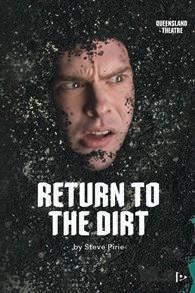
to them to perform, I wanted to challenge them to perform something impossible. I ended up adapting a version of A Dream Play, by August Strindberg. A play famously referred to as unstageable, the text is a mystery to most who pick it up, and the name tells you so after all, the impetus is to place a dream on stage in front of an audience. I was open with my cast of young performers about the height of the mountain I wanted them to climb. I spoke about the play’s Expressionistic roots, and how that philosophy of image and feeling and spirit seems to be coming back in today’s age of Big Mood. They took complete ownership of it. It was a mountain to climb. They supported each other, and me, to get there.
When I look back on it, the show itself by my own standard was okay (it might surprise you by now, but I would have loved more time). But in this context, it doesn’t matter what it is to me. It was for them.
That cast has grown up a little more now. A lot of them are studying some are studying acting, some are living their lives down other paths. I hope that they remember how doing this production and how being in this ensemble made them feel to be part of something that they made together.
When we boil it down, we tell stories in a space with people, for people. That’s it, really. And creating a small, impermanent community of storytellers is something I’d always make time for.
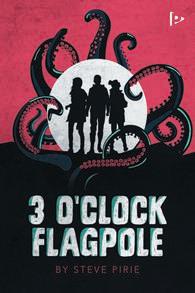
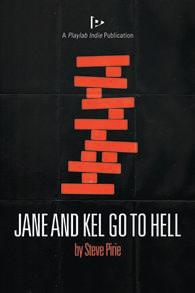
Steve Pirie is a writer, theatre maker and youth arts worker currently based in Brisbane. He was winner of the 2020-21 Queensland Drama Award. His published plays Return to the Dirt, 3 O’Clock Flagpole and Jane and Kel Go To Hell are available from booknook.com.au.
They are a growing and popular phenomenon around Australia, particularly in winter months. One outdoor festival which was literally on fire was Taste Sorrento in Melbourne. David Spicer spoke to the chamber of commerce that commissioned it and Outlook Communications who ran it.
Whether it is the VIVID drone show in Sydney, which attracted crowds so large that it left the city with pedestrian gridlock, or regional and suburban centres, free mid-winter festivals are taking off.
For traders on the Mornington Peninsula, winter is ‘brutally’ dead, and never more so as the freezing chills sink in during June when daylight hours are shortest. So last year the local chamber of commerce revived Taste Sorrento, a celebration of local produce, services and experiences.
“Taste Sorrento is banner. It’s not just food and beverage, but the gallery had events, there were movies, MasterChef at the RSL and the launch of new retail products,” said Sorrento Chamber of Commerce President Krysten Le-Marshall.
The main attraction was a Winter Solstice Fire Night on the foreshore, under the full moon, which combined fire, street stalls and live music.
Jack Jones from Outlook Communications said, “The pinnacle of the evening was the lighting of a six-metre Burning effigy, symbolising the transition from the longest night of the year to the promise of summer’s return.
“The effigy, created by Sculptor/ Fabricator Derek John from djprojects and ‘& Gallery Australia’ featured a steel structure with timber slats for burning. The design means Burnie will make a return every year with a new timber suit ready to burn.”
The chamber of commerce was delighted by the turnout and the thirty-minute highlight of the effigy, that ‘burned perfectly’.
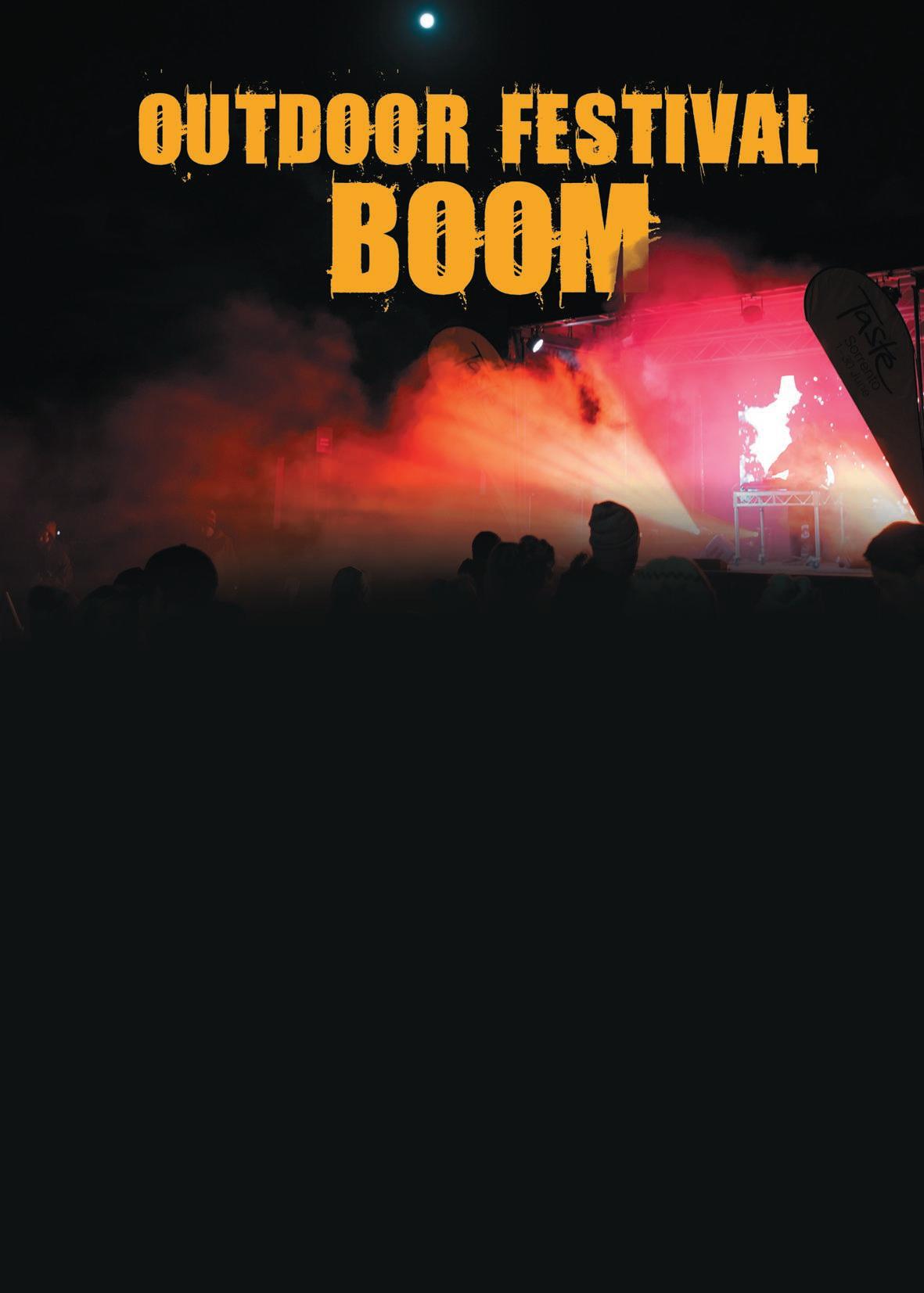
“There were lots of fires on the foreshore and performances leading to the ignition. We had three to four thousand people attend. The whole town came to life,” said Le-Marshall.
“Every vendor sold out. When the beer ran dry, the pub offered [replacement] slabs.”
The Chamber of Commerce is now planning to make it a weekend celebration next year and has its eyes on a Christmas event.
For Outlook Communications, setting up the event was a major undertaking requiring a bump-in on one day, 150 hours of labour and no environmental impact.
The company filled two x 3 tonne trucks with sound and light gear, two generators, a six-metre by four-metre trailer stage, and it worked with Blaso Pyrotechnics to supply 12 fire cannons.
“As it is outside and was just a massive site with limited security and masses of people, it was very hard to keep track of equipment. All our lighting equipment was from Beamz

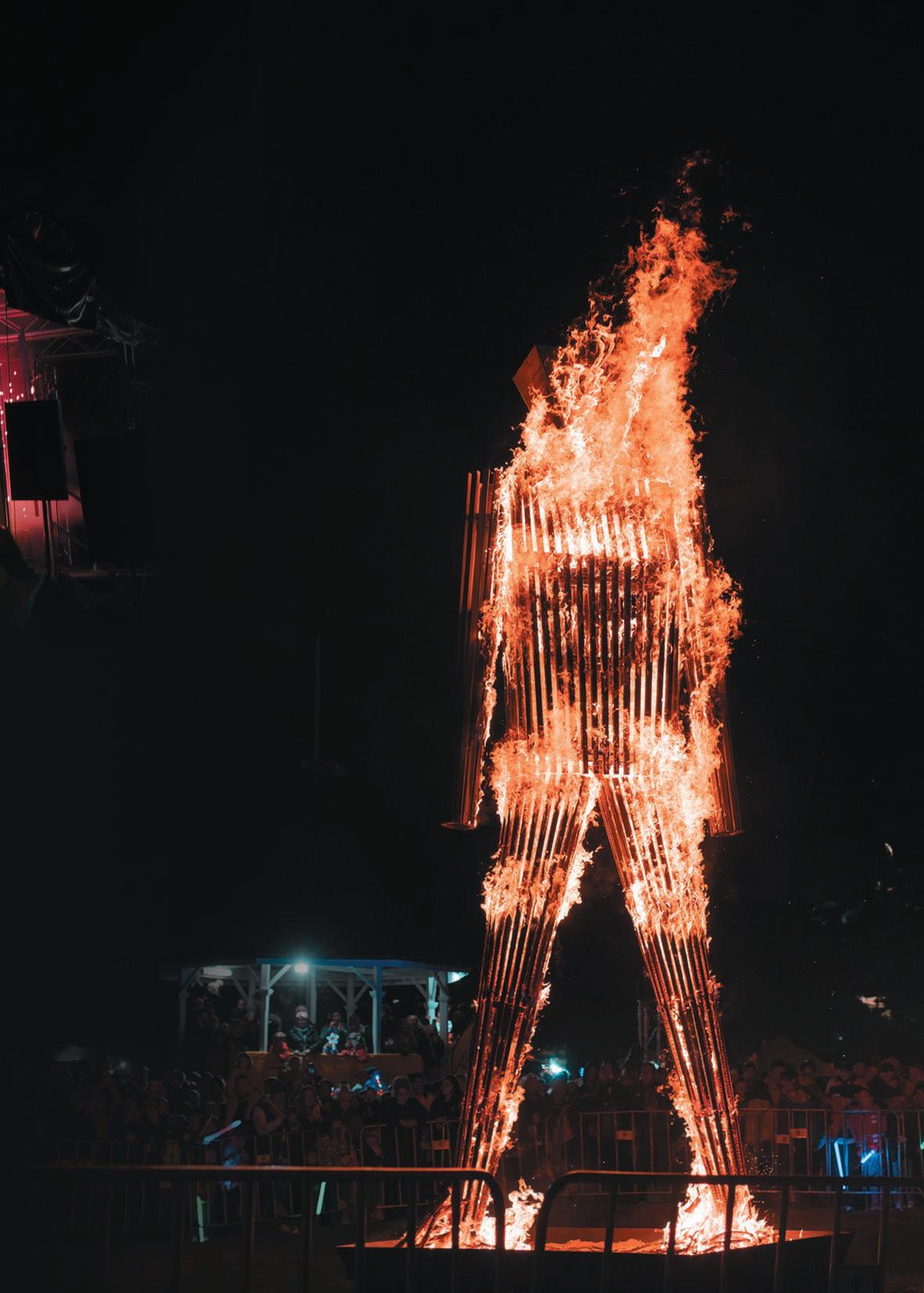
See how Outlook Communications helped light up Taste Sorrento youtu.be/FS8Bz8MQXeU
Pro and was up-rated just in case we had a few showers throughout the day,” said Jones.
“The remote lighting away from the stage was all battery operated so we did not have to create any safety risks by running power cords everywhere.”
With big, ticketed music festivals on the decline, the free community events are becoming an alternative source of work for the industry.
“We look forward to our continuing relationship with the Chamber of Commerce into the future.
“The next outdoor festival that Outlook is proudly supporting is the Murtoa Big Weekend festival from October 4 to 6.”
Find out how Outlook Communications can help with your next event or production. outlookcomms.com.au
Mah, Meh, Mee, Maw, Moo. Brushing the Teeth. Slides Hum to Open Vowel. The Range Rover on Ah. The Apple Nah Twang Triads. These are all warmup exercises on a new album.
Music theatre performers across Australia are using a new tool to fuel their show-stopping performances.
If you have ever been backstage in the theatre during the half hour before a musical begins, you will know that each performer has their own routine before the show starts.
Many actors are full of superstitions: don’t say good luck, only break a leg; knock three times on the door when leaving the dressing room and God forbid if you whistle!
These can vary for every actor but one thing everyone actor does is a vocal warm up. To help performers warm-up their voices, musical theatre performer Queenie van de Zandt has teamed up with her long-time friend, fellow performer and Sydney singing teacher Beth Daly to create an album of singing and vocal warm-up exercises to help professionals and amateurs alike develop their vocal skills.
The album, Singing & Vocal WarmUp Exercises, features a collection of exercises designed to help performers develop their vocal range, pitch and control vibrato, as well as develop a healthy belt.
Queenie was inspired to create the album after using Beth’s exercises in her own training and seeing remarkable results.
“I am a self-taught singer who only had a handful of lessons in my life, but luckily those lessons were
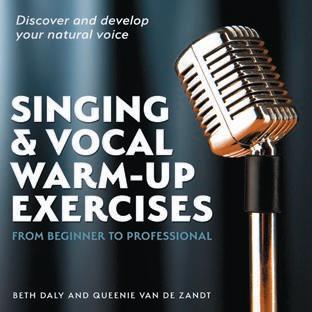
with my friend Beth Daly,” said Queenie.
“Beth is not only a brilliant musical theatre performer and writer but also one of Sydney’s most sought-after singing teachers. I loved Beth’s exercises; they really helped me develop my range, stamina and most importantly my belt!
“So, when I began teaching myself, I used her exercises and then
vocal expertise of Queenie and Beth. Having these exercises on hand is a wonderful tool for any singer,” said Lucy.
“Excellence in all performance training requires preparation and exercise specificity and vocal training is no exception,” explains Dr Debbie Phyland, Voice Medicine Australia’s Speech Pathologist & Voice Consultant, who regularly works with
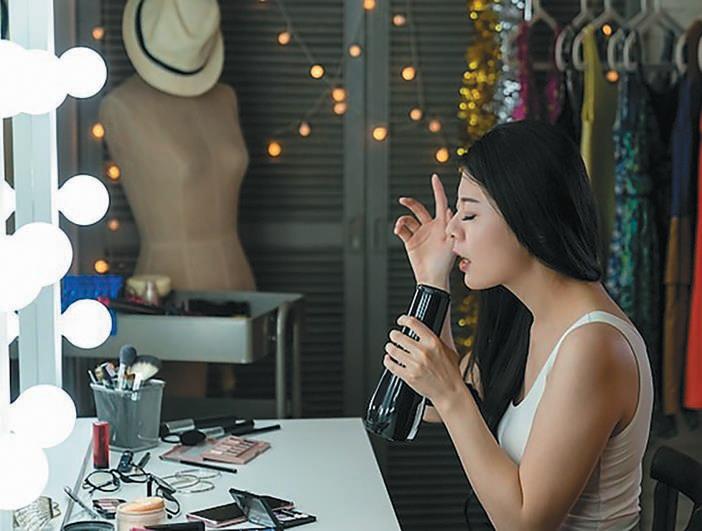
developed them further with my own students. Both our students started asking for a copy of the exercises, so Beth and I decided to record an album together and Singing & Vocal Warm-Up Exercises is the result.”
The album has received glowing reviews from industry professionals across Australia, such as Lucy Maunder, currently playing Roxie Hart in Chicago:
“You couldn’t be in safer hands than with the incredible skills and
performers on shows such as Moulin Rouge and Mamma Mia!
“These excellent exercises will not only have you ready to sing well but are sure to increase your vocal fitness over time too!”
So, whether you’re a ‘have a warble in the shower’ kind of singer or ‘you bring the house down in Hamilton’ kind of singer, Singing & Vocal Warm-Up Exercises can help you develop your voice to be the best it can be.
Kevin Liu from Transtage explains how straightforward it is to assemble your own theatre seating riser.
Creating a seating riser for your theatre or performance space has never been easier than with Transtage’s modular stage panels. Unlike permanent seating, which can be expensive and limited by building constraints, the Transtage seating solution is budget-friendly and quick to set up.
Our modular stage sections are designed with flexibility in mind, offering various height options. Much like building with LEGO, you can configure your seating to the exact length and height required to fit your space. The system allows for easy expansion or reduction by simply adding or removing panels as needed.
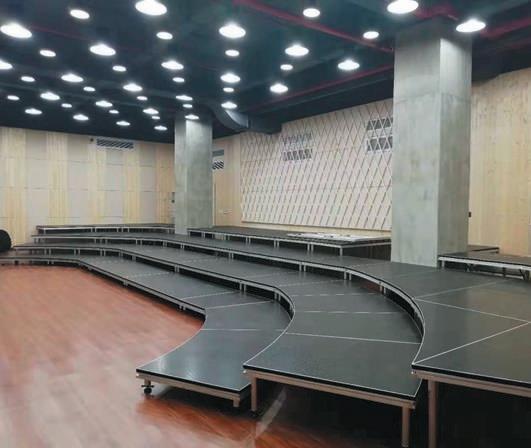

Assembly is a breeze no need for professional builders or tradespeople. In fact, most of our customers can set up seating for 80 to 100 people in just a few hours.
Transform any space into a stunning venue with Transtage’s Modular Seating Riser.
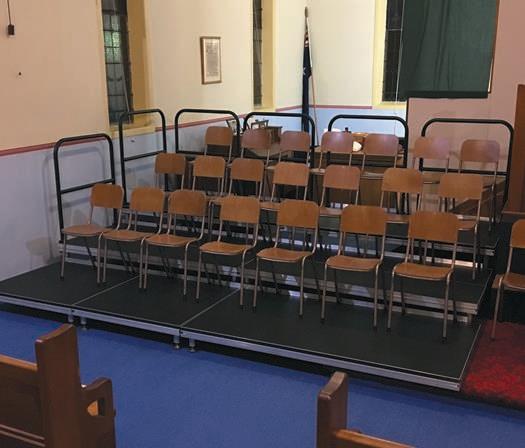

For two years, an Adelaide youth theatre company workshopped stories about teenagers lying about their age to enlist in WW1, creating a production described as having exceptional professionalism and dedication. Barry Hill spoke to director/writer Sean Riley and designer Kim Liotta.
Sean Riley: “I read a true story about a NSW schoolteacher who overheard one of his favourite students telling his classmates that he was going to enlist (in WWI) illegally in another town. His teacher said, ‘I’ll come with you, and we’ll go together.’ So (both) signed up, and then the teacher went back to tell the boy’s parents. They told him, ‘You’d better make sure you bring him back!’ So, I dropped this concept on my youth theatre group who were excited and primed. That was two years ago!”
Riley said the play took audiences from a fictional town of St Jude “to
No Man’s Land, an army hospital behind the frontlines, northern France and the trenches.” It also shared the perspective of female characters and explored the lives of those left at home.
The boys’ stories were brought to life through a mix of soliloquies, dialogue scenes, period-accurate costuming, an original soundtrack and film projection.
I asked Sean how members of his drama academy, aged 7 to 23, took on a challenge of a new work with such serious subject matter.
“With the company, we always
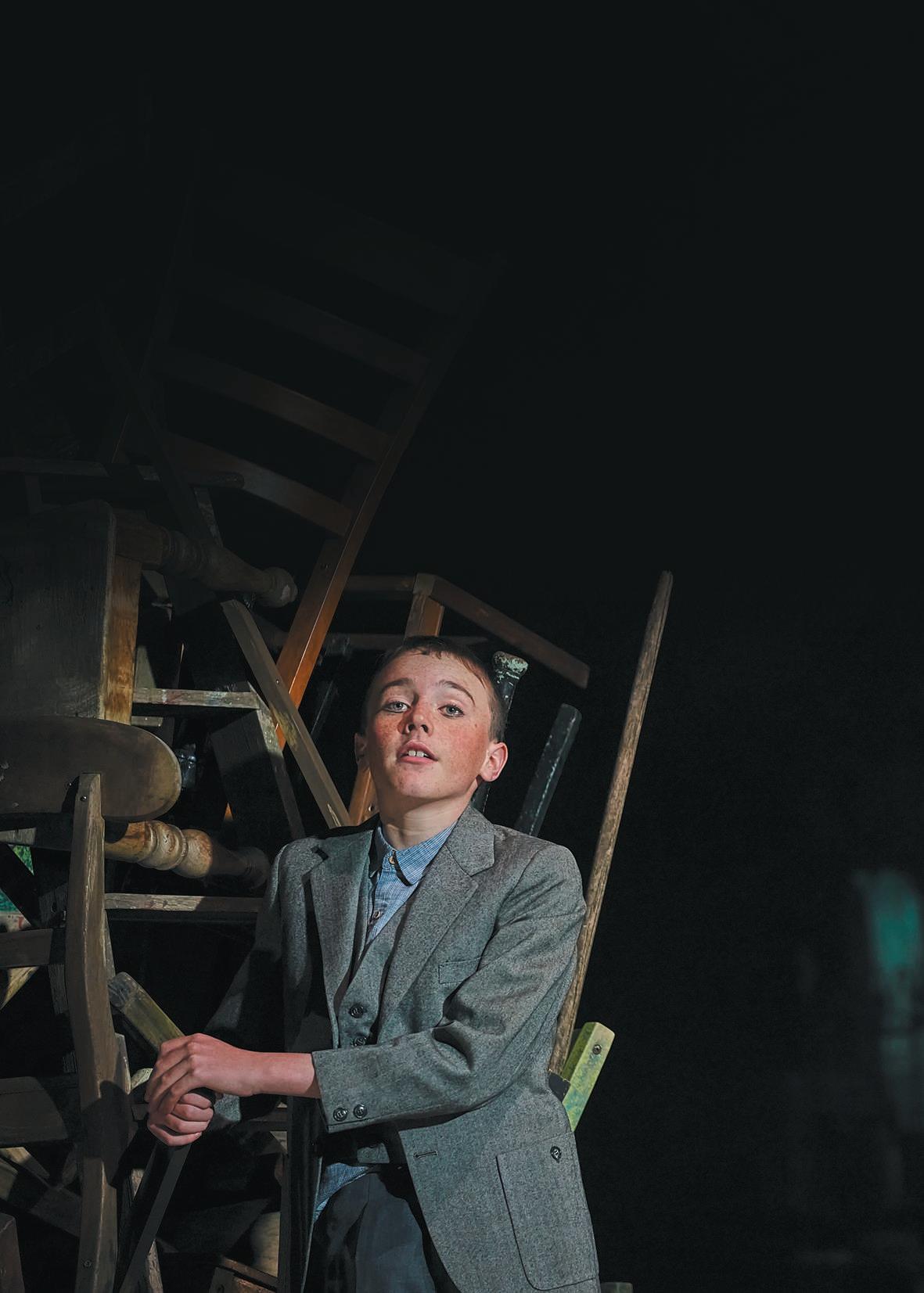
develop work. It’s very rare I bring a script in. I like developing it over a long time.”
He went on to explain, “Most companies do ‘quick fixes’ (shows in short periods of time), but I’m not into that good work takes time! Discussions went backwards and forwards, so that when the script was written it was not alien to them. They had improvised scenes which I linked together, and they spring-boarded from that. So, it became a sense of ownership.”
“The range of cast experience was varied. Some of the students had never performed before and getting close to the performances they were like ‘rabbits in the headlights’. They didn’t know basic stage terms like ‘curtain call’ or footlights. In fact, one of the boys thought it must be a light, shaped like a foot!”
Naturally there were some changes as the show evolved over the years; one boy’s voice broke and the cast grew in stature. However, Riley was not concerned. “It was their ownership; they were in it! They had improvised it for two years. The cast did not worry me at all! In the rehearsal room I would say, I want to start a rehearsal in five minutes total silence, I turned around, and they were all ready!”
The discussion then turned to the design of the play, which was a combination of Kim Liotta’s set and the students’ filming and soundscape. There was a pile of chairs on one side of the stage that was scaled several times by the narrator a little boy. Liotta described the concept of his
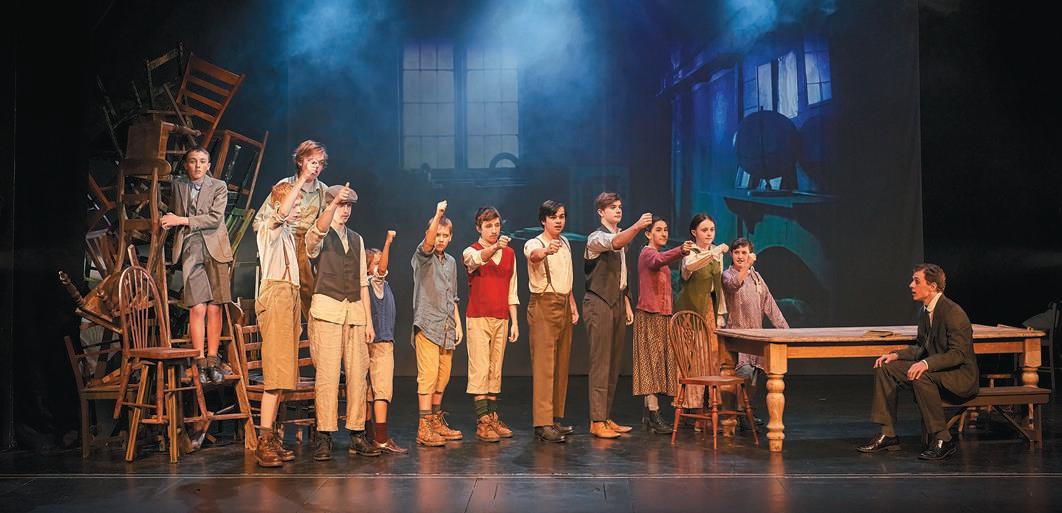
Presented by Free Agents Youth Theatre. Goodwood Theatre and Studios, South Australia, June 13 to 15.
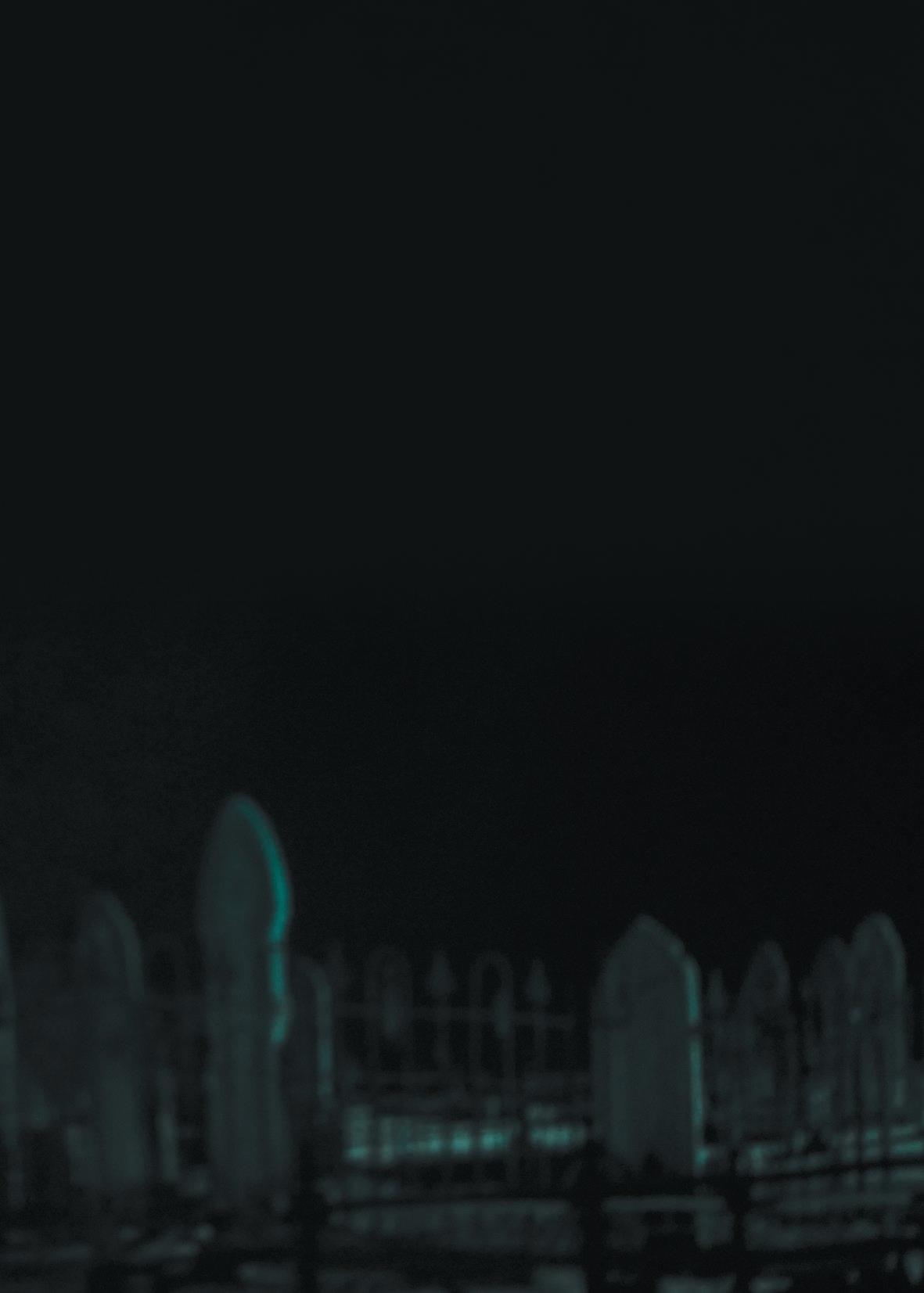
design.
“The world has exploded, and everything is a mess. I wanted to also signify something spiritual up high, but I found out a week before that the boy playing the narrator was afraid of heights. So, I made little handholds for him to hang on to and feel safe. I adapted the set to suit. I even put him in little ballet flats so he could feel what was under his feet. I also wanted the light to come through the structure, so that there would be a halo sort of effect.
“I wanted to keep it simple because the projections (created by students) were so good (they included a country town, battlefield and inside a farmhouse). My philosophy is to recycle everything. I didn’t buy anything new as there is so much waste in theatre. The only thing I hired was the nurse’s outfit, because it would cost more to make than to hire.”
The uniforms came from the Keswick army barracks (WW1 collection). When asked how they got them to fit the kids, Sean was quick to reply, “All the uniforms were small and heavy. It was an amazing resource.”
Student Reaction
I was interested to hear any feedback from the students after the production.
Sean told me, “It was a turning point because when you’re with young people, what they achieve means everything. One of the boys was very soft at the beginning of the process. At the end he declared that he learnt to be loud!”
Another boy feels it has cemented his desire to be in the acting world. One of the students did all the film editing work and the composer was 15 years old. After reading the script he asked for ideas and “then every week for next three weeks, he (delivered soundscapes) and it was performed just as he presented it. It was immaculate!”
Finally, I asked if there were any surprises during production. Both Sean and Kim had their share. They observed that their students’ confidence developed as the show progressed and they kept getting better.
Sean said, “One night the screen went blank and there was three minutes of technical error, and you felt the cast galvanise…they lifted the energy.
“My surprise was that it was so
professional, and they were so supportive…they were an ensemble.”
A gut-wrenching moment for me was the boys calling for their mothers when faced with the barbarity of war.
Lambs was a landmark in youth theatre that packed a massive punch emotionally and visually, with a message that is still relevant today. As was written in the program, “Behind the work is the failure of adults to protect children. And World War I is the example of that.”
Riley’s writing and direction was sensitive and ‘in your face’, bringing to life the innocence of children, the horror of the trenches where boys fought and witnessed atrocities alongside grown men, and their return to a country forever changed by war.
So, what can other companies learn from this ground-breaking youth theatre company? Sean puts it best when he says, “My big thing is emotional truth, that’s what I spend most time on…I want for the audience, when they come and see our show, that the experience is above and beyond…it’s the energy and joy!
Lesley Reed and team transformed an Adelaide church hall into a window to the universe for St Jude’s Players’ production of Silent Sky by Lauren Gunderson.
The Beginning
I admired Lauren Gunderson’s Silent Sky from my first reading. As I fell in love with it, I began to believe it is a classic in the making celebrating the history-making endeavours of Henrietta Leavitt, a brilliant woman who, in the early 1900s, did not receive the kudos from her peers she deserved.
Happily, St Jude’s Players chose it for the August slot in the company’s 75th (Diamond) Anniversary season, 2024.
Silent Sky was written by Lauren Gunderson one of America’s mostproduced contemporary playwrights, known for her interest in historical events and strong women.
The play includes a perfect balance of human drama and historical and scientific fact, a stirring story spiced with humour and poignancy.
Now hailed as an early 1900s astronomer ahead of her time, Henrietta Leavitt's status in her first job at Harvard Observatory is far below that of the observatory’s male astronomers. Leavitt was driven by an obsessive work ethic to follow her dream, despite the odds against her succeeding in a historically male scientific field. As she catalogues the stars, her immersion in her discoveries impacts her relationships with family, colleagues and a new-found love. At
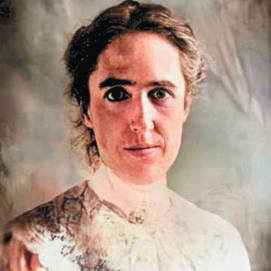

last, Henrietta makes a profound discovery that forever changes scientific understanding of the breadth of the universe.
Lauren Gunderson meticulously researched the personal and scientific history of Henrietta Leavitt and the times in which she lived. Whilst the play includes dramatic licence, it never compromises the scientific fact, and yet includes it in a way that is never dry and within a lay person’s understanding. My vision for Silent Sky was to be true to this perspective, and for the characters to be so relatable, the story so real and immersive, the planetary effects as well as Jenny Giering’s original music so enveloping, that the awesome against-the-odds achievements by Henrietta Leavitt and her female colleagues would take each consecutive audience’s collective breath away by the final scene. Informing the vision:
An amazing true story Born in 1868, Henrietta Leavitt graduated from Radcliffe College in 1892. She eventually gained a permanent position at Harvard Observatory as a ‘computer’ in an allfemale work room, under the direction of Harvard Observatory’s Professor Edward C. Pickering. Henrietta’s routine work involved cataloguing the thousands of stars
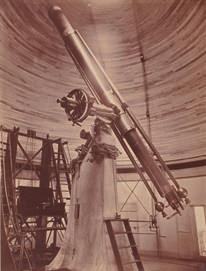
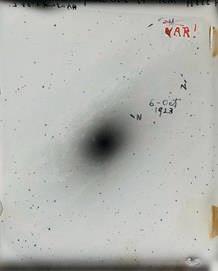
captured in vague black dots on glass photographic plates by The Great Refractor telescope.
Henrietta became interested in Cepheid variables (pulsating stars). In the male-dominated field of astronomy, her research was not taken seriously at first. After all, women still hadn’t even gained the right to vote. Against the odds, she devised scientific standards that enabled astronomers such as Edwin Hubble to determine how far away variable stars were and the distances of the star clusters and galaxies in which these stars were observed. The potential breadth of the universe was now revealed to science. It was astonishing and revelatory, stirring the beginnings of new horizons in space endeavour.
Sickly throughout her life and deaf due to this, Henrietta died in 1921. She received little acknowledgement of her work from other astronomers in her lifetime but was nominated after her death for a Nobel Prize.
The main settings in Silent Sky include an ever-present northern hemisphere starfield, as well as the Harvard Observatory plate room, the Leavitt home in Wisconsin, and Henrietta's house in Cambridge, MA. All of these needed to be present on the small stage throughout, as scenes in the script flow into each other rapidly and sometimes with time periods changing within a single monologue or scene. Other settings are an ocean liner deck, a Harvard lecture theatre and ‘letter-reading’ scenes, which we treated in an abstract way. The set designer Don Oakley created a deceptively simple, excellent set. The workroom was denoted by desks and chairs set in the narrow central space forward of the proscenium arch. Built by Dean Taylor, a member of the set build team, and looming behind the workroom on a raised dais was a replica of the original refractor telescope, The Great Refractor.
At one side of the stage, a baby grand (replica) piano and stool represented Henrietta’s Wisconsin
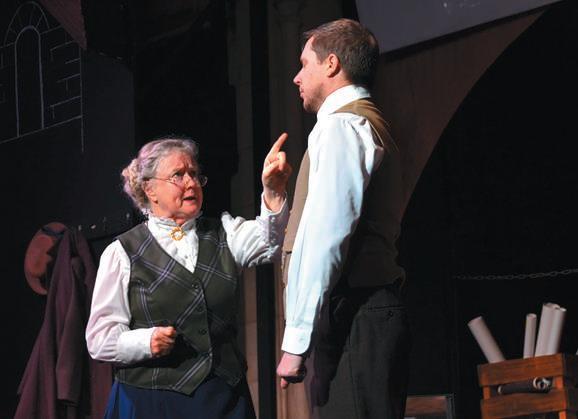
home, a cross on the wall above it showing the significance of faith, not science, in this daughter of a Massachusetts minister’s early home life. At the other side, a simple leather armchair, crocheted blanket and a side table denoted Henrietta’s later sickly life in her final residence in Cambridge, MA. The deck of an ocean liner was a position on stage denoted by spot lighting and ocean sound effects, with a Harvard lecture theatre represented front of stage by spot lighting and a lectern. In addition, ‘letter scene’ effects were created by spots for key positions on stage. Projection was used to ‘cradle the stage by stars’.
Projection, Music, Sound, Costumes and Props
Main challenge to the vision: A stage ‘cradled by stars’ Lauren Gunderson makes it clear that the stage on which any Silent Sky season takes place must be ‘cradled by stars’ for the entirety of each performance. Although Silent Sky has mostly been performed in modern venues where ‘surround’ projection can be effectively used to envelop the performance space with a range of astronomical images, we were to perform the play on a small stage in an aging church hall. However, I was not deterred as the St Jude’s Players’ technical team was experienced in such challenges. A screen was suspended above the apron of the stage onto which several moving and still images were projected, all gained
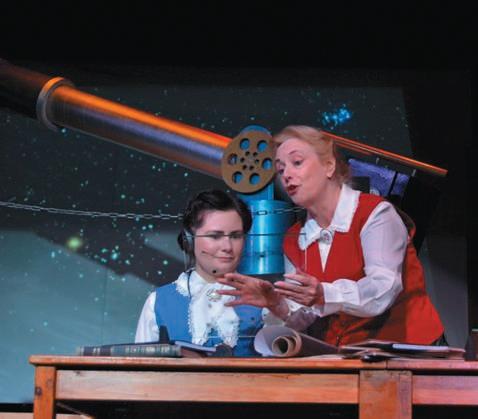
from NASA public files, the Harvard Observatory Museum public files, and public images from Unsplash Free Photos. These were repeated on a scrim beyond the large ‘telescope’ prop, as if the telescope was aimed at the stars. The result was stunning, with synchronised projection at both the front and rear of the stage.
Sound and music
Troubling and persistent sound interference occurred throughout the rehearsal period. Some brilliant forensic detective work by sound operator, Thomas Batten ultimately solved this on the brink of opening night. Jenny Giering’s original piano music files for the play, for which St Jude’s Players had the foresight to purchase the Rights, beautifully complemented the play’s action and it was a treat for amateur actors and the tech team to work with such music throughout, down to the timing of individual notes denoting the blink of a single star.
Costumes and props
Very fine 1900s costumes resulted from meticulous research and skilled work by Rosemary Taylor and her team of Anna Siebert and Jill Wheatley, including very good dressmaking from Anna.
Props were carefully designed to mirror the early 1900s reality, including glass replica scientific plates and Henrietta’s hearing device.
The excellent cast included Brittany Daw in the pivotal role of Henrietta
Director’s Diary

Leavitt, Tianna Cooper as her sister Margaret (a compilation of people in Henrietta’s real family), Deborah Walsh as fiery and sharp-tongued colleague Annie Jump Cannon, with Joanne St Clair as the witty Scots colleague, Williamina Fleming. Josh van’t Padje played astronomer Peter (a character created by the playwright and not based on history). All actors embraced my vision and produced performances of which I was very proud and that generated enthusiastic audiences and excellent critical response.
In addition to wonderful audience response, with many saying the production was ‘surprising’ in that its science didn’t confuse at all, critics loved the show.
‘Director Reed has gently guided her small cast to tell these great stories so skilfully. They’re supported by another excellent Don Oakley set…’ -Stage Whispers
‘An inspiring, witty, and warm depiction of the challenges women face in following their dreams…’
-What’s The Show
I believe this production of Lauren Gunderson’s Silent Sky achieved my director’s vision to take each consecutive audience’s breath away at the human achievement depicted, the performances and the production values. It certainly remains with me as a favourite directing experience.
Each year the Sydney Festival stages 90 productions in 30 days. John Bayley, the Head of Production, is in charge of keeping the cast, crew and audience safe. He shared his tips on stage safety during a Stage Whispers TV live webinar sponsored by The Association of Community Theatre and Marsh Insurance.
“The first thing is to take responsibility for the fact that you’re going to have some risks,” John Bayley warns, “so you need to plan for those.”
He recommends thinking about and identifying risks when designing a show, when you first get to a theatre, and during bump-in. It’s imperative that a written record be made of these risks (i.e. with a checklist), the impact of them be reduced, and that any unavoidable or newly discovered risk is properly communicated.
“At the Sydney Festival we have what we call a ‘toolbox talk’, where at the beginning of the day everyone gets together to talk about risk.
“The other thing to remember is that the show does not have to go on. All companies should rehearse a show stop if an imminent threat to safety is identified during a performance.”
Marsh Insurance, which offers a public liability insurance scheme in conjunction with The Association of

Community Theatre, recommends all on stage watch out for the following:
Personal injuries: Slips, trips and falls
Spilled drinks, food, water leaks and wet floors.
Wires and cables running along the ground.
Props and other items in thoroughfares.
Steps are lit, have contrasting edges and handrails.
Overhead props, lighting and sound
Make sure equipment is properly secured, and check danger areas before raising/lowering.
Fire hazards
Heat sources near flammables, including heat from lighting and sound.
Electrical components tested and tagged. Connections are secure and fitted correctly.
Pyrotechnics, flares, and other naked flames are a fire hazard.





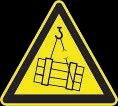



Catch the webinar with John Bayley on Stage Whispers TV. Scan or visit fb.watch/leqTY9HEOe

“When you first bring a cast on stage they are thinking about other things,” John explains. “The microphone is there temporarily, but if it was a fixture the cable should have tape over it to reduce the trip hazard. There are also loose chairs. They should always be taped or cable tied together in groups of at least four, in case the audience has to leave quickly.”
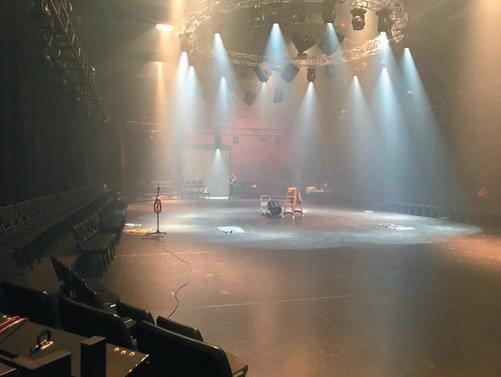
“We require people at Sydney Festival to wear a high vis vest, whether they are inside or outside,” John says. “As you can see, people are not visible. High vis vests are very cheap and we use them at the Sydney Festival because it reminds them of the situation they are in.”
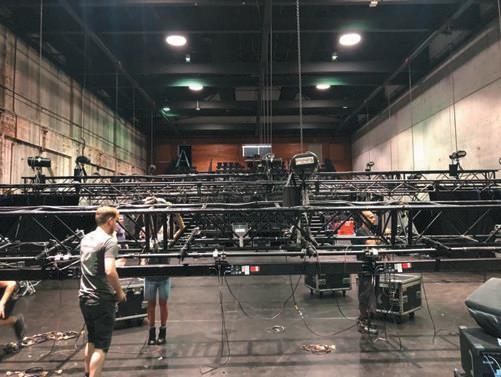
“The dangers include getting up ladders using tools and machinery,” John warns. “People on stage may not be aware of the live edge. If you see that orange line, that is the top of a fence that the STC puts in. If you step off, you would have something to grab onto. This is worth doing at a Bump-In, even if it is just a line as a visual prompt to the danger.”
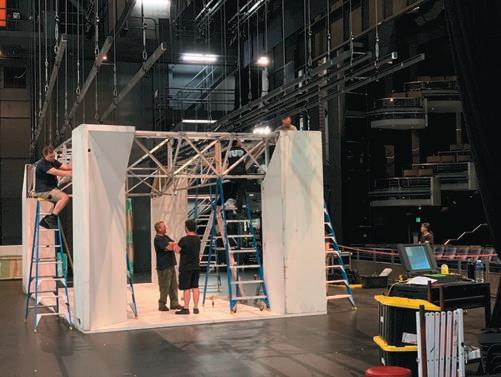
In this picture, John explains a production specific safety measure for Manifesto.
“The designer wanted a nice row of curtains behind nine drummers on raised platforms. We installed a railing behind the platforms so that the drummers would have something to hold onto when they stepped back.”
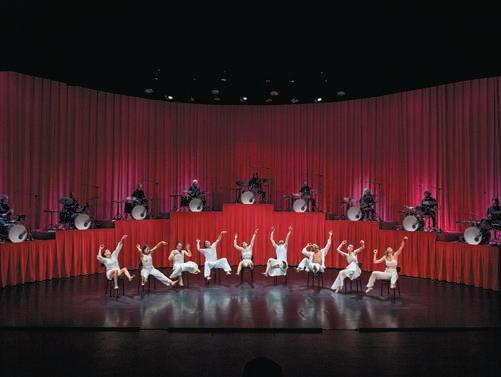
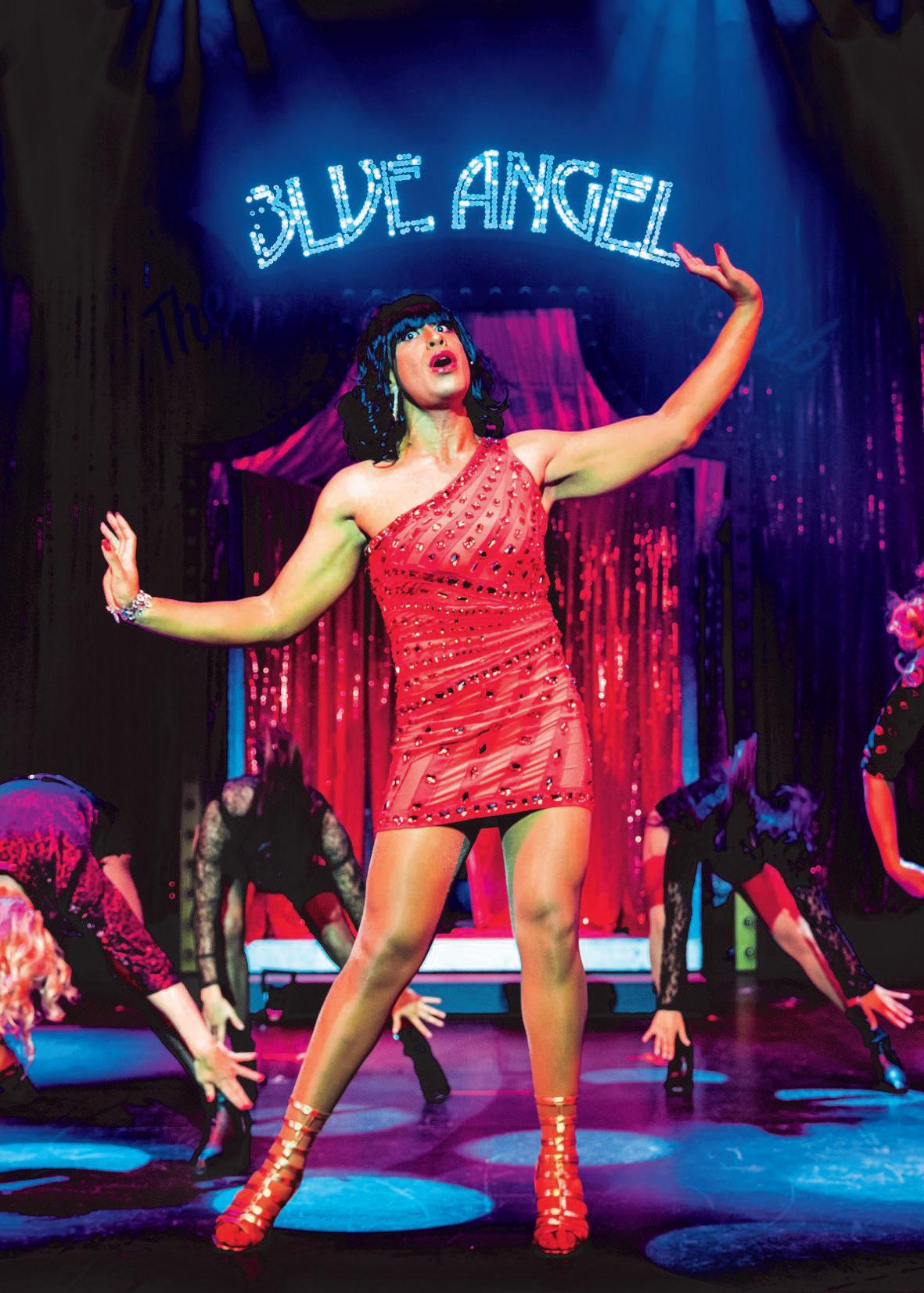

See more listings online at bit.ly/2nEEIxv
Australian Plays
Australian Plays is a national organisation based in Hobart, a not-forprofit incorporated association providing services to playwrights bypublishing and licensing plays and by promoting and supporting their work with producers and educators nationally and internationally. Founded in 1979, we constantly seek ways to maximise our resources and find innovative ways to promote, curate, connect and champion Australian plays and playwrights. australianplays.org
David Spicer Productions
David Spicer Productions manages the rights to Musicals and Plays in Australia and New Zealand suitable for small or large cast. Genres include Australian musicals, Rock Musicals, Juke-Box Musicals, Operetta, Farce, Dinner Theatre, Drama, Comedy, Pantomime and Youth theatre.


The company’s most popular shows in 2019 were We Will Rock You, Back to the 80’s, Ladies in Black, Masquerade, Popstars, The Boy From Oz, Disco Inferno, Australia Day, Essgee’s Pirates and Song Contest.
PO Box 2280, Rose Bay North, NSW 2030 +61 2 9371 8458 david@davidspicer.com davidspicer.com.au
Judith Prior Comedy Scripts
Australian Comedy Writer, Director and Producer of Musical Theatre, Theatre Restaurant, Dinner Theatre, School and Youth Theatre Musicals for over forty years.
A collection of hilarious comedy scripts, successfully performed in Australia, New Zealand, USA, Ireland and the United Kingdom. Judith’s earthy, sometimes slightly naughty sense of the ridiculous, guarantee her scripts will appeal to all ages. Dinner Shows have suggested music titles, or choose your own music. Juke Box Musicals include sheet music arrangements for band, rehearsal CD, and backing track. All of Judith’s work is managed and distributed by David Spicer Productions of Sydney. davidspicer.com.au Sample scripts available at davidspicer.com.au/author/judith-prior
+61 4 2752 7003 judith@judithprior.com
Maverick Musicals
From theatrical classics to exciting originals and award-winners, Australia’s longest-running theatre publishing company, Maverick Musicals and Plays is thrilled to share with you our vast array of productions from musicals, plays, theatre restaurants and drama resources. Browse our collection to find popular shows such as Alice in Wonderland, The Jungle Book and Man of Steel, and wonderful originals like Shifty Crooner, Creepytown and Kill Jill. We welcome you to download complimentary perusal kits to help you choose the perfect production for your needs.
PO Box 516, Maleny, QLD 4552 +61 4 2747 7338 maverickmusicals.com

Music Theatre International (MTI)
Music Theatre International (MTI) is one of the world's leading theatrical licensing agencies, granting the rights to perform the greatest selection of musicals from Broadway and beyond.
MTI is particularly dedicated to educational theatre, and has created special collections to meet the needs of various types of performers and audiences. MTI’s Broadway Junior™ shows are 30- and 60-minute musicals for performance by elementary and middle school-aged performers, while MTI’s School Editions are musicals annotated for performance by high school students.
MTI maintains its global headquarters in New York City with additional offices in London (MTI Europe) and Melbourne (MTI Australasia).
Suite 2, Ground Floor, 20-22 Albert Road, South Melbourne, VIC 3205 +61 3 9581 2222 enquiries@mtishows.com.au mtishows.com.au
OneMusic Australia
OneMusic Australia is a joint initiative between APRA AMCOS and PPCA, just like a duet. The two Australian music bodies have come together to give you easy legal access to all their works, sound recordings and music videos. Now you’ll pay one licence, in one place
Locked bag 5000, Strawberry Hills, NSW 2012 1300 162 162 hello@onemusic.com.au onemusic.com.au
Origin Theatrical
ORiGiN™ Theatrical manages the theatrical rights to many of the greatest musicals and plays in the world drawing on the rich catalogues of Concord Theatricals (R&H Theatricals, Samuel French, Tams-Witmark), The Really Useful Group, Theatrical Rights Worldwide, Dramatic Publishing, Nick Hern Books, Playscripts, Broadway Licensing, Cressrelles Publishing, Playstage Senior and Warner/Chappell Music Australia.
ORiGiN™ represents Australian written hits Shout! The Legend of the Wild One, Dusty The Original Pop Diva, Priscilla Queen of the Desert, Strictly Ballroom The Musical, Atomic The New Rock Musical, Seven Little Australians and many more.
ORiGiN™ also represents a diverse concert library catalogue.
Level 1, 213 Clarence Street, Sydney, NSW 2000 +61 2 8514 5201 enquiries@originmusic.com.au origintheatrical.com.au oztheatrical.com
Playmarket
Playmarket represents over 2000 plays by New Zealand playwrights. Our collection includes comedies, dramas, short plays, musicals and plays for children and youth performers and audiences. They also have an online bookshop selling a comprehensive collection of manuscripts and published books.
Suite 4, Level 1, 35 Cambridge Terrace, Te Aro, Wellington, NZ 6011 +64 4 382 8462 nathan@playmarket.org.nz info@playmarket.org.nz playmarket.org.nz
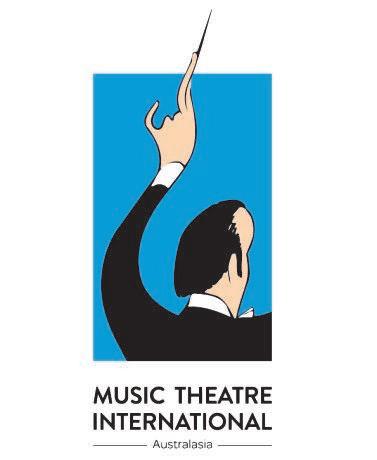

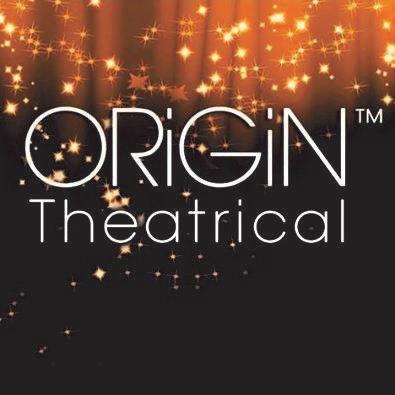
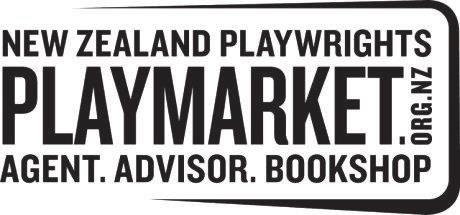
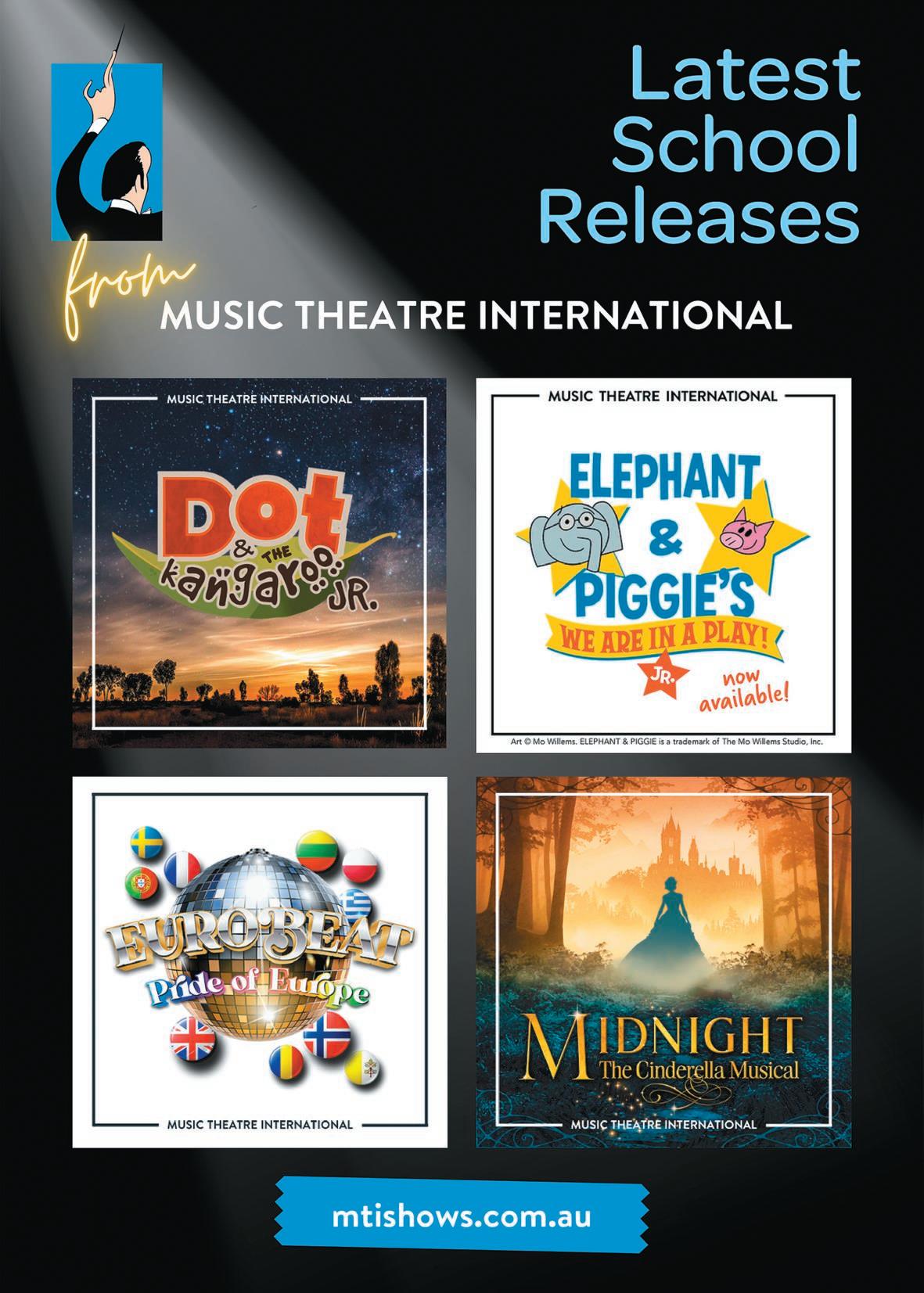
As we approach the 20th anniversary of Arthur Miller’s passing, Music Theatre International Australasia takes a moment to reflect on the plays that all students should perform and study.
Miller’s works offer timeless and universal themes that resonate with audiences across generations and cultures. These themes include the struggle for identity, the consequences of personal and societal pressures, and the moral complexities of human nature.
The Crucible, set during the Salem witch trials, serves as a powerful allegory for the dangers of mass hysteria and the breakdown of social order. It encourages students to critically examine issues of justice, morality, and the impact of fear on society.
Death of a Salesman provides a poignant exploration of the American Dream and the often-harsh realities of pursuing success. Through the character of Willy Loman, Miller delves into themes of ambition, failure, and the quest for self-worth.
All My Sons tackles issues of familial responsibility and the ethical consequences of business decisions. A View from the Bridge delves into themes of immigration, identity, and the often-destructive nature of obsession and jealousy.
Miller’s plays are rich in literary and dramatic techniques, offering excellent material for studying character development, dialogue, and stagecraft. Engaging with these texts can enhance students’ analytical and critical thinking skills and prepares them to engage thoughtfully with complex social and ethical issues.
His works are a testament to the enduring power of theatre to provoke thought, inspire change, and deepen our understanding of the human experience.
Explore the titles available to license from Music Theatre International
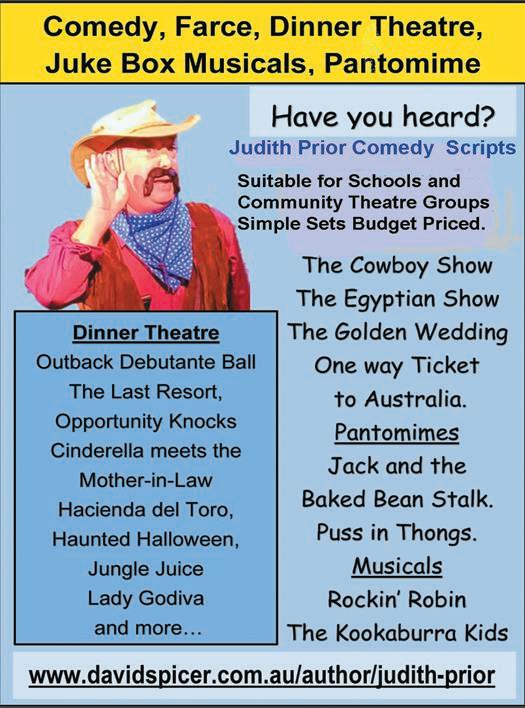
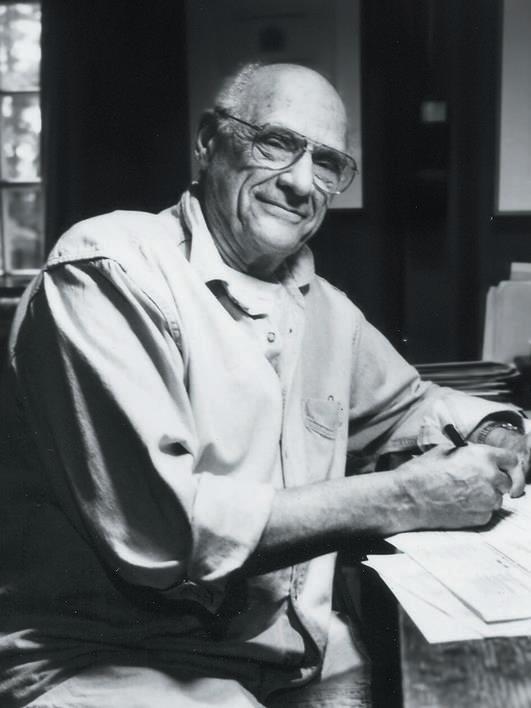
Theatrical agent David Spicer Productions recently compiled a list of its top ten comedies from the last five years.
1. Mother And Son
Geoffrey Atherden’s 2014 theatrical adaptation of his popular ABC series has had 10 productions in 2024.
2. The Old People Are Revolting New Zealand playwright Devon Williamson’s madcap comedy about seniors seeking revenge!
3. Agatha Crusty And The Village Hall Murders
Derek Webb’s comic murder mystery with great characters.
4. True Blue Aussie Review
Judith Prior’s medley of music, monologues, skits and short scenes loosely set at the time of a local agricultural exhibition.
5. Don’t Get Your Vicars In A Twist
Leslie Bown’s farce includes mistaken identity, cross-dressing,
drunkenness and general chaos as a theatre group take over a vicarage.
6. Opportunity Knocks
Judith Prior’s farce that blends exotic dancers and an op shop.
7. Australia Day
Jonathan Biggins’ comedy set in a committee.
8. The Outback Debutante’s Ball
Judith Prior’s take on a great country tradition.
9. Phantom Of The Music Hall
Judith Prior’s classic about the efforts of a theatre company to convince the phantom residing in their old White Chapel Theatre that their production of Cinderella is a melodrama.
10. Agatha Crusty And The Health Spa Murders
Derek Webb continues the murder mystery spoof in a health spa.
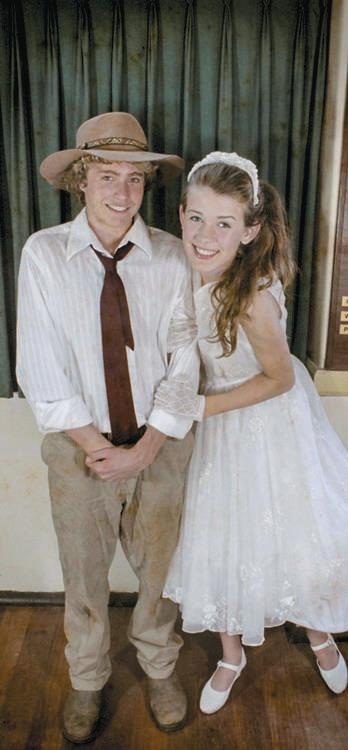
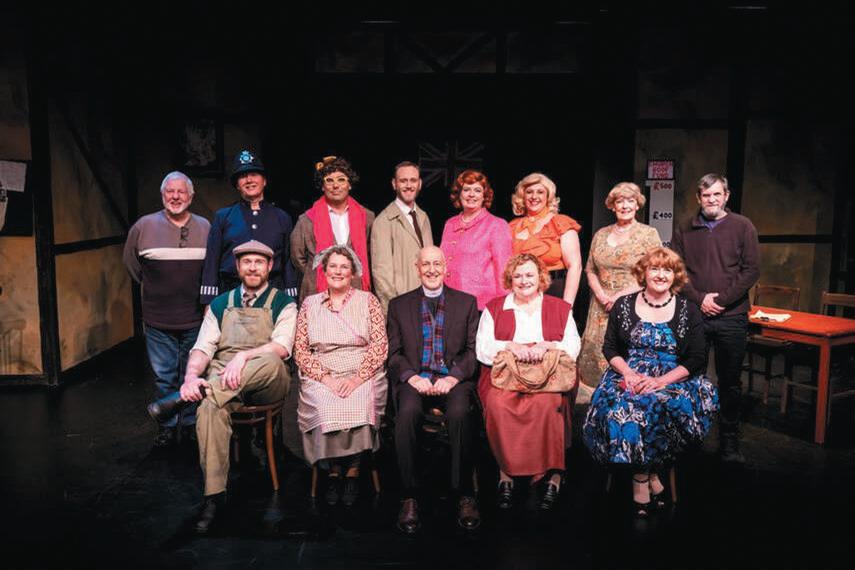
Rights holders describe their new and recommended musicals and plays for schools and community theatres.
An all-new musical adaptation of the bestselling Australian classic, based on the 1899 novel of the same name, Dot and the Kangaroo will lead audiences on a beautiful journey into the world and spirit of Australia.
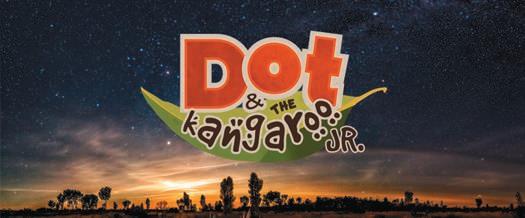
Young, rambunctious Dot longs for an adventure. When she finds herself lost and afraid in the darkening Australian bush, Dot befriends a wise mother Kangaroo who enlists the help of Australia’s favourite bush creatures to help Dot find her way back home. mtishows.com.au/dot-the-kangaroo-jr
Midnight
Featuring a passionate, feisty, and funny young heroine who doesn’t need or want a so-called Prince Charming. Can all be achieved before midnight?
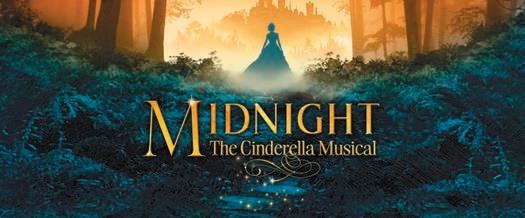
Midnight is not just a tale about true love; it is the story of a girl who is destined for so much more than what the world has given her and features a funny, intelligent and strong-willed Cinderella who is determined to make her mark. mtishows.com.au/midnight-the-cinderella-musical
Available for Community Theatres, Come from Away is based on the true story of the time when the isolated community of Gander, Newfoundland, played host to the world when 38 planes, carrying thousands of people from around the globe, were diverted to Gander’s airstrip on September 11, 2001. Undaunted by culture clashes
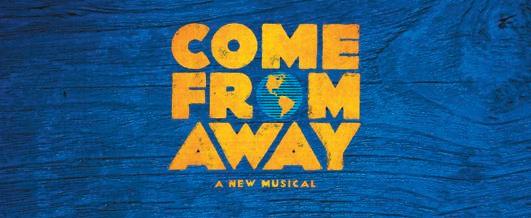
and language barriers, the people of Gander cheered the stranded travellers with music, an open bar and the recognition that we’re all part of a global family.
mtishows.com.au/come-from-away
Maverick Musicals maverickmusicals.com
The soaring high school musical best seller! Man of Steel is an action-packed musical spoof, a parody of the most famous comic book superhero. It centres on the entertaining battle of our Super Hero (and his Heroine) triumphing over the evil Countess Olga and her motley Henchmen. If only he could get it right occasionally … why are tights so hard to wear? Fast moving action, spectacular chorus and a fabulous score.
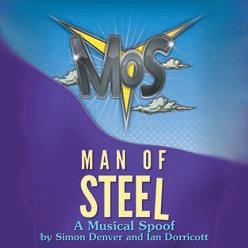
maverickmusicals.com/play/man-of-steel
Oceans & Emotions
A pirate-themed musical written for lower primary students. Amongst the fun and razzmatazz of quirky characters, there are serious themes explored: wellbeing, mindfulness, anger management, mental toughness, anxiety and depression.
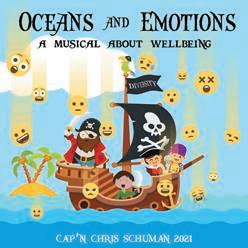
The four happy chemicals of dopamine, oxytocin, serotonin and endorphin together with Calypso, appear as muses to guide the fellow pirates through the choppy seas of self-doubt and beyond (70 minutes).
maverickmusicals.com/play/oceans-emotions
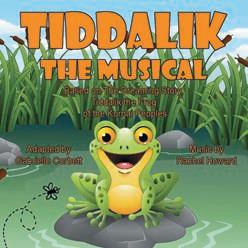
Tiddalik The Musical
A primary school musical based on the popular Dreaming story set in the beauty of an Australian landscape. Native animals and Tiddalik the Frog are so thirsty they decide to drink all the water in the land. To restore the balance of nature the animal groups decide to make Tiddalik laugh so that fresh water can be released. maverickmusicals.com/play/tiddalik-the-musical
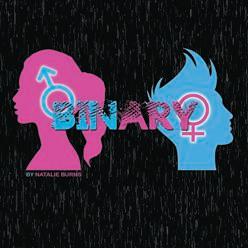
One Act Play. Tonight is Brynn’s first night out, as herself. For years they have questioned their thoughts and feelings, knowing that they are different, but unable to identify why. Not knowing if they were a he or a she, a him or a her, a boy or a girl, a son or a daughter. What pronoun does one use when they are born male but identify as female?
maverickmusicals.com/play/binary
David Spicer Productions davidspicer.com.au
We Will Rock You
The most popular high school musical for DSP remains We Will Rock You by Queen and Ben Elton, which is now available in three editions Global, School and Young @ Part. Resources available include a superb backing track and Scenic Projections.

“It was such a great show. The kids and community loved it.” -St Michael’s Grammar. davidspicer.com.au/shows/we-will-rock-you
The second most popular show in the DSP catalogue is Back to the 80’s a tribute to the era that brought the world the Rubik’s cube. The show will soon also have a Scenic Projection resource. davidspicer.com.au/shows/back-80s
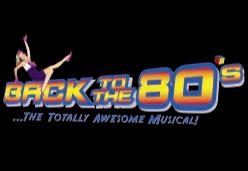
A brilliant homage to Eurovision. Made with love, music and cheese. Connecting communities and giving everyone clackers! Allows for members of the audience to vote for their favourite country on their mobile phones.

Staged by high schools and community theatres this year, the show is being updated in a production produced by the creator Glynn Nicholas in Adelaide in December. davidspicer.com/shows/song-contest-almost-eurovision -experience
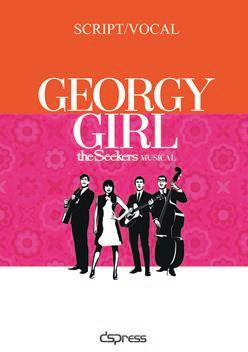
DSP has announced the availability of community theatre rights to Georgy Girl: The Seekers Musical, the quintessential Australian story of how three clean-cut young men who looked like bank tellers, and a shy cuddly girl-next-door type, left their hometown to have a go at making the big time. Read more in Musical Spice on page 86.
davidspicer.com.au/shows/georgy-girl-seekers-musical



One of the most popular recent posts on the Stage Whispers’ Facebook page was my announcement that community theatres will be able to stage Georgy Girl the Seekers Musical next year.
The Australian folk group displaced The Beatles and The Rolling Stones from the top of the charts in the early 1960’s, with their unique harmonic songs that included “I’ll Never Find Another You”, “I am Australian” and, of course, “Georgy Girl”. They were unlikely pop stars, described in a famous quote as “a cuddly girl-next-door-type and three sober cats who looked like bank tellers.”
A scheduled short trip to London laid the ground-work for them selling 50 million records and having six top ten hits in the mid-sixties.
Georgy Girl the Seekers Musical was produced in 2015, with the four band members taking to the stage at the end of their hometown Melbourne
premiere.
It has been a long road for my theatrical agency to secure the rights to represent the musical.
Last year I finally met the writer, Patrick Edgeworth, whose family connection was that his brother Ron married The Seekers’ lead singer Judith Durham.
Patrick was keen for the musical to be available across the country and had a special joke that he wanted to add to the show.
The gag which relates to Judith’s maiden name (that rhymes with sock) was emailed to me by Patrick in a new draft of the script.
Sadly, Patrick passed away just months later, joining Judith Durham, who died in 2022, in musical heaven. Judith’s struggles with health, selfimage, relationships and a car accident are touched on in the musical, as well as the band’s magic carpet ride to success.
The surviving members of the band
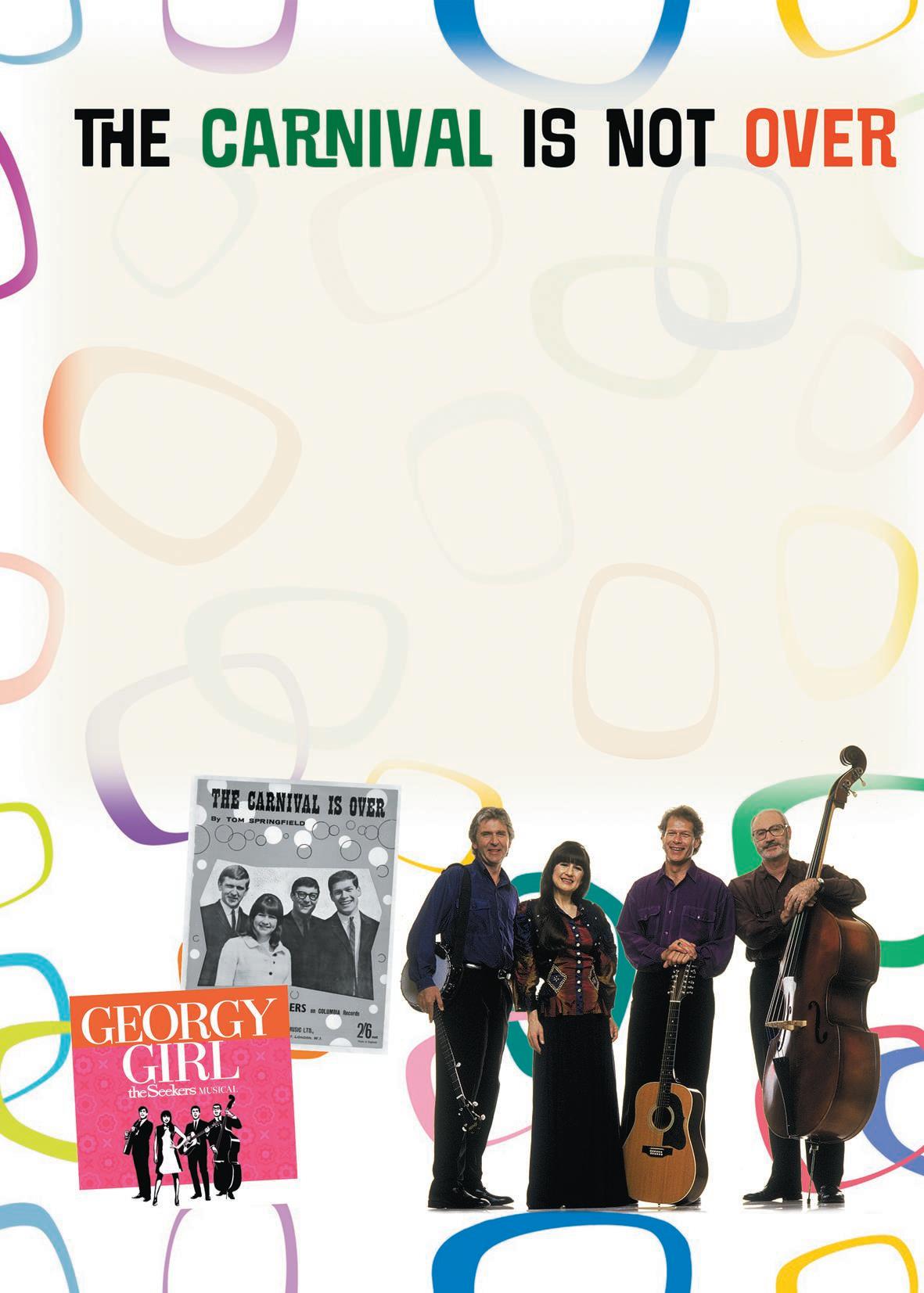
were devastated by Judith’s death, which drew the curtain on their famous reunion concerts.
Productions of Georgy Girl the Seekers Musical give audiences the chance to hear their famous sound replicated on stage again. Speaking on behalf of the band Keith Potger said: “It’s a great honour to know that the Seekers’ story can be given this extra chance to be told.”
The producer of the musical, Richard East (also one of the producers of Mamma Mia!), said “after a successful first commercial run we are now very happy to see the show performed in all corners of Australia and New Zealand, finding a new audience for the Seekers wonderful story and songs.”
My company is seeking expressions of interest from community theatres to stage the musical in 2025 and beyond.
David Spicer



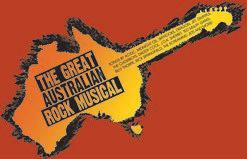
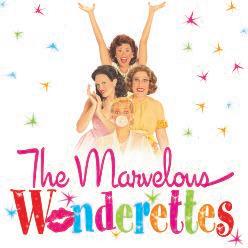
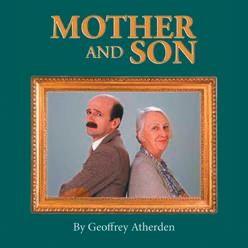
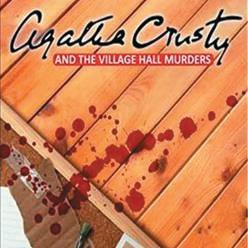
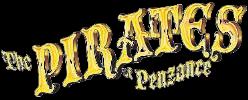
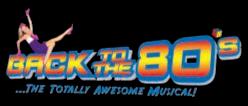
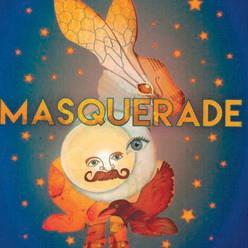
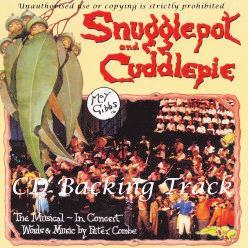
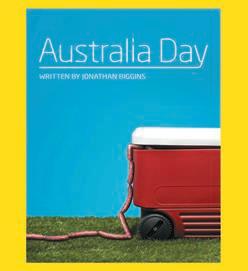



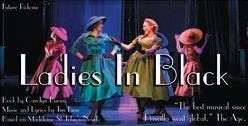
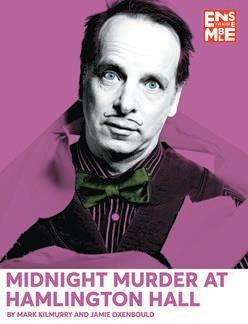
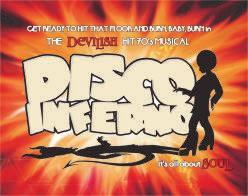

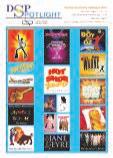
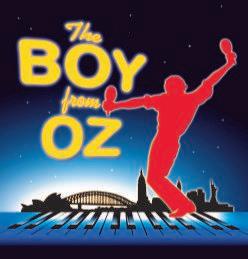
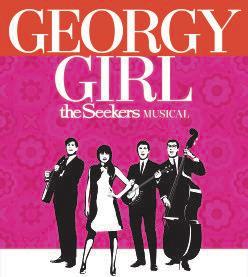
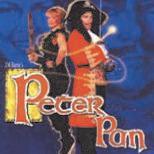
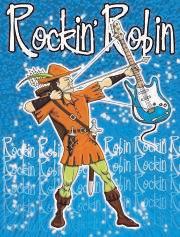
The Bangalow Theatre Company in northern NSW recently won five Gold Coast Palm Awards, including best community theatre production, for their season of The Beast by Eddie Perfect. Director Anouska Gammon explains how cast and venue challenges were conquered to produce the play in six weeks.
Our little company usually produces musicals, but I had my sights on this brilliant piece which I knew would resonate with local crowds. The black comedy plonks itself in the middle of upper-middle class Australia. Three married couples living in Melbourne, all seeking a more holistic life, move to a tree change existence that centres itself in organic orgasmic delight.
Writer Eddie Perfect has a knack for poking his audience in just the right way, feeding them humour to shade the truthful and exposing themes, while building to a crescendo of unravelling chaos.
The Bangalow Theatre Company is run by a group of volunteers
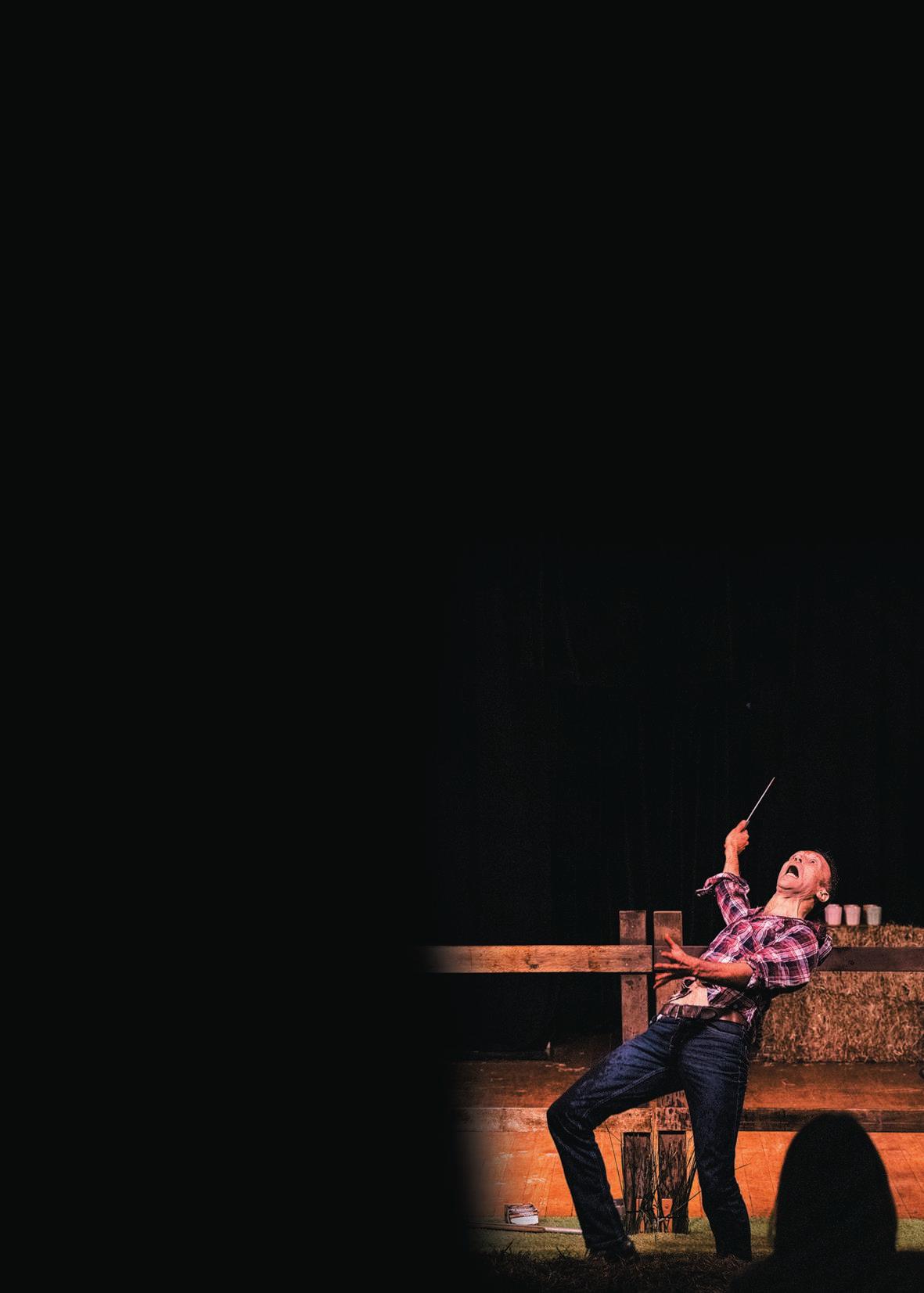
passionate about creating innovative, thought-provoking and engaging theatre. With sell-out shows for each season, and multiple awards, the company has survived the pandemic, and is thriving.
We had only six weeks and twelve rehearsals to prepare for opening night due to cast reshuffling. Luckily the final cast took to the script like fish to water. We also had enough females audition to allow for a double cast. This meant we needed more rehearsal time but the double roles kept each male on their toes, as they needed to respond to each female differently.
The females themselves were also constantly finding their version of the

character, and this little bit of competitiveness was just the right energy for the work. No one felt safe, or too comfortable, which added to the discomfort within the writing.
Another hurdle the company came up against was our venue. The initial space for The Beast was a shed on a local farm, which seemed like a great idea at the time. Placing the work in the environment which the play is set felt like a bold, and cost-effective choice.
However, as rehearsals began we realised that the shed would only allow for 50 patrons, we would need to bring in porta loos, there was a lack of a back stage area, no food/bar options and if it rained, we would need a marquee. The shed itself was up a very long driveway, with little parking.
We investigated having live cattle around the shed, and one live calf in the show, to submerge our audience in the play through natural sounds and realism, however this was not legally allowed.
So, we quickly needed to find another performance space four weeks out from the show.
Luckily, we had found another venue option the Newrybar Hall great in-between shed and theatre option for us, with a toilet as well! Rehearsals continued (in a different hall space) and tickets went on sale.
Things were coming together except for one last thing the cow.
The finale of the first act is a monumental moment of the play, where the three couples decide to celebrate their new lives in the countryside with a fabulous degustation lunch. They plan to meet a local farmer to kill one of his cows, which the group will then prepare to eat. Head to tail eating it is called. So very sustainable. However, the farmer does not turn up, and so the couples take it on themselves to kill the cow.
This, of course, goes horribly wrong, and ends up being a fullblown cow massacre leaving the characters traumatised. We considered a puppet cow, the use of silhouettes, projection, another
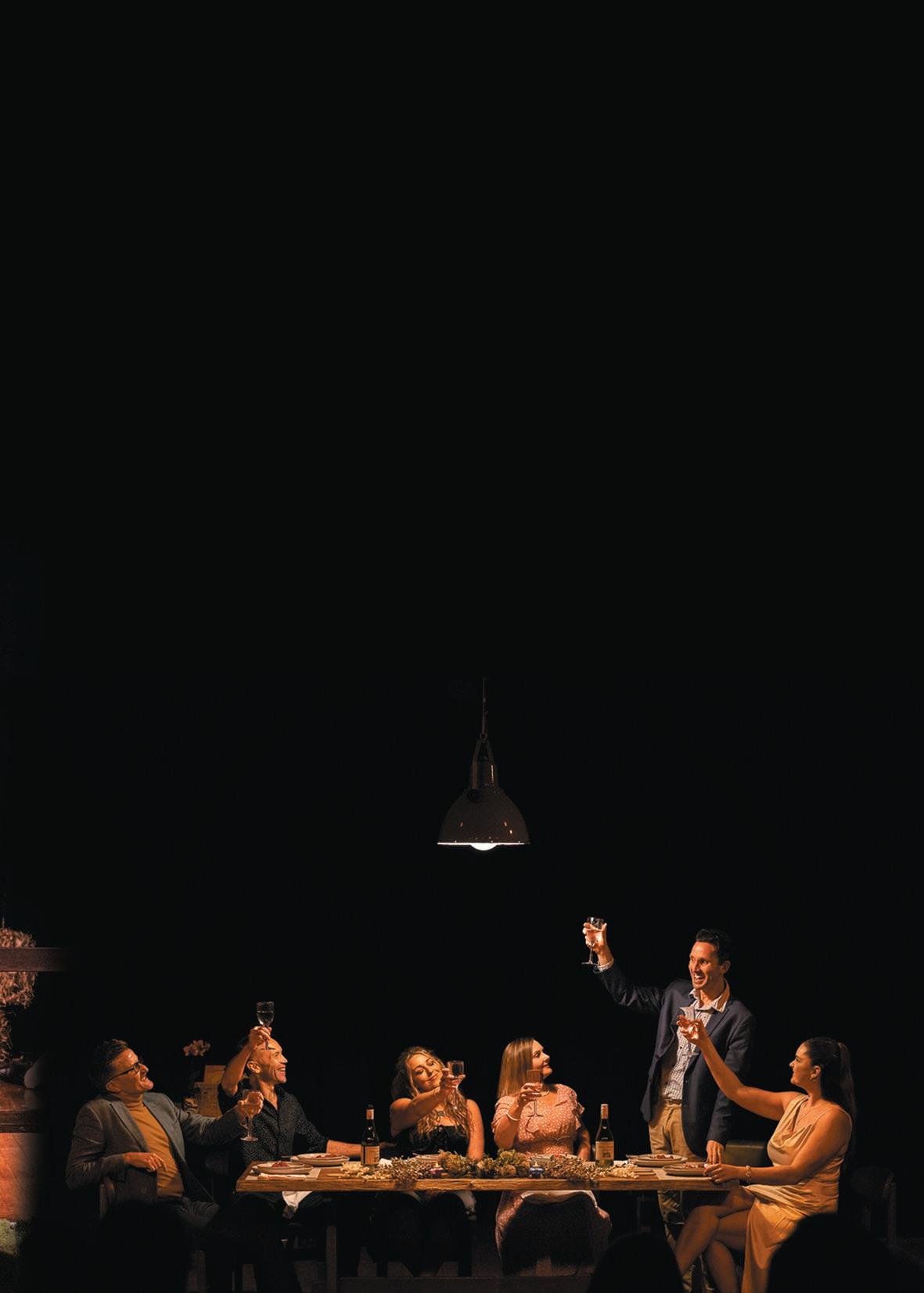
performer, a fake toy cow and the list went on.
Finally, a more simplistic idea formed that did not involve the sight of a cow, but rather the blood of a cow. We went into full engineering mode to create our cow blood device.
This took many trips to hardware stores, pool shops, conversations with many tradies and battery experts.
We invested in a dog activated sprinkler, and tested other devices. Then, after many hours testing pressure and consistency for the blood, we made a device that was motorised and activated by the actors pressing a button.
The blood (a concoction of red food colouring, chocolate sauce and water) was kept in a large tub on stage masked as a hay bale. Blood travelled through a hose with a spray nozzle, and hidden under fake grass.
As the actors either tried to save or kill the cow, the button could be pushed, the blood would spray, and with the combination of horrific cow sounds and lighting, we had our
scene. It was a triumph, and left each audience shocked, yet laughing.
There was also a massive job of cleaning up during each interval for our crew, and for our costume lady, who needed to continually wash blood ridden clothes for each show.
The Beast, as meaty (pardon the pun) as it was, will be a difficult act to follow for BTC. There were times when it did feel all too difficult. Six weeks from first script read to opening night with a group of volunteers, a very low budget, and no home to rehearse/perform in.
But perhaps there is something in this. Something in the restriction which aids creativity. Sometimes having too much time, and too much space creates more questions and allows for more opportunities to conflict. One thing is for sure, it is the work of a formidable team of passionate people, and the support of our local theatre loving community which does keep BTC moving forward.

On the opening night of a new play, seven members of an amateur theatre company’s cast go down with the dreaded lurgy. In this excerpt from the farce, written by Mark Kilmurry and Jamie Oxenbould, the cast press on to stage the murder mystery. Juggling nerves, props, and absurd miscasting, will they manage to pull it off? Or will everything go horribly, terribly and awfully wrong?
SHANE: If things really go off the rails and we need to discuss something without the audience knowing… just say the safe word and we’ll convene under the portrait.
KAREN: What’s the safe word?
BARNEY: Mines “Ouch”…which doesn’t always work
KAREN: Amsterdam!
PHILLIPA: Pineapple!
[THEY all call out some ridiculous words at once.]
ALL: Cuttlefish…Boob Tube… Werewolf…Backgammon…Help… Help me!
SHANE: No, it has to feel like it’s part of the play. Just say “I’m parched”.
[THEY all agree. Good choice.]
SHANE: Ok, come together team.
[SHANE gathers them in a circle. KAREN goes to leave.]
BARNEY: Uh uh…you’re one of us now.
[KAREN joins the circle.]
SHANE: Now, we’ve got this, right?
KAREN: Is that a question?
SHANE: [more confidently] Sorry. No. We’ve got this right.
BARNEY: Course we do. Have faith. And those council bastards will love it
PHILLIPA: What does that mean?
BARNEY: Oops, sorry mate.
PHILLIPA: What’s he talking about Shane?
SHANE: [seriously] It’s nothing… look…I didn’t want to worry you all but the council’s here…
watching, and…kind of deciding the company’s fate tonight.
PHILLIPA: Motherfuckers. Sorry…it’s P.I.P.M.
KAREN: What?
PHILLIPA: Panic Induced Potty Mouth.
KAREN: Right
SHANE: Budget cuts.
BARNEY: You’re right they are a bunch of…
SHANE: We’re expendable, the arts always are…
BARNEY: They want to turn it into some sort of sweat shop??
SHANE: It’s all fine. If we just give them a good old show…like we always do…they’ll see what we do is worth hanging on to.
KAREN: Want me to make a call? I know some people who…
SHANE: NO! No…we just go on with the show…be amazing…and cross our fingers. And remember, Golden Rule…we NEVER GO OFF SCRIPT.
BARNEY: Weeeell…
SHANE: Never Barney!
KAREN: And remember Jenny Caccielli’s party will start dead on 10.00 next door. And having seen those speakers arrive, it’s going to be loud.
SHANE: If nothing goes wrong, we’ll be done by then. [SHANE takes a big breath. Delivers his heroic speech.]
SHANE: Now…we…all of us here at the Middling Cove Players…are
Published by Currency Press. Available for $24.99 from booknook.com.au/product/midnight-murder-at-hamlington-hall
storytellers. We are part of a tradition of show folk. Tonight we face adversity. But we will not take a backwards step. It won’t be easy. Good art. True art never is. But tonight is our night dammit…our opening night. And by thy hook or thy crook…the show…
ALL: …WILL…GO…ON!!!!!!!
[Upbeat music transition. ALL of them madly get the stage ready for the show. KAREN pushes the last bits of furniture in to place. Final props etc.]
KAREN: OK guys, half an hour… twenty-five…no twenty minutes to beginners!
[KAREN leaves and a spotlight lands on the Pringles can that BARNEY left on stage earlier. Blackout.]
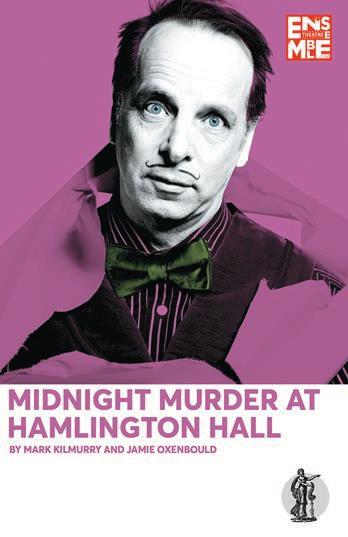
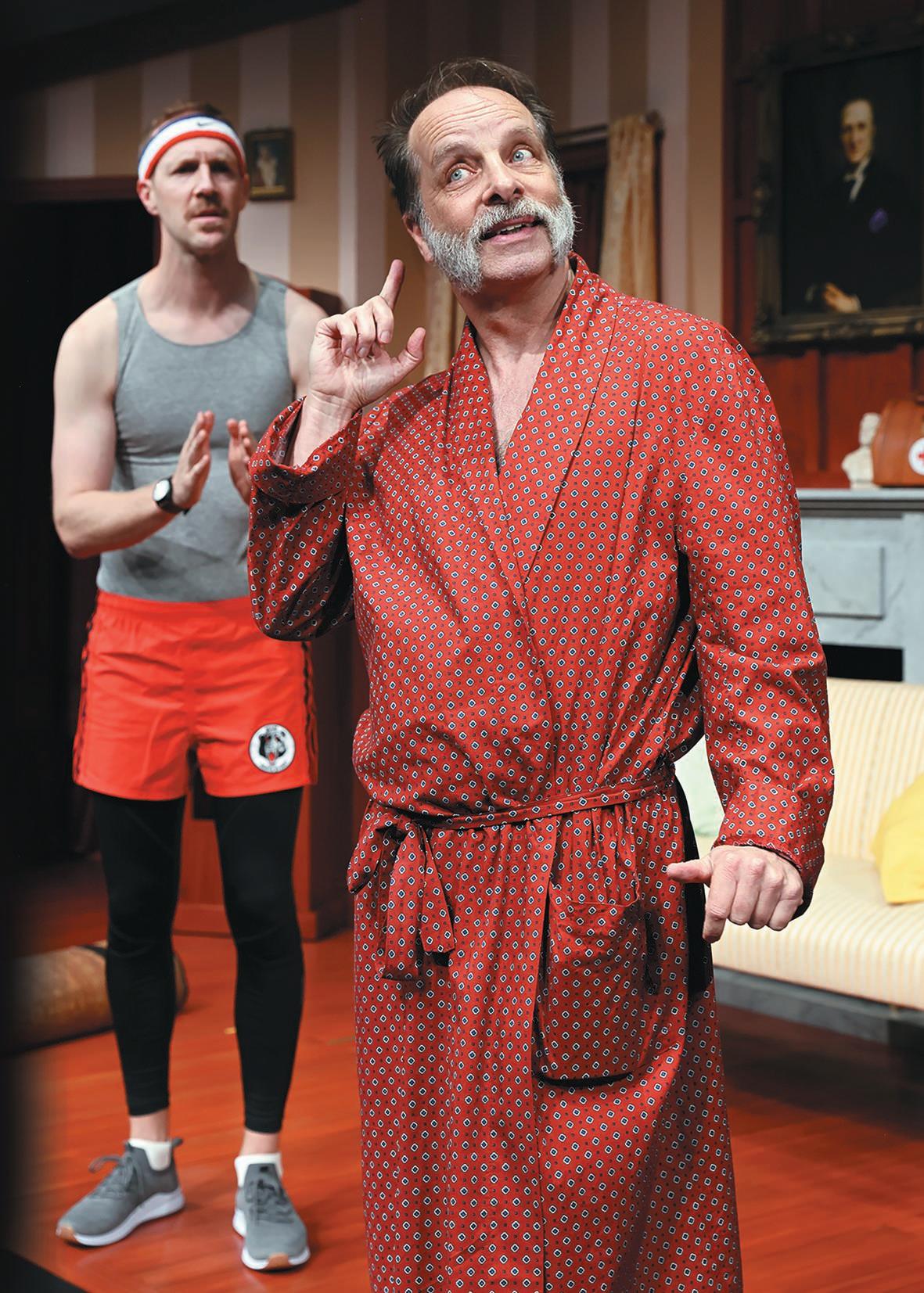

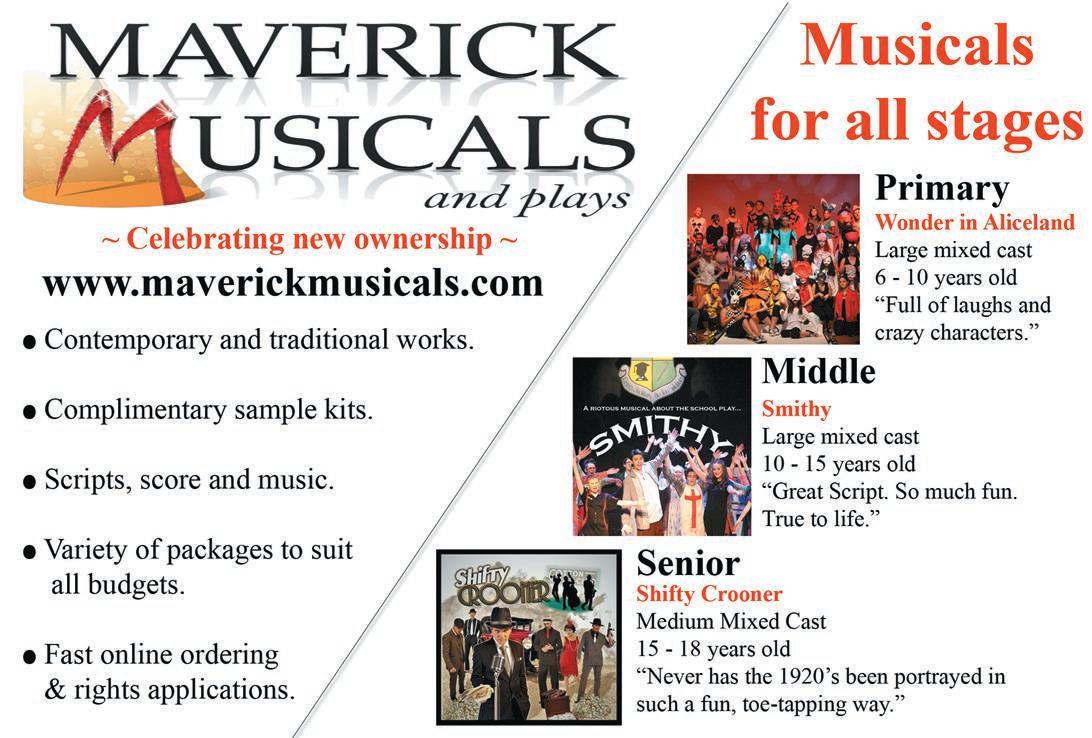
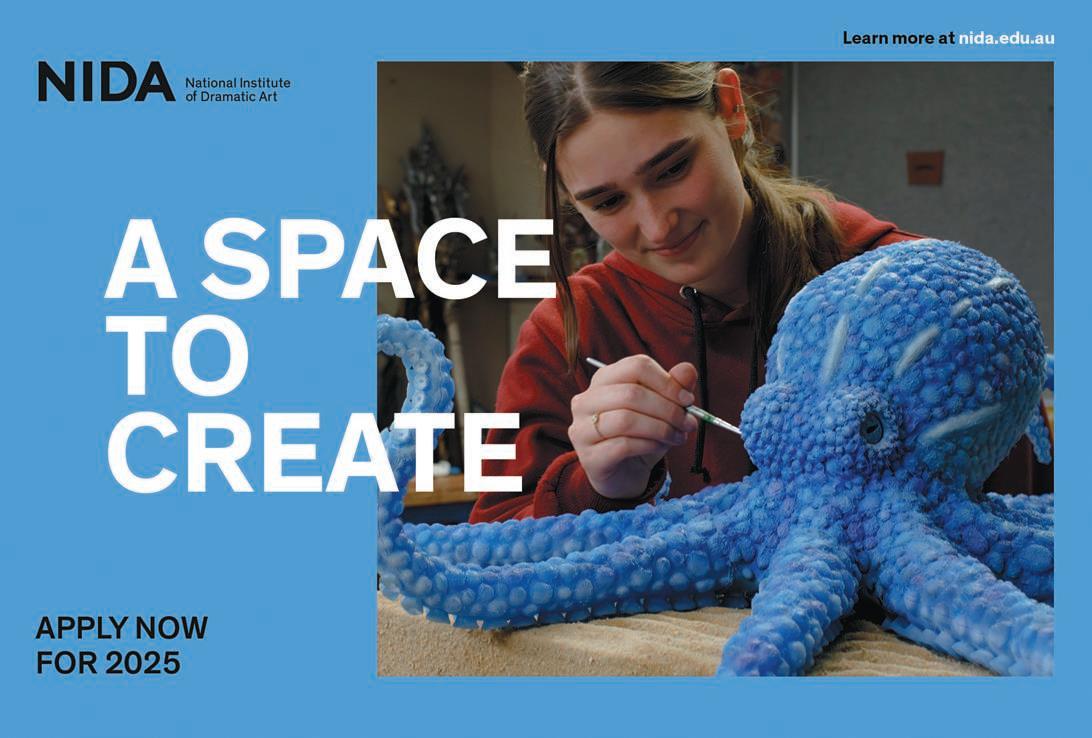
Ten top tips from Maverick Musicals and Plays for your next school musical.
Rope others in!
Rule One - do not try to do it alone. Beg, plead, cajole or blackmail others to be involved.
Your ideal production team should consist of a producer to pull your team together, director, musical director, set designers, sound/lights tech team, set builder, costume person and advertising/media whiz.
Apply for the rights early
Aim to have approval from the representatives of the musical six months prior to your first rehearsal. Carefully note the legal obligations in the contract. All contracts will have rules about respecting the author’s intentions (sticking to the script), how you can promote the work both online and in print, videography and use of production materials.
Selecting the right school musical
Don’t pick a musical solely because you like it. Make sure it can be done well by your students.
Commonly five or six girls for each boy will be the audition ratio, so choose material that will give girls something worthwhile to do.
Select relevant scenes that will give an indication of the student’s ability. Avoid choosing students who have other commitments that will prevent them from attending

rehearsals - no matter how good they are.
Give cast your rehearsal/ performance schedule before starting rehearsals.
Send the schedule home to parents as soon as you can, with a note asking for their co-operation.
Design the rehearsal schedule so that only those required attend specific rehearsals.
It is a good strategy to call the chorus first and work on the music. Always make rehearsals fun for chorus and give them plenty to do.
Supply forms (with the rehearsal schedules) that require the character/s measurements asap and pass on to your costume department as soon as rehearsals begin.
Parents are more inclined to help make the costumes if you send material home that is cut out ready for sewing.
Sets and props
Make sure that the cast know the positioning of each set and give them an improvised stage set so they are used to moving around it.
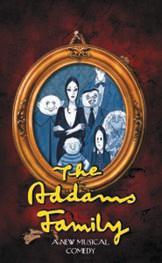
Get actors used to using any handprops in the show. Improvise if they not yet constructed.
Create an ‘event’ on social media and encourage the cast and crew to like and share - upload fun rehearsal shots, but not too many!

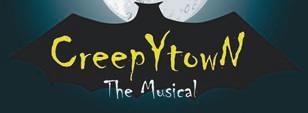
Encourage cast blogs.
Flood the area with posters and try for coverage on local radio.
Constantly remind the school of the forthcoming production via your social media pages, websites and newsletters.
Offer a prize to the student who sells the most tickets.
Performance
Always have a ‘preview’ afternoon which is, in fact, another valuable dress rehearsal; this time with an audience. Primary schools are usually happy to see your High School production.
Post performance
No matter how amiable you are feeling towards the cast, never attend a cast party if held at the home of a student! What you may see there, you may later be required to explain.
Have a thank-you meeting for the cast and everyone involved, including front-of-house and back-stage workers. This can be a special lunch. Have a short break, then start looking for a suitable show for next year.
Putting on the school musical is a bit like child-birth, and when you get it right, you forget the pain and recall only the joy - and find yourself doing it all over again.
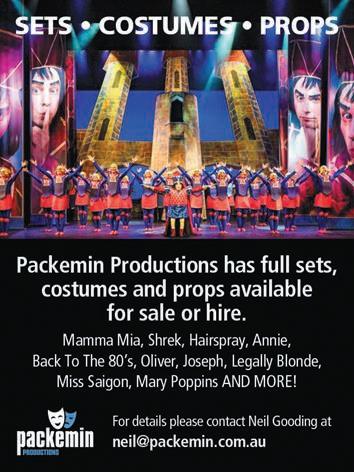
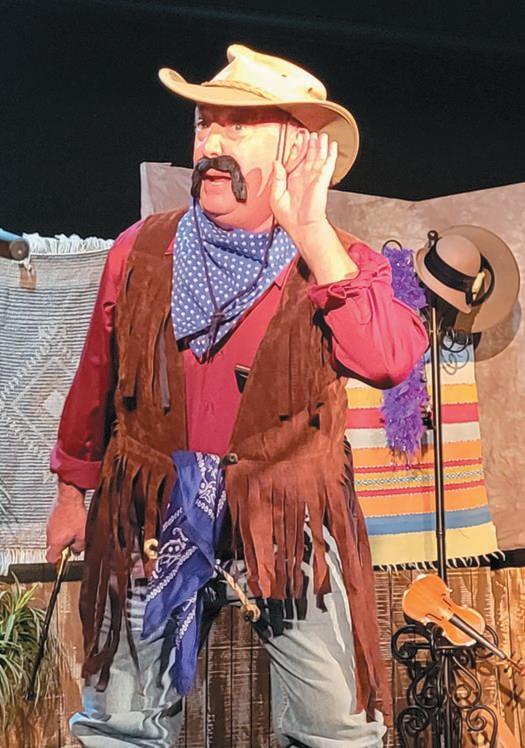
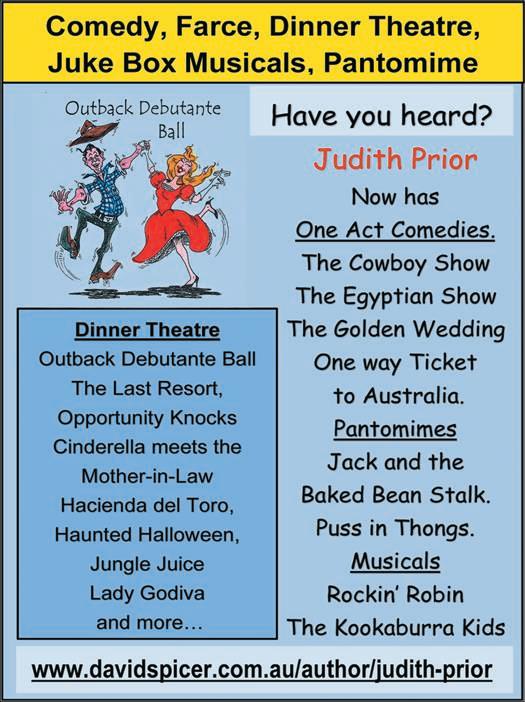
Writer Judith Prior explains how she has adapted her plays for the times.
Writing comedy today is quite a challenge. Many of the jokes we laughed at twenty years ago would be considered cringe-worthy today.
Some of you may be familiar with my very popular theatre restaurant scripts, available through David Spicer Productions. These were all written many years ago with adult audiences in mind, and, as expected, many of the jokes are quite risqué.
To reach a wider audience, and so that I could take my grandchildren to see all my shows, I have adapted some of my funniest and most popular scripts to a more politically correct format, leaving in (almost all) the very funniest jokes. These new scripts have all been performed here in Bundaberg, and were very well received by appreciative audiences, both young and old. Each show has one simple set and runs for one hour. They may be split into two 30 min acts with an interval or run continuously.
The Cowboy Show is adapted from Jest at the West and Jest Call Me Cowboy. Fun and games at the Silver Slipper Saloon. Can Maggie May pay her mortgage? Will the movie director from the city cast his movie using the local characters? Can the Sheriff avoid the amorous advances of Little White Dove?
The Egyptian Show is adapted from Wink at the Sphinx. Can the Pharaoh marry off his two daughters, Fatima, and Charisma? Will the magic carpet really fly for the ancient genie?
One Way Ticket To Australia is adapted from Sailing South. The prisoners are not looking forward to landing in Australia but many an adventure causes hilarity. The prisoners make a mockery of the inept captain and his first officer.
The Golden Wedding is adapted from Uncle Jack Socialite daughter Claire has organised a huge social event. Dad announces that mum has left town, with his brother Jack. Gran is deaf and keeps interrupting, and somebody has spiked the punch. The slightly tipsy Vicar is valiantly trying to keep order. Just your average happy family celebration.
For show or licensing information, and to explore the entire Judith Prior library of shows, please visit davidspicer.com.au/author/judith-prior
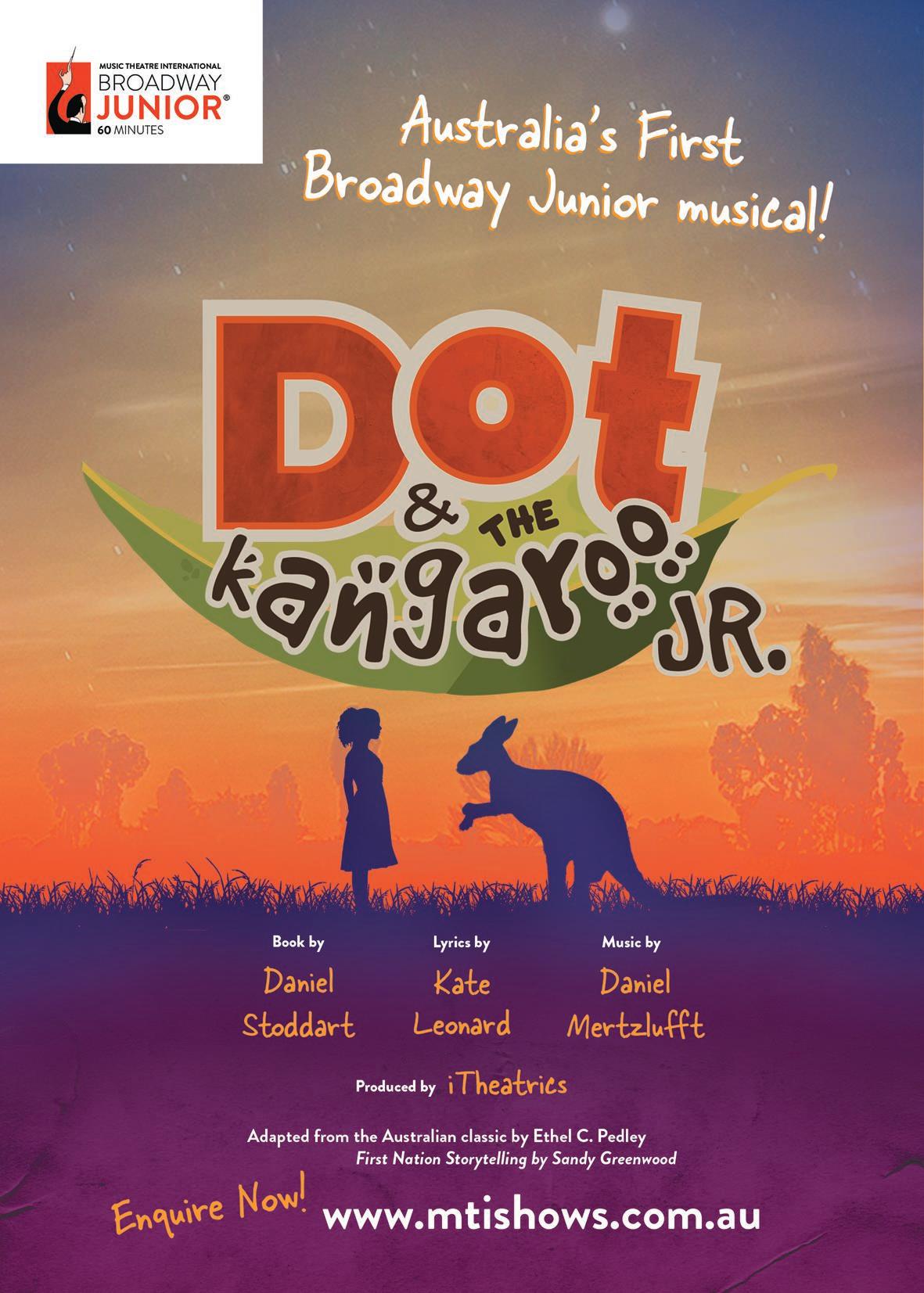
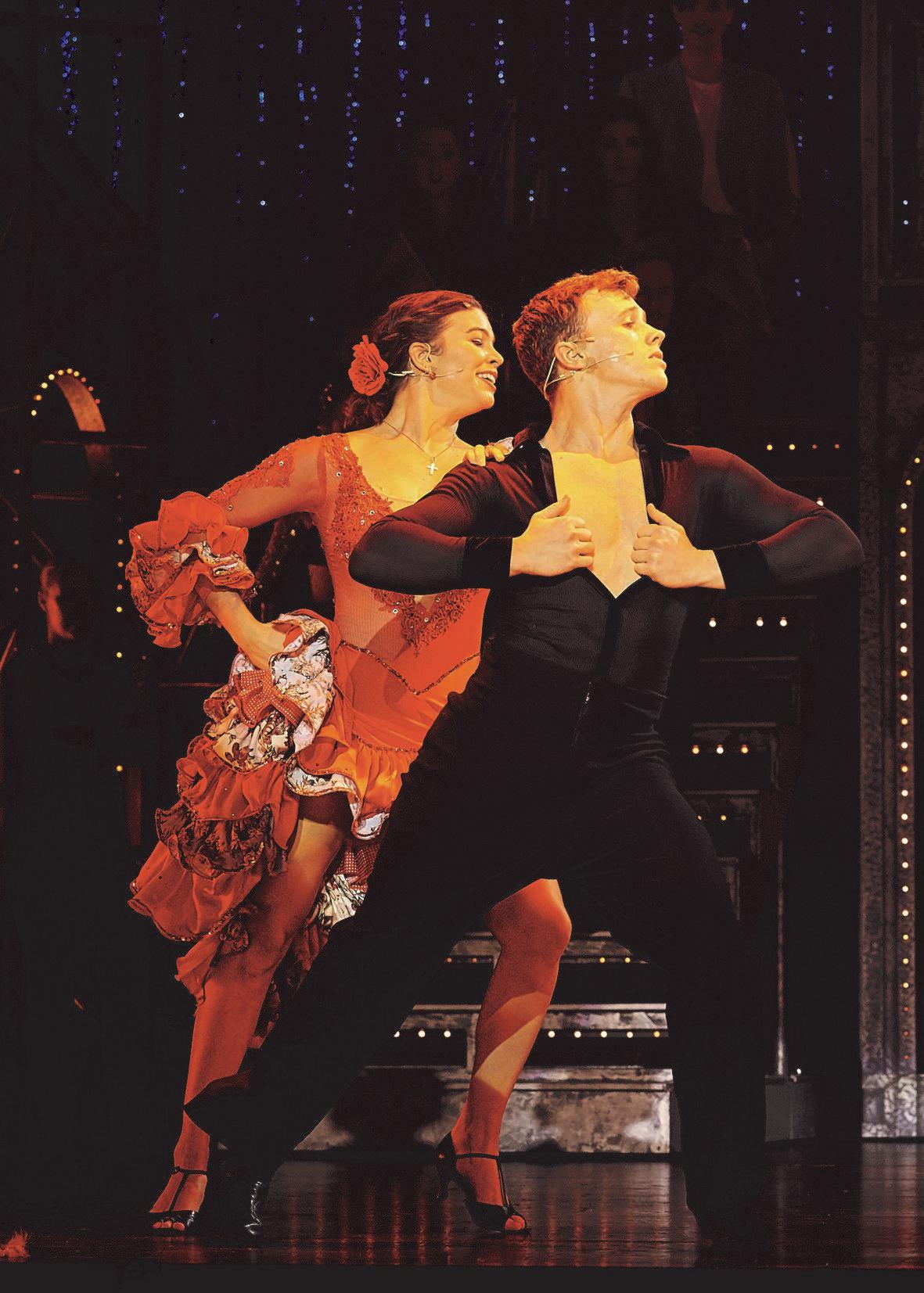

See more listings online at bit.ly/2ma7wNZ
Ballarat Lyric Theatre
Ballarat Lyric Theatre has over the years compiled an extensive range of costumes. Their costume hire offers a wide range of individual costumes, or sets of costumes from many shows.
882 Humffray Street South, Mt Pleasant, Ballarat, VIC 3350 +61 4 3970 0219 hire@ballaratlyrictheatre.com.au ballaratlyrictheatre.com.au
Bankstown Theatre Company Hire
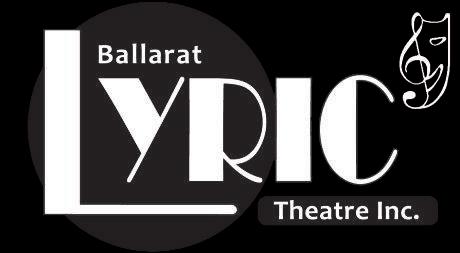
Bankstown Theatre Company have an extensive range of costumes, from complete productions to something one-off. Check out pictures of the costumes in the Past Productions section of the website.
They also have a large range of backdrops, furniture and properties that might be just right for your next production including many specialty props such as razors and barber chair for Sweeney Todd, or a cow and chicken for Into The Woods
PO Box 502, Bankstown, NSW 1885 +61 4 8186 9858 costumes@bankstowntheatrecompany.com edward@bankstowntheatrecompany.com bankstowntheatrecompany.com
Centrestage Costumes
Centrestage Costumes has been dressing and providing props and makeup for the creative industries since 1985. Our Brunswick store provides 1000s of costumes and props to choose from as well as a fully stocked theatrical makeup department. Our team has 50 years of combined experience in the industry. We arrange hire and sales across Australia.
788 Sydney Road, Brunswick, VIC, 3056 +61 4 1810 1860 +61 3 9384 6957 centrestagecostumes@gmail.com centrestagecostumes.com
CLOC Musical Theatre
Costumes are available for hire to any company, school or individual anywhere in Australia, from individual costumes right through to complete production sets.
CLOC also has a large selection of back cloths available for hire at very reasonable rates. To see the backcloths in stock, go to cloc.org.au and click on the tab ‘Hire’.
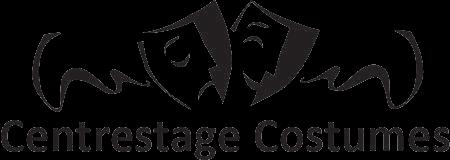

The following full stage sets are also available for hire - Mamma Mia!, Kinky Boots, Strictly Ballroom, Les Misérables, A Chorus Line, Mary Poppins, 42nd Street, The Phantom of the Opera and Jekyll & Hyde. CLOC is one of Victoria's largest and most successful non-professional music theatre companies. Over the years, the organisation has developed into a vigorous, community based, arts provider. More recently CLOC has developed a prominent role as a hirer of costume sets and stage scenery throughout Australia.
PO Box 3250, Mentone East, VIC 3194 1300 826 788 cloc.org.au
Costumes Without Drama
Costumes Without Drama make and hire costumes mostly for school productions. With in excess of 12,000 barcoded and inventoried items, Costumes without Drama provide a unique costuming experience for teachers. Where possible teachers have access to the costumes up to two weeks in advance of the performance. We launder on return. You are welcome to come in and browse, see samples on the website, or email for more information and/or pictures of available costumes.
Unit 6, 13 Molan Street, Ringwood, VIC 3134
+61 4 1143 1430
info@costumeswithoutdrama.com.au costumeswithoutdrama.com.au
Cyclorama Projects
Cyclorama Projects design, build and install cyclorama walls for a range of industries and businesses. The company specialises in creating the perfect seamless background for clients around Australia.
Cyclorama has spent years perfecting cyclorama walls with design, integration, and functionality in mind.
+61 4 2284 8880
info@cycloramaprojects.com.au cycloramaprojects.com.au
GMS Costumes

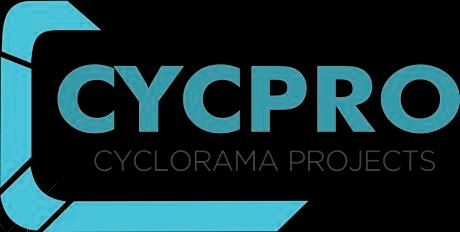
GMS Costumes cater to other Musical Societies, Theatre groups and schools and are able to hire complete show costumes for many productions. The shop has operated successfully with approximately 10,000 costumes to choose from for hire. New costumes are continually being made for each new production and added to our selection. The shop offers a wide variety of costumes for all occasions.
Mon - Fri: 10.00am - 4.00pm - Costume Hire is by Appointment only
262 Henry Parry Drive, North Gosford, NSW 2250 +61 2 4324 1305 gosfordmusical@bigpond.com gmscostumes.com.au
Masks & Puppets Plus
Masks & Puppets Plus supplies theatre companies, drama in education, masquerade parties and promotions. Inspired by a trip to Venice, proprietor Tessa Wallis has designed and constructed masks and puppets in this specialised field for over 20 years. Each mask is individually handcrafted using quality materials. Masks have a strong theatrical tradition. Mythological Masks like those worn in early Greek amphitheatres or Commedia dell’Arte masks worn in the streets of Verona are available as well as Neutral, kabuki, animals, witches, masquerade and fantasy masks.
+61 4 8824 6840 tessa@masksandpuppets.com.au masksandpuppets.com.au
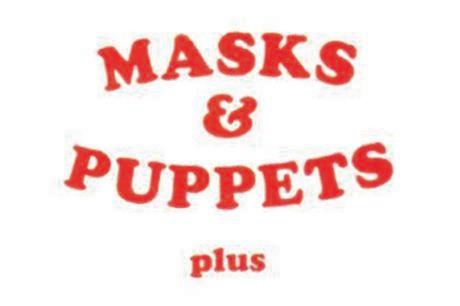
Scenic Studios specialise in theatrical painting of scenic backdrops and theatre scenery. They also hire backdrops and drapes for theatre productions and sell scenic paints designed for painting soft and hard scenery. Contact Pavla to discuss how they can help with your next production.
1B Fink Street, Preston, VIC 3072 +61 3 9484 3422 scenicstudios@scenicstudios.com.au scenicstudios.com.au
Shine Trimmings & Fabrics are leading retailers and wholesalers of quality fabrics and trimmings specifically for Dance, Calisthenics, Ballet, Ballroom, Swimwear & Activewear, Fashion, Ice Skating, Festival Wear, Fancy Dress, Burlesque, Circus, Costumes, Cosplay, Millinery, Set Design, Shows & Productions. They ship nationwide across Australia and beyond. The team at Shine have backgrounds that span costume making, fashion design, dance and cosplay and are extremely talented, dedicated and passionate for this industry. Making your creation shine!
421 Graham Street, Port Melbourne, VIC 3207 +61 3 9646 0072 +61 3 9646 7288 info@shinetrimmingsfabrics.com.au shinetrimmingsfabrics.com.au
The Costume Dept & The Staging Dept Stage School Australia has a proud 30+ year performing arts history. During this time we have developed a huge inventory of over 12,000 high quality costumes, sets and props for our own productions, which are now available to schools and theatre companies.
23 Allen Street, Moreland, VIC 3058 +61 3 8199 8344 admin@costumedept.com.au costumedept.com.au




The Party Warehouse is a passionate business, with an extensive range of costume accessories, costume kits and props to suit a wide array of themes. They are constantly adding new products to their range and offer prompt and friendly service. With Australia wide shipping and fast dispatch, The Party Warehouse is the perfect choice for making any character come to life.
PO Box 1372, Thuringowa Central, QLD 4817 +61 4 1984 8880 sales@thepartywarehouse.net.au thepartywarehouse.net.au
Theatre Star
Theatre Star specialise in the manufacture and supply of curtains, backdrops, screens and associated products for the entertainment and event industries. We are a committed team of creatives and our whole focus is to provide the highest quality theatre and studio curtains, manufactured from the best available fabrics available in the quickest turnaround time.
Theatre Star are proudly Australian owned. Contact Rod Paton for more information on their products and services.
Factory 3, 10 Industry Circuit, Kilsyth South, VIC 3137 +61 3 8761 6927 sales@theatrestar.com.au theatrestar.com.au
Transtage
Transtage are able to supply the highest quality stages that are safe and robust, all while being lightweight, user-friendly and transportable.
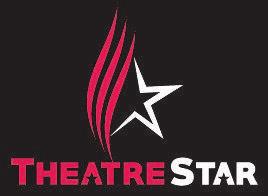

Whatever size your project, you can rest assured that we will find a staging system to suit your requirements. In addition, we are always mindful of our clients’ budgets. We work hard to find the most cost-effective solution for your event.
14B/8 Gladstone Road, Castle Hill, NSW, 2154 1300 712 066 info@transtage.com.au transtage.com.au
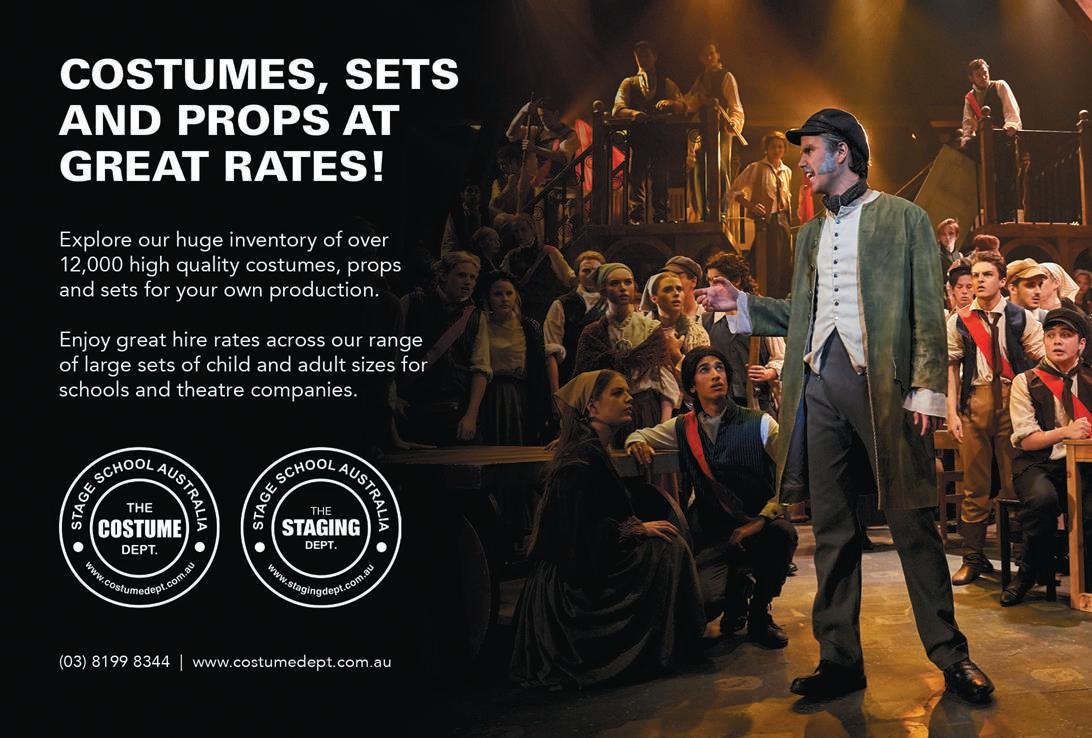
Subscription Form
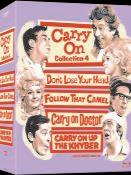
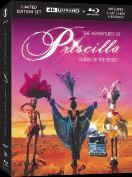
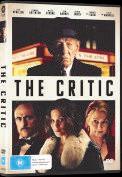
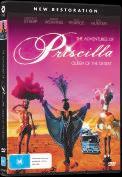
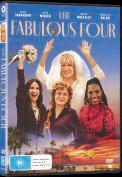
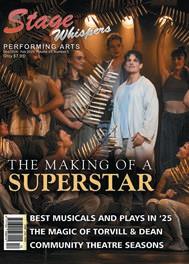
Subscribe to our print edition and receive one of the following gifts. Visit stagewhispers.com.au/subscribe
Please nominate three choices, as supplies of some gifts are limited.
The Adventures of Priscilla, Queen of the Desert - 4K UHD Limited Edition
The Adventures of Priscilla, Queen of the Desert - Restored DVD
Carry On - Film Collection 4 - Blu-ray
The Critic - DVD
The Fabulous Four - DVD
Broadway Cast and Musical Theatre CD Lucky Dip
More choices at stagewhispers.com.au/subscribe
DVDs & Blu-rays courtesy of ViaVision
Please nominate your 1st, 2nd and 3rd free gift choices below:
Send your money order, cheque, credit card details, or request for invoice to: Stage Whispers, PO Box 2274, Rose Bay North, NSW, 2030. ABN 71 129 358 710

Read about the design and creative process of the costumes for Dark Emu. tinyurl.com/2d9lxg7a
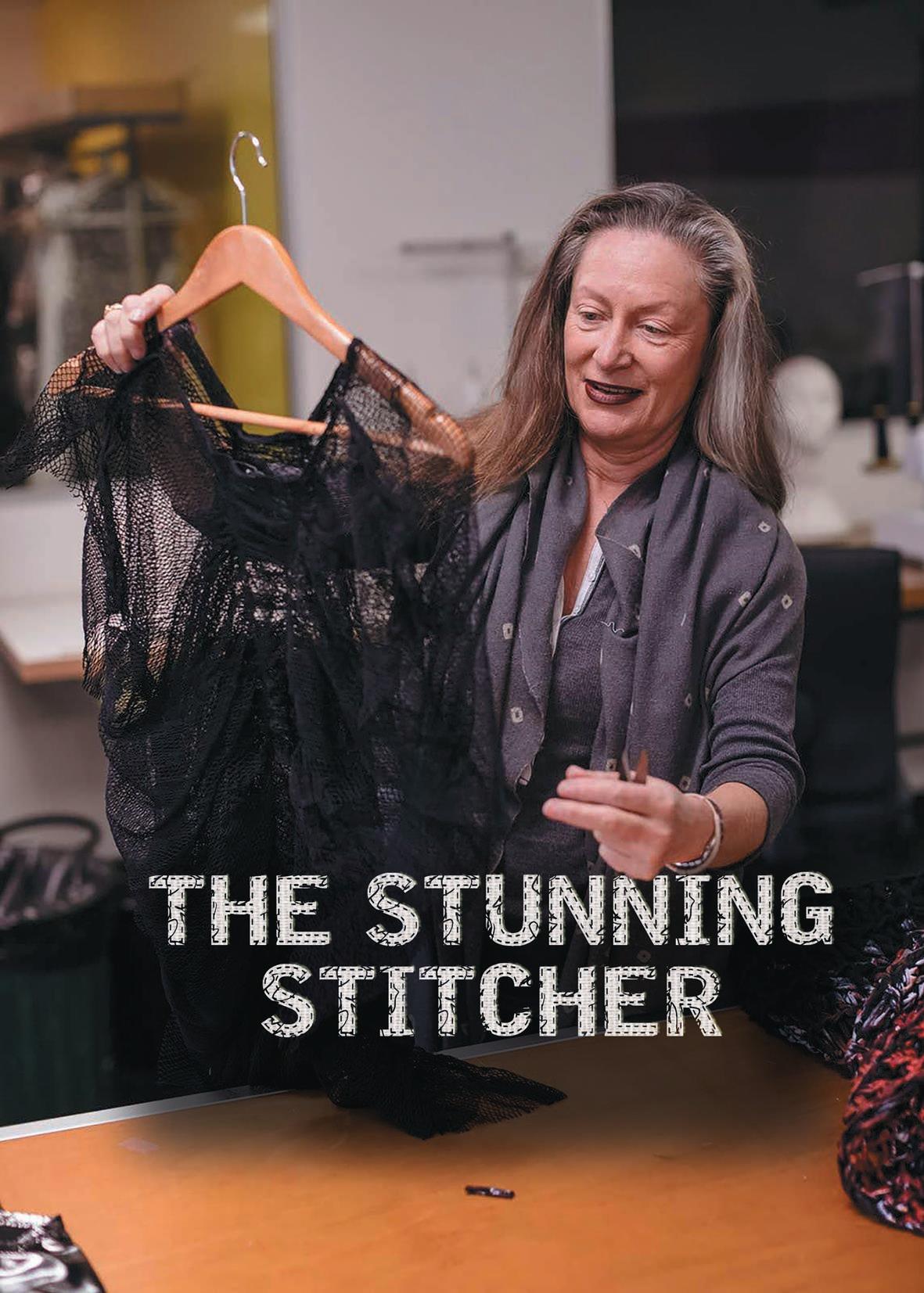
Jennifer Irwin is Australia’s most applauded costume maker adding to decades of recognition with yet another recent award for her work with Bangarra Dance Theatre. Martin Portus explores what’s made her creations the perfect fit especially for dancers.
She was a shy girl at Pymble Ladies College but loved lipstick and dressing up and so, thirsty for life, she escaped home to study applied arts in Wagga Wagga. Australia’s applauded costume designer soaked up more inspiration in 1980 at Adelaide’s new tech arts course, and stayed on just as the city’s dance and theatre scene was blossoming. She “helped and picked up” costumes backstage, often unpaid, but Jennifer Irwin was soon trading on her special sewing skills.
Back in Sydney, upcoming choreographer Graeme Murphy nabbed her as a costume assistant, soon supervisor, for his embryonic dance company.
“Graeme was already making a name for himself,” says Irwin. “But we worked in a complete dive, a crumbling squat in Woolloomooloo where the Housing Commission kids used to break into our cars and rob buildings; like it was pretty wild, with just one shower for all the dancers.”
But Irwin was busy perfecting another of her signature costuming skills: how to make sheer gossamer body stockings which, while strikingly adorned, fully reveal every muscle of the dancer. So began her long and outstanding creative association with two of Australia’s dance landmarks Graeme Murphy’s Sydney Dance Company and from 1992 Stephen Page’s Indigenous Bangarra Dance Theatre.
Her first chance to actually design SDC costumes was Sirens, Murphy’s homage to ten famous women, right at home at Kinselas, the happening nightclub on Oxford Street. She then created high impact costumes for Shining, Murphy’s lyrical hymn to hedonism which from 1986 toured the world. By this time the company was smartly housed in Walsh Bay and Irwin was irreplaceable. She not only made all her own costumes but also those of other designers sometimes chosen by Murphy for more character -filled dances.
Over decades, she’s designed costumes for 33 SDC shows, 37 Bangarra dances and nearly 20 major ballets, always with a fresh vision, sculpturing new design ideas from
new technologies and fabrics. She was commissioned for the opening and closing ceremonies of the Sydney 2000 Olympics and her work has been staged live in more than 90 countries.
Irwin also designed the world premiere in Sydney of the musical classic, Dirty Dancing. Twenty years later it continues today to travel the globe and unusually for Australian creatives working at home on big musicals she still gets royalties.
“Dirty Dancing really allowed me to survive in this industry,” she says. “Working in the arts you might be very good, at the top of your profession, but it doesn’t make you a lot of money; it was very unusual for someone like me working in subsidised live performance to get that job.”
As a jobbing creative, Irwin must be inventive to find new work options and, in her coastal retreat north of Sydney, says she’s nervous at the idea of retirement. Those skills at sewing, cutting and making her own costumes, especially those bodysuits, won her gigs on The Lion King and movies like Wolverine, The Matrix and Mission Impossible, and are vital to her survival.
“If I may say so, I make the best bodysuits I can do it with my eyes closed. If you can cut dance costumes you can make action costumes to fit perfectly on any body. I do all the stretchwear for Opera Australia.”
Vital to Irwin’s success is her hardworking loyalty to a small band of prestigious companies who keep coming back. She’s now rethinking the 1950s as costume designer for Guys and Dolls, which Opera Australia is opulently staging on Sydney Harbour in March. Shaun Rennie has taken over as director after the sudden resignation of the company’s artistic director Jo Davies.
No wonder Irwin’s awards collection is so big. She’s created costumes for 18 Helpmann awardwinning stage productions and has a swathe from the Australian Production Design Guild, which last year recognised her with the award for Outstanding Contribution to
Design. She has ten further APDG nominations, and in August 2024 won Best Costume Design for her work on Bangarra’s Yuldea
Yuldea was the first production by Frances Rings as Bangarra’s artistic director following the departure of founder Stephen Page. It drew on colonial episodes of environmental devastation as experienced by the people of the Western Desert of South Australia; Rings’ own country is adjacent in SA’s south west. Irwin also designed an earlier, abstract work by Rings, Terrain, inspired by Lake Eyre, the dancers distinguished by Irwin’s sprouting feathers, clusters of leaves and headdresses of spinifex and sprays of twigs. Her costumes so often look like she’s been out in the desert picking up nature, but no she hasn’t.
“I’ve never used a leaf, or any real feathers, but I’ve made plenty! And I don’t usually go out on country.”
Bangarra’s first big hit was Ochres at Sydney’s Enmore Theatre, where the company found a keen new audience in 1994. And Irwin learnt heaps about how the different colours of ochre which Bangarra dancers paint on their bodies soon become an organic part of her costumes.
“It’s a nightmare but it’s terrific. I look at costumes as something that will disintegrate over time, but actually they get better, because ochre you can’t wash off, especially the red. So the costumes get layered and layered from ochre on their bodies, often head to toe, and on the floor they and the stage become an art work. We often put talcum powder on the costumes which gave them an initial puff of smoke, an added spiritual touch! That evolution of costume making as the dancers wear it and make it their own wouldn’t be possible with any other company, dance or theatre.”
Bangarra has gone on to create exemplary production standards, with inventive composers like David Page and Steve Francis and Jacob Nash’s stunning abstractions of landscape. It’s all a long way from the set of
(Continued on page 46)
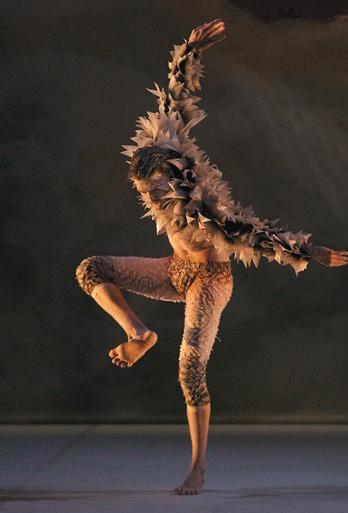

Jennifer Irwin shares her inspiration behind the costumes for Terrain. youtu.be/Xyj3ijK8TYA
(Continued from page 45)
Ochres “it just had a little mound,” laughs Irwin.
She’s always worked alone, with a glimpse perhaps of a set design, but often without Stephen and the company seeing her work until dress rehearsal. “They trust me,” she says. “And they’re running around doing their own things.” Later came early meetings of the creative team, Stephen had clearer initial ideas, and the set was built earlier, but Irwin still had challenges.
“When you’re working with dance you’re building and making costumes as it goes along, because choreographers have an idea, but only in the process does it unfold and change! So with the SDC and Bangarra, I always started with the presumption the dancers have to be free to do anything, and will always end up on their knees because the works are so grounded. Now we have developed a design shorthand I think we actually see the same images when we are talking together.
“And over the years I’ve educated myself. As a non-indigenous person, I
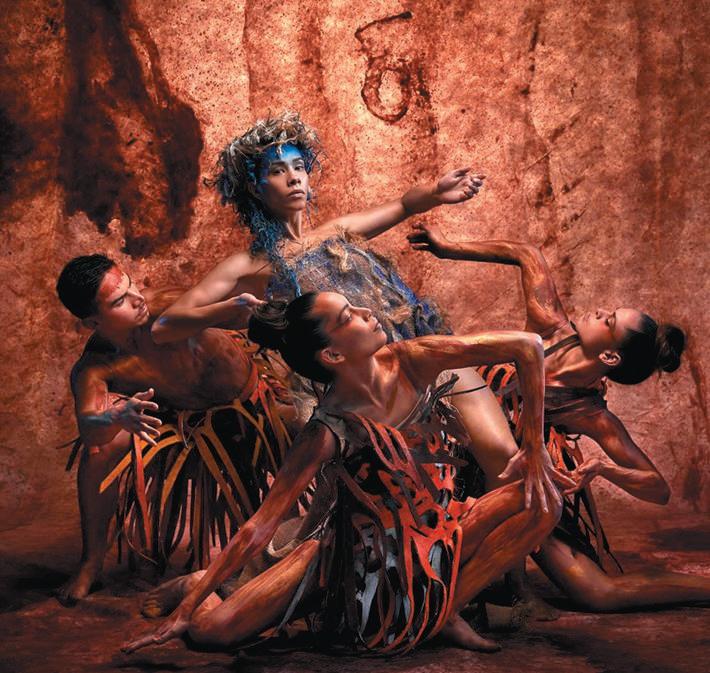
have to be careful; I basically give them a costume which is abstracted from traditional Indigenous, but I would never go to that source. I’d ask an elder for something like a feather string, but never make that myself. I would use textures or weaving but it’s not traditional in any way, just suggestion.”
Stephen Page was barely out of his teens as a dancer when Irwin met him at Sydney Dance Company, the first big salaried job for both of them. And she designed some of the first works he choreographed there.
She’s very excited that decades later they’re soon both returning to the SDC to create together a new work for September 2025.
Irwin has worked with Stephen and his team from the very start of Bangarra, through the tragic deaths of his brothers and collaborators: Russell on the opening night in 2002 after he so beautifully danced a solo in Walkabout, and David in 2016, the effusive composer who created Bangarra’s signature mix of traditional, language and natural sounds with contemporary rhythms from around the world.
She’s also watched and shifted her costuming approach as Stephen Page this century took on more historic contact stories of both black and white Australia. It began with Mathinna, about the Aboriginal girl adopted then abandoned by Tasmanian governor John Franklin; then Patyergarang about her language exchanges with Lieutenant William Dawes in colonial Sydney; and Bennelong, a witty yet often horrific pageant of scenes from the Indigenous and settler life of Governor Phillip’s chosen black “ambassador”.
Irwin of course did thorough historical research into the period costumes required for these increasingly extravagant and compelling dance theatre works. The biggest was Page’s final major work for his company, Wudjang: Not the Past, an epic story of pre-settler and contact scenes in Australia collaboratively told by dancers, musicians, singers, actors, designers and Irwin’s inventive costumes for them all.
“I think Mathinna was a turning point where he drew from historical
stories, all with the sanctioning of the clan Elders of the stories given over,” says Irwin. “Maybe it was because Bangarra had by then become so much respected and was now in a position to be custodian of stories that needed to be told … the stories of Mathinna, Patyergarang, Bennelong, all names that we know but this is their real story from an Indigenous perspective.”
Jennifer Irwin naturally jumped at the chance to get the band back together, when last January at the Adelaide Festival they created Baleen Moondjan, Page’s first commission since Bangarra. Set on Glenelg beach, within Jacob Nash’s enormous whale carcass, to music by Steve Francis, these were tales of Baleen whales passed on to Page by his mother. And critics praised the costumes.
Irwin in 2024 herself was also back with Bangarra for The Light Inside Horizon collaborating with New Zealand choreographer Moss te Ururangi Patterson on a striking work of Maori landscapes, coasts and lakes, the dancers draped in her ephemeral autumnal-shaded cloth.
“Terrain with Frances in 2012 was a turning point for me where my work became more sculptural. I took a leap of faith, really exploring what fabric could do, pushing it further. Possibly my most recent works have been my best. Working with choreographers and directors who trust your input always gets a better
result. But The Light Inside was not that experience for me.”
Indeed, after decades helping to forge the design aesthetic of Bangarra, Irwin thinks this will be her last show for the company.
“I have mentored my young Indigenous designers and now it’s time to step back, whether I want to or not. It’s definitely time.”
Meanwhile she’s happily worked with her other great collaborator, director Graeme Murphy, on a sumptuous touring production of Opera Australia’s The Merry Widow and a revisionist Madame Butterfly
“In absolute contrast to Bangarra, Madame Butterfly is a white story in Japan that some argue should not be told in this day and age. Graeme wanted a contemporary approach. There was much conversation about where she came from, working as a geisha girl and about the ancient arts of Shibari/Kinbaku rope tying. My costume designs are always informed by the set, so MB became very architectural and clean cut. I focused a lot on the art of origami using a lot pleating, abstract and structured.”
She’s designed significant stage productions for the Sydney Theatre Company and Belvoir and knows well the added responsibility of placating actors keen to discuss character in the making of their costume. Dancers are less concerned.
But Irwin is pessimistic for the future of her profession, with jobs so
scarce today for an ever growing surplus of talented designers, and performance companies which save money by employing designers to do both set and costumes.
“It’s a young person’s industry, so very hard to make a living financially. Australia just doesn’t have the population to support the numbers of people coming out of colleges every year. But as a young designer you live the dream, working from one show to another. Designing for film is better paid but everything revolves around money rather than the product and rarely do you get the opportunity and that freedom of live performance design.”
Yet somehow, without relying on film, Jennifer Irwin continues to build her outstanding legacy in costume design, and even in the niche and competitive world of dance. She’s achieved the dream she had as a shy little kid who made shoes by tracing her foot on cardboard and attaching empty cotton reels for the high heels.
“I love my job. I’ve always loved the adrenalin race to get the show on a collaboration of everyone working together to finish, before the curtain goes up.”
This article draws partly on an oral history interview with Jennifer Irwin by Martin Portus available online at the State Library of NSW.
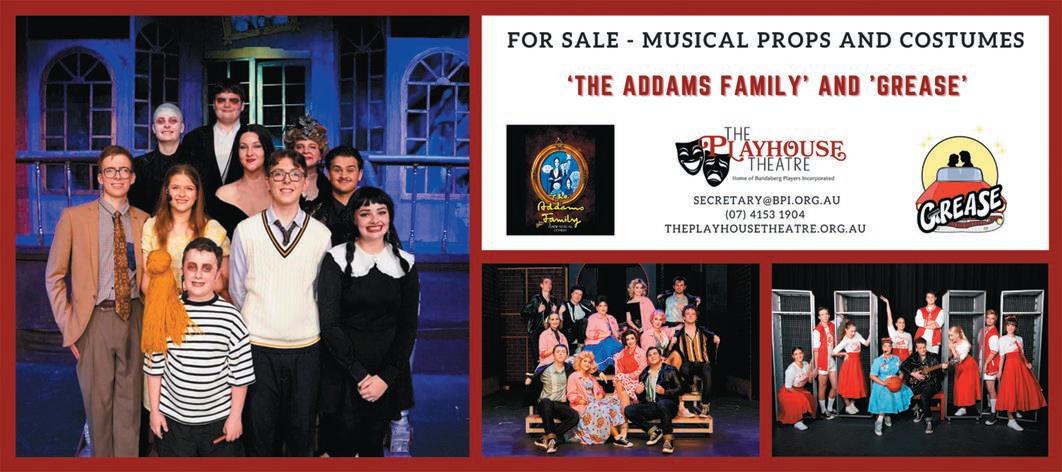
NIDA student Paris Koppens had to blend the animal and human worlds in designing the set and costumes for the play First Love Is The Revolution, staged in June. Isabella Nocetti reports.
An unconventional love story between a fox, Rdeca, and a boy, Basti, First Love Is The Revolution starts when Basti catches Rdeca to make a coat out of her fur for his ill mother. The plan comes to a screeching halt when Basti finds that he can understand the fox when she speaks to him. Through the conversation the two become fast friends and eventually fall in love. When Rdeca’s mother finds out about this love, the fox is cast out of her den, and the couple must find their own way in the world.
Isabella Nocetti: Can you describe the design of the stage?
Paris Koppens: We had the one end of the stage that was sloped upwards which became the “wild side”, and then the flatter end of the stage had the kitchen, so it became
the “human side”. In the centre of the stage there’s a love heart which was Basti and Rdeca’s home that they create for each other between the two worlds.
IN: In the process of designing this, had you seen images of the play, or was it all original?
PK: I had never seen it before. For the first couple months of the project, I designed without looking at previous material so that I wouldn’t get influenced. I did eventually see some images online, but not until after I had designed the set.
IN: What was the process of building the set and setting up the stage?
PK: Most of the set was made of recycled MDF and Yellow Tongue sheeting, and it was made to look like concrete.
IN: What inspired the costume design?
PK: In my design process, I start with the costumes and the characters, and then the world evolves out of that. What I wanted to draw attention to was that both the foxes and Basti’s family are poor. We were also interested in finding what the Australian class archetype of the different animals would be. We also didn’t want there to be any obvious fox or animal signifiers. We wanted the animal concept to be more of a metaphor. Rdeca is a red fox, so we knew we wanted her to be in red, and that’s where her costume stemmed from. I wanted the humans to oppose the red of the foxes to create a sense of “two worlds colliding”.
IN: How did you determine what
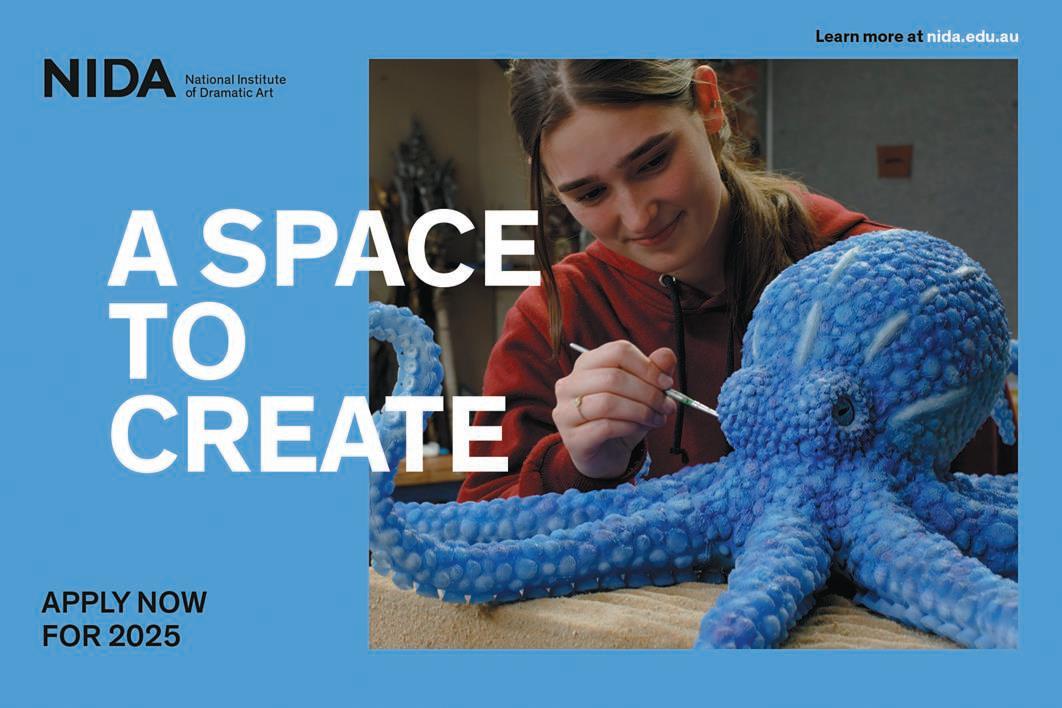

Meet Paris Koppens as she discusses her Design For Performance portfolio. youtu.be/c6DtMUaOz1o
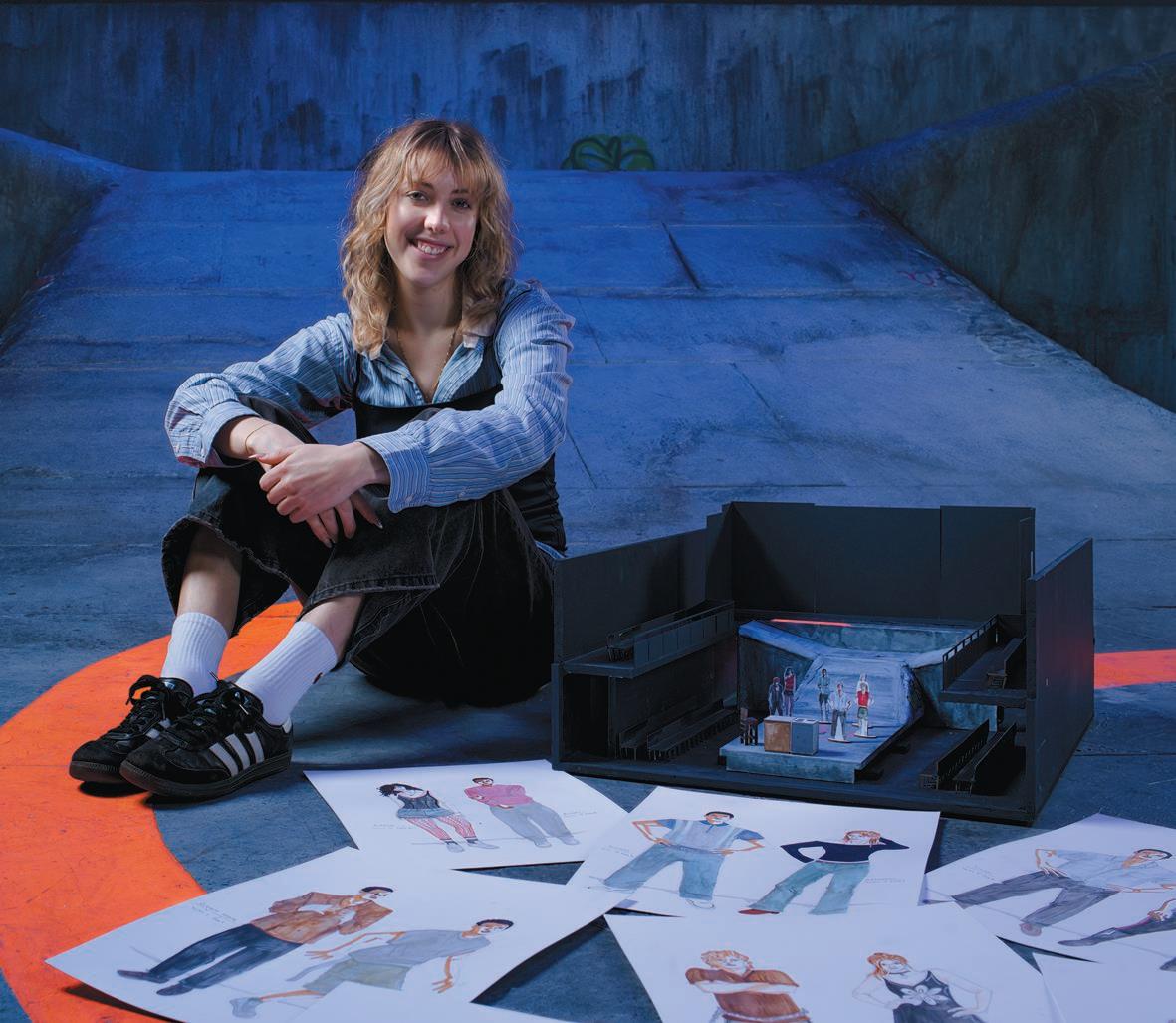
Applications are now open for NIDA’s 2025 intake. Find out more about the courses on offer at nida.edu.au
costumes animal characters would wear?
PK: We started with who they were as characters. So, the chickens are these dowdy, older women. They’re funny characters. We wanted them to look frumpy, but still be charming. That’s why we went with quilted vests and the matching hats.
IN: What was the process of making or acquiring the costumes?
PK: Most of the costumes for this show we were able to buy, source, and alter. A lot of the costumes we wanted to look worn and run down to demonstrate that level of class. So,
the costumes were art-finished to look like they were older or were distressed. For example, the mole jacket was art finished, for which we added artificial dirt, cut holes, and sanded with steel wool to wear things down.
IN: What were some of the challenges of making people resemble animals?
PK: In the script, the animals have fur around their eyes, and fleas, so leaning away from that was a challenge. Also, making sure that the humans and animals had distinct differences between them so that you
could see that they’re animals before it’s said. We made those distinctions with stylization. There are pieces in each of those costumes where you realise they’re not human.
IN: Tell me about the BFA Design for Performance course you’re taking at NIDA.
PK: We get to experience such a range of designs and have a balance of theatre and film. This year, I designed and helped direct a short film, and I am working on music video design.
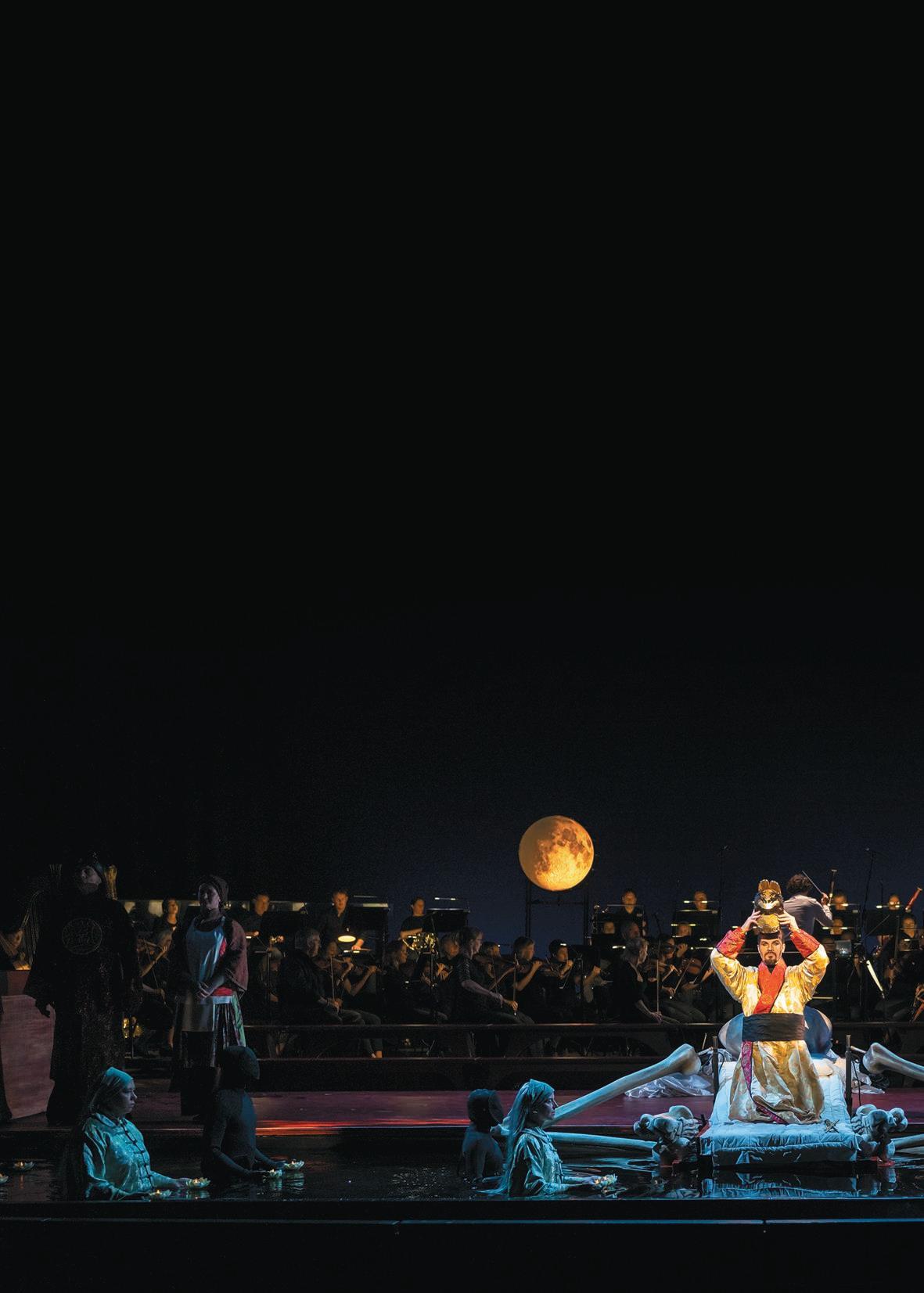
One of the highlights of the 2024 Adelaide Festival was a production of an extraordinary opera directed by Canadian Robert Lepage, which saw 67,000 litres of water pumped into the orchestra pit. Barry Hall OAM reveals the challenges of throwing singers into the deep end.
The jewel in the crown for the 2024 Adelaide Festival was undoubtably The Nightingale and Other Fables by Igor Stravinsky of the Ballet Russe fame, which was a feast for visual and aural senses.
Every time I thought I had seen everything, there was another astonishing piece of theatre magic.
The first half of the programme featured some little-known gems from Stravinsky three clarinet solos, Pribaoutki, Two Poems of Konstantin Balmont, Berceuses du Chat, 4 Russian Peasant Songs and Renard (The Fox).
These used varying configurations of the orchestra, seated on stage behind the singers with a platform at the back for acrobats performing behind a giant screen.
In the second act, The Nightingale, Stravinsky’s only opera (based on a fable by Hans Christian Andersen) was performed in a co-production from the Opera National de Lyon, Festival D’Aix-en-Provence, Canadian Opera Company and Dutch National Opera, in collaboration with Ex Machina.
This production turns opera on its head. Instead of being in the pit, the orchestra is on stage and the singers wade and float in and on a manmade pool/river flowing in the orchestra pit, as well as the front of the stage. Together with singing, the actors manipulated beautifully detailed rod puppets representing their characters.
I spoke to Bruce Bolton, the Production Manager, about the logistics of turning an orchestra pit into a pool.
I was keen to know how long before the show arrived in Adelaide, he received the staging requirements.
“I started nine months before… they would normally start a year ahead for opera because it’s generally big, and it’s also the first off the bat.
“The bump-in was a week and a half. It wasn’t a huge show physically; it was all about the pit and the pool. The two tricky elements were the water in the pit, and the full changeover of the orchestra seating at interval. Those were the two things that occupied most of my waking life!
We got the change at interval down to 16 minutes.”
When asked about the pool itself, Bruce was quick to point out that, “It’s actually quite a nice build, but very heavy. It’s a jigsaw puzzle of marine ply and framework and came in sections. It’s not a huge build for opera. It came in three containers; one container was all pool. The parts all lock together reasonably easily.”
Having said that, even though several people accompanied the production from Lyon, the opera hadn’t been performed since COVID19 hit and their memories were not fresh.
“We started the pool build, and our mechanists realised there was something wrong, and realised they were building it upside down!”
Lyon sent out two pool liner experts.
“They would put down the pool liner and ‘weld’ it into place with a sort of heat gun. They had a sort of ‘spike’ tool which they would run around the seams to ensure everything had glued properly. That
99% worked, but three hours into filling the pool Oh, my God, we have a leak!”
So, the rest of the day was taken up with getting the pool drained. Once the leaks were fixed (in 20 minutes) all was fine. But that was not the only leak.
“During performances there were a couple of hiccups. There was an ‘infinity pool’ to catch splashes during performance an overflow. That had a leak as well, but that one was easier to fix.”
Just when Bruce thought it was smooth sailing, there was another problem.
“We had to buy a brand-new filter pump. After that, everything was fine!”
Technically, the ‘river’ was run just like a domestic pool, however, “The good thing is being indoors meant that the chlorination level did not have to be as high. There was a pool technician from Lyon there for the whole season, and he looked after that every day.’
The pool was heated.
“One of our local mechanists is a surfer, so he was keen to get into a wet suit and operate the blinds under each side of the pool and help guide the boats ‘off stage’.
“He worked with a mechanist from Lyon who was on the other side.
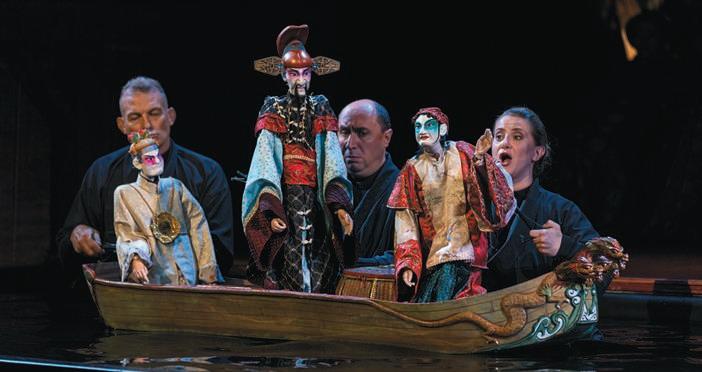
They were both in wet suits, as were the singers and the puppeteers.
“Everyone in the show was in a wetsuit… we probably needed a double set for when there were two shows in a day, but we didn’t have them, so there were times when they had to put on a ‘wet wetsuit’… The cast were great; we never heard a grumble from them.”
When asked about the singers and puppeteers, Bruce was quick to add his admiration.
“I don’t know how they did it. It’s like rubbing your stomach and patting your head at the same time. I was really impressed with how much they could get out of their puppets, singing at the same time. It’s brilliant!”
Of course, at the end of the run the set had to be bumped out.
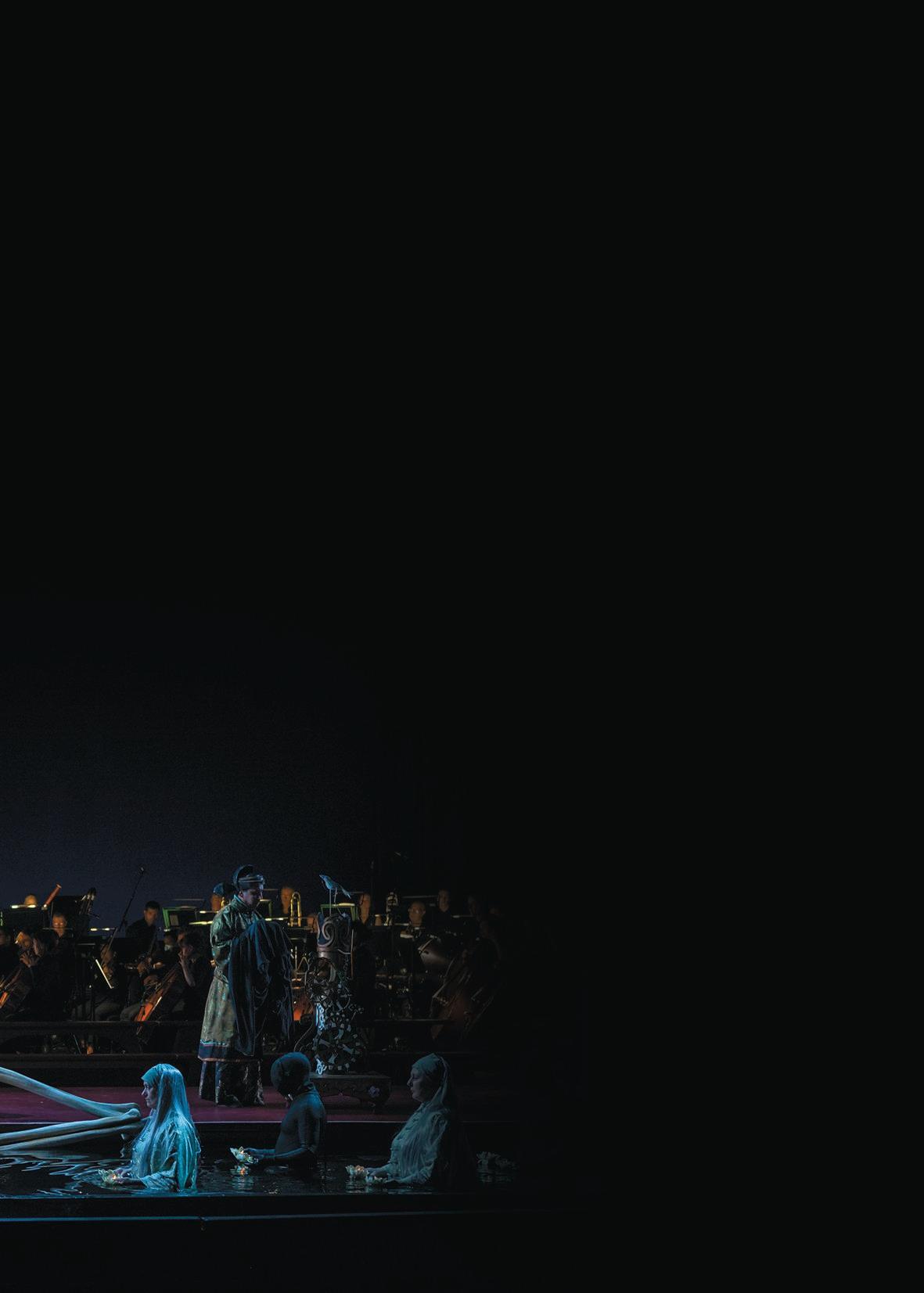
“The theatre needed to be turned around for the next day, so we only had one day. There was a lot of pressure. When we finished the show on the Wednesday night, we got as much done as we could with chairs, risers, etc., then the big thing was to have the water out that night. They were pumping till 4.30am. The rest of the next day was to finish and get the pit ready for the next show.”
Bruce summarised the experience wonderfully.
“One of the joys of doing this was meeting director Robert Lepage, who was here for a week. He was such a lovely man, and great to work with.”
The Nightingale and Other Fables was a once in a lifetime theatre experience made even more meaningful by talking to one of its stage creators, Bruce Bolton.



Verity Laughton’s stage adaptation of Pip Williams’ best-selling novel The Dictionary of Lost Words was a technical triumph and commercial success. The novel tells the story of fictitious Esme Nicoll from the age of eight in 1886 through to a thirty-three-year-old woman in 1915, set against the creation of the venerable Oxford English Dictionary.
While the principal stage set is the ‘Scriptorium’ or ‘Scrippy’, the shed where the dictionary editors work there are numerous other locations. The huge time span, unusual for a stage play, also presented creative problems for the theatre makers: Director Jessica Arthur, Designer Jonathon Oxlade and Lighting Designer Trent Suidgeest. They all
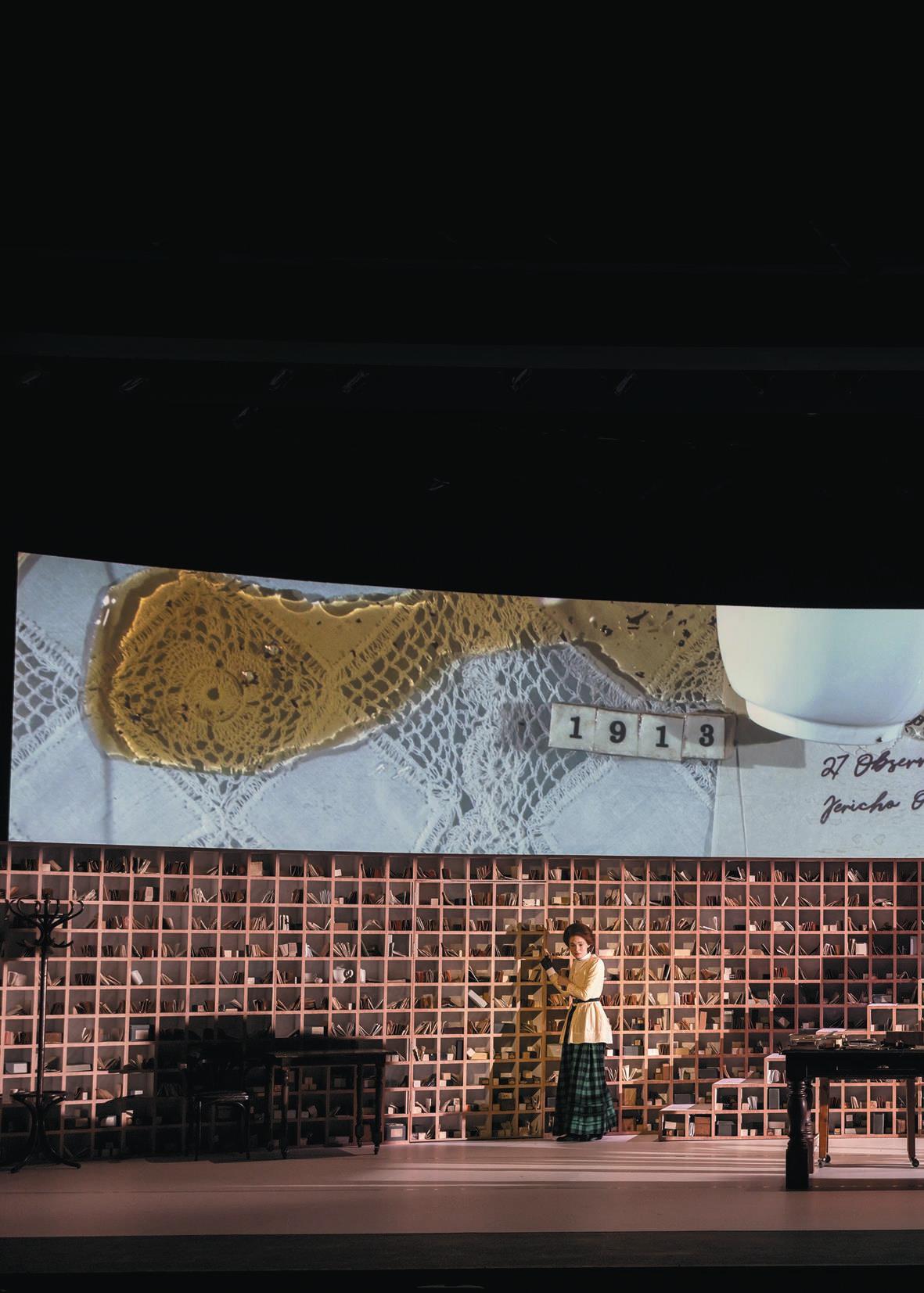
read the novel and sometimes referred back to it but their task was to realise Verity Laughton’s complex adaptation script. Their creative collaborations (and a great cast) brought this multi-layered story to life.
Designer Jonathon Oxlade’s inspired set design for the Scriptorium comprised over seven hundred
pigeonholes, curved across the whole width of the stage, and fronted by desks covered with books and papers; it was both utilitarian and suggestive.
Stage Whispers Michael Brindley spoke to Lighting Designer Trent Suidgeest.
Michael Brindley: I’m assuming Jonathon’s basic Scriptorium design was a first step?
Trent Suidgeest: Jess and Jonathon had some time together to work out the concept and over-arching style, and a pass at the physical structure. Then I began contributing as Jonathon continued to dig into his designs. The idea for anchoring the show inside the Scriptorium and the projected elements is all Jonathon and Jess, then how we morph these elements to keep the show evolving is where we all continued from.
MB: While the basic double height set of the pigeonholes was fixed on stage, your lighting had to suggest or enhance not just the passage of time but a variety of other locations besides the central ‘Scrippy’. There’s the maid Lizzie’s room, various exteriors, the street, the market, a
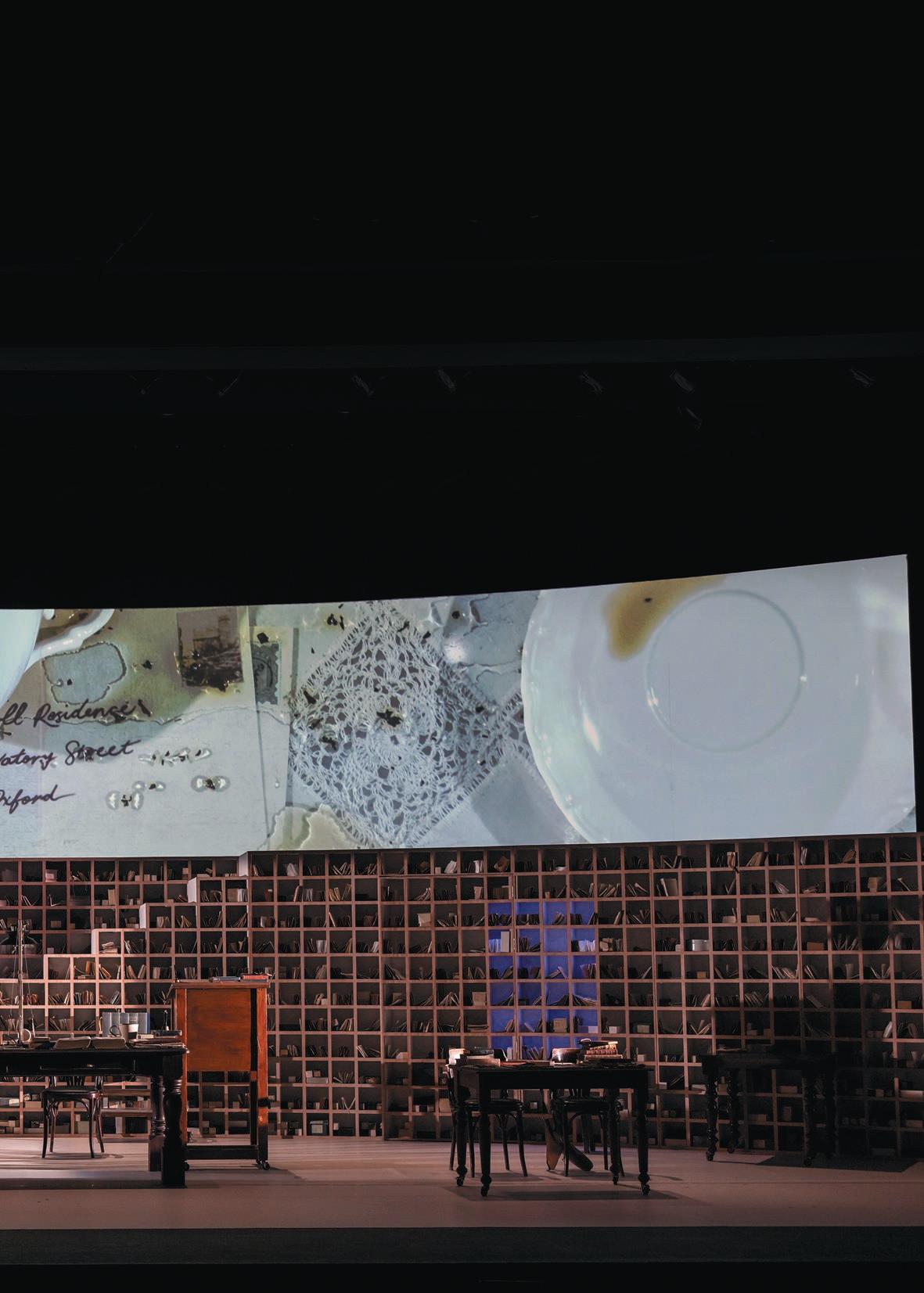
pub, the typographers’ space and the Bodleian Library. How did you approach that challenge?
TS: Yes, I’m not sure I’ve ever designed a play where the lighting requirements were so diverse, but it’s a huge story to tell so the lighting needs to contribute to that in many ways.
Aside from traditional stage lighting from all angles, one of the exciting design concepts for me was the way we lit all of the pigeonholes. The marvellous production team at State Theatre Company of South Australia fitted every pigeonhole with a custom LED pixel chip 770 in total all delicately strung throughout the shelving walls. The pixels are colour changeable and
individually controllable, so I use specific pixels to compose suggestions of windows glowing, or gradients to focus our attention.
Those lights are used to transform the basic set into many locations always complementary to the stage action and the projections. [Of which more later.] Some of my favourites are: an oversized tartan wiping across during a transition and the suggestion of a cobblestoned street during an outdoor scene using random intensities of greyscale. We also found a couple of moments for some shadow play beyond the pigeonholes, on their back surface, so we used a material which took light from behind.
(Continued on page 54)
I designed two additional layers of lighting from upstage one washy, one to cast shadows of humans to be able to create silhouettes of people, the slips of paper (for introducing ‘found words’) and props in the pigeonholes. Sometimes the backlit shapes of all of those props are more interesting than seeing them lit by the individual pixels internally.
MB: The changes of location especially to the market and the pub were always clear and achieved so efficiently via some furniture movement, minimal props and costume changes. Your job was to add another layer without your work being too obvious.
TS: I was actually sometimes nervous that the shifts in lighting were too overt! I’m always tracking the reveals of the various elements and the depth to which the lighting shifts aligned with Esme’s journey. As the world widens for Esme so too does the degree to which the lighting supports that. The colour and shape

in the lighting become richer; more vividly presented.
Once we’re into the pub scene and dressing room we’ve built into full red and amber highlights, which then allows the world of the Scriptorium to be our anchor in versions of bright warms and daylight, and ultimately the stark cold whites come with scenes of pain.
MB: A particularly fine sequence
occurs late in Act II, when Esme must tell would-be fiancé Gareth about her past. It’s beautifully staged by Director Jessica Arthur: it had no words yet was absolutely clear and almost a suggestive dance. The characters became moving silhouettes. What is the role of your lighting in this sequence?
TS: Oooo yes, definitely a crowd favourite! This montage sequence was conceived by Jess as a climax. We have a suspension of reality with all of the key memories of Esme’s life leading up to that moment.
I created an effect with the pixels in the pigeonholes, all pulsing randomly and rhythmically. My desire is for it to feel like the words that Esme has collected along the way and/or various moments in time, are swirling around her. I wanted it to sparkle and shimmer to heighten the magical realism we were pursuing. It is a big theatrical gesture!
MB: There is a staircase too, cleverly hidden in the pigeonholes, to an upper level, a platform principally used as Lizzie’s bedroom (Esme has
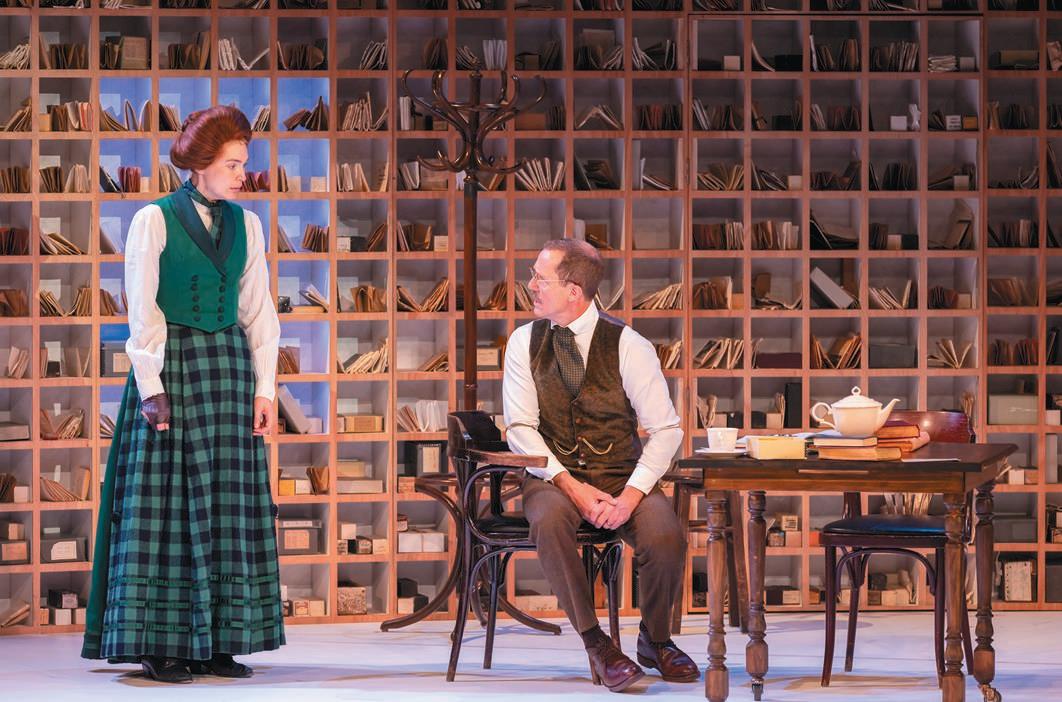
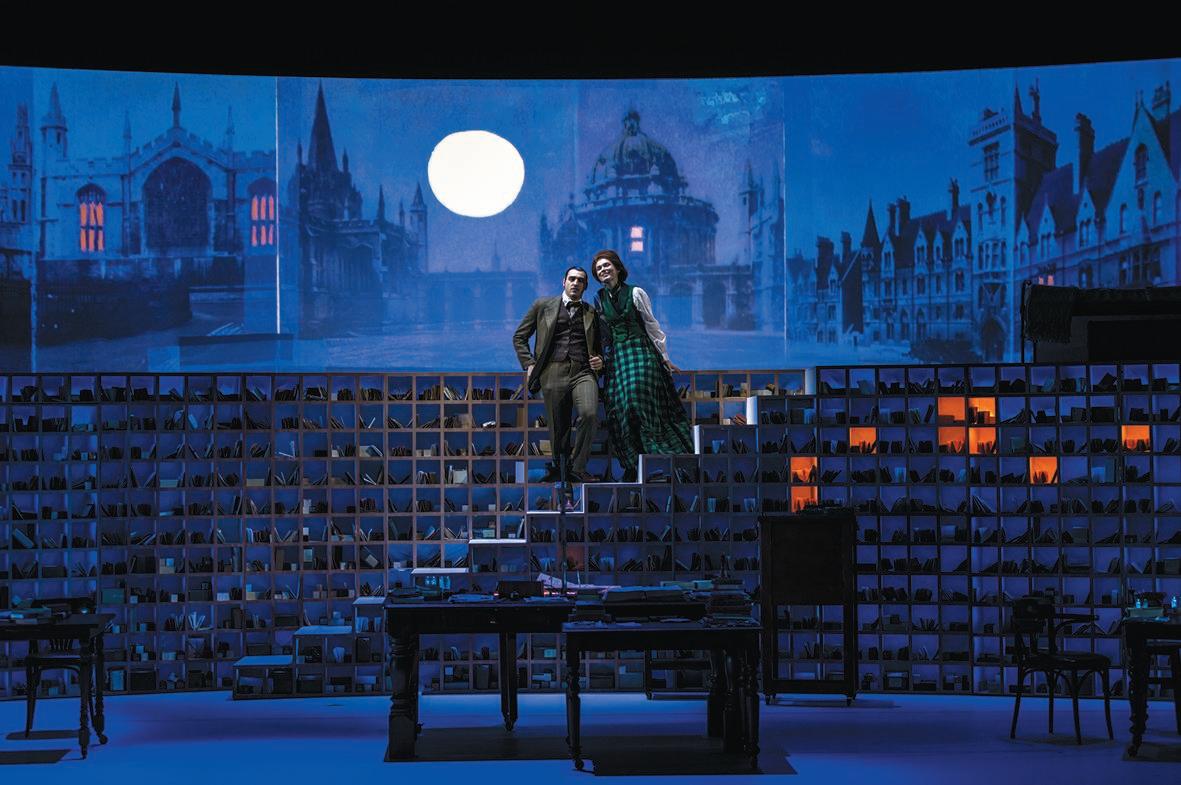
no room of her own that we see) and the lighting there was quite different to that of, say, the Scrippy. Rather cold? Any comment on that?
TS: Interesting you mention that, because that is a direct example of me picking up on that detail while rereading the book during rehearsals: “Lizzie saw it coming, so she scooped me into her bony arms and trotted up the stairs. The room was cold. Lizzie took the coverlet off her bed and laid it on the bare floor like a rug.”
As the show progresses, I warm up the lighting in the bedroom as the relationship between Esme and Lizzie builds and Esme’s collection of ‘forgotten’ words that she hides in Lizzie’s trunk become the heart of the show.
MB: Jonathon’s design restricted Lizzie’s room to just the bed and that very important trunk. Was that an extra burden on lighting?
TS: The bedroom scenes are particularly important for us to focus on the storytelling and relationship with Lizzie, so the clean scenery is useful in that way.
The projected imagery always
helps to help support those pillar moments; the pin cushion, the hatpin, the reveal of the scratched title, collected words and the dictionary. There is always a point of interest.
MB: Whose idea was it for the actors to use an overhead projector to project those key images the ‘pillar moments’ from the central desk onto the cyclorama?
TS: The concept came from Jonathon together with Jessica to create transitional scenography using words and ephemera. The objects and compositions developed right through rehearsals, as needed, to articulate places, dates, words, etc.
The actors were choreographed alongside the action to composite the physical imagery together while live projected onto a cyclorama screen above the bookshelves. I love that it’s all tactile. It speaks to Esme’s collecting.
The surface under the camera is a Lightbox internally made up of five gradated sections to allow me to light the more transparent backgrounds of plastics, silks and lace doilies (for
instance) from below, together with hidden lighting within the camera’s shroud from straight down, and sidelight from above in the rig. All the light sources were LED colour changeable, so we could finesse the exact colour and intensity combinations. In being able to light all of the projections live and then have everything cued within the lighting cues helps it move like transitional scenery.
I spent a great deal of tech rehearsals lighting the objects and props under the camera for the projections. It felt like lighting large scale traditional scenery backdrops. I work to find harmony between the lighting of the actors and pulling all of the miniature projected scenery together into cohesive stage pictures.
MB: Well, as an audience member, the harmony and cohesion between all designs really showed. You all did a marvellous job with an expansive and challenging text. Thank you, Trent.
It is 100 years since French fashion designer Gabrielle ‘Coco’ Chanel created her first ballet costumes for Le Train Bleu, danced by Diaghilev’s Ballets Russes. The experimental work was inspired by the first Paris Olympic Games, and Coco had only designed her very first stage costumes two years earlier at the age of 39! However, creative reinvention was c’est naturel for this enigmatic creator. Serendipitously, in this Olympic year, Queensland Ballet is presenting a new ballet, Coco Chanel: The Life of a Fashion Icon, choreographed by Annabelle Lopez Ochoa, with artistic collaboration by Nancy Meckler, an original score by Peter Salem, and set and costume designs by Jérôme Kaplan.
Beginning to channel Chanel Annabelle (our choreographer) and I sought inspiration from the Chanel exhibition at the Palais Galliera in Paris. It was astounding to see dresses from the 1920s that would not look out of place today. We realised that Coco’s style was ‘less is more’ or to quote Coco, “Simplicity is the keynote of all true elegance”. Then, when you look closer, you see that her designs also gave women the freedom to move as they broke away from unbearable corsets. Coco broke down barriers because her designs could be worn by any woman. And that also helped us to highlight Coco’s social and historical significance. Coco was ahead of her time. She loved to wear men’s clothes and take inspiration from the men in her life. So, as well as the women’s
Jérôme Kaplan shares with Beth Keehn how he created the essence of Coco Chanel for the stage ahead of Queensland Ballet’s production of Coco Chanel: The Life Of A Fashion Icon.
dresses, I looked at what her male friends would have worn exmilitary; British tycoon; polo player. I wanted to use distinctive colours for each of the main characters so the audience could easily recognise them. When it came to the costume designs, instead of replicating Chanel, I created a visual impression. While the handfinished details on haute couture dresses can be appreciated up close, a stage costume has to be seen from the back of the theatre as well as the front row.
Creative collaboration
I always start by creating mood boards for the sets, but also for the costumes, and this helps to clarify discussions. Then I build a model and design the first costumes. We move forward side by side, sharing our ideas as much as possible until the premiere. Visual ideas can come from the choreographer, and staging can come from my work. Everything is interwoven, and of course we have the very important participation of the choreographer, the dramaturg and the composer as well.
Telling a story through set design
For the set design, I drew inspiration from an unlikely source a bottle of Chanel No. 5 perfume. The original design hasn’t changed much in more than 100 years, and its timelessness was inspiring. The ballet’s first act is designed in off-
Coco Chanel: The Life Of A Fashion Icon Played the Playhouse, QPAC in October, 2024. queenslandballet.com.au
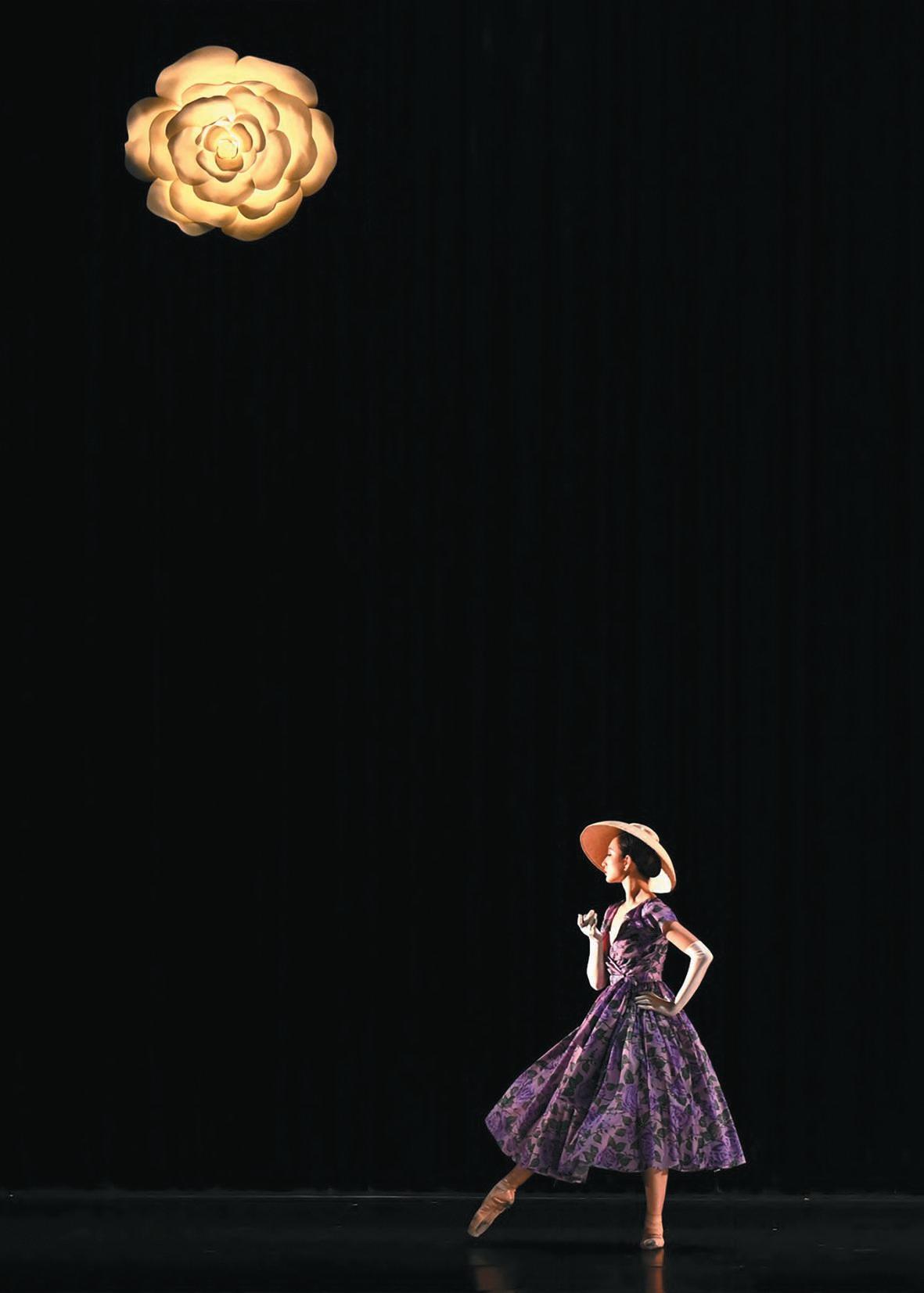
white and black lines. This pays homage to the perfume’s famous box. I used the staircase in Coco’s apartment in Paris as a key element of the stage design it is an abstract space that can be used to tell her story.
Also, Paris is a backdrop to the ballet…one that is invisible on stage but always present. Coco opened her first boutique in Paris and spent her entire life there. But what’s so surprising? Paris was then, and still is, the capital of fashion and luxury.
A guiding quote from Coco, ‘Queen of the Quips’ Chanel’s very avant-garde and clear vision of elegance brought her success but did not protect her in her private life. She was not lucky in love, neither in her childhood, nor with her successive lovers. For me, Coco Chanel is a person with a fascinating destiny, but ultimately a very sad life. Coco was an extraordinarily modern woman and very ahead of her time. Some of her famous quotes are: “Fashion always moves forward; there is no going back!”
“A woman can be overdressed, but never over elegant.”
“It’s difficult to allow women to move easily, and not feel disguised.”
“I take away: I take away everything that I put on and that I find useless.”
And all of this is so true!!
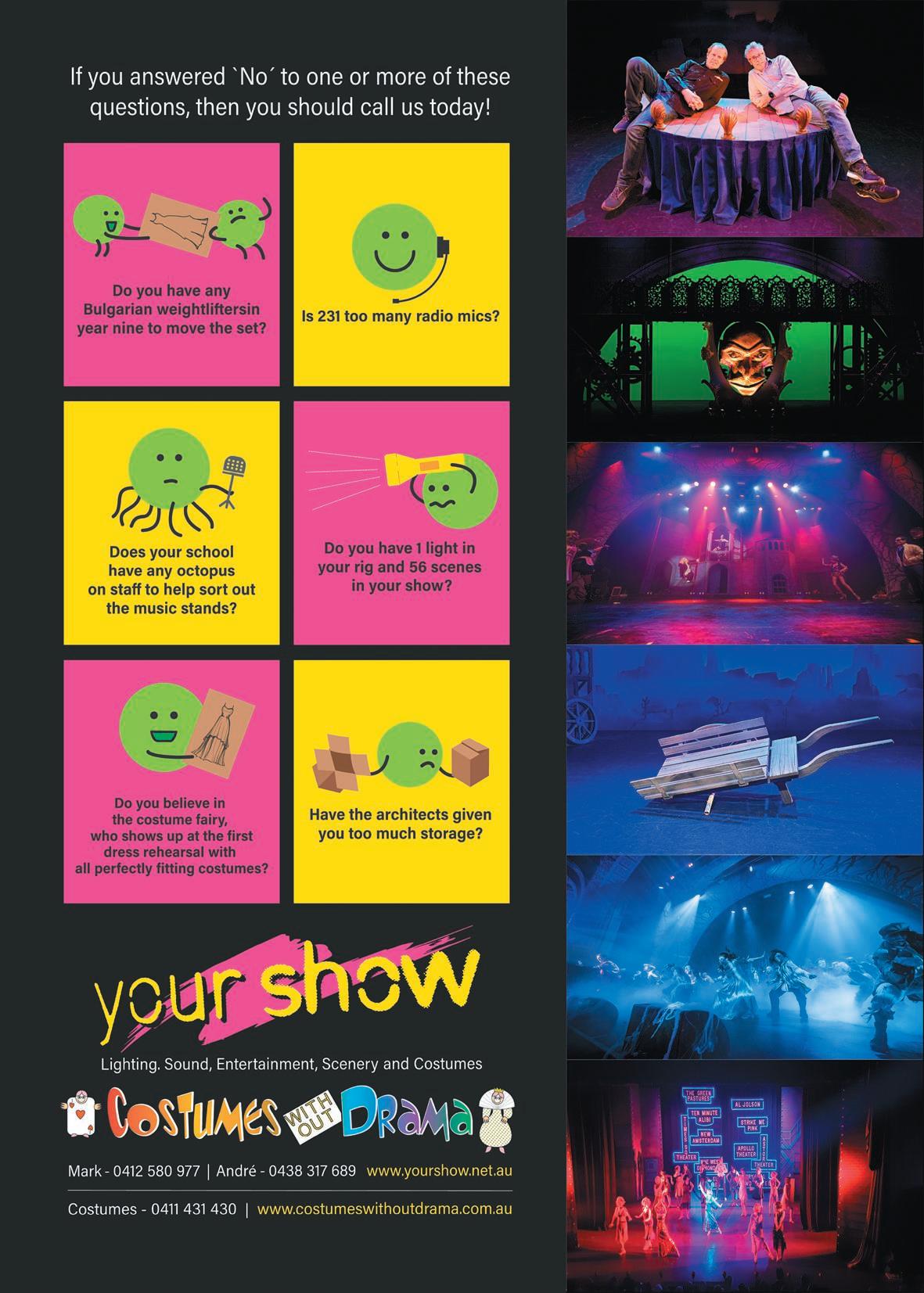
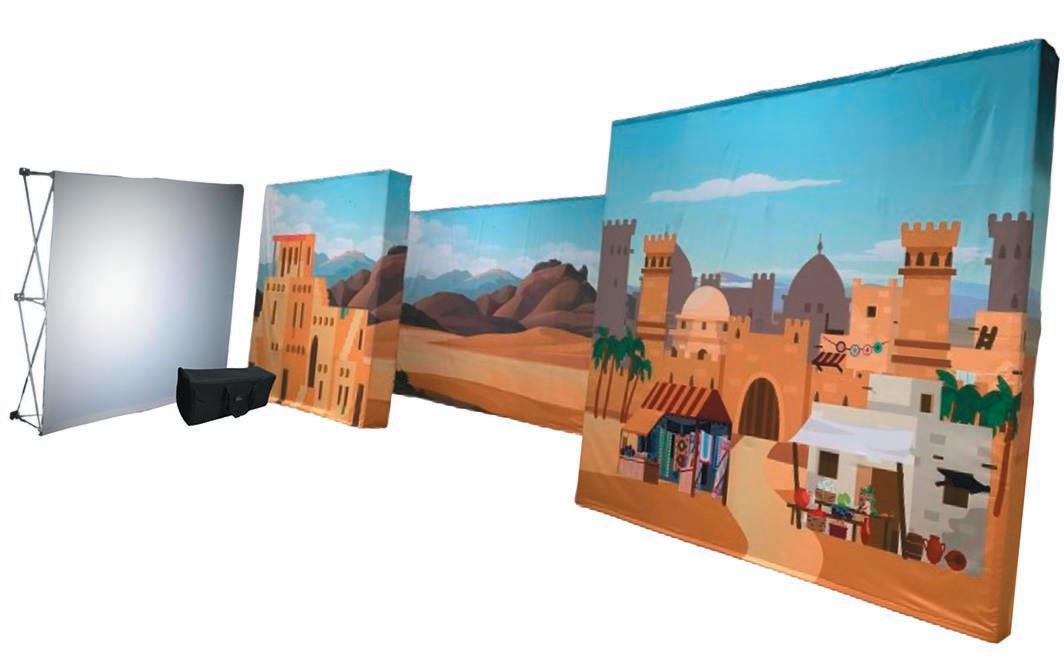
Transforming your classroom, multi-purpose room, or gym into a temporary performance space can be accomplished with a few straightforward techniques. Using portable drape support systems is a convenient method to swiftly alter your setup and maintain versatility. These systems can be adjusted to serve as backdrops, flats, masking, and photo backdrops.
Instaframe - Expandable Pop Up
Portable, lightweight, and suitable for hanging curtains or backdrops. Instaframe stands come in a variety of sizes and can be used vertically and horizontally. Ready-made drapes are available flat or pleated and are easily interchangeable with custom drapes or backdrops.
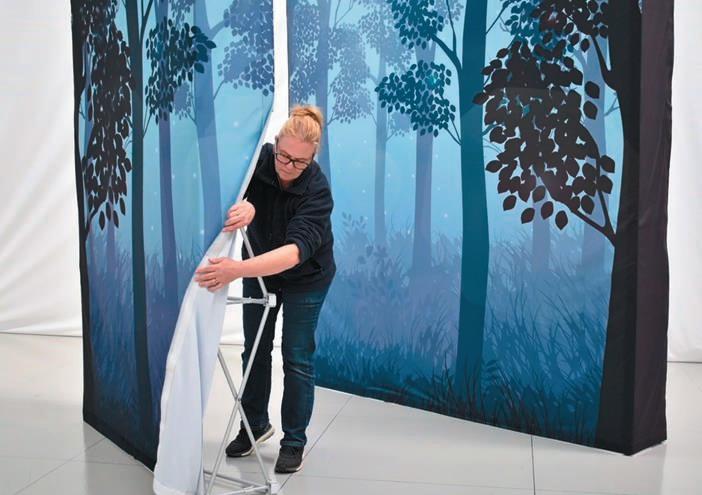
Tips from Theatre Star for transforming any space into a performance area. Visit the Theatre Star website to view their product range and take advantage of current promotions. theatrestar.com.au
If you need to vary the width and height for different applications, then telescopic drape supports are a versatile and easy-to-assemble and disassemble solution that you can pack away after use.
Tracking is a more permanent solution which we can tailor to the requirements of a venue, especially for larger spaces with higher ceilings or roofs.
Theatre Star offers a variety of products and services to meet your needs, and their experienced and committed team are happy to provide advice and site inspections.
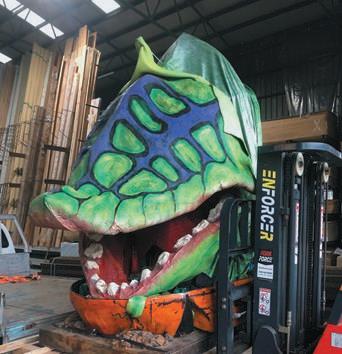
R James Entertainment is a family business comprising owner and lead builder/designer Ross James, his wife, seamstress extraordinaire Helen, who is responsible for the creative collection of costumes, with Laryssa Anger joining the team in an administration and supporting creator role. It’s a small business that cares about your production like it was their own.
There are over 20 full sets available for hire, with endless pieces of other sets and props in their sheds. Need a typewriter from the early 1900s? Absolutely! A park bench? No problem! A vintage telephone, suitcase, sword, throne, or lamppost? Easily done!
One of the most impressive sets in the collection is Charlie and the Chocolate Factory, with a light up
What started out as a hobby after retiring as Technical Manager at the local theatre, has turned into a successful business, with sets and costumes hired to theatres and schools from Cairns to Melbourne.
hydraulic lifting glass elevator, selfdrive chocolate bar and bathtub vehicles, a double story Bucket house and a full stage design of colourful LED arches.
Some other stand out pieces include The Little Mermaid grotto, with three separate destruction tricks built in; Priscilla Queen of the Desert with programmable LED screen; a double story, reversible Legally Blonde Delta Nu sorority house with balcony for quick change; and a full set of 3D printed Lion King masks.
Some of the sets are created with multiple trucks that move on and off, like the Matilda set, which includes living room, bathroom, bedroom, Crunchem Hall gates, library and Miss Honey’s house.
Other sets are created to be
Contact R James Entertainment to discover how they can help with sets, costumes or prop hire for your production sethire.com.au
stationary, such as the Mamma Mia! set, with the full island hotel facade including balconies for the Dynamos and only a revolve to reveal the inside of the bedroom. The hire also includes a few additional pieces and full stage cloths.
With full costume collections for Grease, Little Mermaid, Shrek and Les Misérables to name a few, as well as an endless wardrobe of pieces in between, you’ll be hard pressed to find a show the team at R James Entertainment can’t help you with.
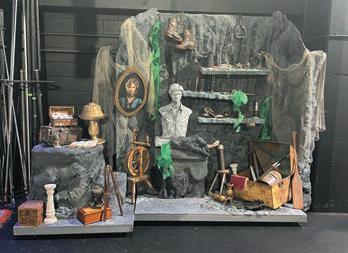

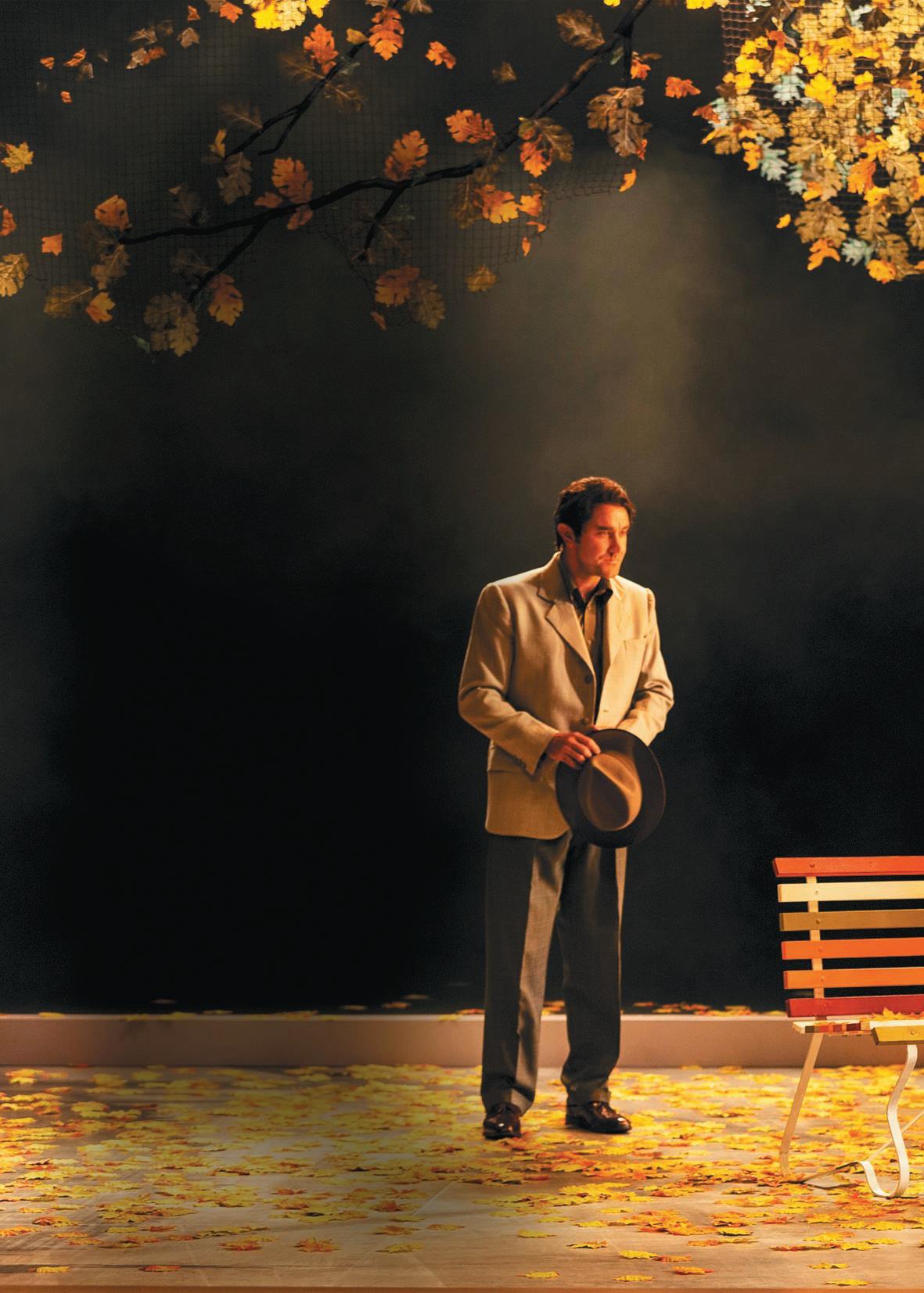
Paul Jackson was nominated in the Lighting category for his design of Melbourne Theatre Company’s production of Sunday a fantasy inspired by the stories and myths that surrounded the founder of the Heide Museum of Modern Art, Sunday Reed.
What was the overall look of the lighting that the director asked for?
The lighting design needed to move fluidly between references to actual places like a Toorak sitting room, a bedroom or a lounge at the farm at Heide, and expressionistic sequences that tried to articulate the more ephemeral registers of shared intimate feeling and creative, painterly production.
Why was it important to the story to have this look?
The story of John and Sunday Reed and Sidney Nolan is at the core of Australian Modernism and light is at the heart of all thinking about Australian painting. The play’s aesthetic needed to explore and weigh their significance as cultural figures as well as their fates as highly complex, creative, passionate individuals.
What lighting effects were critical to make this look possible?
The bucolic appeal of the farm at Heide needed to sit in counterpoint to the bold, primary gestures of Nolan’s painting dappled light of the farm and the oak tree versus the apocalyptic, stripped bare look of the Kelly paintings. Soft, golden sidelight in counterpoint to strips of harsh, bold, deeply coloured light.
How did your lighting link in with the set and costumes?
Sunday was a very integrated design process. Anna Cordingley doing set and Harriet Oxley doing costume were very generous in their openness to, and interest in, light. We arrived quickly at a fully integrated palette.
How satisfied were you with the end results?
Sunday was a gift for a lighting designer. Did you have a favourite lighting effect?
Sunday standing in a thin strip of primary yellow will always stay with me.
Anna Cordingley was nominated for her costume designs for Amadeus by Peter Shaffer, staged at the Concert Hall of the Sydney Opera House.
What was the overall look of the costumes that the director asked for?
Director Craig Ilott never asserted a look, per se, rather he sought always to champion the human,
(Continued on page 62)
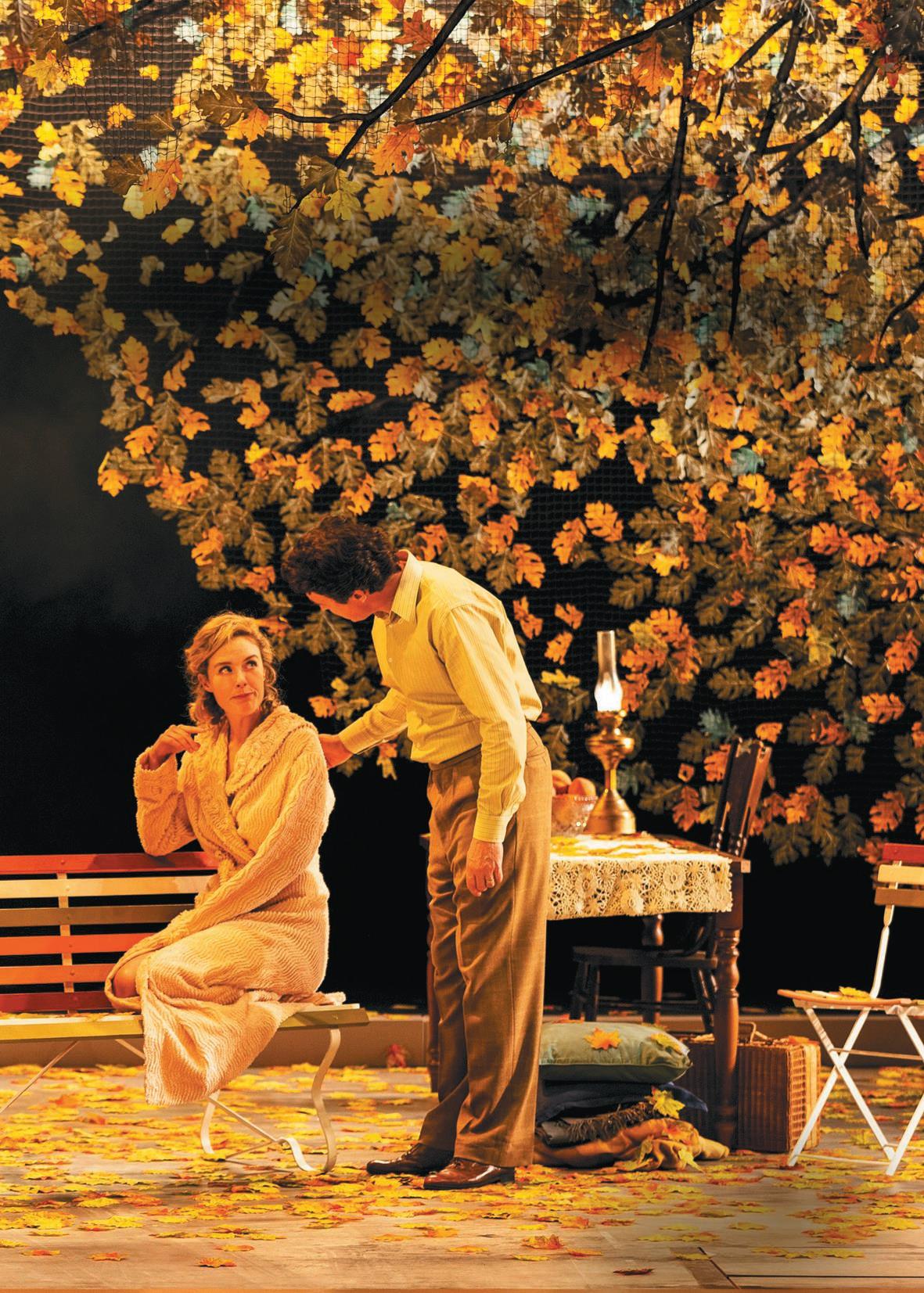
The Australian Production Design Guild has honoured artists at its annual awards. David Spicer speaks to nominees in the Lighting, Set and Costume categories.
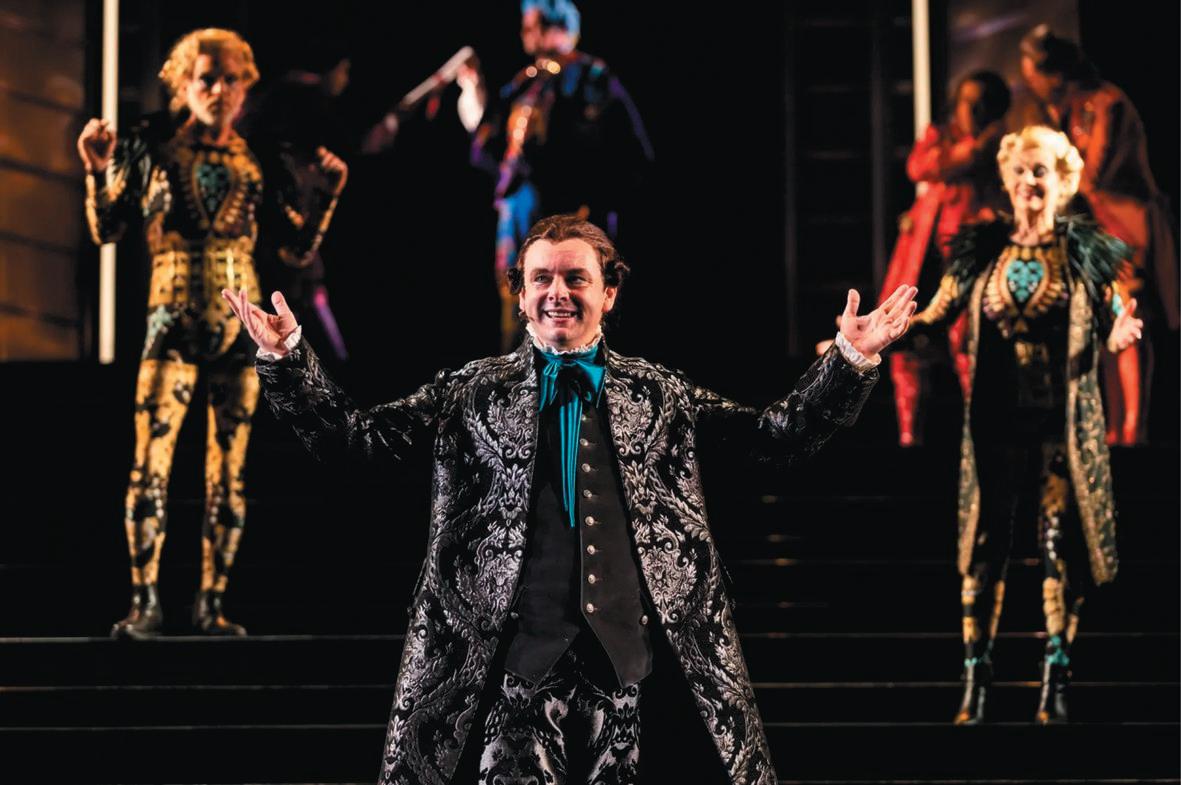
(Continued from page 60)
the actor, the emotion and pathos in the middle of the volume.
Can you explain why it was important to the story to have this look?
The Hapsburg Royal Courts informed the nature and character of the music, while the politics, hierarchies and behaviours of those courts determined who was in and who was out. It was important to the story to convey something of the excess of these times. Remember that this same Emperor was the brother of Marie Antoinette; rarely has there been a time in history when decoration has been so present, so persistent, so pressing. So communicating the essence of the time was vital, as was finding our own Australian way through those histories. What material did you make the costumes out of?
Oh, anything and everything. We had many digital prints onto lustred polyesters, sequined and embroidered patches appliqued onto bodices of chiffons and organza, suits made in satins and velvets and brocades. It would be easier to list what we didn’t have on that stage!
How challenging was it as a project to build?
It was a serious undertaking, so ambitious in its scale and without the framework of an existing company / workroom / workforce behind it. Teams all over Australia came to our aid, though. Makers from the north to the south; all the major companies took on a bit to help us make our deadline. It was an extraordinary effort, and
the costume co-ordinators and wardrobe heads were absolute godsends.
How did your costumes link in with the set and lighting?
I had a champion set designer and lighting design team with whom to collaborate Michael Scott-Mitchell and Nick Schlieper and they concocted a sleek, stark series of cascading portals which placed the performers (and their costumes) in relief. Their world was sharp, monochrome and abstract. The costumes, in contrast, could be glittering, sharp and alive, bright and periodaware.
Did you have a favourite costume?
My favourite costume was possibly that of Wolfgang Amadeus Mozart himself, towards the end of his life when he’s worked to the bone, totally depleted and practically poverty stricken. All fragile and sweaty. Fabrics clung. Lines were simple. The blue of the breeches complemented (actor) Rahel Romahn and we could really see him, reach him. Even the oddness of those lines over his mic-pack somehow worked for me; it looked infantile and pathos-inducing. Exactly (I hope) as Craig had hoped all along.
How satisfied were you with the end results?
You can’t help but fall in love with the work that you’re making, and simultaneously see only its flaws and issues! I adored this piece, could watch it endlessly and was extremely proud of the team and all that we achieved.

Explore Isabel Hudson’s set design in this clip of STC’s Hubris & Humiliation. youtu.be/N9UTU5mLHJ8

Isabel Hudson was nominated for her set design of the Sydney Theatre Company’s Hubris & Humiliation, which was a queer re-imagining of Jane Austen’s Pride and Prejudice
What was the overall look of the set that the director asked for?
The director (Dean Bryant) and I wanted a visual language that was fast paced that would also offer surprises to complement the humour and pace in the play. The play moves through a series of locations, from a Brisbane wedding venue to a harbourside mansion, a city Dymocks and the notorious “Baz Bash”.
We wanted the space to be delicious and submucous, and a space with lightness and surprise. We landed on the concept of a candied magic box ballroom that could flip out and reveal new pieces and surprises to transform the space, filled with gold gilt and hyper-pastel colour to help define locations.
Why it was important to the story to have this look?
It was important to infuse period with contemporary for this play, to support and heighten this hybrid story. We wanted the design to do more than provide a backdrop to the play but to heighten the stylisation of the piece. We wanted a space that could move with ease and that fluctuated like a dance to marry with the fastpaced storytelling and create this whirlwind of story. What material did you make the set out of?
The set has a CNC parquetry floor that was hand painted by the Sydney Theatre Company Scenic
Department, with freestanding timber walls with a powder blue finish with gold gilded mouldings. We have a series of trucks, furniture and props that are revealed through hatches and doors of the set. There is also a Sydney Harbour miniature with a sea and cloud backdrop made from calico.
How did your design link in with the costumes and lighting?
On this project I [also] designed the costumes. The basis of the stylised world was a contemporary mash up of Regency dress with drag elements. This queer party was the climax moment of the design, where the costume and set sat in the same heightened stylised world. At the end of this scene a giant inflatable wavy man popped out of the floor as another character in the end of act tableau, punctuating the exaggerated image.
At times the lighting design [by Alexander Berlage] was his romantic painting of tungsten light that shimmered with gold gilding. We used wall sconces to sit in the period world but also articulated elements of the set with LED lighting details to help heighten the contemporary scenes.
How satisfied were you with the end set?
The set was realised beautifully by the team at Sydney Theatre Company and worked beautifully during the show. The little surprises were very satisfying, and it was magical to see this space transform with some simple set pieces.
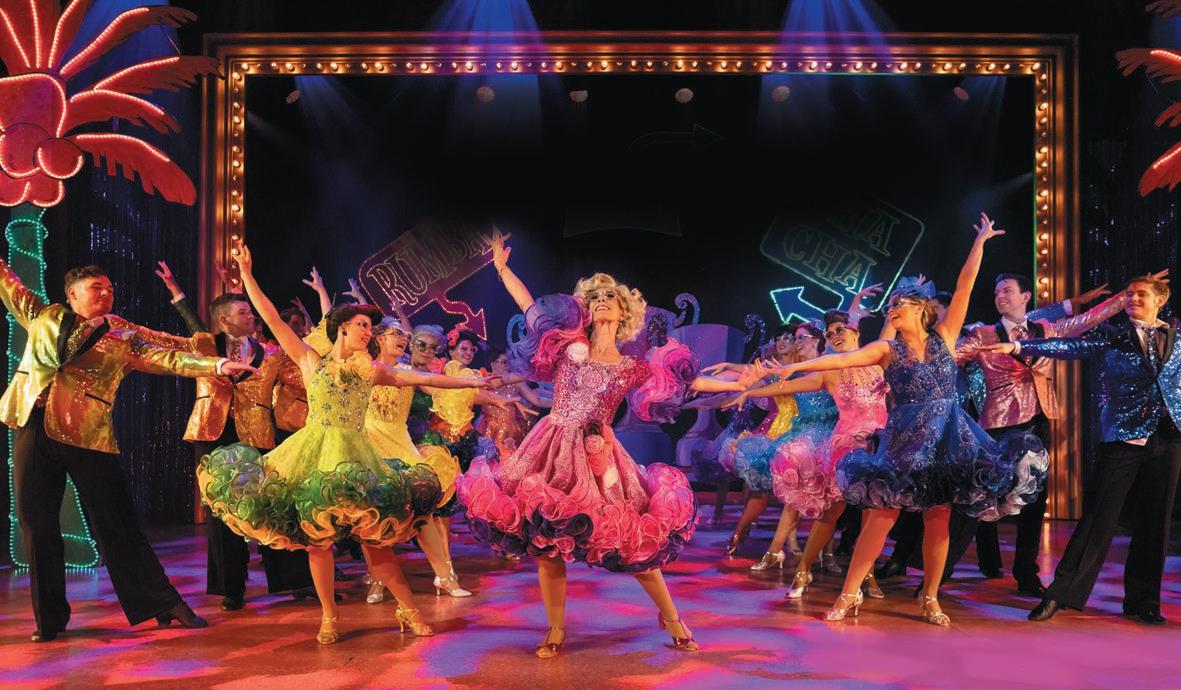
Walking through the aisles of CLOC Musical Theatre’s Costume Centre ‘The Nancy’ is a stroll through centuries of style, fashion, colours, history and memories. This mammoth collection has well over 12,000 items from more than 110 productions over 55 years.
Right now, however, it’s like walking through a ghostly parade of the most bejewelled, bedazzled, and brilliant costumes sewn for Priscilla Queen of the Desert waiting to take life when the COVID-19 crisis is over.
The amazing CLOC Sewing Team began sewing Priscilla last October and had 90% of the production
completed when scissors and sequins were put away after their last sewing bee on Saturday March 14. Everything that could be completed at home has been done and CLOC, like the entire theatre industry, is awaiting ‘the vaccine’ and the easing of social distancing.
But when that happens, CLOC will
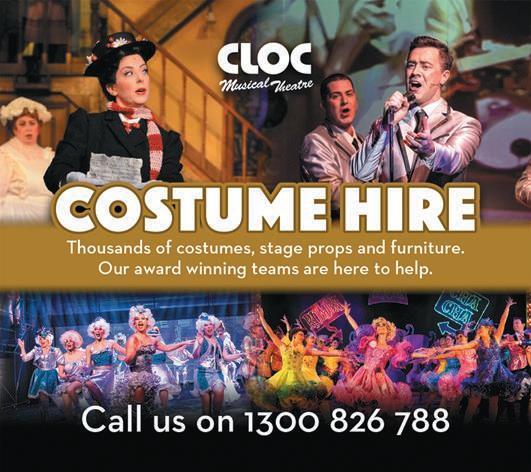
be ready! Ready to assist theatre companies and schools hire at very reasonable rates from individual costumes to entire costume sets for shows like Kinky Boots, Strictly Ballroom, Les Misérables, A Chorus Line, Mary Poppins, 42nd Street and The Phantom of the Opera.
CLOC’s Costume Centre ‘The Nancy’ is located next to CLOCworks, on the corner of Old Dandenong & Kingston Roads in Heatherton, Victoria. Visits by appointment only.
Looking for an incredible selection of costumes available to hire? Check out CLOC’s collection. cloc.org.au/cloc-hire.html
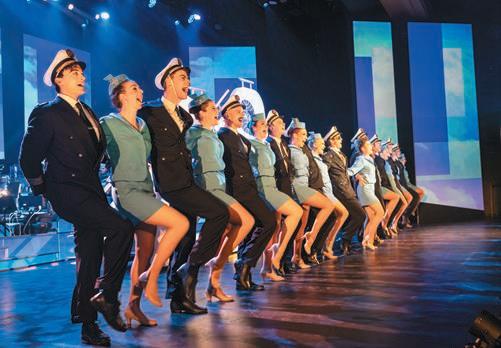
Pavla Chaloupka reports that Scenic Studios has over 200 hand-painted backdrops available for hire.
Scenic Studios specialises in scenic painting of custom backdrops and theatre scenery. They recently painted some canvas forest ‘legs’ for Queensland Ballet’s Coppélia production.
They also manufacture scenic paints and hire scenic backdrops around Australia for schools, small theatre organisations and live events.
Scenic backdrops give depth to the scene and allow for lighting tricks, creating the atmosphere you desire for your performance.
They have standardised the size, 12m wide x 6m drop, to fit most theatres and school auditoriums. Productions available and listed on their website under backdrop hire include Charlie and
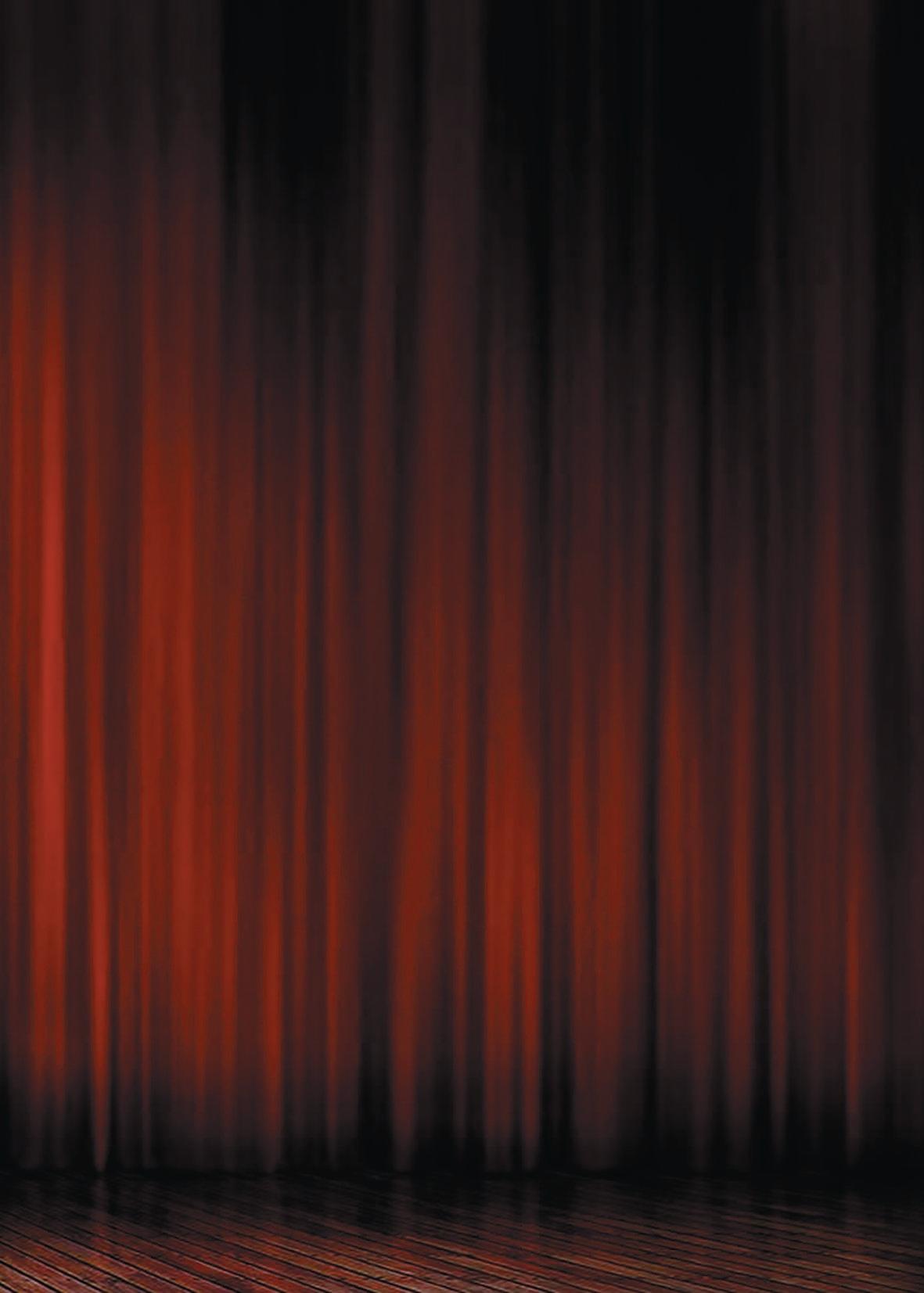
the Chocolate Factory, Mary Poppins, Wicked, The Wizard of Oz, Beauty and the Beast, Annie, Frozen and Alice in Wonderland.
Themes available include ballrooms, forests, skies and cut cloths. They also have sequin drapes, slash curtains, lame curtains and crush velvet drapes.
By hiring their scenic backdrops you are supporting the art of scenic painting and helping the environment. Why make it from scratch when you can hire it, and nothing will end up in the landfill?
They paint with their own manufactured Scenic Paints which are acrylics and designed to paint theatre backdrops, scenery and stage.
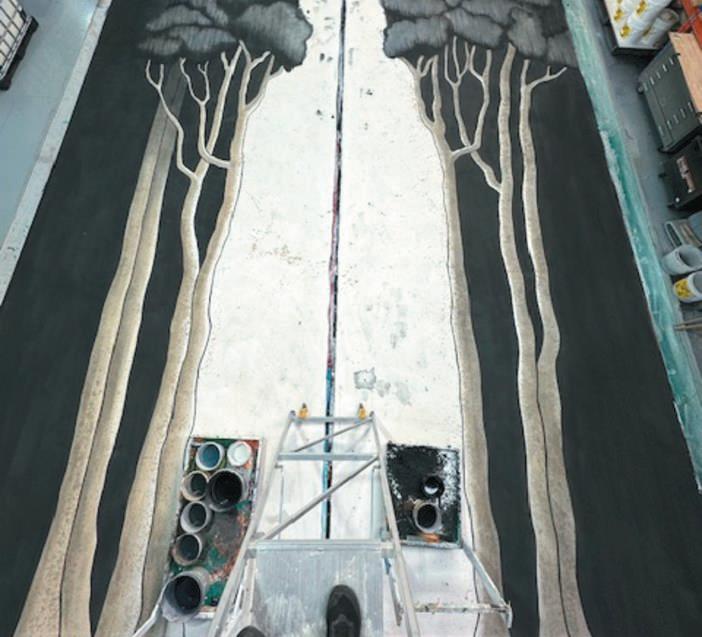
Purchase paints and hire backdrops from Scenic Studios at scenicstudios.com.au
The paints come in 0.8L, 2.2L,4L and 10L or 15L. They also have special effects products like membrane, texture and glazes. They ship scenic paints and scenic backdrops Australia wide. Their paints and backdrops are made in Melbourne, Victoria and are environmentally friendly.
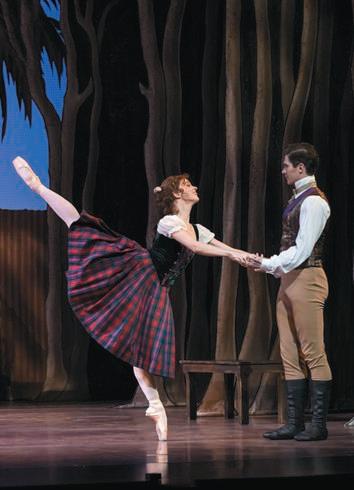
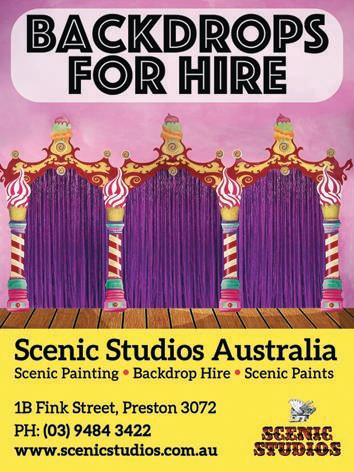
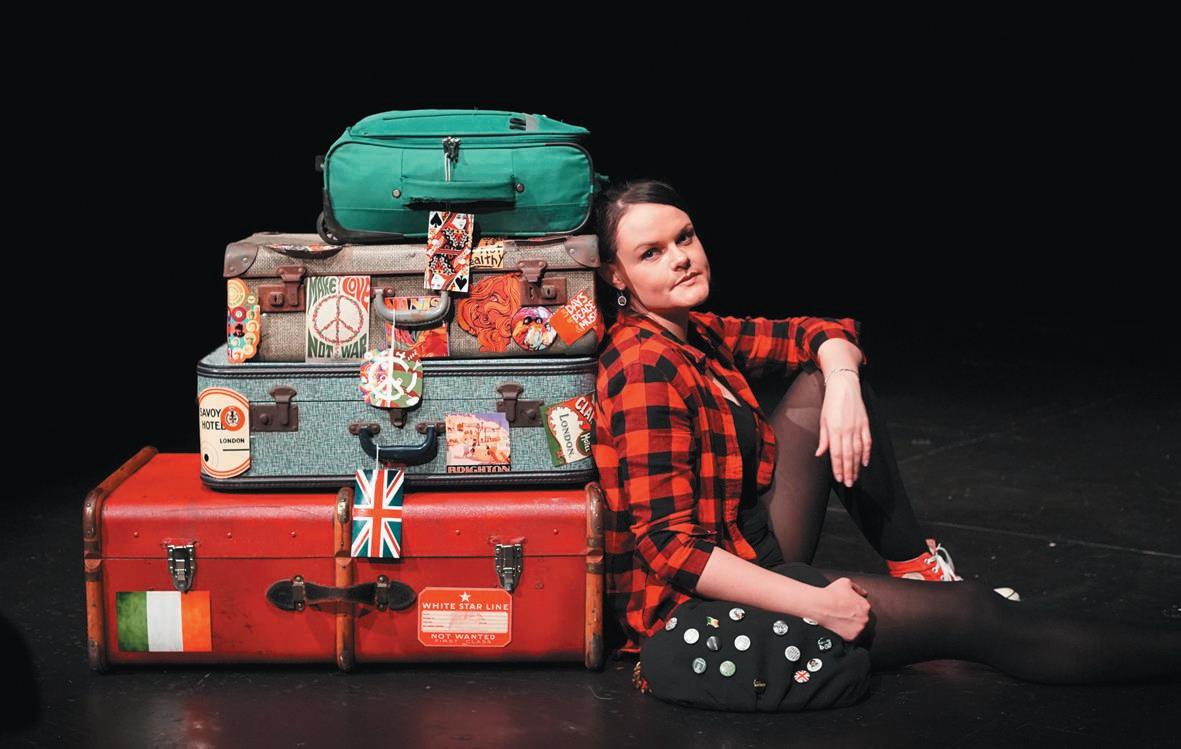
Suitcases conjure up so much symbolism - travel, escape, journey. Brisbane-based independent company Minola Theatre is a collaboration between Kat Dekker and Bianca Butler Reynolds, branded after their famous namesakes, Shakespeare’s Minola sisters in Taming of the Shrew. Bianca tells Beth Keehn all about Chester, their beloved red suitcase and star of all their major productions to date.
“Chester is kind of a third party in Minola Theatre. In 2019 we were preparing for two productions, Highway of Lost Hearts by Mary Anne Butler, and my own onewoman show, Begotten. Both plays required a central suitcase prop. We set about casting a standout piece of luggage that would be versatile enough to suit both parts.
“We found Chester at the Camp Hill Antiques Centre. He was a bit bland and brown and in need of surgery, but we fixed him up, painted him red and, with transformed confidence, he was ready for a life on the stage! He’s already starred in four Minola Theatre productions. And when he’s not on stage, he’s usually multi-tasking as our props storage, or acting as a bookcase at Kat’s flat.
“We love Chester because he is larger than life, certainly bigger than today’s average-sized suitcases, and he’s quite sturdy as a supporting player. He has solid wood and steel reinforcements which make him more stable than most suitcases. He can carry weight - we can
sit on him; we can stand on him - he’s always reliable.
“Because he was an old suitcase, we have had to perform surgery on him a few times. His latches sometimes give out and his lid gets a bit squeaky, so he’s definitely had some remodelling in the last two years.
“As well as Highway of Lost Hearts and Begotten, Chester starred in our evening of three one-act plays, Love Triangle, including Half an Hour by JM Barrie. Chester was outstanding as an item of luggage belonging to one of the characters.
“When we were planning Begotten as a live show (after performing it as a radio play during lockdown), we used a big pile of clothes as a set piece, which we were going to store in a laundry hamper, but when we started blocking we realised that the laundry hamper just wasn’t as versatile.
“Chester has so much more to offer our group and I’m sure he will return for other roles in the future.”
Veteran theatre creatives Bob and Col Peet featured in a recent episode of Stage Whispers TV on mastering prop and set building.
The brothers, now based in Adelaide and Sydney, warned that it is very dangerous driving behind them on council clean-up days.
One of their favourite habits is picking up some roadside trash to save it for a time when they can make it into a stage prop.
“We have made pot stands into a buffet, and very ordinary chairs into glamorous pieces,” said Col.
Bob described how he found beautiful chairs in a clean -up.
“I stopped and picked one up. I then got an email from someone who wanted four chairs. The next morning I went back. There were the other three chairs under the rubbish. I was able to rebirth them with black upholstery. Later we turned one into the wheelchair in Wicked. It all comes apart.”
Another time Bob found a gold couch on Facebook Marketplace at the home of a drag queen.
“So, it was appropriate that it became purple, which I

got from a bedspread. That ended up being a lovely piece for The Producers,” he said.
The brothers are big fans of giving community theatre casts a look at set model boxes early in the rehearsal process.
In the video they showed off their latest masterpieces.
“I do a model box at a ratio of 1: 25. When we build it, the cast say the set looks just like the model,” said Col.
The Stage Whispers TV Live Broadcast is sponsored by the Association of Community Theatre, which partners with Marsh Insurance to offer non-professional companies public liability insurance policies.
For more information visit communitytheatre.com.au

Watch Bob and Col Peet’s full interview with David Spicer. Scan or visit youtu.be/amsozdVVq1s
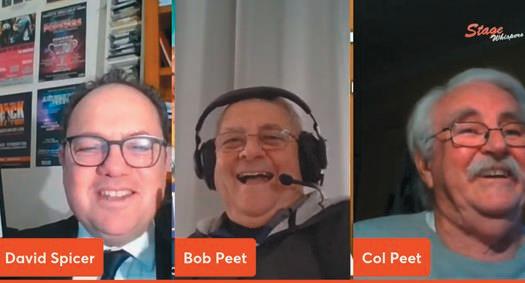
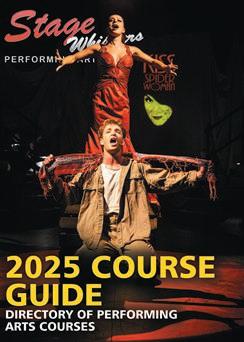
stagewhispers.com.au/training
Livia Greenberg went behind the scenes of NIDA’s production of Sweeney Todd and spoke to Gaia Stein a 3rd year NIDA Props Student about their work on the show.
I walked down a long corridor backstage at NIDA and everywhere I looked was either a prop or a student in costume, as they prepared for their winter production seasons.
An actor walked by in a pirate hat with sparkles, next to him a wall of masks. A stampede of “techies” poured out of one door after being let out on a break.
One of their ambitious productions in the season was Sweeney Todd: The Demon Barber of Fleet Street, directed by Constantine Costi with musical direction from Andrew Worboys and choreography by Shannon Burns.
For a prop maker, the “part melodrama, part Grand Guignol blood-fest” is an exciting project.
NIDA Props Student and Prop Master Gaia Stein is familiar with gory shows, having also worked on
the play Eat Me, that had a fake heart ripped out of someone.
Two of the props she is particularly proud of are the iconic Sweeney Todd meat grinder and a fake hand, both made with silicone and gel. She used a mold and finished it with sculpting and paint.
LG: What was the process of doing props for the show?
GS: “Well, it's a big and complicated show. I think there's over 250 props. And obviously a lot of it is reliant on mechanisms and things that make things happen, like all the blood stuff and the (barber’s) chair. A lot of it was trial and error, and trying to look at past shows and figure out how they did stuff. (A major challenge) was trying to not stain the costumes (with fake blood).”
LG: What was the process of making the hand/meat grinder?
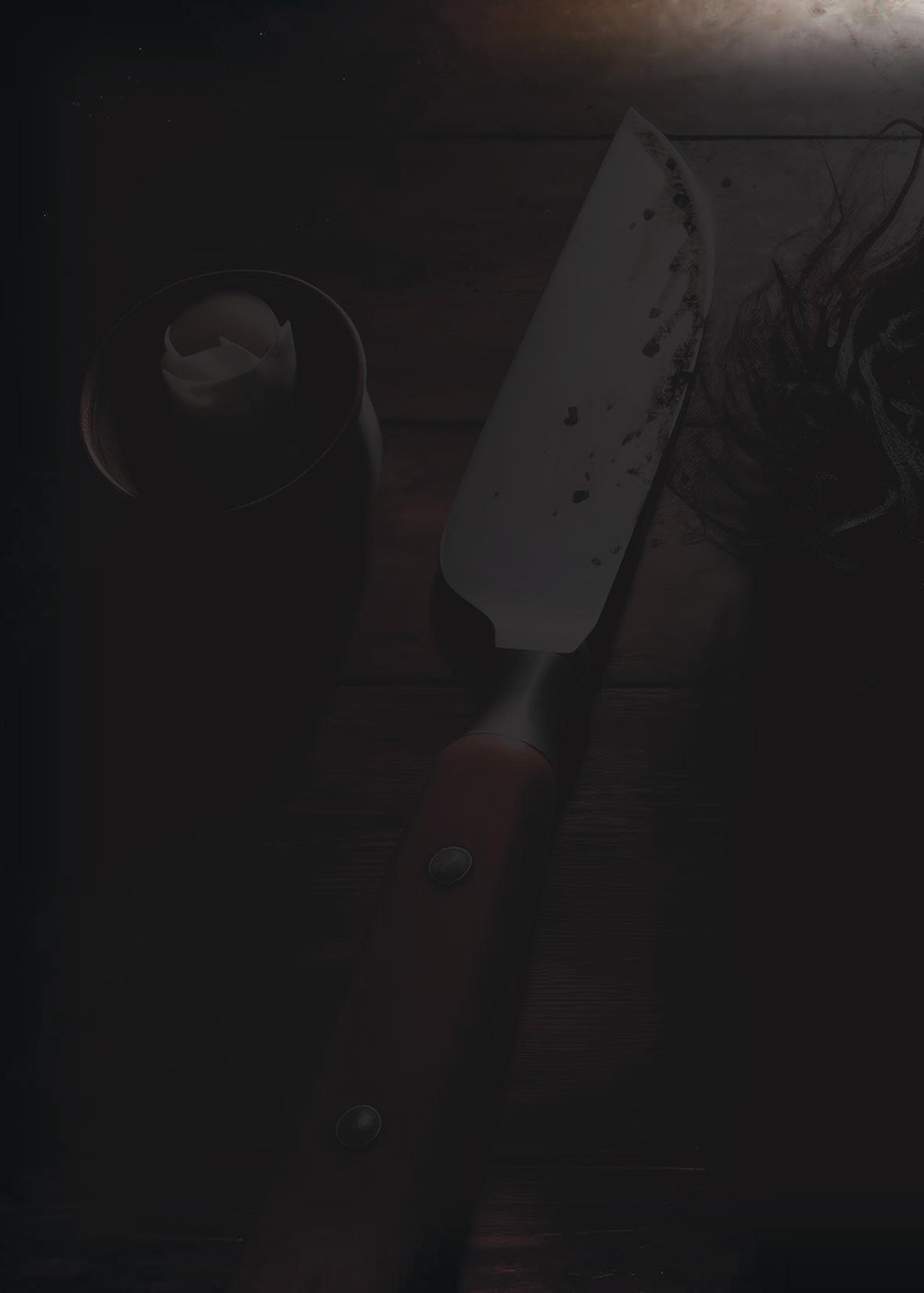
GS: “The hand was made from a silicone called transil [translucent silicone rubber], to provide the translucency of skin and add flexibility for heightened realism. It was made from a live cast of an actor's hand using skin-safe silicone. Since the transil sets so quickly, if you mix it, it becomes lumpy and meat-like, so I was able to use the cure-time to my advantage to make the hand look severed.
“The meat that goes into the grinder is made from a jelly-wax, which means it's reusable and can be melted down and reformed for every performance. Because it's so soft, it also makes it easy to grind, which is perfect.”
LG: Did anything go wrong along the way? If so, what did you learn from it?
GS: “The hardest part of the production was the [fake] blood and trying not to stain the costumes.
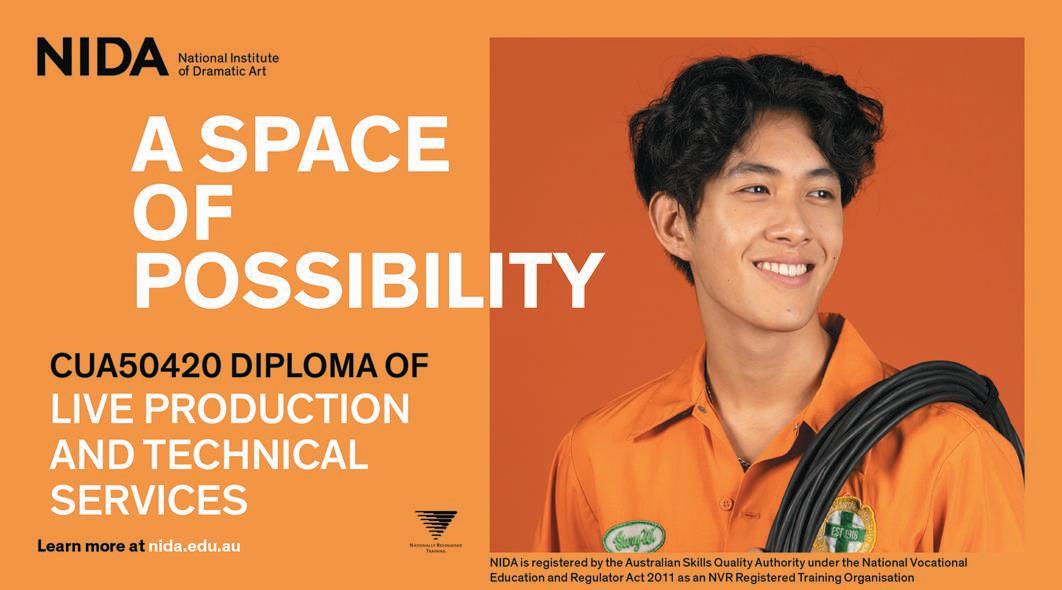
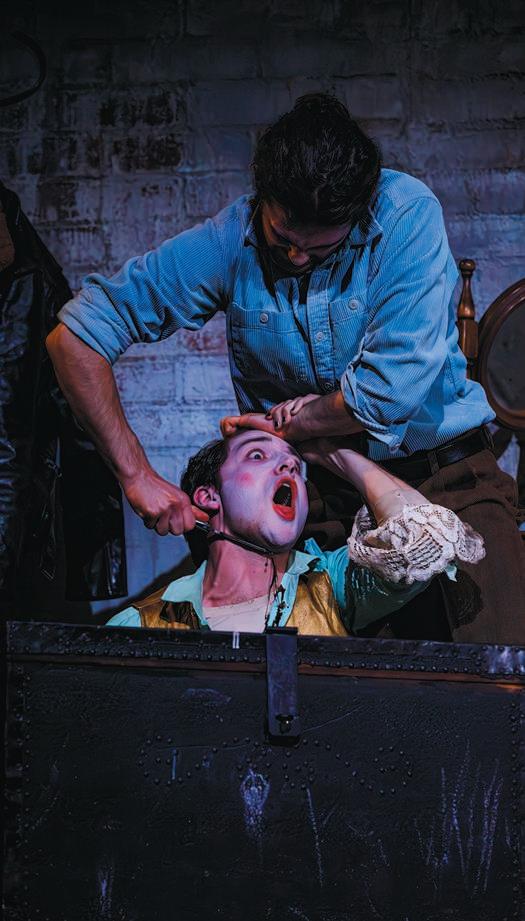
In NIDA’s BFA Props and Effects, you will learn to become an adaptive and multi-skilled designer-maker, ready to join the arts and entertainment industries in areas including theatre, film, exhibitions and events. Learn more about the course at nida.edu.au/study/undergraduate/props-and-effects
“I found that as the show went on, I became quicker at problemsolving and figuring out solutions to issues that I hadn't foreseen.”
LG: Did the dark content of the script affect your prop making in any way?
GS: “The designer decided to go for a more realistic look with everything, so things like meat as well as the blood and stuff were included. It was actually fun just seeing people’s reactions to things that I was making. I just enjoyed
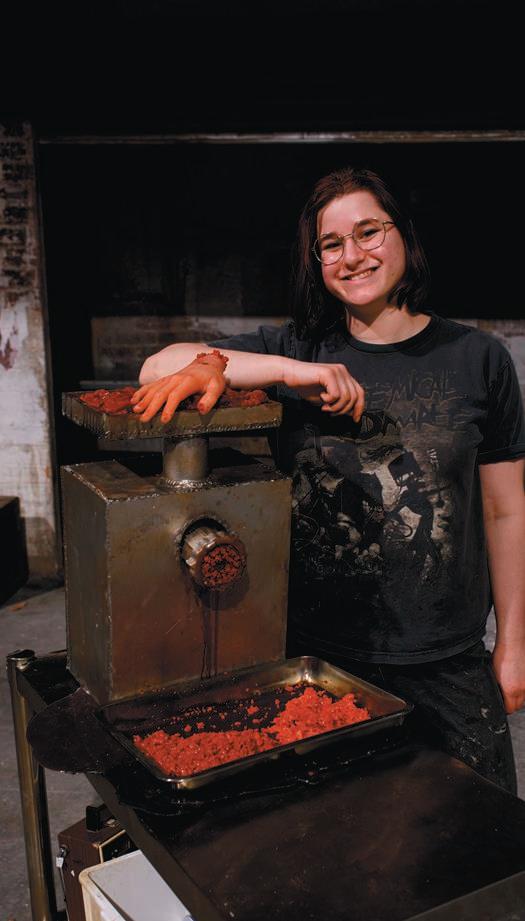
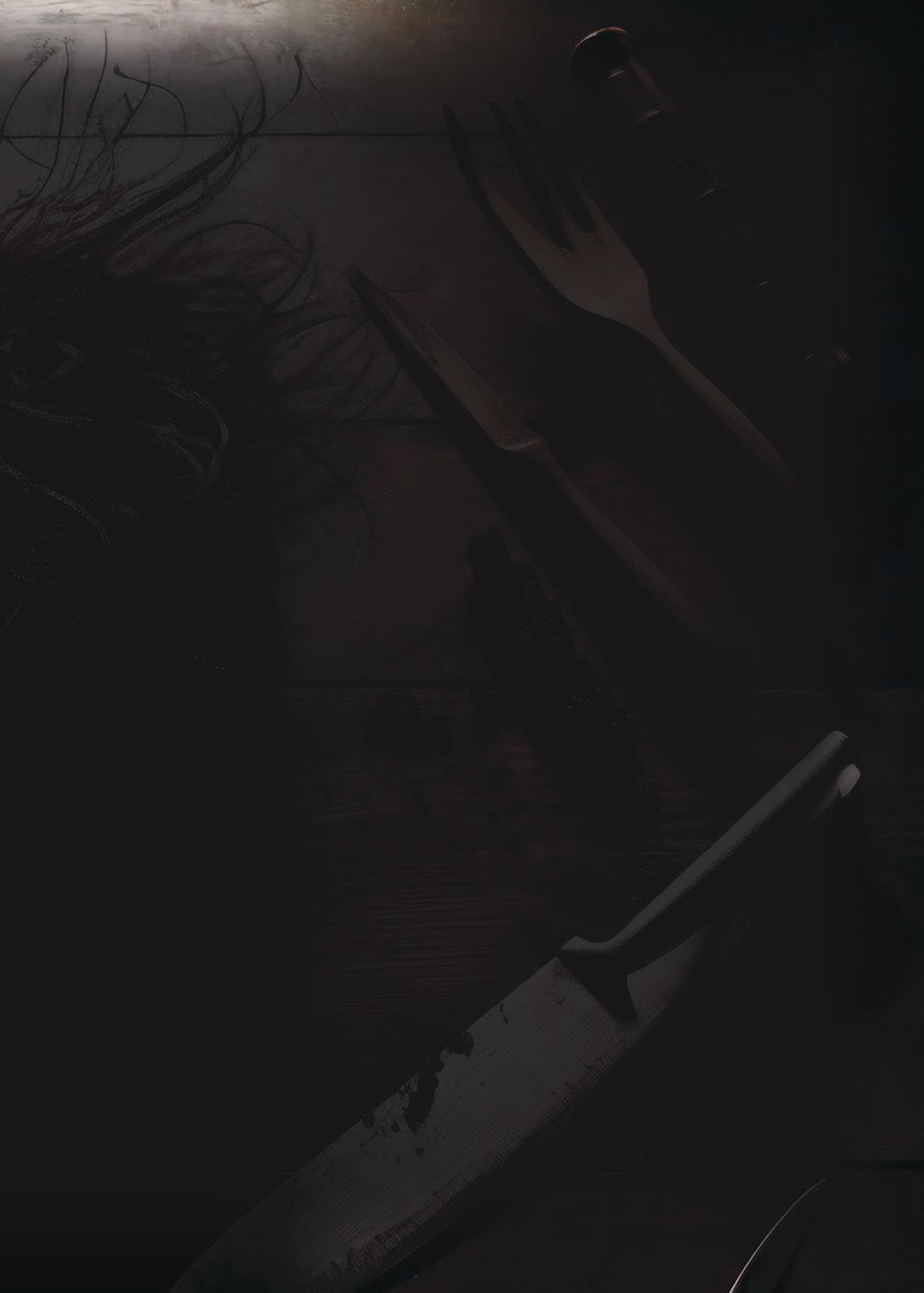
people coming into the room and going “Eww!” and getting disgusted.”
LG: In terms of the chair, what went into making that work?
GS: “The chair was made solely by one of my very talented classmates, but the entire frame was welded so that it could support the weight and movement of the actors going down the chute.”
LG: Is there anything you’re proud of that the audience may not notice?
GS: “I've put a lot of detail into the props. In Joanna's bedroom was a table, and in this version of the show, she's very obsessed with birds. And so I carved a little bird into her side table. And I did a whole bunch of little inscriptions that she's done in her bedroom.”
LG: What are the career prospects in terms of props making?
GS: “Since prop-making is so broad, and our skillset is so vast, our career prospects are endless. Whether it's advertising, film, TV shows, theatre, or even store-front displays, we have so many possibilities.”
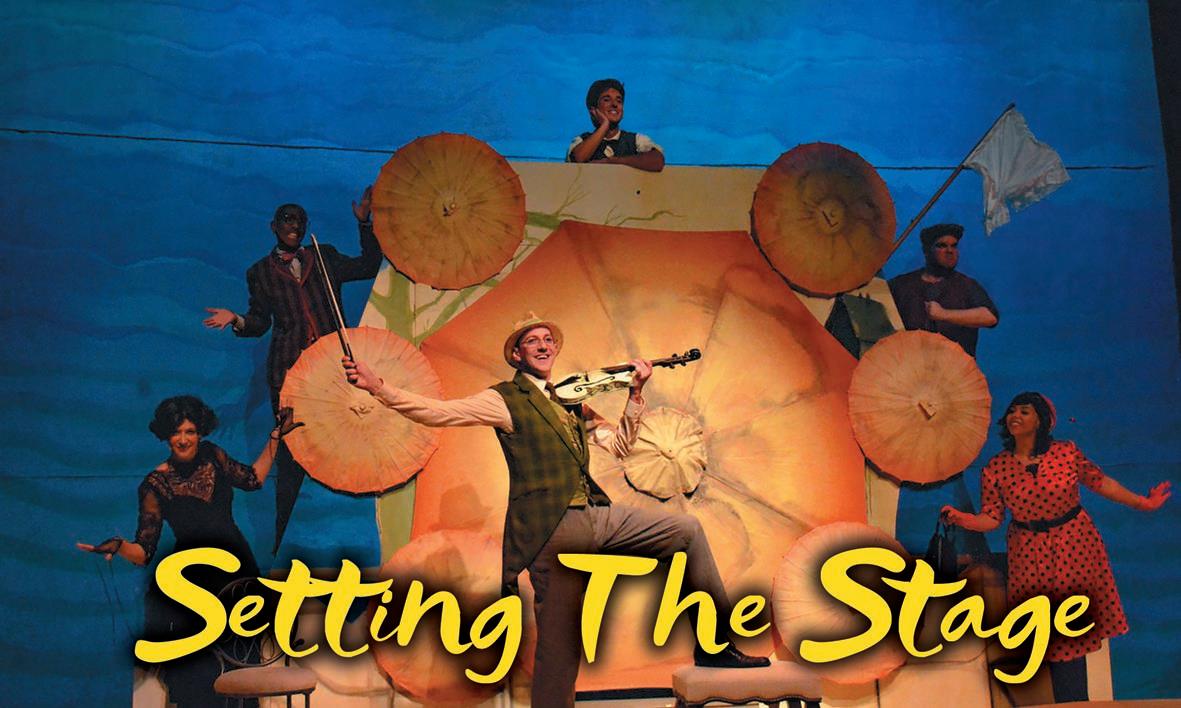
Award winning Director Nina Meehan explores the process of setting the stage for a production involving young people.
When I speak to audiences of nontheatre folks, I often find myself making the distinction that theatre is a collaborative art form. The painter or poet can work solo, but the theatre maker requires a team of creative people all working towards one single storytelling mission. The director of the production holds the responsibility of keeping all of the brilliant creative minds working on the show pointing in the same direction.
So, how does a director work to ensure that the audience member is seeing one unified artistic voice, not a whole bunch of disparate viewpoints? The director must establish the “True North” of the play or musical. This is not the staging or the casting or the couch upstage right, but is the overarching, driving concept that will keep all of the collaborators working towards the same vision.
“True North” can be thought of as the central storytelling idea that the director is bringing to the script. The script and music are supplying the storyline and characters, but how you
tell that particular story is the director’s decision. The director of a production has a curatorial obligation to interpret the story that the playwright has written with a lens that brings out something new and interesting for the audience.
In a pre-production process, it is this vision that unites the team and begins the task of using the creative superpowers of each individual theatre artist in their area of expertise to make sure that the final production all lives in one world. The director’s role is to be an adept and agile communicator, using many different forms of communication to bring along the entire team. Visuals, written word, spoken word, audio whatever tools the director can find will be helpful because all of the different designers are likely different types of learners. A set designer likely is a visual storyteller and visual processor of information, where a dramaturg is more likely to connect deeply to words. The director has to be fluent in multiple languages of artistic communication.
One easy version of getting everyone to understand the “True North” of a show is a Pinterest board with images and links to audio. For instance, when I directed the premiere of the TYA version of the musical James and the Giant Peach with book by Timothy Allen McDonald and music and lyrics by Benj Pasek and Justin Paul, I used images that captured the overall feeling of the production that I wanted to present colour, texture, era, tone but also, specific costume silhouettes that spoke to me.
I also put in ideas that didn’t yet have a full resolution, but that I was playing with in my head. I found an image of an umbrella that inspired me to present the seagulls. As we worked together as a team, it became clear that seagulls out of umbrellas were not going to work, but we ended up using umbrellas parasol size, midsize and patio size as the peach itself.
The joy of the “True North” collaboration is it allows for divergent thinking, which is one of the primary strengths of the creative mind. All ideas can flow and be out there to grow. The director is not saying, “This is how it must be.” Instead, the

See the results of the staging choices for James And The Giant Peach youtu.be/J3iMNnLpQIk
director is using the concepts presented as an invitation to allow each artist to bring their own brilliant creative ideas into the production.
All of this is lovely and great, but for most of us in the theatre world, we are working with resource constraints. Maybe you are working in a black box theatre and there is no room for big set pieces or you have a limited budget and have to costume the show based only on what can be found in the storage room. These constraints are completely normal in our world. The good news is that it’s these constraints that can actually make the job of the director, and therefore the collaborators, easier!
The “True North” concept can be daunting without any limits. It would have been great in my production of James and the Giant Peach to have a full skyscraper to grow from a trap in the stage and meet a giant flying peach, but the space I was working in at that time had no trap and no fly system. These constraints led me to my “Anchor Point” for the production, or the element of the design or production element that is fixed and therefore the thing you build everything else off of.
Another example. In a recent production of the Jungle Book I was working on, the show was being performed in a theatre where set pieces were not an option. I decided to use pre-created projections from
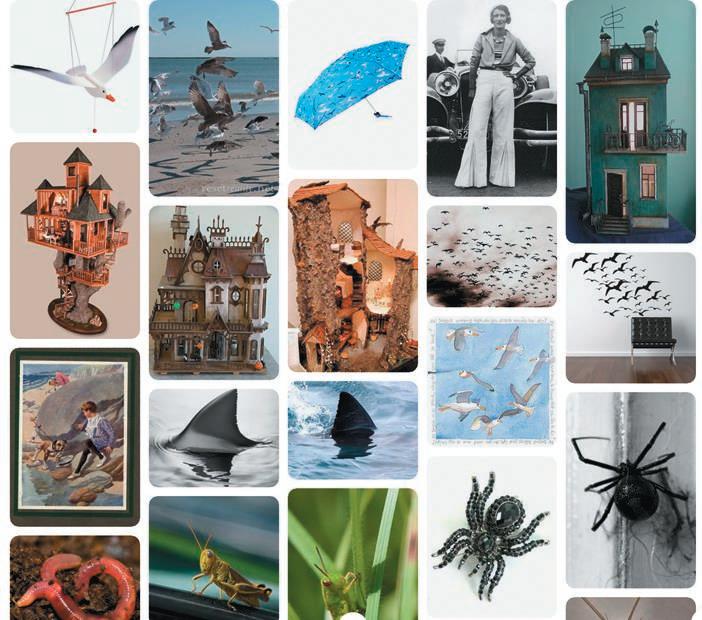
Nina Meehan is the Founder and former CEO of Bay Area Children’s Theatre, the largest TYA company in California. She was an invited guest speaker at the Australia Junior Theatre Festival in 2022.
Broadway Media to bring settings to life with visual storytelling. As a result, the “Anchor Point” became those projections. The colour palette and tone were all set, but there was still a “True North” that I created that focussed on the vibrancy of the world and the jazzy style of the music. But, the hard work was done because I had settled on an “Anchor Point” early on in the process. My job as a director was actually simpler, but still artistically relevant and fulfilling.
The key to all of this is to communicate early and often. And

then communicate more. The director’s voice brings the team together and while for some people it can feel intimidating to be the leadership voice in the room, particularly in a collaborative process, the more clear and defined the director is early on, the more creative room the design team will have later in the process. The director is not in charge of managing and deciding every detail, but instead, setting the table with all the tools that the designers need to cook an exquisite storytelling meal.
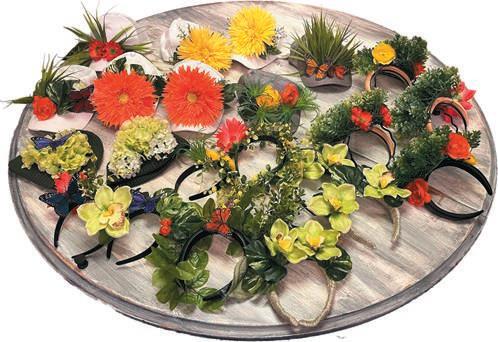

AB Publicity
AB Publicity is a dynamic public relations agency specialising in the arts/entertainment industry. We pride ourselves on having a hands-on approach. We go that extra mile, we love a challenge, we provide comprehensive reporting, and, above all, we provide results –‘spreading the word’ to ensure our clients sell tickets.
PO BOX 1658, Lane Cove, NSW 1595 +61 4 1394 9140 amanda@abpublicity.com.au abpublicity.com.au
Drama Queen Graphics
Drama Queen Graphics specializes in theater branding and graphics. Need a design for a specific show?
Browse our Existing Collection of Plays/Musicals for your title - or order up a brand new Custom Design. Is it time for a brand makeover?


We’ll rebrand your theater’s visual identity to better communicate who you are and what sets you apart. We create digital graphics, websites, logos, brochures and more…all the marketing materials you will need to engage your audience.
Demand attention!
jimg@dramaqueengraphics.com dramaqueengraphics.com
IP Publicity
IP Publicity specialises in publicity and promotions for the performing arts and other entertainment events, a small and highly skilled team based in Sydney and led by Ian Phipps. From large scale productions and high profile artists where the media communication needs to be managed strategically, to smaller productions which require a niche, targeted approach, IP Publicity has strategies and the experience to ensure that entertainment events are well promoted to media and the general public across Australia. IP Publicity provides strategic media placement in all media outlets, promotional activity and a substantial media and celebrity database for opening night red carpet coverage.
+61 2 9368 1474 ian@ippublicity.com.au ippublicity.com.au
Jessica Bendell Publicity
Jessica Bendell is a leading Melbourne-based publicist, specialising in arts and entertainment publicity. With 20 years publicity experience, including nine years as the Media Manager at Arts Centre Melbourne, Jessica established her own publicity consultancy in 2018.
PO Box 9056 Brighton Victoria 3186 +61 4 1236 9015 info@jessicabendellpublicity.com.au jessicabendellpublicity.com.au

Promotix
Promotix is an Australia wide papering service for the theatre and entertainment industry.
Their team has an extensive history in theatre and event production, and a passion for encouraging people to explore and experience new and exciting Australian shows and performances. They can provide distribution of your complimentary tickets to our enthusiastic and reliable member database; word of mouth publicity; and honest and unbiased feedback from our members who attend your show. Their service is completely free for you to use and their office hours are 8am - 10pm 7 days a week. Contact Catherine Hutchison to discuss your ticketing needs.
Suite 13, Level 4, 150 Albert Road, South Melbourne, VIC 3205 +61 3 9376 4933 catherine@promotix.com.au promotix.com.au
Sirmai Arts Marketing
Sirmai Arts Marketing delivers elegant, economical, effective publicity. Plus a whole lot more... because publicity, after all, is only one piece of the marketing pie.Our approach is built on strategy, not whim. It embraces all platforms, all media, on a horses-for-courses basis. Managing director Geoff Sirmai is a communications guru with 30 years' media experience as print journalist, radio presenter, TV producer & reporter. He also comes from a professional performing arts background - with degrees in music and Australian drama. How many publicists can offer all that?
Sirmai Arts Marketing: publicity plus!
964 Anzac Parade, Maroubra, NSW 2035 +61 2 9345 0360 +61 4 1266 9272 geoff@sirmai.com.au sirmai.com.au

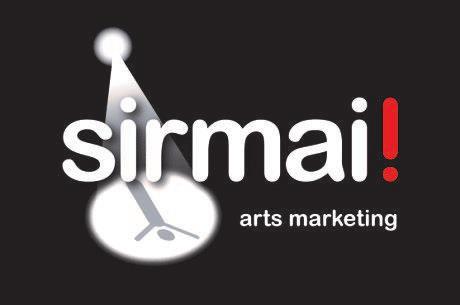
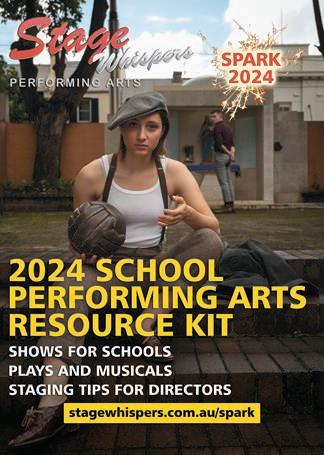
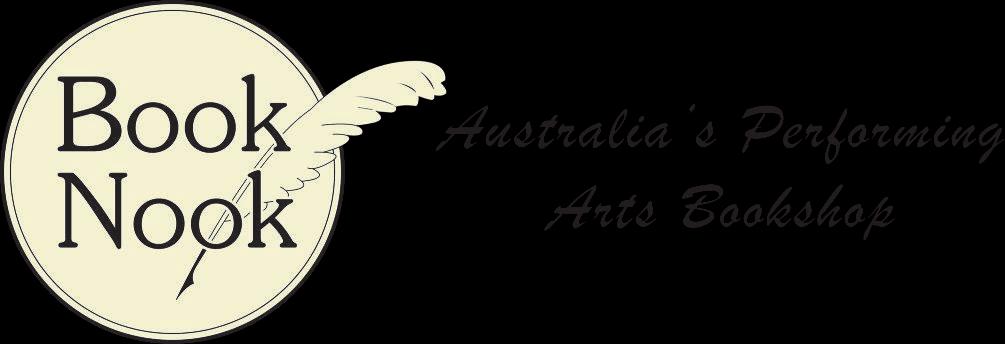
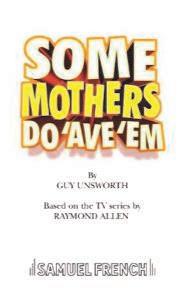
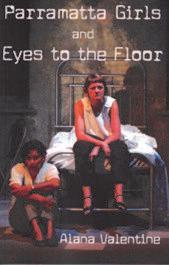
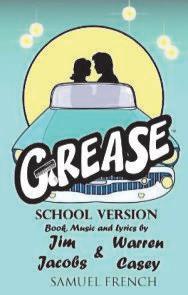
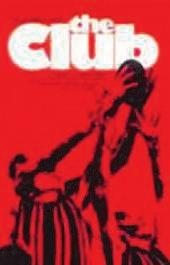
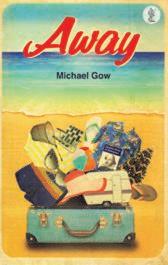
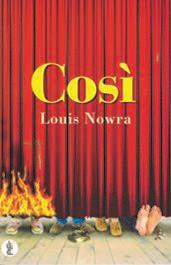
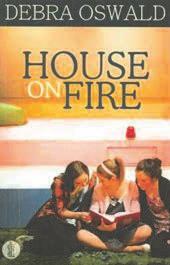
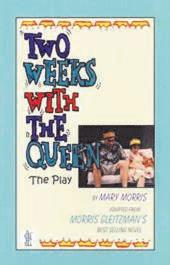
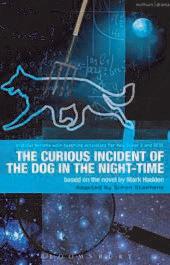
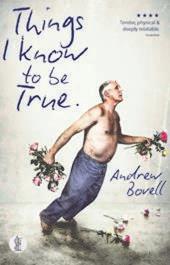
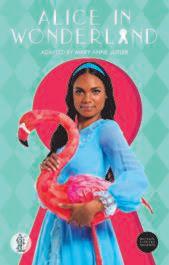
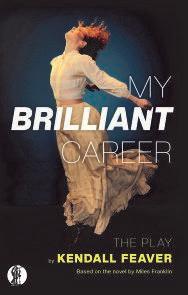
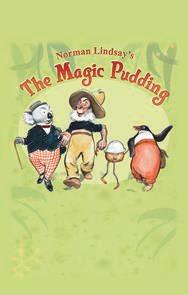
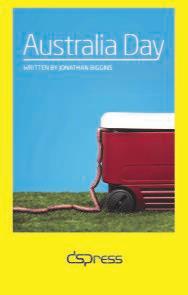
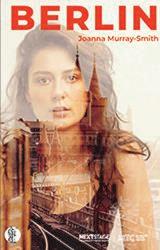
Marketing guru Rachel Klaver explains the best ways for theatres to

Marketing can often be one of the most challenging jobs to get right for theatre groups. The biggest issues are a mix of the sense that “We all know how to post something on Social Media”, the rotation of people as committees and time commitments change, and how often there’s the biggest focus on promotion, without getting people all warmed up to buy tickets first.
As a marketing coach, I often recommend that theatre companies take time to create a strategy that can work through the changing hands of the team, and help create consistency.
Keep your colours and branding consistent. I love colour and fonts, so I’m all good with a little chaos! But you need to have clear rules about what fonts, and what colours you’ll use. I recommend having a theatre Canva account, and putting some of that all-important budget into having the pro version so you can use it to store your



brand colours and fonts in there to make everything more consistent.
If you’ve got a designer in your team, get them to make you some templates in Canva. These can help take your content to a new level and make it less stressful for whoever’s in charge of the marketing.
Embrace video! Video helps you reach past your current audience and you can grow your audience. Get your teams to sing trending audios, do some funny voice overs and dance to show what you’ve got!
If you’re not sure you have anything interesting to post, I want you to think about all living more like goats in trees! I’m not sure if you’ve seen the photos of the goats in trees in Morocco (it’s worth a Google), but I am captivated by them! They are doing something I think is so cool, and different!
Here’s the thing. They’re just being themselves. They’re going about their day, doing their tree climbing and leaf chewing thing, staring out into the shimmering light surrounding them, and they don’t think, “I’m doing this so people will love me!”
People love the little stories, the little events, the moments, and images that help feel they are part of our stories. So don’t worry if your post is just about another rehearsal, or a costume fitting, or perhaps a meeting about lighting. People will love it. Because you’re a goat, in your tree, and they are here for it!
In my book Be a Spider, Build a Web, I teach that we want to build a sticky web with our social media content that helps people come, stay and want to buy from us. To do that we need to drop back on content that’s heavily promotional all the time, and include posts that help people build a hunger to buy those tickets, or even sponsor us. That’s the kind spider way.
Make sure you take time to create some posts about frequently asked questions. These can be easily reused with a little tweaking for each show. They could include where to buy tickets, what time people should get to the theatre, how to sponsor your company, and perhaps how to become a part of future shows. 1 2 3 4
A really clear outline of the three or four core values of the theatre, and how these are lived and breathed in everything you do. This helps anyone creating the content to make sure it’s in alignment with the content. For example, you could have “inclusive”, and then you need to check if your content is demonstrating this.
A clear and consistent posting plan. One of the biggest mistakes is ramping it up on promotional posts, but not having posts that help people more naturally interact with your content in between these posts. There’s also a feast or famine in posting schedules. I normally recommend using a social media scheduler, and choosing your frequency and then sticking to it. It can be three or more times a week, but posts should be published around the same time every week.
The plan also needs to have a range of content. Yes, to upcoming notices about your next show! But add in behind the scenes images, photos of the cast and crew, taking people on a journey. You can also give up history or facts about the show. If you’ve sold sponsorship postings as part of your offer, then have a set “Sponsor time” every week so you can plan and schedule these in advance. You can also choose a time to profile a cast or crew member, and introduce them to everyone. All of these posts bring in the human aspect and help people feel more connected to your whole journey. I recommend having set days for each type of post, to make sure you get the right split.

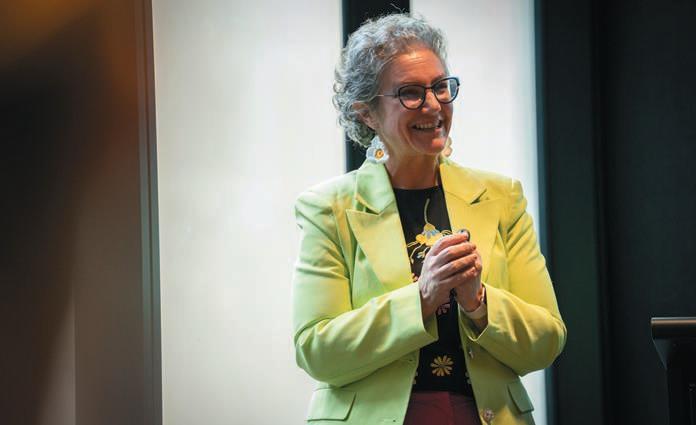
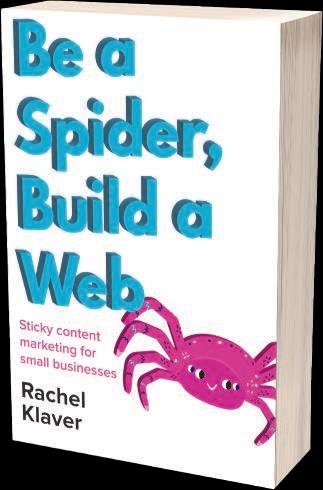
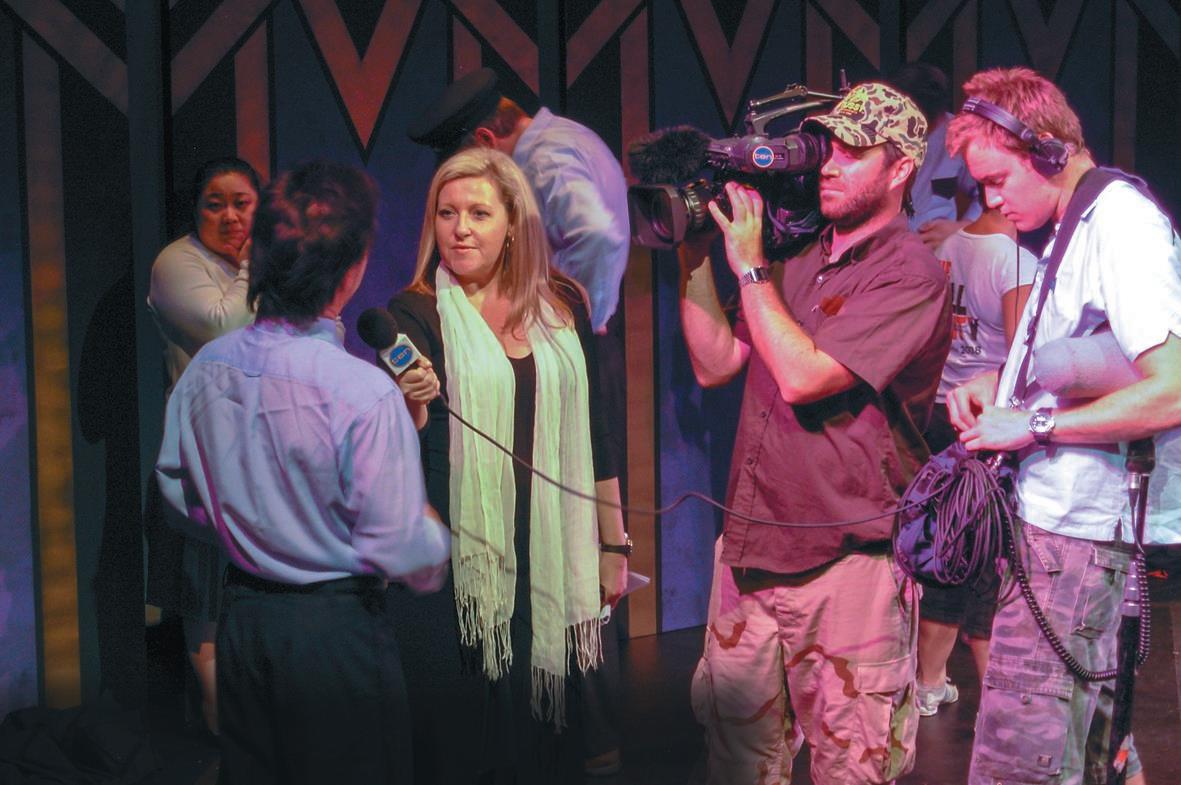
Sydney Publicist Geoff Sirmai provides his top ten tips for gaining media coverage.
You’ve done your flyers, bombarded your friends and family, spammed your network and flooded all the usual suspects, yet your sales are stalling. What are you doing to reach new audience?
In my view the number one priority on your list should be public relations (‘PR’) or media publicity
Just as marketing (paid advertising, banners, posters, flyers and direct mail) and social media networking are important in promoting a show, media publicity - which involves, essentially, free editorial - is indispensable in getting known in a crowded arts and media world.
A publicist arranges free editorial: press articles, radio and TV interviews,
what’s-on listings and feature articles. They invite and liaise with opening night guests including reviewers, VIPs, and celebrities you might want involved.
Advertising is still transparently yourself blowing your own trumpet and social media like Facebook, Instagram or Twitter will only reach those - at most - a few degrees of separation away. Remember, as the Bard might have said, “A Facebook ‘like’ doth not a ticket sale make!”
Media coverage through publicity reaches new audiences. Press and electronic media coverage carry the weight of editorial approval or ‘third party endorsement’, complementing your more transparent selfpromotion.
Your creative team also appreciate coverage which rewards them for
Geoff Sirmai is director of Geoff Sirmai Arts Publicity. Read more and download the free booklet ‘You And Your Publicist’ (which includes a comprehensive guide to timing, photos, reviews, writing a media release and much more) at sirmai.com.au
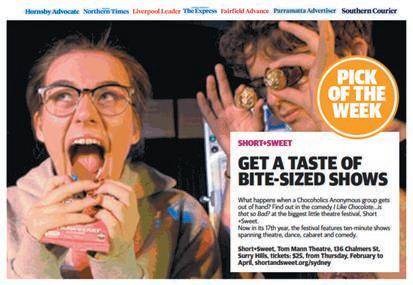
their efforts and gains them wider recognition.
Ideally you should engage a professional publicist: they have the skills, the comprehensive, up-to-date contacts and the dedicated time to cut through the competition.
Plus the regular, close relationships with media associates that will make all the difference. That will leave you the time and space to get on with your main business... that’s show business!
However, whichever way you decide to handle your media editorial publicity efforts - whether with a dedicated company/committee member or a professional - don’t forget about it! It’s a vital part of your promotional toolkit.
Start early: Give yourself and your publicist time to place the stories Vary your approach to suit the medium: One style doesn’t fit all. Match the ‘angle’ with the outlet - is it a local paper, radio, ethnic or arts specialist? Give your publicist ideas and angles, Make your release newsworthy: Try and ‘hang’ your release on a hot current issue or feature interest beyond the play’s obvious theme. Remember: what you think is interesting may not be so to every journalist or editor, who is second-guessing their reader’s agenda, not yours. It’s a competition for space.
Great photos: Quality promotional and production shots will double your coverage. Not cheesy posed shots, but dramatic, powerful or funny ‘moments’. High resolution (300dpi) for the press and low res web versions (72dpi) to preview.
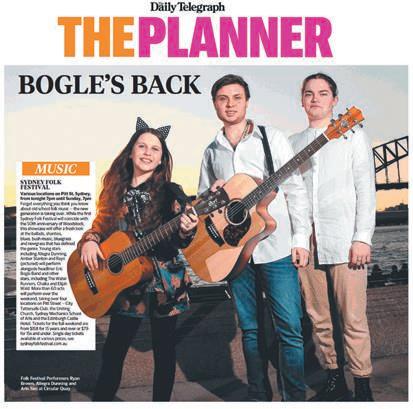
Don’t over-hype: Passion and ingenuity and originality, yes… absurd hyperbole, no. No-one likes a rip-off.
Invite opening night guests and the press: Make a buzz, make a splash. Give away tickets judiciously: Don’t look desperate but do give away a few ‘comps’ (say on radio or through competitions) in exchange for coverage. A full opening night will set you on your way.

Don’t be afraid to invite reviewers: But be ready on opening night if you do.
Cross-promote: Do complementary offers to another company’s audience in exchange for access to theirs. Negotiate mutual leaflet drops. Remember: a theatregoer at any other show (but especially at the same venue) is your best target audience.
Measure your success: Do you poll your audiences? It’s worth slipping a short survey in the program to see how they found out about the show. Offer an inducement to maximise returns - a prize, a discount voucher etc.
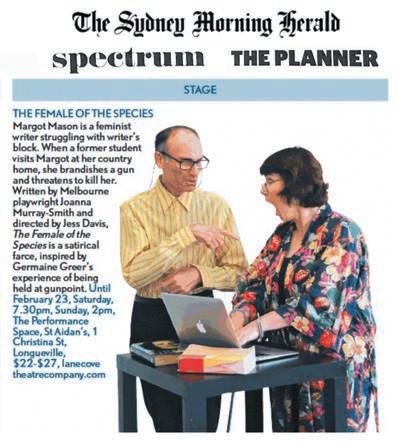
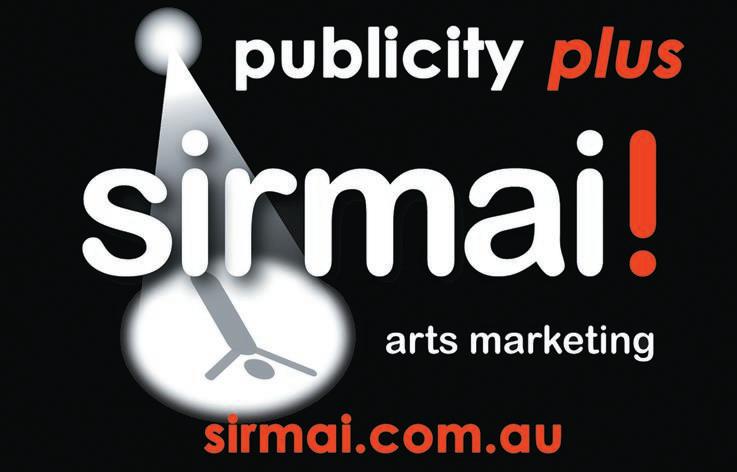
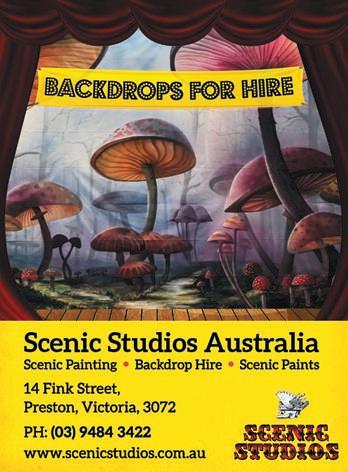
See more listings online at bit.ly/3iPWYL7
Book Nook
Book Nook is Australia’s oldest performing arts specialist bookshop, stocking play scripts, drama theory and teachers’ resources, speech and arts texts / biographies. They supply drama teachers and speech & drama teachers (from schools and private studios), as well as actors and students (especially seeking monologues for audition pieces), etc. They have specialist knowledge and are available for consulting. A client can describe the qualities of the text they need and be given a number of options to choose from that fill their need, or that are compatible with their requirements.
PO Box 2274, Rose Bay North, NSW 2030 +61 3 9758 4522 stagews@stagewhispers.com.au booknook.com.au
Easy Stagecraft
Easy Stagecraft offers practical in-school technical theatre workshops tailored around lighting, lighting design, sound and stage management, with all resources needed brought to your door!
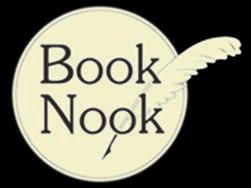

You don’t need a theatre to be able to enjoy the practical learnings of technical theatre. Everything is completely customisable for varied class sizes and teacher involvement. When fused with the custom-built e-learning platform for remote teaching, the program can now be offered to students in a self-guided capacity, from any device, anywhere. Training for teachers as professional development on technical tools, equipment and resources is also available.
PO Box 6115, Wantirna, VIC 3152 +61 4 2297 220 daniel@easystagecraft.com.au easystagecraft.com.au
Gosling Productions
Gosling Productions specialises in schools and amateur theatre production management, live streaming services and technical solutions. This is perfect for schools, dance companies, theatre companies or anyone who wants to live stream a production, and have everything looked after for you. With over 20 years’ experience in technical production, you are in safe hands. Gosling Productions also specialises in theatrical consultations for new builds, refurbishments or “spruce ups” of theatrical or dramatic venues in both schools and commercial environments. Architects, principals & builders - call today to avoid costly mistakes seen all too many times!
PO Box 6115, Wantirna, VIC 3152 +61 4 2297 220 daniel@goslingproductions.com goslingproductions.com
Hadley/Series Australia

Hadley/Series Australia is the leading manufacturer of high quality theatre seating. Amongst many Performing Arts installations and major theatres are Cairns Performing Arts Centre, His Majesty’ Theatre Perth, Her Majesty’s Theatre Adelaide, Theatre Royal Hobart, Pilbeam Theatre Rockhampton. Please contact us for an obligation free quote and discussion
68 Salamander Way, Salamander Bay, NSW 2317 +61 4 1243 5089
hadley@hadleyaustralia.com.au hadleyaustralia.com.au
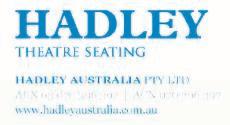



The Association of Community Theatre, in partnership with Marsh’s Entertainment & Leisure Insurance broking team, have developed a tailored and affordable insurance program for the industry.
The core insurance policies are:
Public & Products Liability Insurance ($860)
This covers the activities of rehearsal and staging of theatrical or musical performances including theatrebased workshops and promotion of performances ($20 million limit with market leading extensions and sublimits).
This policy provides significant lump sum payments, weekly benefits and other compensation outlined in the policy in the event of accidental death, permanent disability and temporary disability for all board members, committee members and unpaid individuals engaging in activities on behalf of the insured theatre group.
Money Insurance ($140)
This provides cover for loss of up to $5,000 of the theatre group’s money whilst in the possession of an authorised person or at the box office.
You can save by packaging policies together: PL + VWPA is $1155; PL + Money is $990; and PL + VWPA + Money is $1295.
All policies are renewed annually on December 31 each year and premiums payable are pro-rated up to 6 months to the renewal date.
As part of the partnership, Marsh rebates a portion of all premiums back to the association every year. The funds are used to promote theatre company performances, professional development and advocacy.
By buying insurance as part of the Association of Community Theatre group, theatre companies enjoy stable premiums and consistent coverage over a long period, thereby avoiding fluctuations in pricing and coverage compared to a purchase on a standalone basis.
The partnership fosters collaboration, with the Association of Community Theatre working with Marsh to constantly improve the coverage and address any emerging needs of its members.
Theatre companies must be a member of ACT to participate or be a member of an affiliated umbrella organisation in states outside of NSW. You can find more information at jltentertainment.com.au/act
Mark Wilson from Theatre Compliance And Service explains why all venues that hang loads above people’s heads need an annual safety inspection.
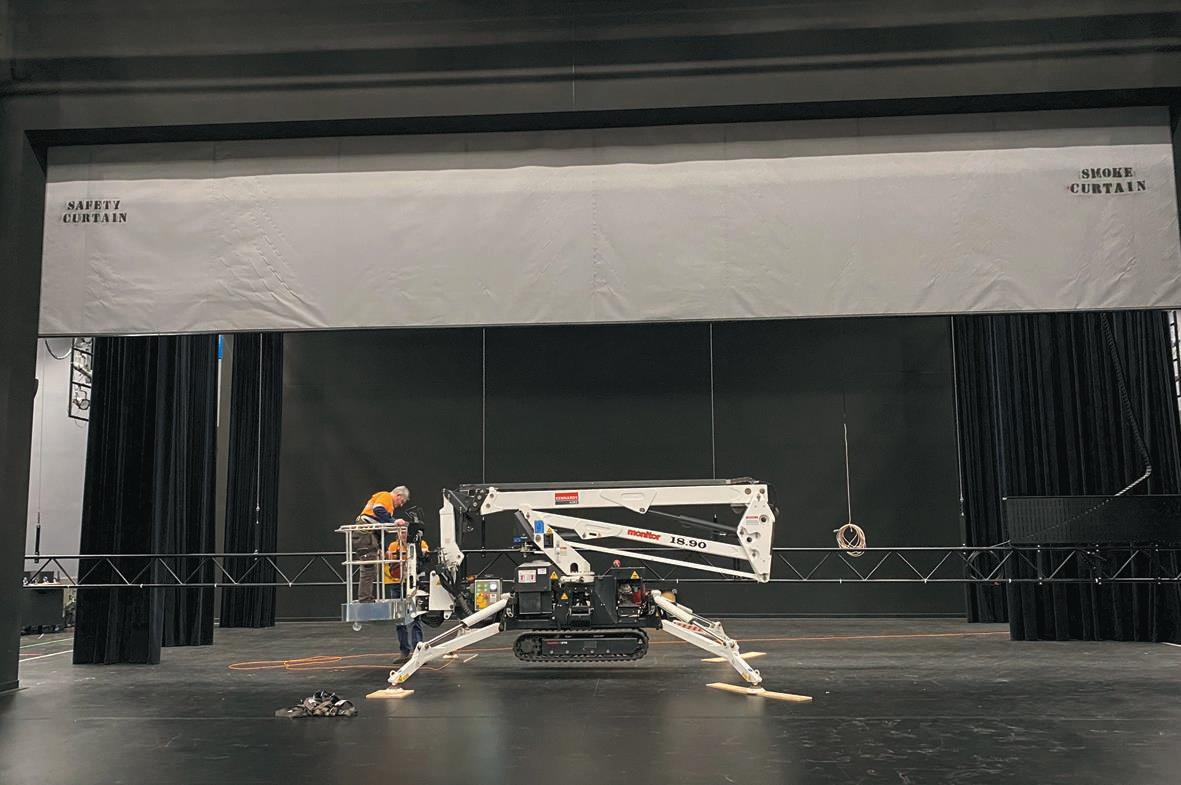
A few years I was doing an inspection at a major suburban theatre when the brake failed on an old-fashioned winch and the chain went into freefall.
When the handle spins quickly it can take skin off people’s hands. I saw a technician have his finger opened quite badly because he could not get it out of the way fast enough.
Another time I saw a bar go into freefall at a school and it was lucky no one was under it. Naturally, whatever is on top of the bar a speaker or lights gets damaged.
The winches are no longer compliant and are being replaced by an electric pile hoist or an electric drum hoist. The pile hoist is the cheaper option favoured by smaller venues, whereas the drum hoist gives stage operators more control.
Sometimes schools get a handyman to hang things using chains they pick up from a hardware store. This is not acceptable. Theatres need to install a rated chain from a rigging store.
To be fully compliant, any venue in which equipment is lifted above
people’s heads, an annual inspection is needed.
My company inspects venues ranging from small schools, to rural theatres and major city venues such as Sydney’s State Theatre.
The key things we are looking for are the rigging, to make sure all the chains and shackles are rated and compliant to lift a load above people. We examine whether the nuts and bolts are tight enough and if they have the correct washers.
To arrange for an inspection contact Mark Wilson at Theatre Compliance And Service on 0419 144 868 or at mark@theatrecs.com.au theatrecs.com.au
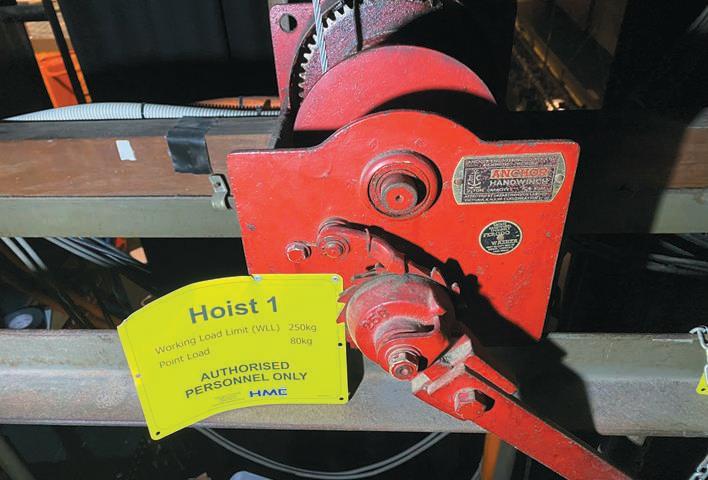
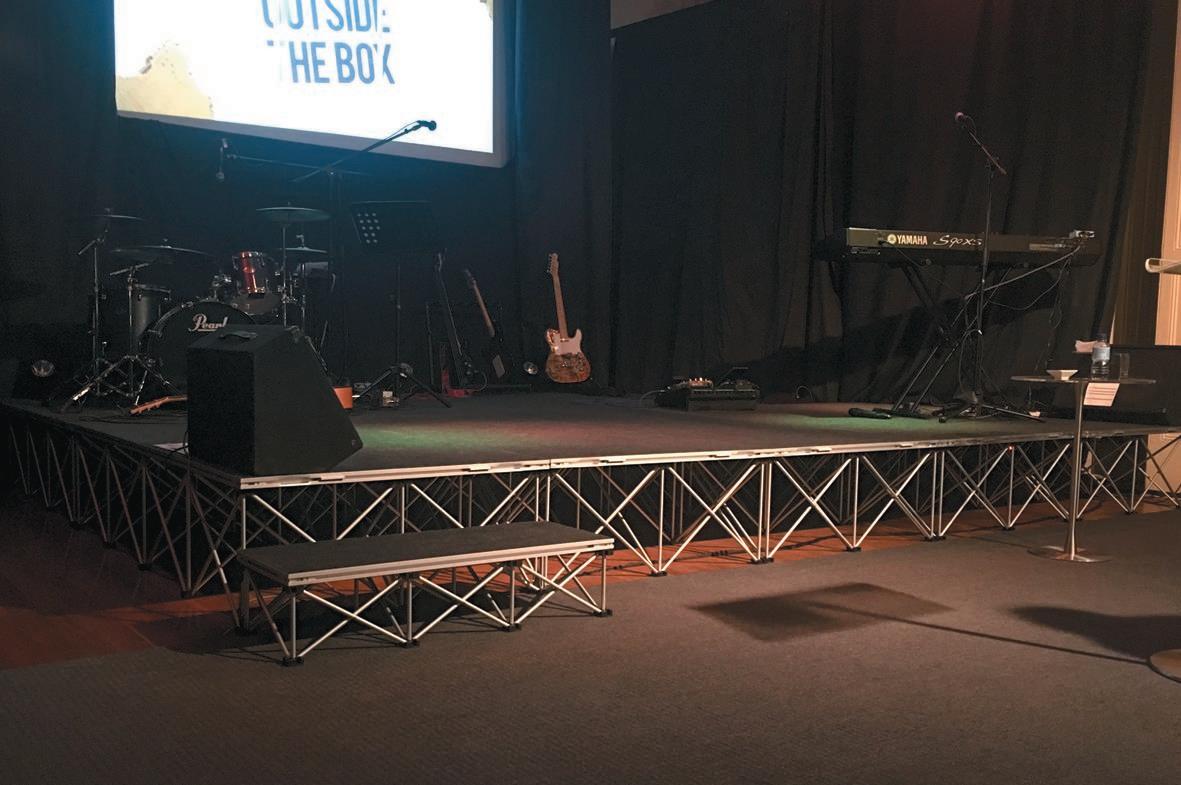
Stage Consultant Peter Giblin describes how Transtage is helping schools with growing student numbers expand and re-locate their performing arts programs.
Supplied to over 1000 schools Australia-wide in the past decade, Transtage specialises in providing portable staging and seating risers for events and performances of various sizes.
Portable stages have become a highly flexible solution for schools as permanent stages often can't always accommodate the needs of school events and gatherings. Thanks to the intelligent modular design, Transtage stage decks can be used either as standalone stages or easily attached to existing stages for expansion when you have a bigger event. Our stages are also height-adjustable, making them suitable for both indoor and outdoor use, even on uneven surfaces. As a result, location is no longer a restriction for holding your school events and performances; the stage can be set up anywhere in the
school.
Safety is our top priority. Transtage stages are constructed with industrialgrade materials and sophisticated designs, all exceeding Australia's loading standard of 750kg. They are also lightweight and very easy to set up; most schools we supply to are set up by the school's maintenance staff, teachers, and even senior school students.
With offices and warehouses in Australia, our dedicated team will assist you promptly when you need help, and all orders are delivered in a timely manner to ensure your stages are ready for your event. Please contact Transtage today for a quote and a tailored solution for your needs.
transtage.com.au
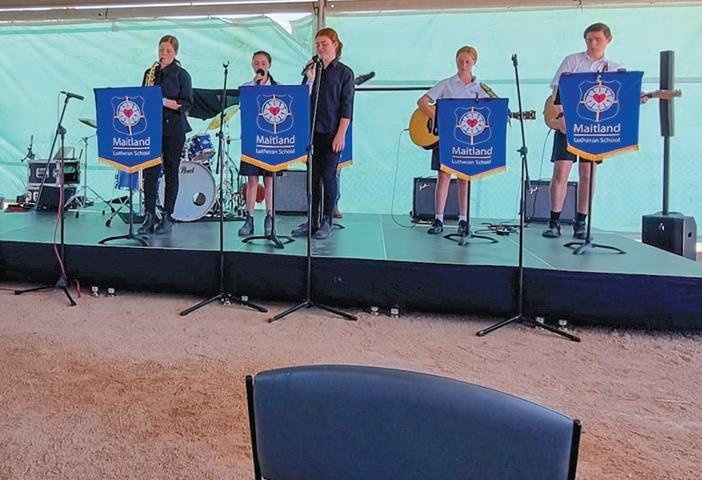

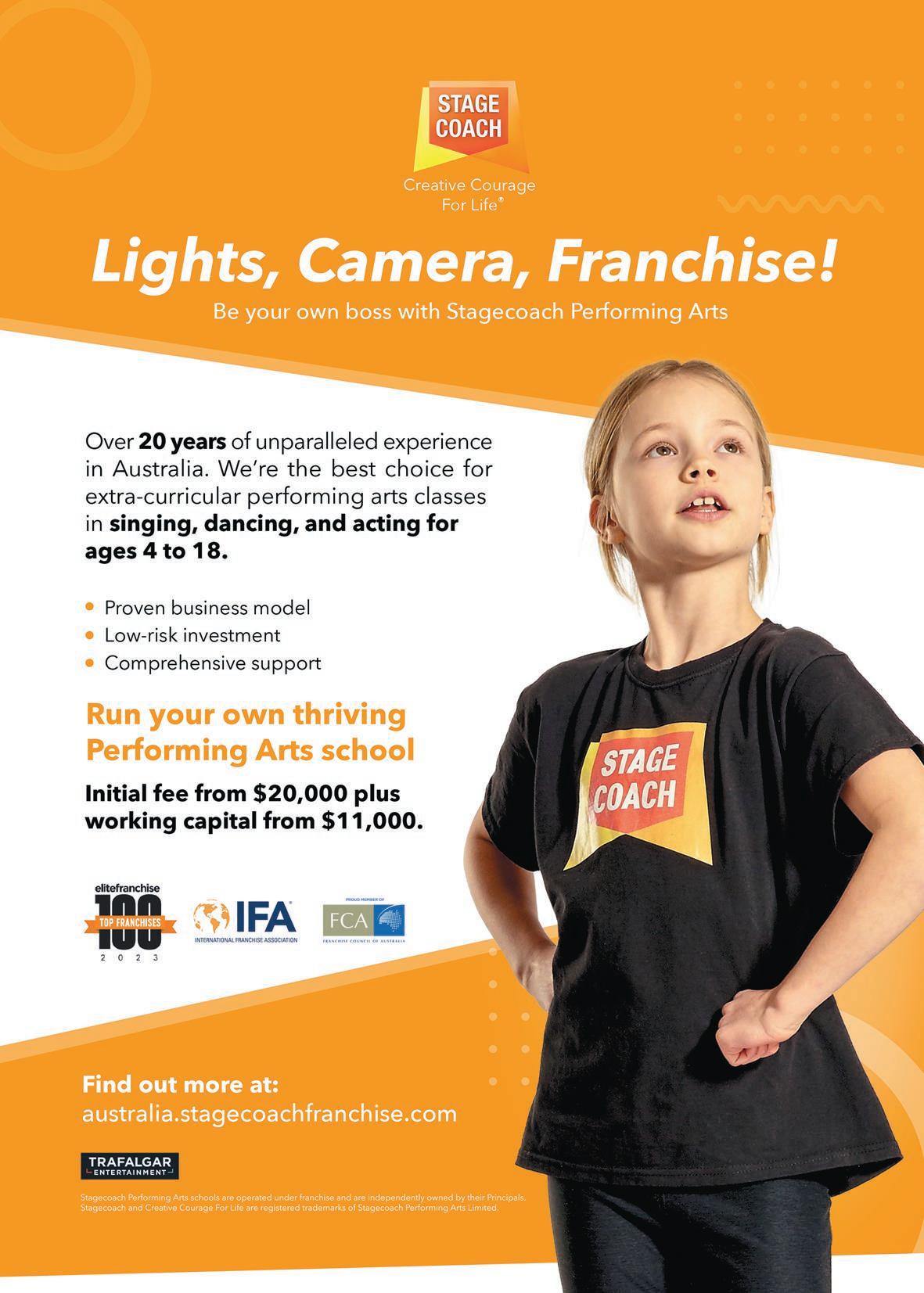
An international Performing Arts school is seeking expressions of interest from Australians to set up their own centres across the country.
Stagecoach Performing Arts specialises in providing extra-curricular performing arts education for students aged 4 to 18. Their unique approach nurtures talent in acting, singing, and dancing but also instils life skills that they call “Creative Courage for Life®”.
A spokesperson for Stagecoach said, “if you have a love of theatre and you’d like to start or continue to build a vibrant and inspirational career in the performing arts, joining a leading performing arts school franchise could be the best decision you make this New Year.”
The company has two schools in Perth.
Five years on from investing in her first Stagecoach franchise, Alison Tasker now runs three successful schools in her Perth South territory, with six teachers, two assistants and over 125 students.
Alison says, “Now that I am a franchisee, I feel in control of my destiny and I’m already earning a great income.
“I love that I don’t have to worry about leasing a shop front or taking on unnecessary financial risk, especially during these uncertain times. Owning a franchise has given me not only financial independence
but the freedom to be my own boss my self-esteem has really improved too.”
And it was her love of the arts that first attracted Principal Serena Kipling to Stagecoach. She says, “it’s incredible to see how far the franchise has come since I launched the first Stagecoach school in Australia. We’re now regarded as one of the best performing arts opportunities for children in the area. As a franchisee, I get a lot of satisfaction out of running my business.”
Stagecoach has over 35 years of performing arts education experience with over 300 franchisees worldwide.
Choosing Stagecoach means aligning with a proven system that blends the independence of business ownership with the support of a distinguished brand in the performing arts world.
Reasons to tune in:
Supportive network: Navigate the business world with a committed Head Office team.
Profit potential: Unlock the door to profits of up to $54,000 and beyond with a business model designed for growth.
Growing industry: Tap into the high demand for quality education and extra-curricular activities.

Community engagement: Become a vital part of local communities, fostering relationships and partnerships.
Diverse backgrounds welcome: No prior experience required.
Flexibility: Build your business at your pace, part-time or fulltime.
Connections to a leading brand in the theatre industry: Stagecoach Performing Arts is part of the Trafalgar Entertainment Group, a premium international live entertainment business with venues including the Theatre Royal Sydney.
From collaborations with industry giants to franchisee longevity celebrations, Stagecoach prides itself on a strong sense of belonging instilled in schools and students. Principles focus on building life skills such as resilience, creativity, and courage.
Visit stagecoachfranchise.com to find out more.
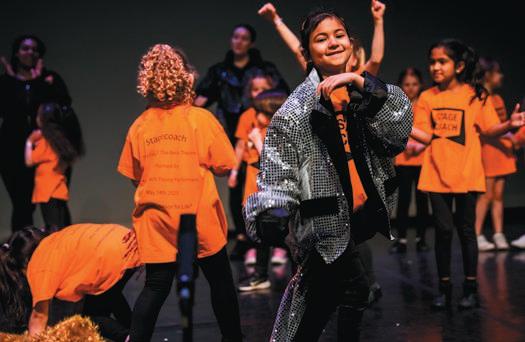
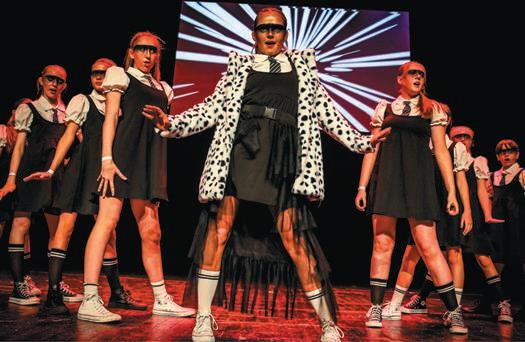
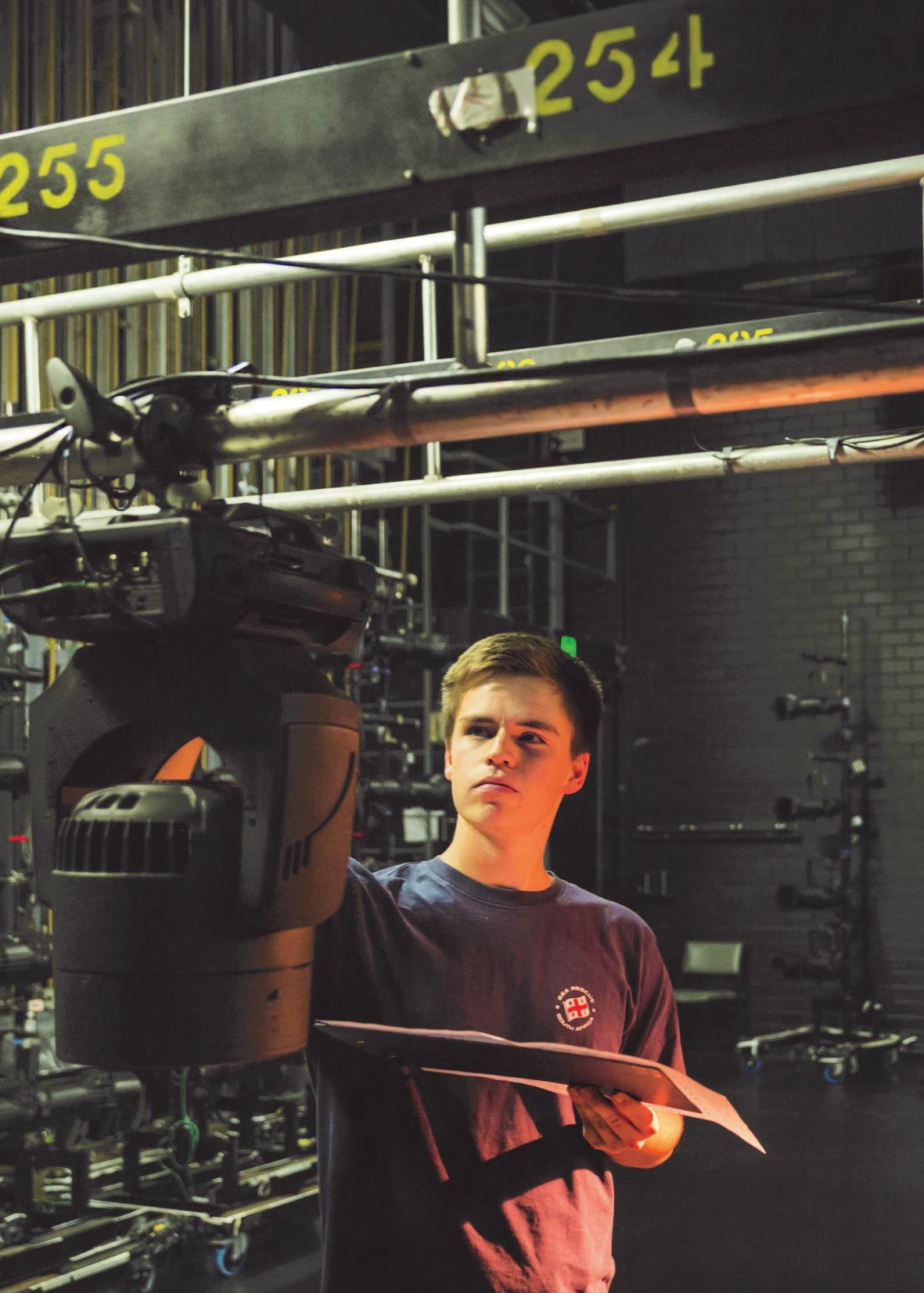

See more listings online at bit.ly/2nEHzGK
B.S. Sound PA Hire can provide hire of Headset mics, Lapel mics and other cordless mics and wireless audio links. Shotgun microphones. Digital mixers up to 32 channels, delayed speakers, low profile fold-back monitors, etc. LED Lighting; flat par, ground row and follow spots. Projectors & screens also available. All hires need to be booked in advance. Hires can be picked up if you have your own crew. We can also deliver, set up and operate if required. Technicians have Working With Children Check cards. All electrical equipment is Test & Tagged. Contact Mark Barry for all enquiries.
25 Cromwell Street, Glen Iris, VIC 3146 +61 3 9889 1999 +61 4 1999 3966 bssound@bigpond.com bssound.com.au
Specialising in theatrical lighting hire and sale, Clearlight Shows is well known for being a one stop theatrical lighting shop. Their staff have years of practical experience and are able to assist you with any queries you have.


The products imported are known internationally for their quality, reliability and value for money. All products they sell are supported by in-house technical staff. They also offer equipment training and maintenance. Clearlight Shows aim is to assist you in purchasing or hiring theatrical or architectural lighting equipment and accessories. They also stock gel filter, lamps and spare parts. Contact John McKissock for all your lighting hire and sale needs.
5 Horscroft Place, Moorabbin, VIC 3189 +61 3 9553 1688
sales@clearlight.com.au hire@clearlight.com.au clearlight.com.au
Creative Film and Theatre Solutions
Creative Film and Theatre Solutions are the Exclusive Wholesale Distributors for Australia and New Zealand for Rosco Inc products. Products include Lighting Filters , LED Fixtures , Dichroic Glass Filters , Lighting effects equipment , Fog and Haze Machines , Flooring , Scenic Paint , Green and Blue Screen Paint , Fire Retartants and backdrops for film,television and broadcast
Unit 2 , 42 Sawyer Lane, Artarmon, NSW 2064 +61 2 9906 6262
sales@cfats.com.au cfats.com.au

Factory Sound
Factory Sound is Australia’s leading supplier of professional audio equipment. For school productions, amateur theatre and professional acts, our range covers microphones, speakers, mixing consoles and all the bits in between. With a large showroom in South Melbourne and experienced, knowledgeable staff on hand to answer questions, you can be assured of swift solutions and the best price available. After 25 years serving the pro audio needs of Australia’s entertainment industry, it’s no wonder so many people say “go to Factory Sound, you’ll get looked after.''

Contact Artie Jones for audio sales, project design and installation, and first-class advice.
75-85 York Street, South Melbourne, VIC 3205 +61 3 9922 1000 +61 3 9690 7077 sales@factorysound.com factorysound.com
Gobotech
Gobotech Pty Ltd have been manufacturing gobos in QLD since 1996. Today a world leader in their field they can work with you to take your custom design to projection success. You can also select from a massive range of stock images for a great result on a budget. Gobos are manufactured in stainless steel, black and white glass or full colour glass. The latest 2019 stock gobo catalogue is now available to download from their website.
3/4 Northward Street, Upper Coomera, QLD 4209 +61 7 5573 3177 sales@gobotech.com.au gobotech.com.au grandlighting.com.au

LifeLike Atmospheres mission is to be the industry leader and ultimate provider for sound, lighting and audio/visual solutions
Unit 2/46 Mitchell Road, Cardiff, NSW 2285 5 Pope Street, Ryde, NSW 2112 +61 2 4915 9615 +61 2 8880 6766 info@lifelike.com.au info@lifelike.com.au lifelikegroup.com.au lifelikegroup.com.au
Loud And Clear
Loud And Clear’s specialty is providing professional audio solutions for theatre and corporate events.
They provide a complete service including production design, hire and operation of all equipment for any production. From the simple hire of a single radio microphone, to a full scale sound system for a musical with 40 radio mics and an orchestra of 38 players in an 800 seat auditorium. Their staff are passionate about theatre and customer service. Contact David Betterridge to discuss your audio needs.
PO Box 334, Mosman, NSW 2088 +61 2 9439 9723 info@loudandclear.com.au loudandclear.com.au


LSC Lighting Systems
LSC Lighting Systems has an extensive network of distributors and dealers. The LSC product range is extensive and covers diverse market sectors, such as live performances, traditional theatre, corporate theatre, worship, educational, television, film, exhibition and architectural lighting. Equally, the customer profile for LSC products is quite diverse, encompassing some of the world's best known Opera Houses and Theatres, major Touring Production companies, National television studios to local community theatres, schools and churches. Where you require good, reliable lighting control for your show - you will find the name LSC.
65-67 Discovery Road, Dandenong, VIC 3175 +61 3 9702 8000 info@lsclighting.com.au lsclighting.com
Moving Light Productions


Moving Light Productions (MLP) is one of the leading production companies in Victoria and now Australia. They have provided lighting designs for shows and companies such as London’s West End International Touring show Peter Pan Goes Wrong, The Play That Goes Wrong (Australian Tour 2017), Les Misérables (Launceston, Tasmania), Avenue Q (Her Majesty’s Theatre Melbourne & Crown Theatre, Perth), Wicked (Launceston Tasmania), In The Heights (Australasian Premiere), Jon English’s Paris - A Rock Odyssey (2017). With many years of experience in professional theatre and independent theatre, Moving Light can design a light show to suit your needs whether its using the in-house standard rig through to a LED and Moving Light Rig incorporated with LED Screens. They can customise package lighting with designers that will suit your school production or concert. They are passionate about what they do and their staff will be on board with your production all the way through to the bump out. All staff at MLP are willing and wanting to work closely with your staff and school giving you the most professional result. Contact Jason Bovaird to discuss your next production.
Factory 10, 22 Makland Drive, Derrimutt, VIC 3030
+61 4 0955 2936
production@movinglightmlp.com movinglightmlp.com
Riedel
Riedel Communications designs and manufactures the most pioneering communications solutions for a theatre environment. RIEDEL also provides real-time networks for video, audio, data and communications for theatre, pro-audio, event and large venues, sports, broadcast and security applications worldwide. RIEDEL Australia offers a large rental operation that provides radio, intercom, event IT solutions, fiber-based and wireless audio & video transmission systems.
2/38 Morley Avenue, Rosebery, NSW 2018
+61 2 9669 1199
australia@riedel.net
riedel.net

State Automation is dedicated to the design and manufacture of state of the art lighting control and automation systems for the entertainment industry. Our lighting and stage solutions are helping some of the world’s most prestigious venues. We tailor your needs and expectations a solution that is reliable and cost effective in the long run. Everything is possible is our motto!
Factory 25 / 191-195 Greens Road, Dandenong South, VIC 3175
+61 4 3707 7580
info@stateautomation.com stateautomation.com

Outlook is offering an opportunity for students, who don’t want to be on stage, to train alongside some of Melbourne’s best radio mic technicians or be mentored in mixing sound front of house.
Outlook is one of the only companies that allows such involvement.
“All staff who work directly with students have current Working With Children Checks which provide teachers and parents that added level of security,” said company owner Jack Jones.
“Whether it’s from day one of rehearsals or just before production week, working with an Outlook experience is a once in a lifetime opportunity.”
Outlook also offers work experience for those students who are looking at production once they have finished school.
Jack Jones’ love of theatre began in 2010 at his high school.
Outlook was the sound supplier for all the Junior and Middle School
productions, as well as other major school events.
His first production working alongside Outlook and its founder Greg Ginger was Carey Baptist Grammar School’s Middle School production of Oliver! in 2010. From then on, Jack was hooked.
“Ï was the first student to mix a musical at Carey in 2015, which was Crazy For You. After I left school, and with the encouragement of the whole school’s Theatre and Music
Department, I went on to study at the Victorian College of the Arts and worked part-time at Outlook.”
His passion continued throughout the pandemic, when he took the massive step to purchase Outlook.
Jack isn’t the only staff member who came from Outlook’s Schools Program. Over 30 percent of Outlook staff were students at schools or community theatre groups that have hired the company’s services.
“So, giving your students that one opportunity that they wouldn’t get elsewhere could change their lives forever. And isn’t that what education is meant to be about? Teach them something that they can’t get elsewhere?
“Have you got an upcoming production? Lock us in now to support your students to the full potential.”
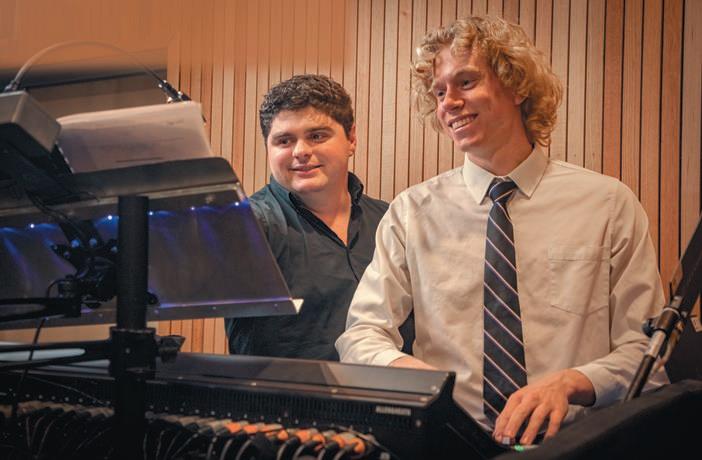




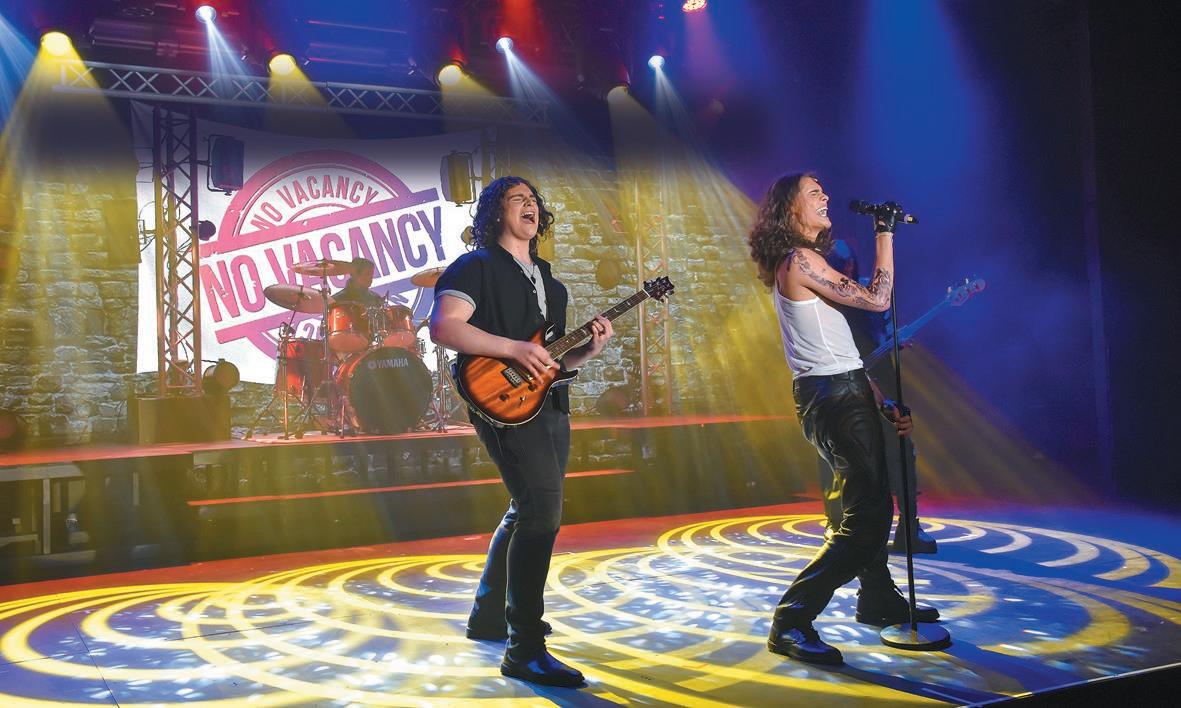
Brentwood Secondary College in Melbourne staged Andrew Lloyd Webber’s School of Rock in 2023. Jack Jones from Outlook Communications describes the challenge of setting up a huge production in a school gymnasium in a few days.
School of Rock is a very challenging musical to stage technically, because not only do the lead characters need microphones, but if the actors play live on stage, their instruments also need to be amplified and balanced with the backstage band.
For this production we used 40 radio microphones for the cast and instruments.
Brentwood is a public school with a modest budget and no dedicated performing arts venue.
Outlook Communications threw ourselves into the challenge, with three days to convert their hall into a theatre.
To make it more difficult, the space has a terrible echo. Fortunately, international sound designer Julian Spink was available to help, in down time from his other gigs on professional tours of Chicago and & Juliet
We managed to get just enough radio frequencies which did not have interference. To install the 40 channels of fixed and hairline microphones we trained students to assist us.
Brentwood’s Director of Performing Arts, Ash Bull, says, “Outlook turned our 55-year-old gym into a theatre with sound of the highest calibre.
“It was also great for students not comfortable on stage to participate in the performing arts program by teaching them to install the microphones and connect the microphone packs.”
To mix the sound we used a new Allen and Heath Avantis console which can handle up to 64 channels and a Funktion-one speaker system. To allow the front rows of the audience to hear the musical we required extra smaller speakers (JBL Control 25) to boost sound.
Little Shop of Horrors
Brentwood Secondary College from August 13 to 17.
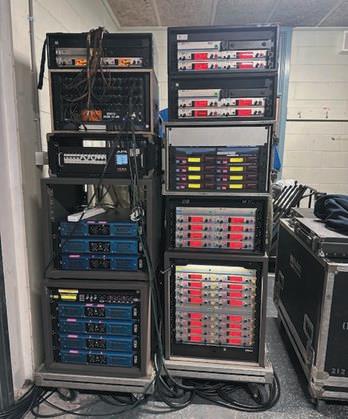
Other technical elements included a vision link from the conductor backstage to the cast on-stage.
John Yanko (Dewey Finn) won a Music Theatre Guild Award for best lead performer in a male presenting role. The School of Rock band also won a Victorian Youth Lyrebird Award for best acting partnership.
Outlook Communications loves working with schools and offering extra resources for their productions.
Get in touch with Outlook Communications at outlookcomms.com.au
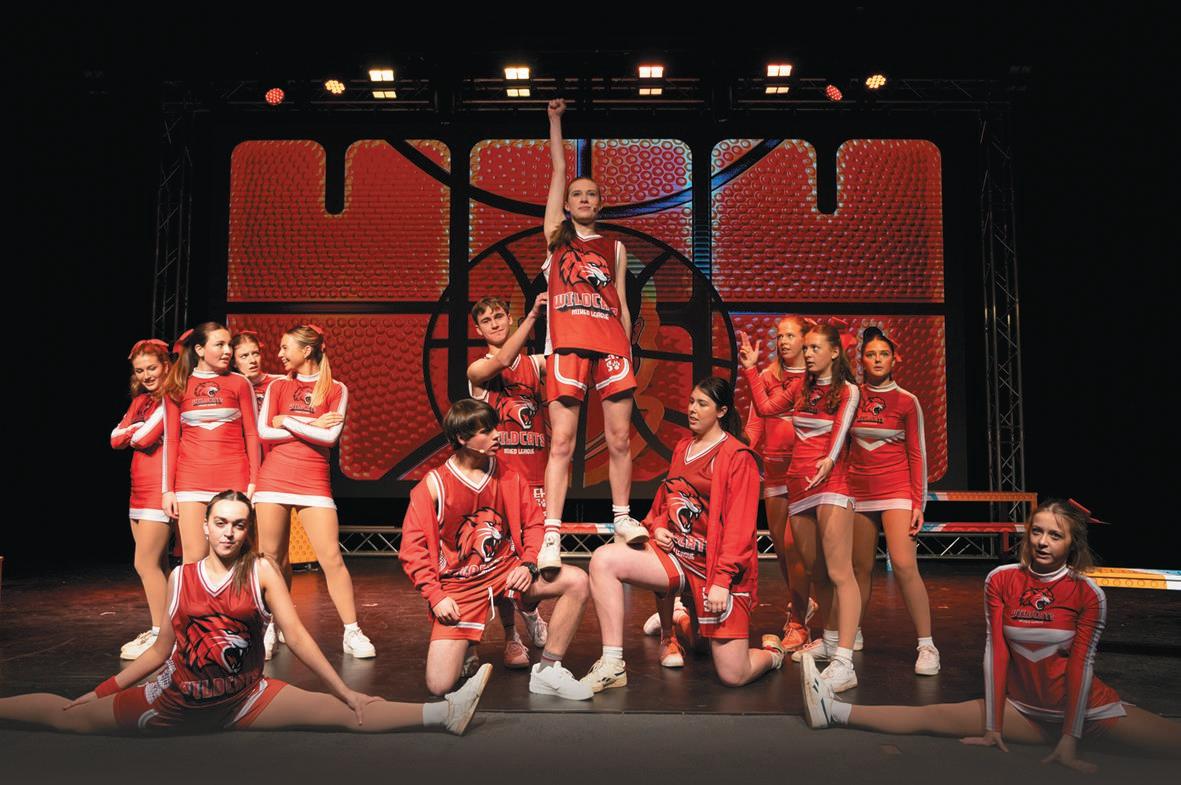
Chevalier College in the NSW Southern Highlands recently staged a production of High School Musical that left audiences buzzing with excitement.
One of the most impressive aspects of the production was the innovative use of technology: particularly the use of an LED screen and DPA headset microphones.
Using DPA headset microphones allowed for crystalclear sound, ensuring that every line, every note, and every nuance of the students’ performances could be heard with perfect clarity. The use of headset microphones for every cast member was a new concept for a Chevalier’s musical. They were supplied and operated by the professional team from Inspired Productions.
Unlike traditional setups where performers are often constrained by handheld or stationary mics, the headset microphones provided freedom of movement, enabling the cast to fully immerse themselves in the energetic choreography and dynamic staging.
The most striking feature of the production was the massive LED screen that served as the digital backdrop for the entire show. This screen displayed custom-created visual content that transported the audience directly into the world of High School Musical
Director Joshua Combes, Head of CAPA at Chevalier College, was the mastermind behind this digital spectacle. His vision content was an integral part of the storytelling,
adding layers of emotion, context, and atmosphere that traditional sets could never achieve.
For each scene, Combes custom-designed digital background content to evoke scenes of high school hallways, karaoke competitions, and incorporated video content which the characters on stage could interact with. One such moment was when the character of Sharpay signed up for auditions; their writing appeared digitally on the LED screen background.
The vision content also gave the audience insight into the thoughts and feelings of the characters, including showing a playlist of the songs running through the characters’ heads and images of their future aspirations.
Immersing the audience in the characters’ journeys was at the forefront of Combes’ design vision, so much so that the audience joined the cast for an electric karaoke competition during the finale and bows.
Though the design took many months to achieve, it left the audience with a lasting impression and added to the energy and spectacle of this technically savvy show.
This production was also remarkable for its learning opportunities. Students were given the unique chance to work alongside the Inspired Productions team, gaining invaluable experience in the technical aspects of theatre. From operating the lighting to managing microphones, students were trained in a variety of technical roles,
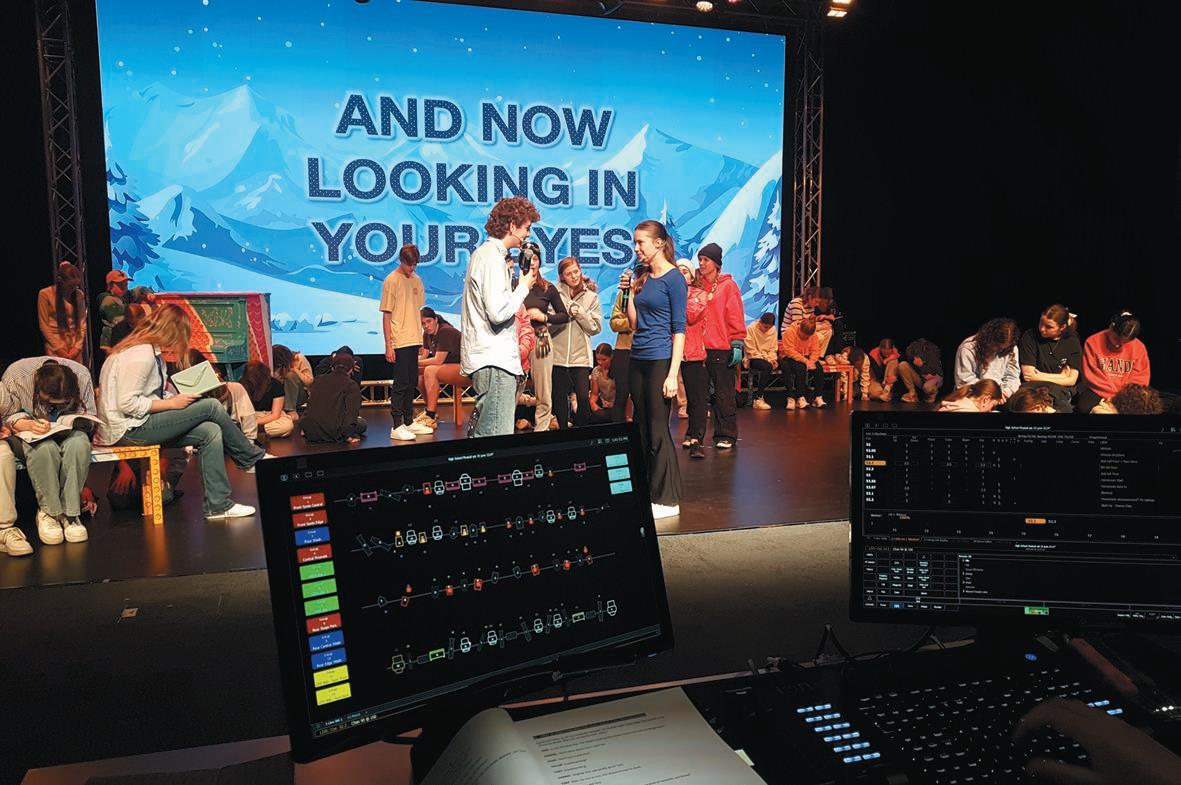
learning the intricacies of live production in a real-world setting.
This collaborative approach not only empowered the students with new skills but also deepened their understanding of the complexities involved in staging a professional-quality show.
The seamless integration of advanced technology, coupled with the hands-on training provided by Inspired Productions, together with a talented, passionate cast, resulted in a show that rivalled professional theatre productions.
Chevalier College’s High School Musical set a new benchmark for the school and showcased the best of what student performers and dedicated technical teams can achieve together.
Inspired Productions invite you to get in touch with them to unlock the full potential of your next show. With their state-of-the-art technical equipment and expert operation, Inspired Productions can help transform your vision into a spectacular reality.
Elevate your production to professional standards, captivate your audience, and showcase your talent like never before with Inspired Productions. info@inspiredproductions.com.au inspiredproductions.com.au
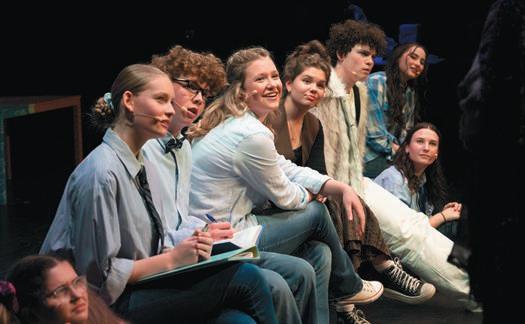



Get noticed on the Stage Whispers website with a premium listing at a great price
stagewhispers.com.au/directory-central
Stage productions are becoming more spectacular than ever as designers combine animation, LED light projection and traditional set pieces in new ways. Beth Keehn speaks to the creatives of a large-scale Disney musical blockbuster (Beauty and the Beast) and a pro-am community show in a regional venue (Cinderella) to compare what new and old tools they use to create magic on stage.
Stanley A. Meyer has been working in stage design for nearly four decades. From small regional theatres, Stanley moved to national stages across the US before joining the world of rock and roll stadium tours and theme park outdoor spectaculars. His work for the Disney Theatrical Group started with a nervous pitch with costume designer Ann Hould-Ward to Disney, presenting stage designs for Beauty and the Beast in 1992.
Beth Keehn (BK): How does it feel to be part of something as wonderful as Beauty and the Beast?
Stanley A. Meyer (SM): It’s amazing because it all started with 140 black and white storyboard sketches I created to pitch the show. At the end of the presentation, we were shocked because the Disney executives just said ‘yes!’. And here we are, 30-something years later, and this is the tour de force Disney show running for 13 years on Broadway, and seen in countries across the world.
BK: How have your designs evolved between 1995 and 2023?
SM: The design is completely different from the original. My favourite new element is the large scrolls that fly in and move around the stage. While it looks technically amazing, it is the most rudimentary of all the scenery movements: flying in and out, tracking side to side, and rotating. So, we put all three together and it’s a magical way of creating the Beast’s castle.
Today the visuals are over-the-top fabulous with LED technology but
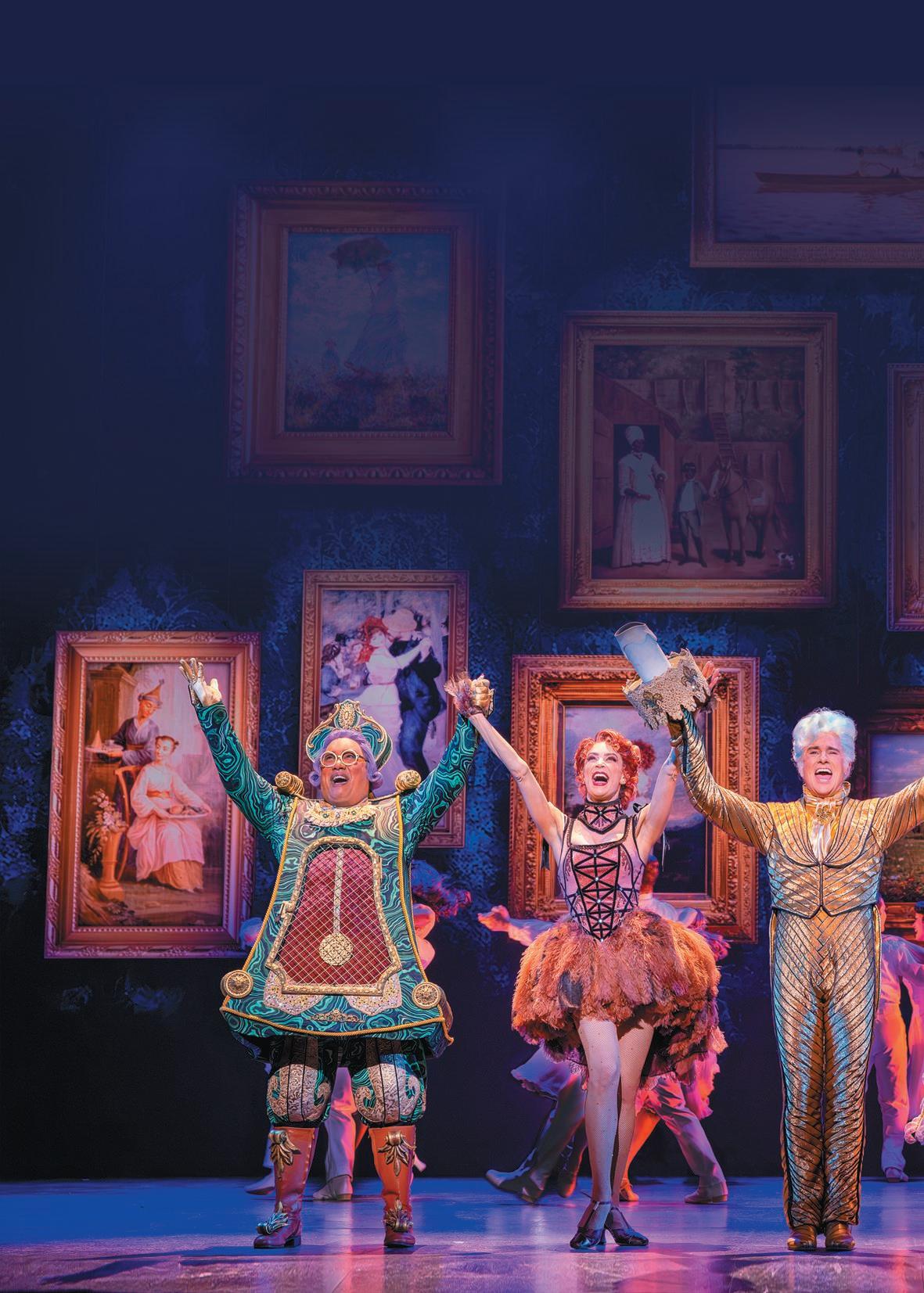

Discover the dizzying array of visuals in Disney’s Beauty And The Beast youtu.be/Ld8ybQf6NjQ
nobody has to change a lightbulb. Another lighting change is in the ‘Be Our Guest’ number: in the original productions we used real neon lighting. It was flamingo pink, but neon is very fragile. Now that scene is all LED, but it looks exactly like neon and can be any colour you want!
The other thing I’m proud of is the artwork for the dining room, based on French 18th century rooms. We go into the dining room, and it opens up into this beautiful garden it looks like the scenery is splitting apart, but it’s actually an LED screen. Our LED drop of the town scene looked so much like a scrim that one of the reviewers in Sydney said they couldn’t believe the number of hand-painted drops in the show but it was all digital content.
BK: Have audience expectations changed over the decades?
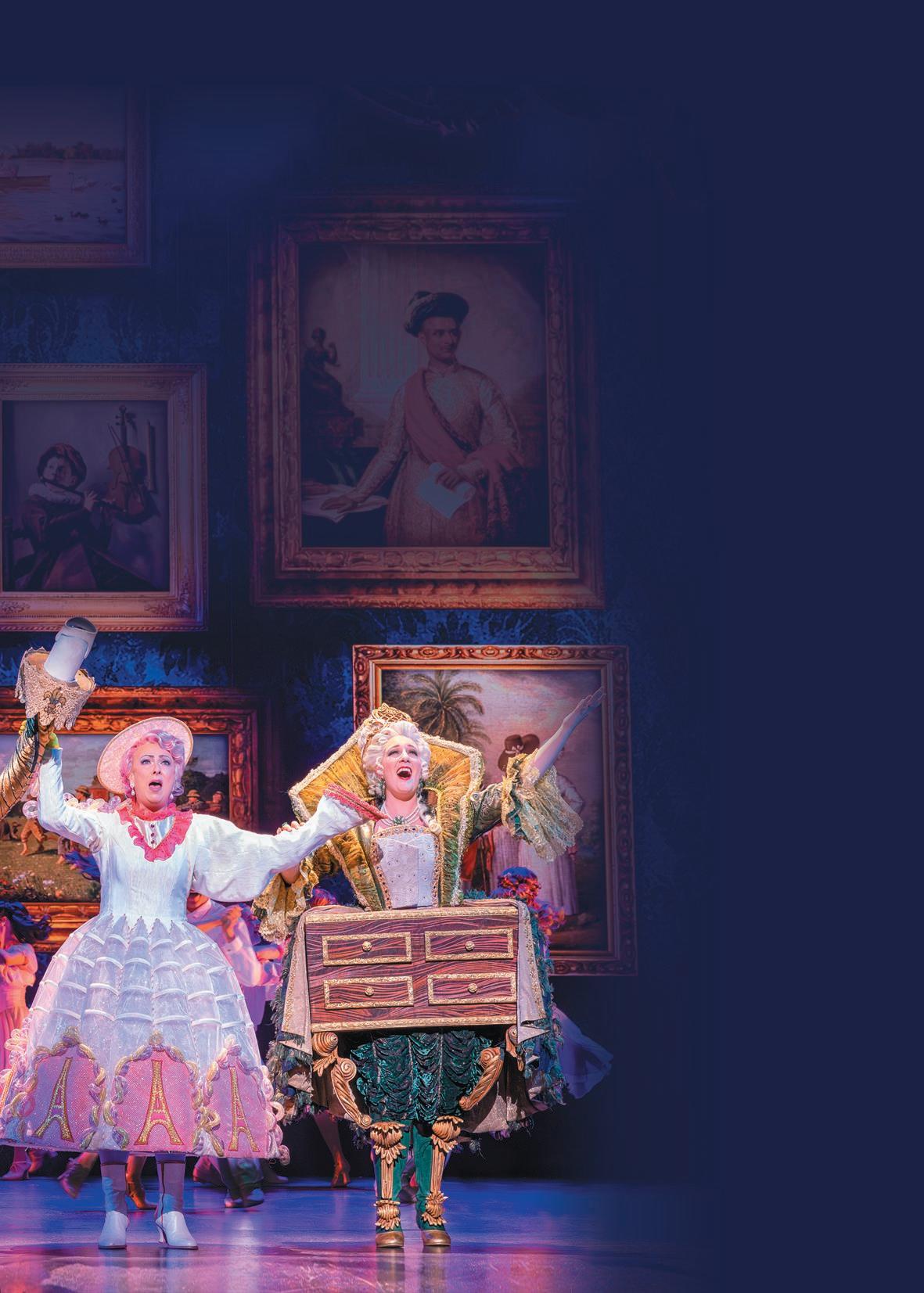
SM: I think they have. But also, I go back and work in small regional theatres quite a bit, and the audience can still be drawn in and wowed by the simplest thing and that has to do with story. If the story or the musical is good, you can do it in a Black Box with no scenery and it will carry and it will make you emotional.
BK: How has the changing technology affected your skillset?
SM: When we first programmed the deck in 1993, it took five hours. It’s nowhere near that time today. We now use Rhino 3D for 3D computeraided design (CAD) drawings. In the old days, you’d have to lay out every detail and then the shop would have to do drawings now they just take your 3D drawing and they build from it. And, although everything is created in digital format, I still draw. I do some Photoshop work with my own drawings, but I sketch and then I
work with one of my associates who is a digital artist. Because I’m drawing by hand it’s not in a computer the final result is a little more free and that’s represented in the work.
BK: How has the technology affected your design process?
SM: It’s all about the script and a ton of research! I drew on all kinds of things for this production for the initial presentation, we had boards with research images and we just talked about the design. For our concept renderings, we used a mix of hand-sketched drawing, hand-painted and Photoshop images. I’ve also used stop animation to show the team an effect I was trying to achieve.
One part of the process that hasn’t changed is collaboration: I believe that the best idea wins. People have their own forte and I think you get the best product from everybody if you work together. Collaboration involving all of the artists in our show was key to success and how it has thrilled audiences. For me the set is a platter that the rest of the show sits on. It’s not a competition; it’s all about supporting the show and how it works and how the story is told. As you can tell I love my job and am thrilled with how our production finally finished in Australia. And it makes me so happy that our show is inspiring a new generation of theatre artists and audiences.
As Beauty and the Beast was opening in Brisbane, the musical theatre team that has produced community pro-am productions at the Empire Theatre in Toowoomba for 23 years was taking on Rodgers and Hammerstein’s Cinderella, with scenic design by Frances Story.
Frances Story studied Architecture and Dance at Queensland University of Technology in Brisbane before starting in scenic design with Iceworks Design in Brisbane, where she has worked for nearly a decade on arena experiences, operas and musicals.
Beth Keehn (BK): How do you start?
(Continued on page 96)

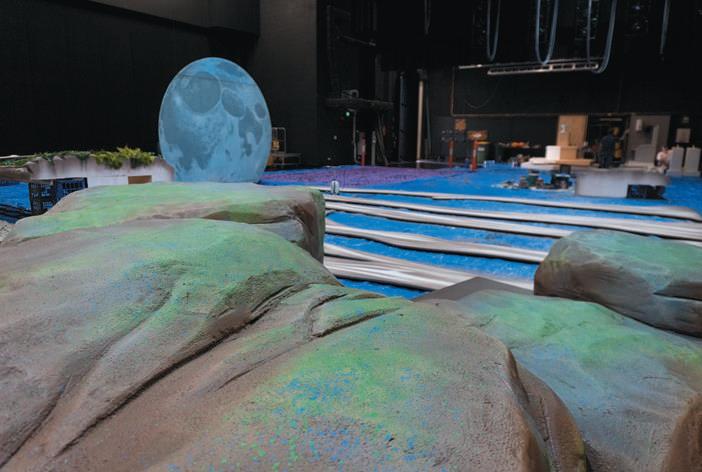

Frances Story (FS): With research lots of mood images defining and honing the direction. I do a script breakdown and extract the design elements. I then sit down with the director and add notes about how they see the visual show unfolding. It’s a collaborative development with multiple meetings. The next steps include more research finding visual references that are going to speak to the look and feel of the show.
Watch a sizzle reel from Empire Theatre’s production of Cinderella fb.watch/rAx5ZSn45v
BK: How does new technology play a part?
FS: I do use digital technology but for mood images, I start sketching. For me that’s the best way to develop ideas without the constraints of a 3D modelling program. For those programs you really have to know what you want the software to do and manipulate it otherwise you end up with a bunch of boxes that don’t really convey the look and feel of the show. For me, in those initial stages with the director, it’s me sketching it out, because I can convey ideas quickly that way.
Once we’ve got a direction, that’s when I start 3D modelling. Because of my background in architecture, I define the design and deliver all the construction plans so I know exactly how it’s going to be built, and that gives me the most control over the end outcome.
BK: Have you had to train to keep up?
FS: With the addition of technology, the audience experience may have changed, but our job is the same to engage them and communicate the story. When I graduated from university, I came out

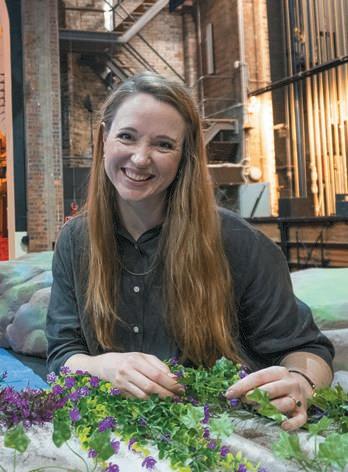
with a skillset of hand drawing and hand rendering but that is not functionally practical in the theatre industry. So, I developed my skills in digital programs. For 3D modelling, I use 3DS Max; for 2D Drafting, it’s CorelDRAW; and image editing software through Adobe Photoshop. I also partner with experts. At Iceworks Design, we first used projections around 2018 on an arena show of The Wizard of Oz we partnered with the illustrator and Optikal Bloc to achieve the animation for the show. We are seeing more LED lighting and projections, which we
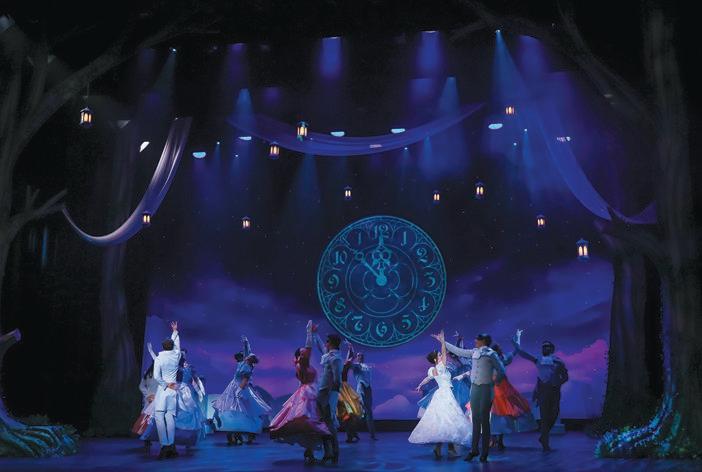
use to augment a physical setting. So, you are seeing that richness of a visual layered storyline a rich tapestry that can add to the layers of the story and audience experience. And we certainly used that in Cinderella to show the magical sense of the story from the Fairy Godmother’s perspective.
BK: What was the main technical challenge in Cinderella?
FS: Cinderella has so many different scenes, the technical challenge was making sure that we made those happen, while also working within the constraints of the
number of personnel the number of flymen, mechanists and the limited time within the number of bars of music that we have to complete the scene transitions. I wanted to design it as a physical set so there is a nostalgia when you experience a set moving on and off stage. We had physical backdrops they are not projected images. For example, the moon is a real piece of stage scenery: it’s not a projection. So, when that changes, it’s happening before your eyes and there is a tangible sense of the magic on stage!

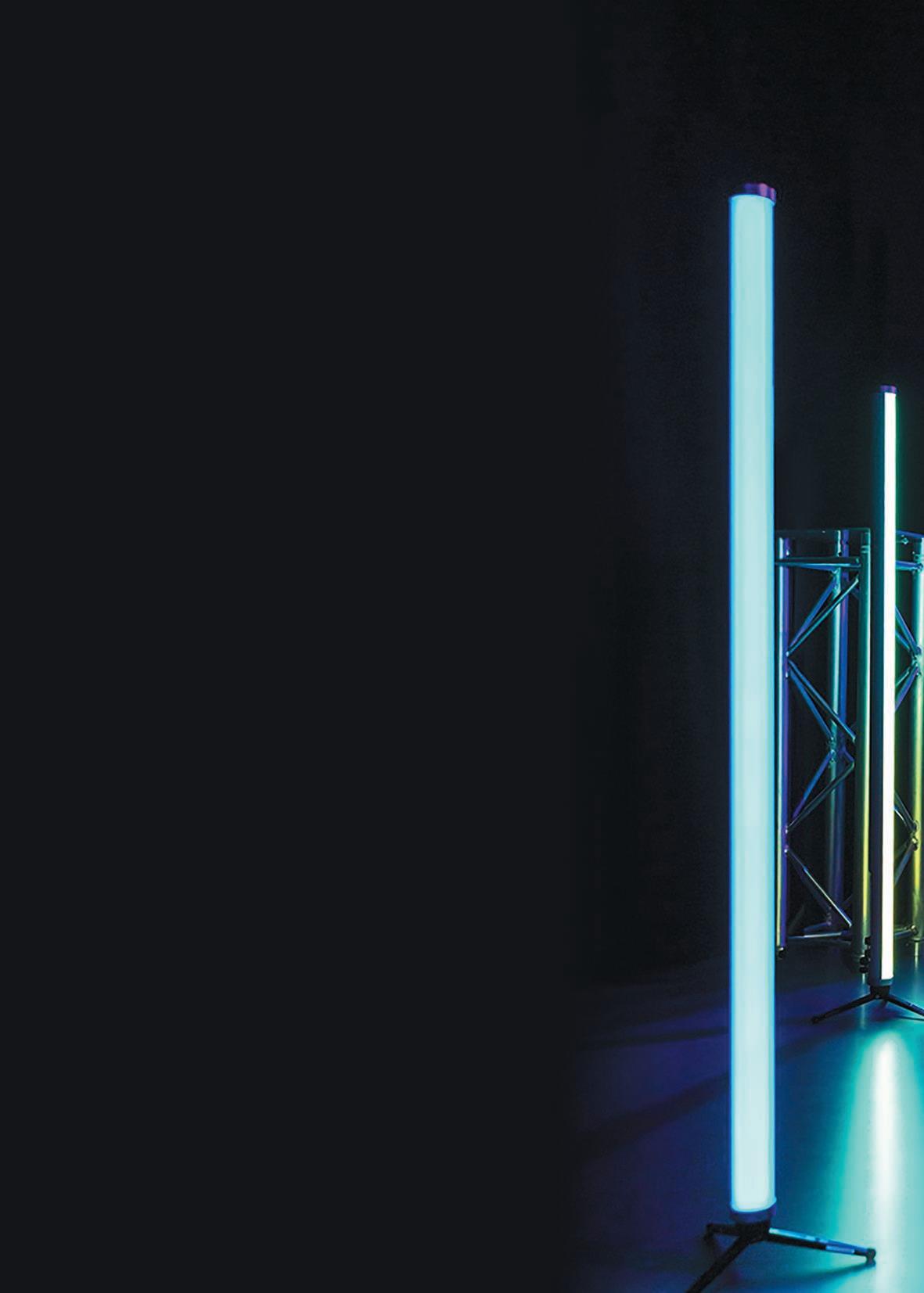
The Managing Director of Outlook Communications, Jack Jones, explains why he recommends the Beamz Pro range of lighting for venues, bands, schools and community theatres.
When Outlook Communications was acquired by my company, The Big Production Group, last year, I wanted to expand the company’s audio offerings to include a full range of lighting.
With the myriad of brands out there, it was hard to choose one flagship company. I took advice from a trusted supplier, James Pavey from Audio Visual Engineering (AVE), which is a family-owned entertainment Australian business (like Outlook), dedicated to the music, and entertainment industry.
From day one, the relationship between AVE and Outlook has been very successful. James recommended Beamz Pro products because of their quality and affordability. They do the job for a third of the price of other brands, which is great for community theatres and schools which don’t have big budgets. Over the past six months we have acquired over 100 fixtures for sale or hire. Some highlights include:
The IGNITE300 is a powerful Beam/Spot/ Wash moving head with a 300W bright white LED source and super smooth three phase motors. Equipped with two gobo wheels, two effect wheels and a rotating facet prism to make stunning aerial effects in eight colours plus white. The linear motorised zoom allows you to focus a beam up to 7° or open up to 32°, to cover a wider area with ease. Perfect for stage shows, productions, events, DJs, bands, venues, and more.
The WBP1212IP is an aluminum IP65 PAR with built-in battery designed for outside usage with 12 high power six-in-one LEDs giving six colours. The fixture enriches the wash possibilities to ensure a better convergence of light. It’s water resistant with watertight internal gaskets and weatherproof power and data cable in/out
connections. No fan as heat is dissipated via the aluminum housing. It also comes with an Infrared remote control.
The BBP54 is a compact Battery Par for use as accent and uplighting. The light is IP65 rated and hence for outdoor and indoor use. It‘s equipped with 4x super bright 12W RGBAW-UV LEDs and comes fitted with a removable built-in battery that lasts up to 15 hours when fully charged, depending on colours and intensity. An adjustable foot can be fixed in different angles for angular placement of the par. The fixture can communicate by IR remote control and wireless DMX.
The Kratos LED Tubes feature full RGBW color mixing, giving you complete control over your lighting environment. Each of the eight tubes can be controlled individually, allowing you to create complex lighting setups quickly and easily. With its lightweight and durable design, the Kratos Tube LED set is perfect for on-the-go shoots and studio productions. It offers a wide variety of stunning special effects to choose from, for any project, from commercials to musical performances.
In late January our senior management team travelled to Barcelona to visit the Integrated Systems Europe (ISE) Expo. We met the Dutch owners of Tronios the parent company for Beamz Pro. This opened a conversation to work together to provide active feedback on new and existing products for the Australian market.
All the products highlighted are perfect solutions for schools and community theatre groups. They are affordable yet the quality is second to none. We absolutely love these products, and you will love them as well. Outlook has all the above in our hire stock, but we are also a sales dealer for Beamz Pro.
For all your lighting needs, get in contact with Outlook Communications. Call: (03) 9495 1755 Visit: outlookcomms.com.au
Email: info@outlookcomms.com.au
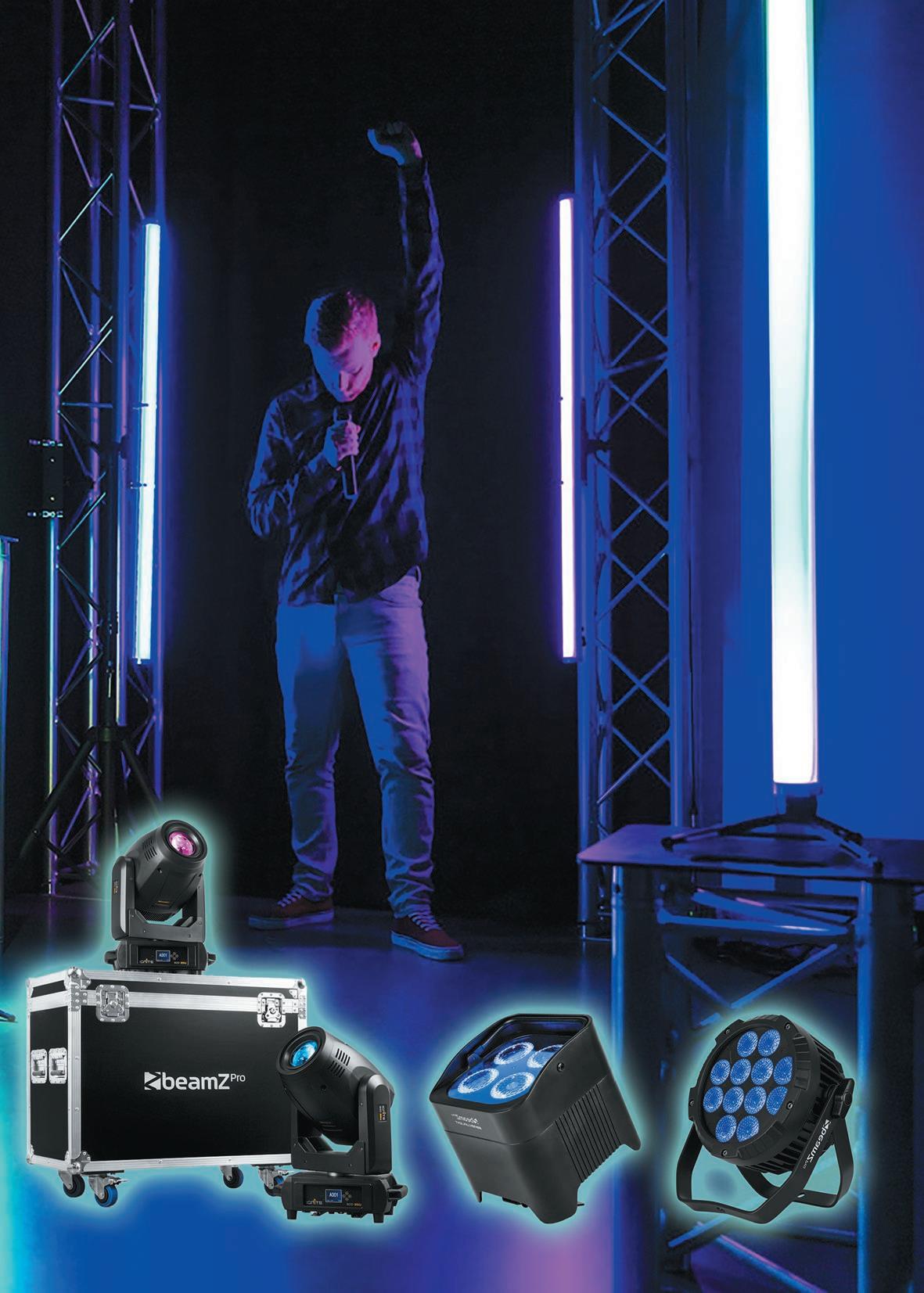

Leah Crockett, creator of Tech Crew HQ, explains the importance of training your crew to ensure that your show is a success.
It’s four weeks ‘til showtime time to bring in the technical crew!
Uh-oh, how do we train our new Tech Crew members so that they will be ready for the show?
If you’ve ever been involved with a school production you will know that students relish being involved in all aspects of a production even if they are not performing on stage.
However, too often we bring in students with no other theatre experience and give them a slap-dash introduction to working backstage. This approach often leads to difficulties communicating, increased safety issues and some very tedious technical rehearsals.
A well-coordinated backstage crew is the unsung hero behind every seamless performance, and the key to a great backstage crew is great
training. Technical theatre training doesn’t have to be laborious and expensive, but it does have to be theatre specific and it must have safety at its core.
That’s why Tech Crew HQ was invented; Tech Crew HQ is online training specifically designed for tech crews to give them skills and knowledge in the areas of lighting, audio, safety, stage management and vision. Being online means that Tech Crew HQ is accessible 24/7 and features lots of videos and interactive activities so that learning the skills for the next production is quick and engaging.
Tech Crew HQ is flexible enough for individuals to learn on their own, or for group training sessions.
Tech Crew HQ is theatre and live event specific, utilising Australian

theatre terms and standards, as well as showcasing Australian and New Zealand live event professionals in its regular webinars.
As more schools and community organisations access training through Tech Crew HQ, we are hearing of great things happening backstage including increased professionalism of the crew, higher confidence when operating shows, more efficient technical rehearsals and a focused approach to staying safe backstage.
If we take the time to train our technical and backstage crew effectively, shows will run smoothly, safely and these creative collaborative experiences may even provide students with a career pathway into professional theatre and live events.
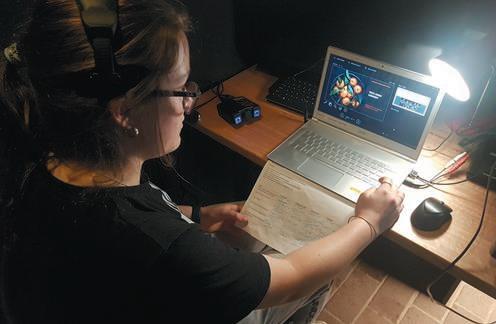
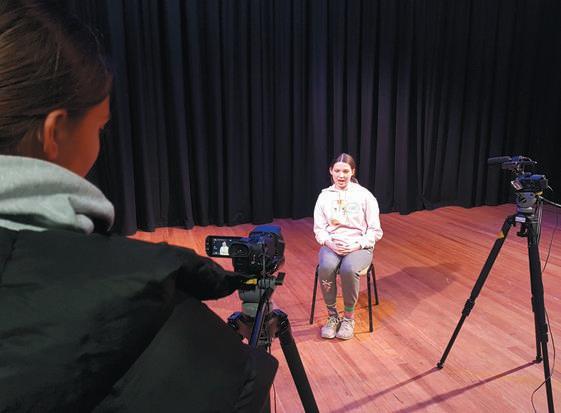
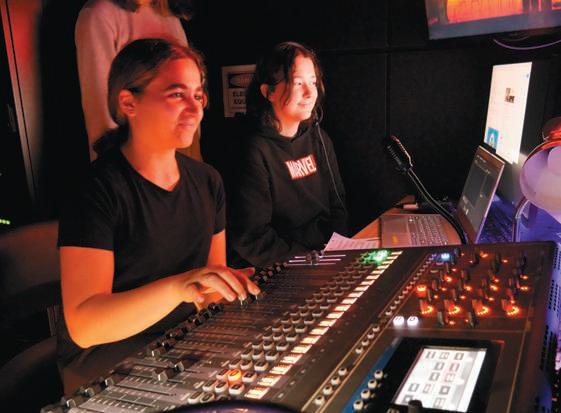
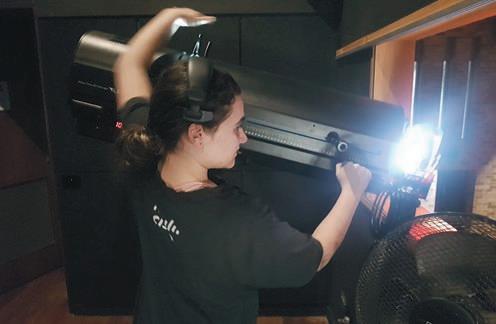
Tech Crew HQ also provides face to face training for schools, colleges, community organisations and school holiday workshops. The next scheduled workshop is at North Sydney in January. Contact techcrewhq@inspiredproductions.com.au or techcrewhq.com


how Tech Crew HQ can give your school crew the skills it needs youtu.be/SpR-qMu4GRE
Mark McDowell, the co-owner of Your Show and Costumes Without Drama, shares his tips on budgeting for a school musical.
Budgets for school musicals are usually set in stone, that is: “the same as last year”. The bean counters will tell you the maximum you can spend and that is that. Some schools see musicals as a promotion of the school, and are therefore generous in financial support and less concerned about balancing the books.
All shows have different pressures on the budget. It is a constant battle to between choosing a show that is popular and one that is tried and tested but not as known to the students. As much as you want to do a particular show for artistic reasons, you have a responsibility to aim to break even. Remember there are many reasons why shows flop on Broadway or in the West End, but mostly it’s because they are not very good. My motto is whenever possible try to break even and they will leave you alone. If you make a profit, try to spend it on something that will save you money on your next production.
If you have a principal or accountant who will try to help relieve the pressure by investing some capital money, make sure you spend it wisely. They will probably look at the big ticket hire items from last year’s show and inevitably instruct you buy 20 radio mics. This is not a good idea and will come back to bite both of you. Unless you have a trained ‘Theatre Tech’ to maintain them, they will let you down and you will end up hiring them anyway.
Also, you only use this number of mics once a year; the rest of the time they sit in the cupboard deteriorating. I’m not saying don’t buy radio mics, I’m just saying cap it at six in total.
If its lights you want to buy, then first make sure that your infrastructure can support them. Moving lights require maintenance and there is no use buying them if your lighting console can’t drive them.
Budget wise, look at each show that you are considering and check out the following details.
How many locations are in the production? Can this be done with a basic set and more lighting or props? Can I hire the set?
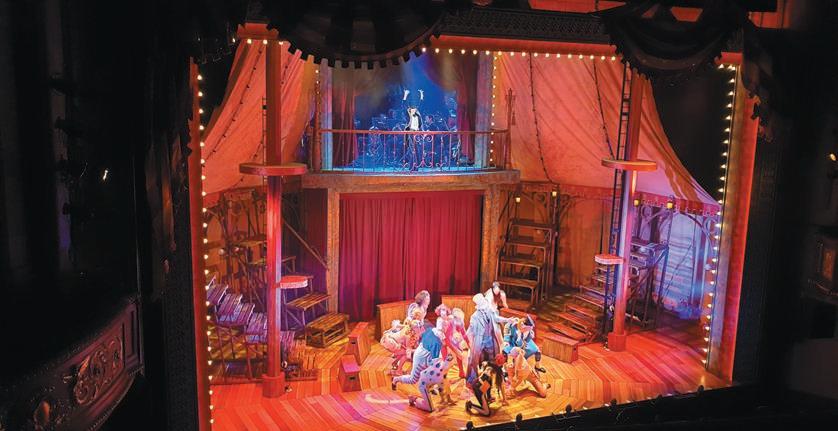
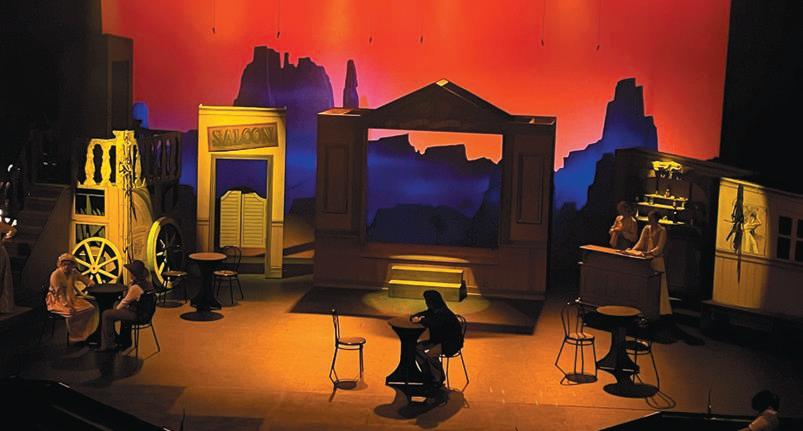

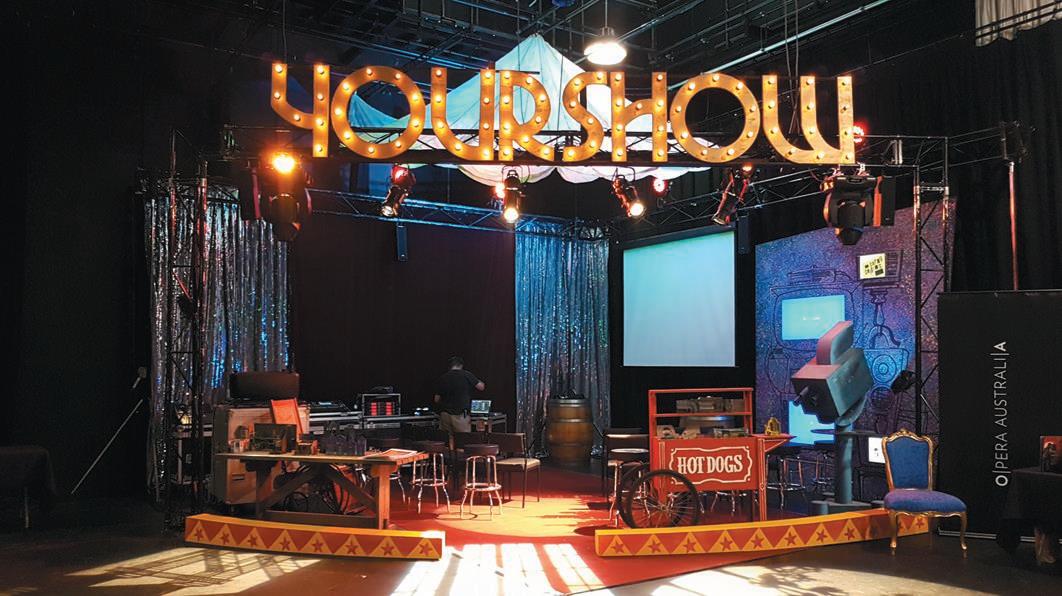
How many different sets of costumes does each cast member require? Does much need to be made or can it be hired? Can it be purchased from op shops?
How many radio mics? Can this be reduced by more swaps or using corded mics with careful choreography? Will this suit the show?
Can more students be put into the orchestra to save on hiring all professionals?
Do you need moving lights? Moving lights require extensive programming. Most schools have lots of students keen to be involved, but not on stage. Can they be follow-spot operators? Every spoken line or sung lyric in a professional musical has a follow spot on the actor.

Remember follow spots don’t need to look like a hardedge circle of light following an actor around the stage. They also don’t need to be at 100 percent intensity.
Once these questions are answered you can adjust department budgets to suit the chosen show.
Don’t worry about doing a play or musical that has been done before at your school. As long as it’s over six years ago, you will have a different cohort, and may in fact get the old cohort buying tickets to compare. You also may find that you have some resources around from the last time you produced it.
Choose wisely and remember, ‘If it breaks even or makes money, it will continue to happen’.




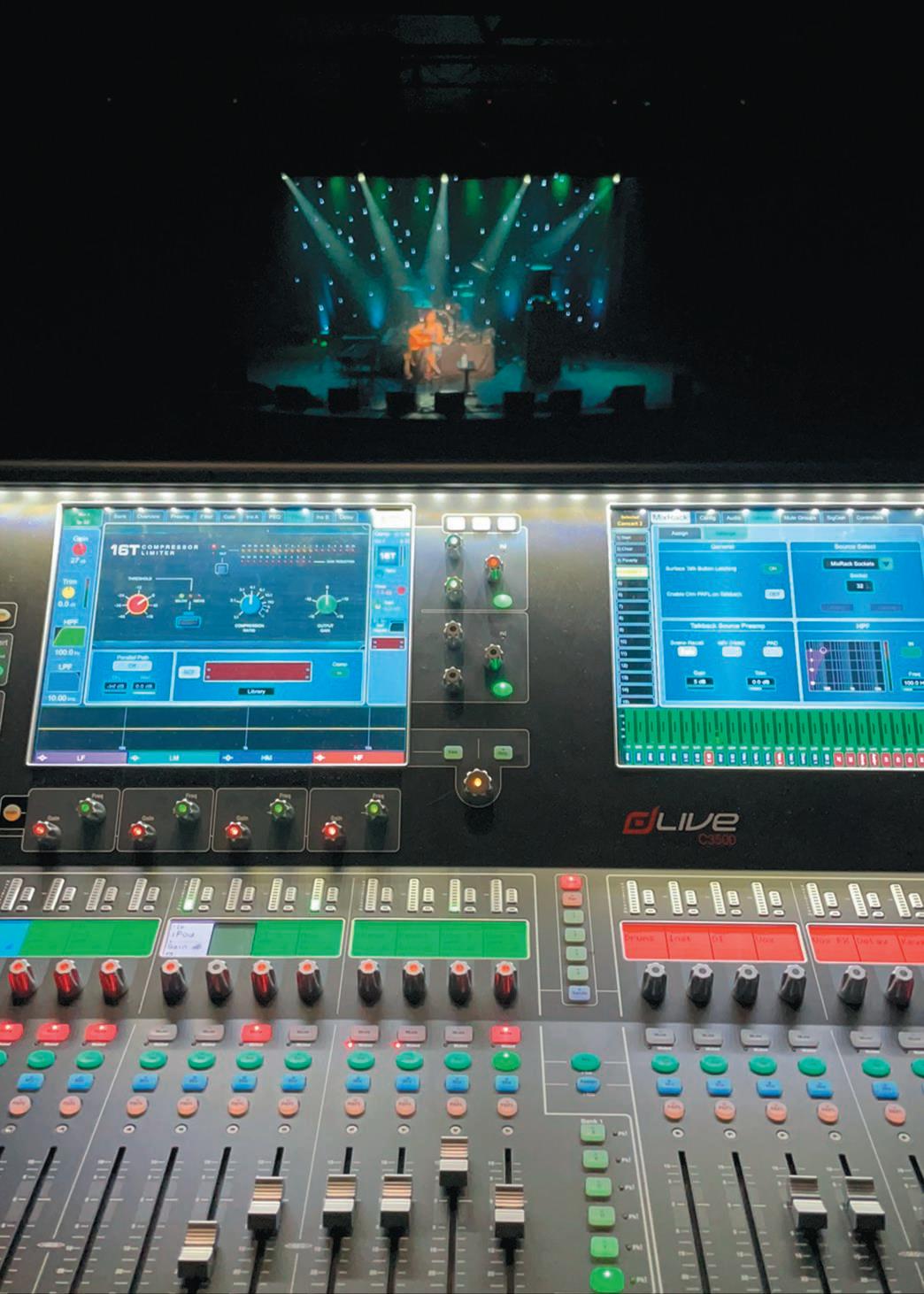
With Debora Krizak
Acclaimed performer Debora Krizak is writing a special series on the unsung heroes of live theatre. For this edition she is focussing on sound designers and operators.
When it comes to performing, that age old saying is true - “you’re only as good as your soundie”. Over many years touring the country in rock bands, major musicals and cabaret, my overall experience on stage has often been dictated by whether I can hear myself clearly - as well as my fellow actors and musicians.
It’s a delicate balance that takes great skill to get right. What the audience hears and what a performer hears are often vastly different.
Having just completed a season in Packemin’s We Will Rock You at Riverside Theatres in western Sydney, I spoke to sound designers Chris Neal (We Will Rock You/Eclipse Lighting and Sound) and David Grigg (Pippin/ Sydney Opera House).
Chris operates his own audio/visual company and has produced We Will Rock You in an arena. David - a working musician - has emerged as one of Sydney’s most in demand sound designers.
Chris says, “On stage, I’m acutely aware of the challenges performers have hearing themselves. We now have in-ear monitoring which eliminates the need for bulky fold back wedges on stage and helps to control the spill of sound from the stage to auditorium.”
In WWRY, where we had a live rock band on stage, hearing myself and being able to pitch a tune was paramount. Initially there were some challenges, but by our first preview, Chris had our voices equalised, effects were programmed and by incorporating some vocal into the side -of-stage speakers, we were able to sing comfortably, without the risk of blowing out our vocal cords.
When a performer can’t get enough volume to sing over a loud
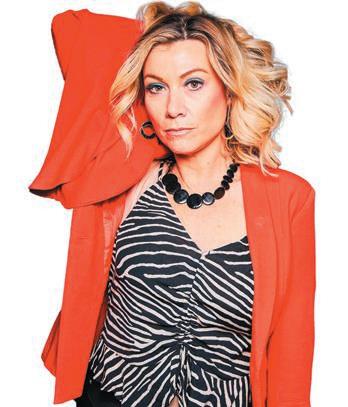
balance, it’s important to consider the positioning of the speakers in relation to the performer.
“You never want speakers positioned behind a performer. If we have the capacity to place a lot of speakers throughout the theatre at a low volume, we can achieve the same natural aesthetic without losing any energy or clarity.”
Often this must happen in careful negotiation with directors and choreographers, as speaker positioning can impact sightlines. Audiences need to see the performers from every angle and no choreographer wants to set a ten minute tap routine where feet are obscured. So, who and what wins out in the end?
band or orchestra the audience notices big time.
In a rock band, this is commonly overcome with the use of on-stage fold back monitors and a corded or cordless handheld mic. The performer can directly hear themselves in the foldback wedge and the sound engineer has control of the volume of the monitor. In-ear monitors are an added technical innovation as the singer can control the exact mix of voice and instruments they require in their fold back.
While the consensus is that they’re great, I’ve never been a fan of in-ear monitors as they create a slightly more superficial environment. There is something about being connected to the audience, and being able to hear what is happening around me.
“Not everybody understands the craft of what we do as sound designers - they just expect the end result to be good,” says Chris Neal. He adds that to achieve the right sound
“It’s a negotiation process between us all and ultimately we have to decide what’s best for the show,” states Chris.
I’d love to be a fly on the curtain for that debate, however Chris and I do agree on amplification. Too often I see a musical and the first thing that lets it down is the sound balance.
Different styles of musicals can require more conservative sound mixing but I still like to hear the singers ringing straight through the middle of a swelling orchestra. Perhaps it’s the former rock chick in me.
A musical requires designing a system for amplifying a live orchestra or band, usually in an orchestra pit beneath the stage, with live vocals from the cast moving around a stage.
David adds that this means every instrument has one or multiple microphones positioned in front of them, and each cast member has a wireless microphone positioned on (Continued on page 106)
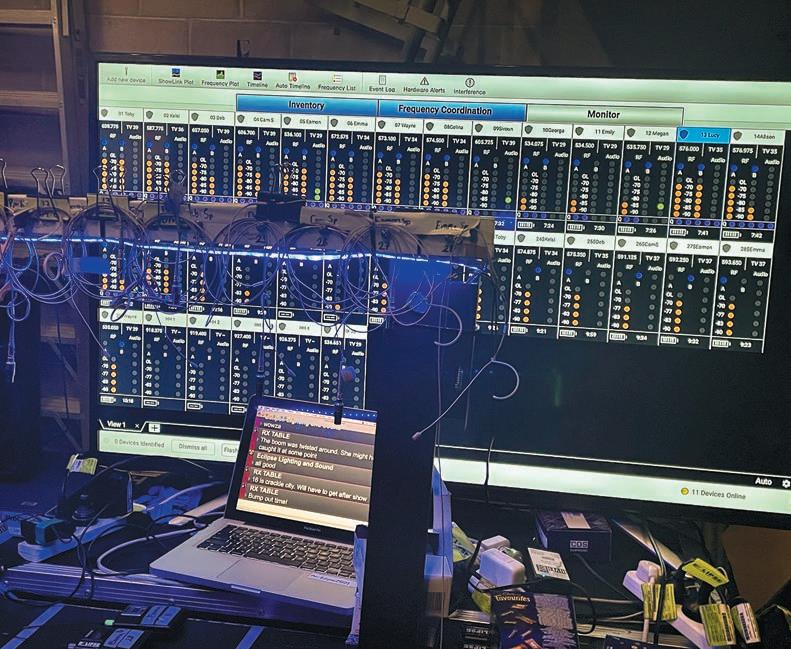
technicians that there’s a problem with a particular mic.
same time, you also want to avoid feedback which is caused by amplifying microphones too loudly into poorly positioned speakers. Once you have that designed, next comes the creativity of vocal and music effects, triggered sound effects, and programming.”
David recently made the transition from musicals to straight theatre which he says requires more creativity. There are no live instruments, so most of the design is in the sourcing of music, atmospheres and sound effects that help support the storyline. With a play the sound bed is pre-recorded or pre-programmed. The potential for error or last-minute changes is real.
“During the final rehearsals you may have to record sounds, shorten a piece of transition music, or even change the location of a scene. All of these are time consuming, and you become particularly good at letting your creations go if things get cut.”
their head somewhere. Whereas a live band may use a handheld mic, theatre performers have radio microphones carefully positioned in wigs at the top of the hairline or what’s referred to as a ‘Madonna mic’ at the side of the mouth.
Often there are several mics for each lead performer in case one becomes redundant (malfunctions) due to sweat, loss of battery or even physical damage. When this happens it’s the sound operator’s job to switch mics and communicate to mic

During my stint in Cabaret, we lost microphones in the thick of the show on opening night. With many sound desks now being digital, it can take time to reboot. In this case they stopped the show. The lead performers left the stage, to pick up where they left off ten minutes later.
David adds that there are plenty of other challenges that sound designers face.
“You’re trying to get the show sounding the same from every seat in the theatre, with the music having plenty of impact, yet having clear and easy to understand vocals. At the
Well, getting “cut” goes hand in hand with our profession. It’s good to know that putting yourself out there doesn’t just resonate with performers.
“Sound is incredibly personal. You have got to have a thick skin. What one person says sounds fantastic, another may say is too loud. Achieving optimal sound balance is ultimately a collaborative effort and it’s our job to manage all of that. When a show settles and everyone is working at their peak, that’s when we achieve the perfect balance.” said Chris Neal.
What’s it like working with stage and musical performers?
“For the most part it’s a joy. You’re working with passionate people to achieve their vision and when you have mutual trust, it’s an absolute ball.”
Any advice for up-and-coming soundies?
David: “Networking. Say hello to everyone and be a good energy to be around. Get to know everyone you work with and be kind because I promise you, you will see them again.”
Chris: “Get yourself involved in live theatre. Find a theatre group - watch, help get involved. Break down the things you like and don’t like. Watch and learn.”
Most valuable personality trait?
David: “Patience. Remember you’re making art. Art takes time and patience.”

Artie Jones from Factory Sound estimates that more than a quarter of a million disposable batteries could end up in landfill after being used in productions each year in Australia. He says there is a better alternative.
When it comes to the best way to power your wireless systems - alkaline battery or rechargeable - there are many factors to consider. The saying “Less is More” is the key.
A wireless microphone system that’s used for three performances, then put back in the cupboard until next year, equates to fewer performances, but a greater risk of battery leakage inside the wireless transmitter.
The risk of battery leakage from a nickel metal hydride (NiMH) rechargeable battery, however, is negligible, even if left inside a device for a prolonged period.
How much landfill is acceptable?
Let’s imagine a typical user of wireless microphones - the annual school production. A small-tomedium sized production, with a handful of shows and a couple of tech rehearsals, could consume 140 batteries for a production.
There are around 8000 schools in Australia. If just 15% of these attempt an annual production, 168,000 batteries would be used. Add to that a few end-of-year concerts, and it would be a very conservative estimate of 250,000 batteries heading to landfill annually.
This figure doesn’t include amateur theatre, professional
productions, theatre restaurants, nor the thousands of bands that use the same wireless systems and in-earmonitoring systems.
Brand-specific rechargeable batteries
If you are the person responsible for wireless microphones, the very first thing you’ll notice is how quickly alkaline (single use) AA batteries disappear. It might be because the AA batteries have been ‘borrowed’ by students and co-workers, as they fit a variety of other devices.
Generic rechargeable AA batteries offer the ‘double-whammy’ of not only being desirable to the borrower, they also may not deliver the (approximately) 1.2V per cell consistently throughout the charged state.
Once your battery level drops, although the wireless will remain on, the actual RF performance - the quality of the wireless transmissionwill suffer greatly, leading to dropouts and possible interference.
With single-use alkaline batteries giving us a landfill concern, and generic rechargeable batteries possibly not performing ‘up to scratch’ , there are great reasons to choose a wireless-specific rechargeable (such as BA2015 for Sennheiser, or SB900A for Shure).
For all your wireless microphone system needs (including spare batteries) get in touch with the friendly staff at Factory Sound at factorysound.com or on 1800 816 244.

If you load your BA2015 into the Sennheiser bodypack, then drop it into the L2015 charger after the gig, it simply will not over-charge. Similarly, if you put the bodypack into the charger without the correct BA2015 battery in place, it won’t charge. The safety nets are in place to ensure there is no danger of damage.
With a lifecycle of around 1000 discharge / charge cycles, using the correct NiMH rechargeable battery pack in the wireless transmitter, the battery is highly likely to last for the same number of performances as the wireless itself. Because they’re a unique shape, they are unlikely to be borrowed as well.
Smart RF (wireless) technicians keep a spare rechargeable battery for each wireless device, and they will also find a way to document the life of each battery. Get ready to buy another one after around 800 charges.
If all theatres and performance venues around the world approach battery usage the same way, imagine how much less landfill we would contribute each and every year.

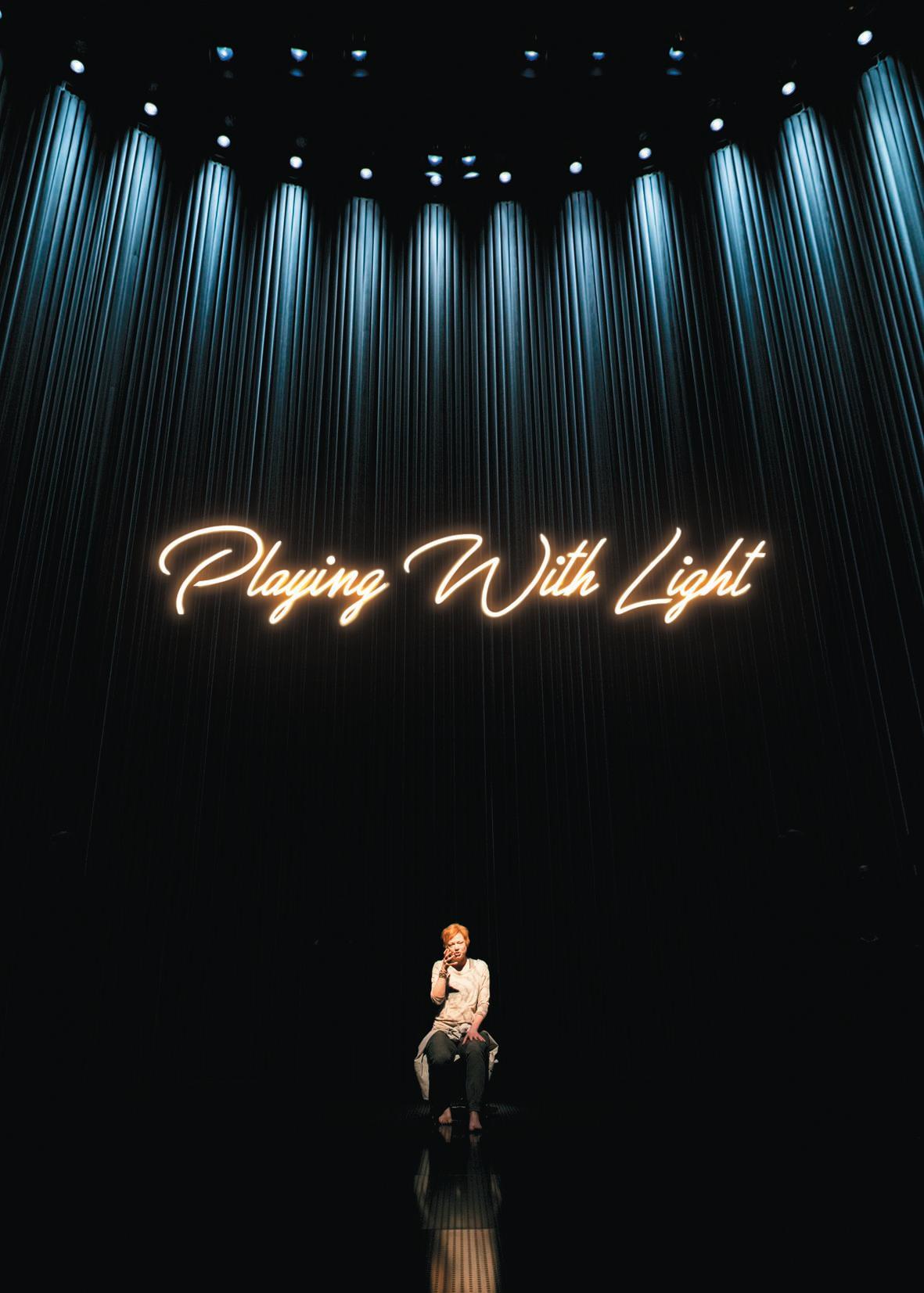
Multi-award-winning Nick Schlieper talks to Martin Portus about the rigour and magic of lighting our landmark operas, plays and dance works for four decades.
Nineteen-year-old Nick Schlieper first plugged into his craft alone backstage at Doris Fitton’s old Independent Theatre in North Sydney in 1977.
It was a time in Australian theatre when the lighting guy was usually one of the mechs. Nick was the Independent’s resident stage manager; restless, he began experimenting every night during the show by shifting around the lights. Actors learnt to just work around it.
Schlieper has been playing with light ever since, earning - and demanding - a respect for the precision, invention and storytelling role of his craft, and his very distinctive signature in lights.
It’s no surprise that painters are his first inspiration - think Turner and Edward Hopper and Nick’s own late brother. Michael Schlieper, Nick’s senior by 11 years, would work on his canvases through the night at the family home in Chatswood. Every morning, getting ready for school, Nick would observe the added layers, the depths appearing from new light and colours.
“I think I learnt most about lighting design and light from that exposure, watching him painting and then, growing up, talking to him about it, and watching his style change radically over a few decades,” says Nick.
“He started out as a wildly abstract painter, went through a very figurative, so-called Teutonic, social commentary period and then ended up painting landscapes but with a great facility for technique, which I learnt from him.”
Nick’s start in stage management also added a practical insight into the logistics of theatre - and the required diplomacy. He was soon responsible for casts and crews far older than he, calling shows, later operas, with the big companies in Sydney, Brisbane and Adelaide. Finally as a production manager, young Schlieper always had work …until, that is, he put out his shingle as a freelance lighting designer.
The jobs were few but, somehow, he scored the lighting gig on the STC’s Summer of the Seventh Doll and
Away, both of which went to New York in 1988. He remembers Roger Kemp’s three model houses signifying the three families intersecting in Away.
“It was played in tight areas and was the first time I had to create a naturalistic pool of light in an abstracted stylised space yet evoking a sense of place. And I approached it from an incredibly simple point of view - of standing under a light bulb, but expanded.”
German director Harald Clemen commissioned Nick to light a show at the prestigious Schillertheater/ Berlin just before the Wall came down,
angles, very cold light, all things very unfashionable then.”
Home he may be, but Nick was also staggered at the absence in Germany of expressive techniques in lighting design. Images of German theatre may look stunning, but the lighting was fixed.
The idea of leading the audience’s eye, lighting the actor and expanding on the emotion was becoming essential to Nick’s story-telling toolkit back in Australia but, then at least, it was foreign in Germany.
“Germans called it dramaturgical lighting, and actors even said to me that they resented me doing their job
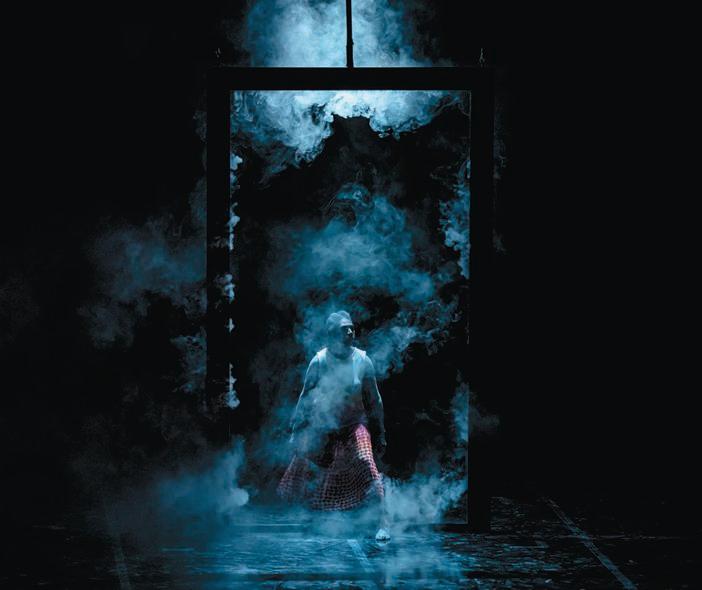
which was, he says, like “dancing on a volcano “ with the arts integral to everyone’s fervent conversation, and part of the arsenal between East and West.
“And at the theatres I suddenly understood where my aesthetic had come from - it was like coming home,” says Nick, whose family immigrated from Germany.
“In Australia I was jokingly criticised for my work being very Teutonic, very stark, without much colour. I spent a lot of time making people look right, not nice - which is not the same thing. I do use very steep
for them. It was best to do it under fluoros and with the house lights on! It was a Brechtian hangover.”
Times have changed. Nick went on to work regularly across Germany, and notably at the Salzburg Festival: he’s just returned from there, lighting a brilliantly urbane contemporary version of Médée. For more than a decade he’s taught lighting design in Munich and he went on to see WAAPA in Perth establish Australia’s one major lighting course.
But ‘dramaturgical’ remains his best descriptor. He rejects all jobs
(Continued on page 110)

(Continued from page 109)
unless he’s included from the start in that first collaborative planning with the director and other designers. He reads the script or score over and over again and, he says, he eschews tricks and focuses his lights only on advancing the meaning of the work.
“We start with that simple question - why are we doing this work? It’s all the more vital a question when it’s a classic. I’ve done five productions of Macbeth; if you don’t ask why you’re doing it here at this
time and place, then they’d all look the same. And once you answer that question, you find the environment in which you’ll do it.”
All this was well tested when Nick and his frequent collaborators, director Elke Neidhardt, and set and costume designers Michael Scott Mitchell and Stephen Curtis, started planning what was Australia’s first full production of Wagner’s Ring Cycle. It was premiered by the modest sized State Opera Company of SA in 2004, but years earlier Nick was getting his head around a score lasting 16 and a
half hours.
And it was all the harder, given his block about Wagner, one he suggests is common in many Germans.
“It just makes me very uncomfortable, to the base of my spine, since it’s so laden with his vile thoughts…. so learning what I find fairly repugnant music was a challenge.”
Still, five years out, he joined the creative team, all of them leaving behind their phones and locking themselves away in a Blue Mountains retreat.
“But at the end of that week at “Camp Wagner”, we’d only got as far as the first five minutes of the first opera, and most of that was the prelude!
“Still, all that time we were addressing the whole framework with the same question - why are we doing this work yet again and why in Adelaide?”
This landmark Ring had massive, strikingly lit set pieces, but here again for the lighting designer the priority was story-telling, of not losing sight of the human stories over time.
“We always made sure that after fabulous visuals we came back to a permeable box with no scenery in it, just lots of light and that light in those interludes, even more than usual, with
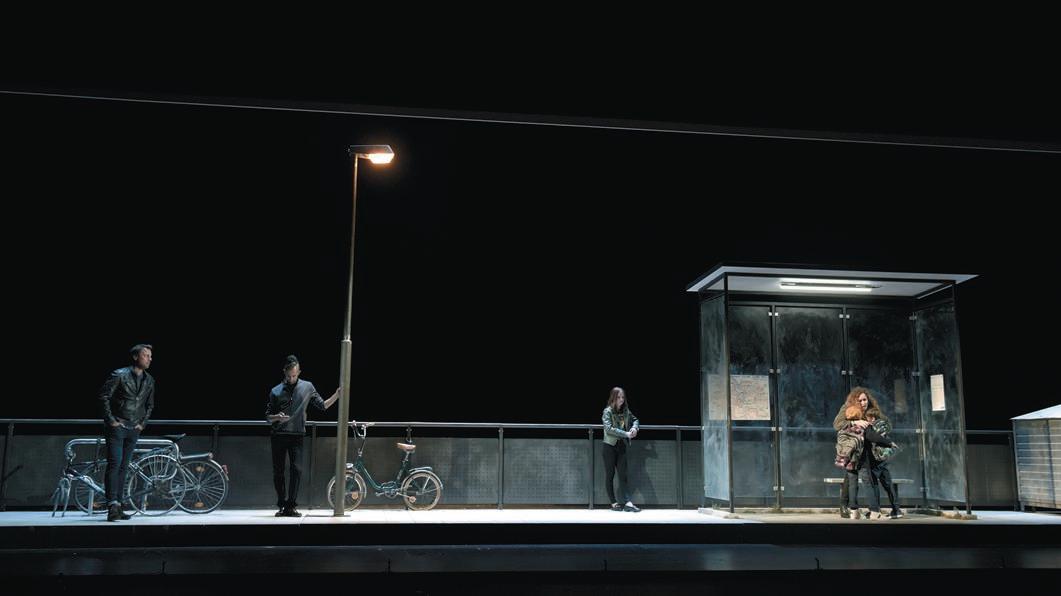
a focus all about the singers.”
With a set that filled 38 shipping containers (an average opera may fill three) and a lighting rig with a thousand lamps, this was the biggest theatre show ever staged in the country. Oddly for the celebrated designers, the job offers then dried up.
“You’re so easily pigeon-holed by this industry. I think we were branded as, they only do huge now!”
Nick however did join another trusted collaborator, director Simon Phillips, in 2006 to create the stage version of the film hit, Priscilla, Queen of the Desert.
“I’m not drawn to musicals but I was keen to get over my prejudice that they’re all flash and giggle and not much craft.”
With a colour palette beginning with hot pink, he was also repainting his reputation as a master of stark white light. Nick’s starting point with Priscilla was that every scene have the sparkle, the heightened colours, as though viewed through the lens of a drag show - just like back then at the famed Imperial Hotel in Newtown,
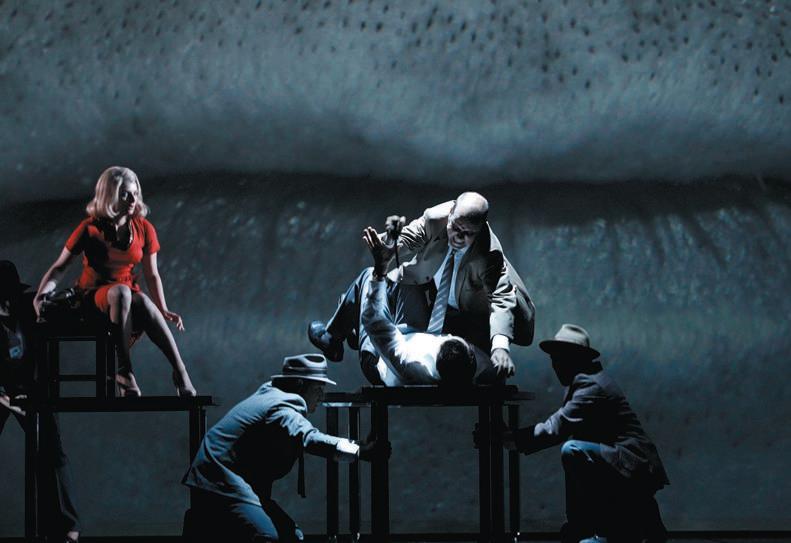
Sydney. He admits that the lighting took a leap elsewhere, especially with the introduction of Brian Thomson’s magically inventive bus and a huge tech budget. And Nick finished up with a lighting plot of 2,500 cues.
The arc of Nick Schlieper’s career has seen an ever-growing respectfrom audiences, critics and industry colleagues - for the craft of a lighting
designer, and an astonishing shift in the technology at their fingertips.
“I’ve seen manually operated desks replaced by computer boards; football -sized globes replaced by ones golfball -sized; and colour temperature and heat emissions have changed so much we can have an expanded palette of
(Continued on page 112)
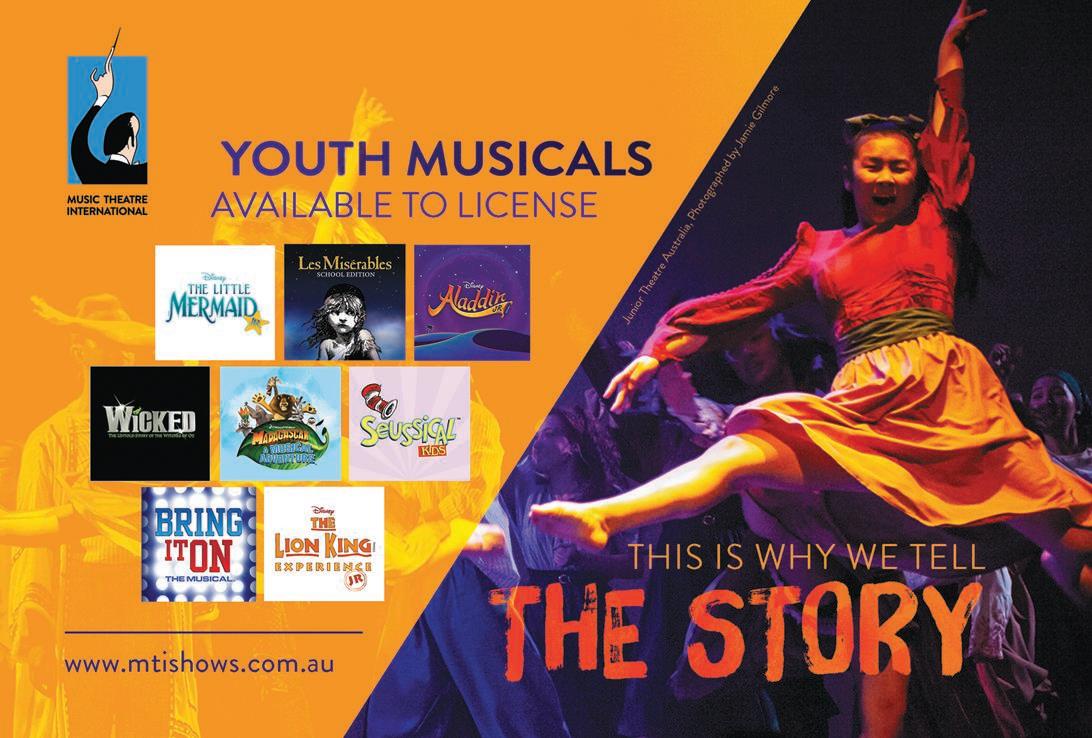
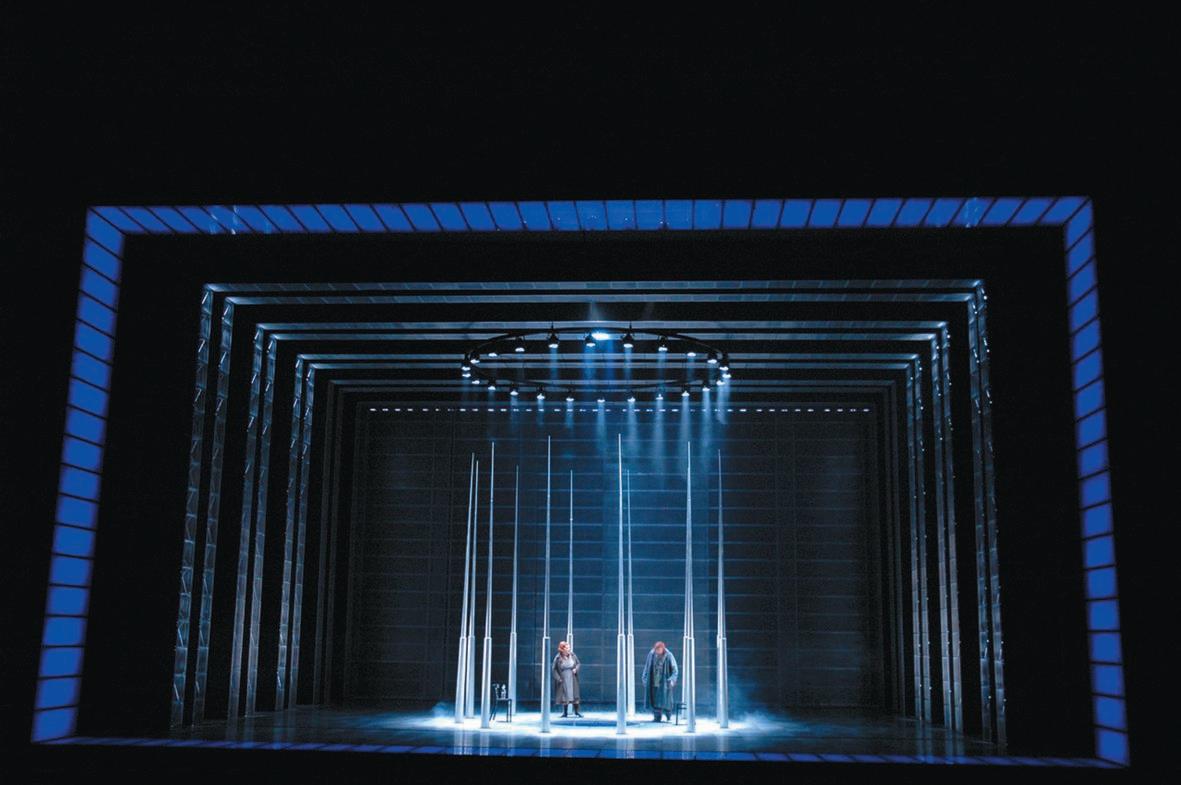
(Continued from page 111)
colour gels. And importantly we can now have a whiter, less yellow light.
“At first with computers doing a lighting fade we missed the skill of a good operator, but now these have a control which is incredibly sensitive. You can virtually move a host of lights throughout a show without the audience being aware of what you’re doing.”
A negative for Nick is LED technology. He argues it reduces the colour ring spectrum to just 70%; with the missing 30% so critical because that’s the light most sympathetic to skin tones, to lighting the actors and telling the story.
It didn’t stop him, however, employing a huge back wall of white light in the STC’s Cat on a Hot Tin Roof. The lighting bank initially simmered and then blasted direct into the audience, suggesting the fireworks - and raw emotions - that climaxed at the end of the play.
Nick has the perfect collaborator in STC artistic director Kip Williams, whose own stage signature often
Nick Schlieper spoke to Martin Portus for a State Library of NSW oral history project on leaders in the performing arts; the full interview is now available on amplify.gov.au
strips everything to an empty space, often with a revolve, defined with little set or clutter, and so often dramatised by cross lighting.
Their recent credits also include Chinamerica, with its complex storytelling across countries and decades; the epic dramatisation of Ruth Park’s Harp in the South; Brecht’s Arturo Uri with Hugo Weaving; White’s ghoulishly vaudevillian A Cheery Soul; and Shaw’s St Joan. He just finished lighting Simon Phillips’ STC production of Stoppard’s The Real Thing
He remains a big fan of white light and cross-lighting, and his reasoning, of course, comes back to what’s true to the performers.
“It solves the age-old problem of people standing next to each other talking as we do in real life, by lighting along the axis they’re speaking to each other.
“And it gives such a sculptural
impact to dancers. It makes bodies look fantastic and faces so much more interesting and more present.”
Nick has lit six notable shows by Bangarra. With Patyegarang and the most recent, Bennelong, he’s lit Stephen Page’s significant shift to a dance theatre storytelling involving points of view both indigenous and colonial.
“In terms of the practical, it’s about being very careful about colour and choosing the optimum angle for dancers … but with the episodic story of Bennelong I also had to be wary about leaving the audience with a clear dramatic structure.”
He’s getting over being what he describes as “the whitest thing possible in that context, yes Aryan even!
“It’s a very useful reminder - as if it’s needed - of how strongly you can feel being the ‘other’, and useful to have the boot on the other foot.”
Sydney based audio company Loud and Clear and the Hornsby Musical Society have marked a unique milestone 50 “unforgettable productions together”.
The company’s owner and founder, David Betterridge, reminisced about what he described as the rich history, friendships, and enduring magic that can only come from decades of collaboration.
The partnership began in 1995 with a production of Les Misérables, where Betterridge recalls enduring freezing winter temperatures and the challenges of a vast cathedral-like auditorium.
“We achieved something extraordinary. Mixing the show sometimes in fingerless gloves.
“It was a huge success and the first of many Les Mis seasons I would mix. I counted 88 performances before I went mad.”
That show sparked a relationship with Hornsby that has only grown stronger, with countless show
memories, and a shared dedication to theatrical excellence.
Loud and Clear’s journey has seen the company grow from a passion project to a fully-fledged operation with a team of over 40 and equipment valued at over $3 million dollars.
The company also recently celebrating their 1300th show.
As the audience gathered for Hornsby’s evening performance of Urinetown, Loud and Clear’s founder presented a commemorative memento to the company.
What resonated in his speech was a love for the craft and the community that has supported it for nearly three decades.
Amusingly, he noted the connection between Les Misérables and Urinetown. “The only thing I
For professional advice for your next event or project call (02) 9439 9723 or visit loudandclear.com.au
could find that links Les Mis to Urinetown is sewers. And revolution of course.”
For Hornsby Musical Society and Loud and Clear Audio, this milestone symbolises not just the past 50 shows, but also so many more they will continue to create together.
Here’s to a future filled with more remarkable productions, unforgettable memories, and the sounds of success!
Koren Beale
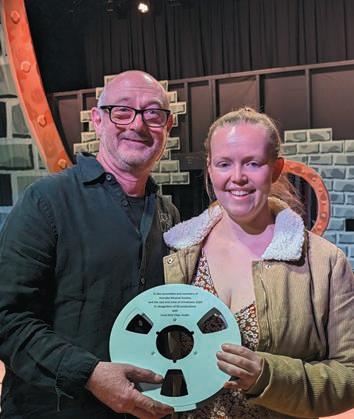

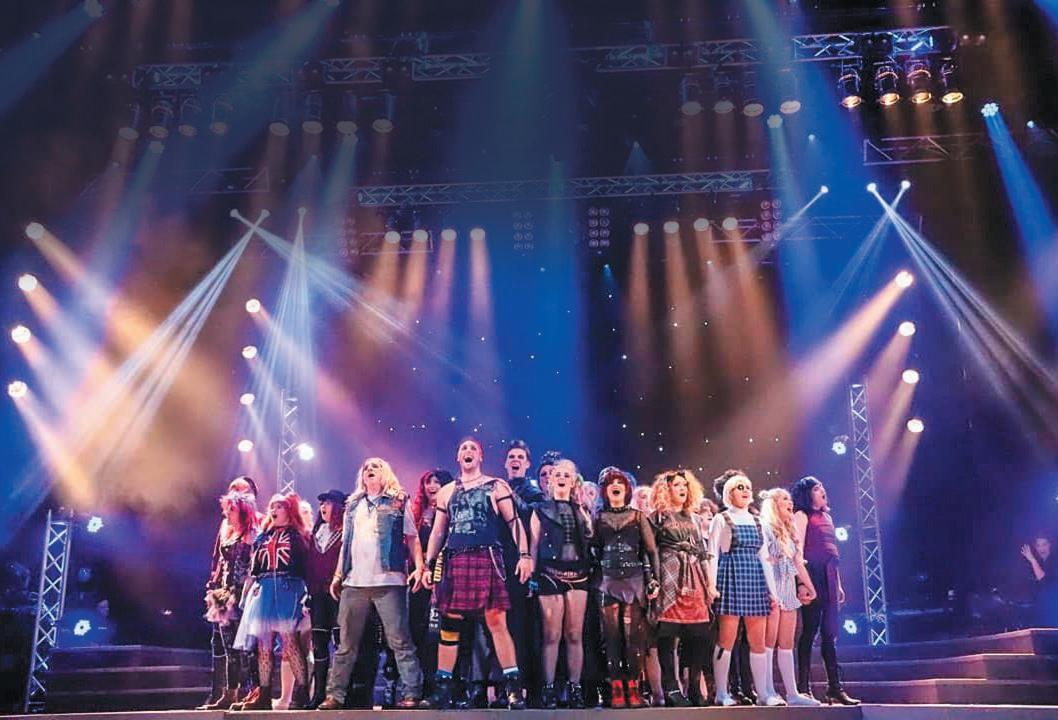
Jason Bovaird from Moving Light Productions and Daniel Jow designed the lighting for We Will Rock You, staged by Centrestage Productions in Geelong, using 800 lighting and vision cues in a combination of state of the art and old school rock lighting. Jason explains how they achieved this combination.
My first question to the production team was whether they wanted to replicate the professional production or do something new.
The director Paul Watson created a wonderful new set design that evoked the feeling of Wembley Stadium. It comprised a semi-circular row of seats that gave the feeling of the last remains of the stadium. This allowed us to have four 3-metre lengths of hanging truss to create the feeling of light towers. These pieces of truss had ray-cans hanging off them to also create the old school rock feel that Queen had in its earlier days.
I wanted to add a design element to the rig that had never been used before in a musical of this size and researched ways to incorporate revolving truss and moving lights. The problem was that most of the revolving
trusses were way too big or only moved at one speed.
After months of investigation I found the perfect design from a company in Melbourne - Lighting Lab. The company had been testing a prototype from China - 1.5 metres in diameter with variable DMX speeds. It was perfect for the show, given that it required a “laser cage” to rotate regularly.
We put 230 beam “sharpies” on the truss as they would give a strong thin beam like a laser and also had some great gobos that would be used for many other scenes.
The most impressive moment that the truss was used for was the opening scene when director Paul Watson wanted to create the feeling of the cast member being chased by helicopters. This moment had the rotating truss
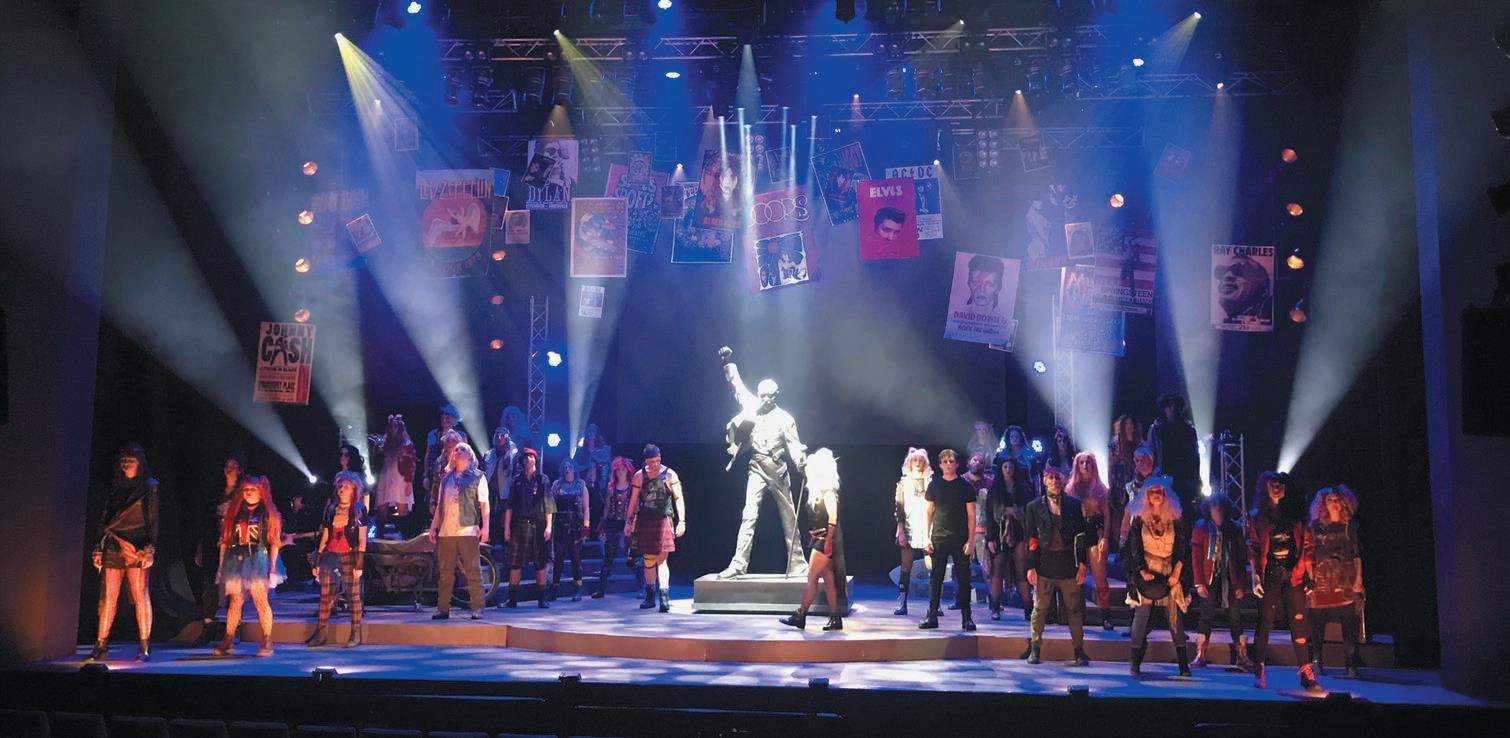
revolving fast, with the sharpies in an open white to create the feeling of helicopter blades rotating.
A show of this size - with over 800 lighting and vison cues over 60 moving lights along with 150 generic fixtures - cannot be plotted in a normal production week due to the time in the theatre and the experience of the cast and crew.
It was decided to pre-visualise the show in a vison suite a week beforehand. Moving Light Productions engaged the services of Nathan Aveling from Starlight Productions and their factory. Nathan spent two weeks drawing up the scaled venue plan. He then created the lighting design in Vectorworks, which allowed the creative team to sit in virtual mode and begin plotting the cues of the show.
Being able to design the show in the visualisation suite with the director allowed us to be able to spend extra time on each of the cues and get the show almost perfect before we bumped into the theatre. This allowed us to spend more time
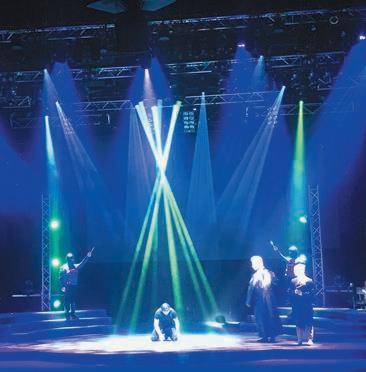
Jason spent time in London having taken over Lighting Design of the hit West End show Peter Pan Goes Wrong, produced by Lunchbox Theatrical Productions. His team also designed the lighting for Melbourne Luna Park’s “Luna Dark” Halloween event. movinglightmlp.com.au
incorporating three LED screens: two thin 4-metre LED screens and a centre 8 metre x 4 metre large central screen into the production.
These screens provided all the story -telling content, ranging from “live feeds” through to moving images, still images and text. The screens were able to provide wonderful images during the show that also added the extra design element.
Putting all this together created powerful imagery that allowed the creative team to provide the audience with a strong, visually entertaining production.
Technical details: The story has an element of the old world and new world of Rock and Roll which needed to be shown through the use of parcans, moving lights, LED cans and lasers. The lighting rig consisted of 24 x Bumble Bee 330 spots, 12 x 230 Beam Sharpies, 12 x 60 watt LED Profiles, 30 x 8 watt LED Cans, 64 x Par VNSP Cans, 15 x 1500 watt Blinders, and 12 x Ray Cans.

Artie Jones from Factory Sound shares his tips for trouble-free use of wireless microphones.
No matter how big or small the stage may be, wireless microphones are the essential first ingredient to help bring an intimate and detailed sound to the audience.
A well-designed system will always make the complex appear simple, and reputable wireless manufacturers have done huge amounts of ‘heavy lifting’ to make the set-up of a clear channel as easy as touching a button (or two).
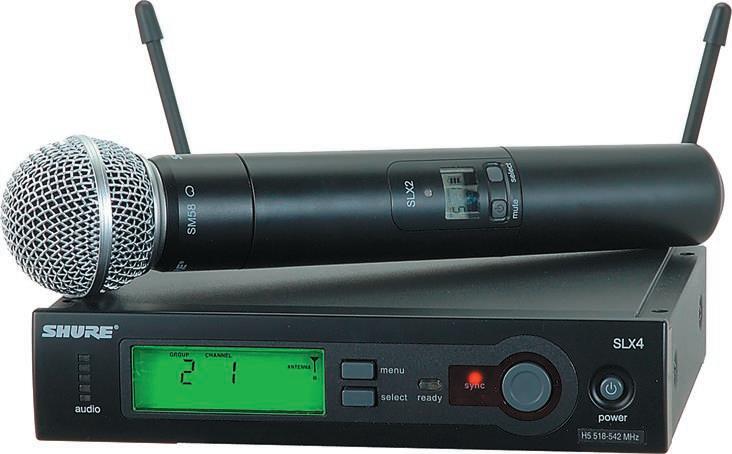
There’s nothing worse than an unexpected ‘drop out’ of the wireless signal. It leaves the audience disappointed, while often proving to be unsettling for the performers.
For inexperienced operators, there is nothing surprising about wireless interference and drop-outs, if the golden rules of wireless tech haven’t been followed before every show.
Rule #1 - Scan, Scan, Scan
It is the most basic rule to follow, and it costs nothing!
With the maturing of wireless microphone technology over the past decade, the process is simple. It involves pressing a button on the wireless receiver (which will normally be placed at side of stage, or at the mixing desk position), allowing it to find the most clear frequency available. Then you simply sync the wireless microphone (or bodypack) to the same frequency, and voila, the system is ready for soundcheck, and the show.
The number one cause of wireless interference is failure to follow Rule #1. It doesn’t matter if the wireless system, or systems (more on that later) worked perfectly when you first pulled them out of the box, the fact remains that a scan will be the best way to avoid any problems.
Sophisticated productions usually involve more than just one wireless system, which introduces a whole range of potential Radio Frequency (RF) concerns.
Adhering to Rule #1 when you are dealing with many wireless systems will involve a little more concentration, and large-scale set ups will usually involve a laptop with some kind of Wireless System Manager on-board, to assist with frequency scanning, channel allocation, and monitoring of RF integrity.

Factory Sound can keep up to date with all of the latest in pro audio gear. youtube.com/FactorySound
An unfortunate side-effect of having multiple channels of RF running concurrently for a performance is that not only will the active channels have their own frequency signature taking up space in the RF spectrum, but extra nodes in between those frequencies will appear - kind of like a reflection - and this effect of intermodulation will cause, in some cases, interference to your wireless channels.
Reducing the amount of antennas around the stage area will actually decrease the amount of intermodulation, and so a well-designed Antenna Splitter is a great way to maximise the efficiency and effectiveness of any multichannel wireless system.
Are you using the right cable for antennas? (50ohm, not 75ohm). Are the antennas in the right position? Can you select frequencies for your area that actually minimise the amount of intermodulation?
Managing wireless microphones can seem complicated, but really, follow Rule #1 and follow it often, and when it’s time to expand or refine your system, get in touch with RF specialists for advice.
Oh, and fresh batteries for every show!
Factory Sound is Australia’s largest supplier of professional audio equipment. For sales or hire please visit factorysound.com, email sales@factorysound.com, call 1800 816 244 or stop by their showroom located at 75-85 York Street, South Melbourne.
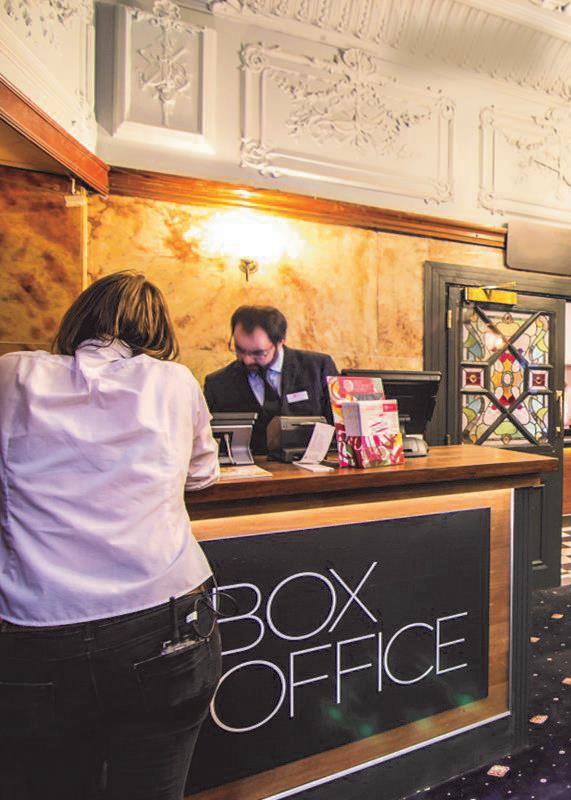

Jeff McAlister explains how the company has introduced new features to serve local theatre productions.
TryBooking, a trusted partner for local theatres across Australia, has a longstanding history of supporting the performing arts community with affordable and accessible ticketing solutions.
TryBooking offers a transparent pricing structure, of a low 50c ticket fee and a 2.5% processing fee, and an array of features tailored to meet the unique needs of theatre venues. These include:
Flexible Seating Plans: TryBooking’s seating plan options cater to any venue configuration, whether you have a dress circle, a mezzanine, cabaret-style seating or a combination of them. Our platform allows for customers to choose the seats most suitable for them to have the best experience possible.
Access Codes: A new feature on the platform is passwordprotected events for presale access, allowing members to book their preferred seats before tickets go live to the public. If you have any season ticket holders, they can reserve their special seats using custom passwords, adding a
personal touch to their theatre experience.
Gift Certificates: A valuable tool for boosting revenue, TryBooking allows theatres to create and sell gift certificates directly through their websites. These certificates can be redeemed only for the company’s future TryBooking events. This is a flexible alternative to promotion codes for sponsors, special offers, and even as a refund option.
Box Office Solutions: TryBooking’s box office solutions offer two convenient options. New is our Box Office App that allows staff to accept in-person payments via phone or tablet, sending receipts
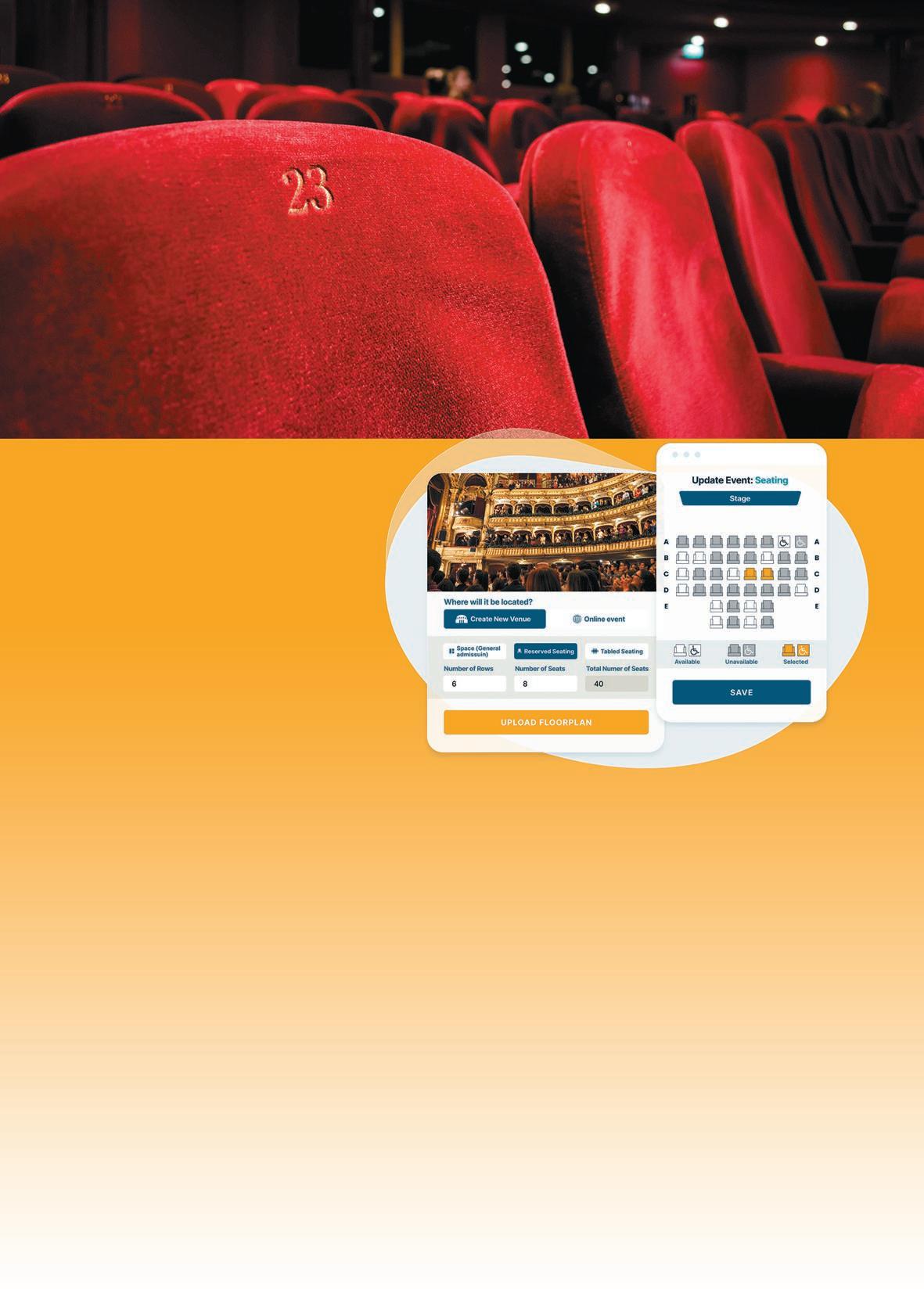
and tickets electronically for a paperless experience. Alternatively, our Box Office Web works on any device, and can be paired with a terminal to print tickets on-site. Both solutions integrate seamlessly with TryBooking’s Scanning App, providing centralised reporting across all sales, including merchandise, food, and drinks.
TryBooking’s Australian-based support team is readily available to assist theatres to set up their ticketing services, ensuring a smooth and efficient process from start to finish. As a company committed to the arts, TryBooking continues to innovate and provide the tools necessary for theatres to thrive.
See more listings online at bit.ly/2n4aqnu
356Tix
365Tix is an Australian-owned online ticket agency for shows, events and workshops. 365tix works 365 days a year to provide customer service from 9am-9pm.
You can choose pick-off-the-plan seating, promo code discounts, merchandise sales, flexible terms of classes and more. There are no lock in contracts or set up fees. 365tix provides clients with free online marketing support which includes access to our own extensive database of customers. Contact Eloise O’Toole for information.
+61 4 0016 1125
+61 7 3266 9885 manager@365tix.com.au 365tix.com.au
TicketHost


Sell your event tickets online, great value, exceptional service. Reclaim your life and let TicketHost handle the ticket sales for your event. Just register your event details and they will have your online box office up and running in minutes. Their ultra-low fees mean you won't find a more cost-effective option. TicketHost suits all event types from School Productions and Theatre Companies to Sporting Events and Business Conferences.
+61 3 9011 3221 info@tickethost.com.au tickethost.com.au
TryBooking
TryBooking has been the trusted partner of thousands of community event organisers across Australia. Our experience and expertise are at your disposal to assist in creating and growing your next community event.

TryBooking offers a low simple pricing, no tiers that reduce your features, no ticket limits, no hidden costs, no lock in contracts. Simply low-cost pricing to help you run your community events. All our customers have access to ongoing support via email, phone, and live chat.
trybooking.com.au

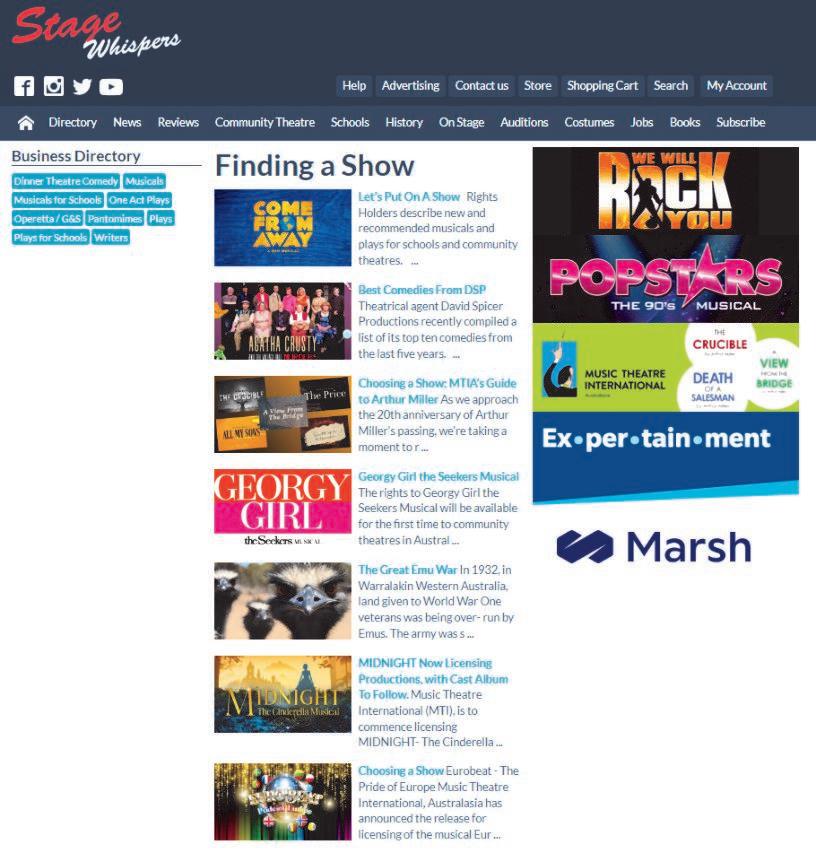
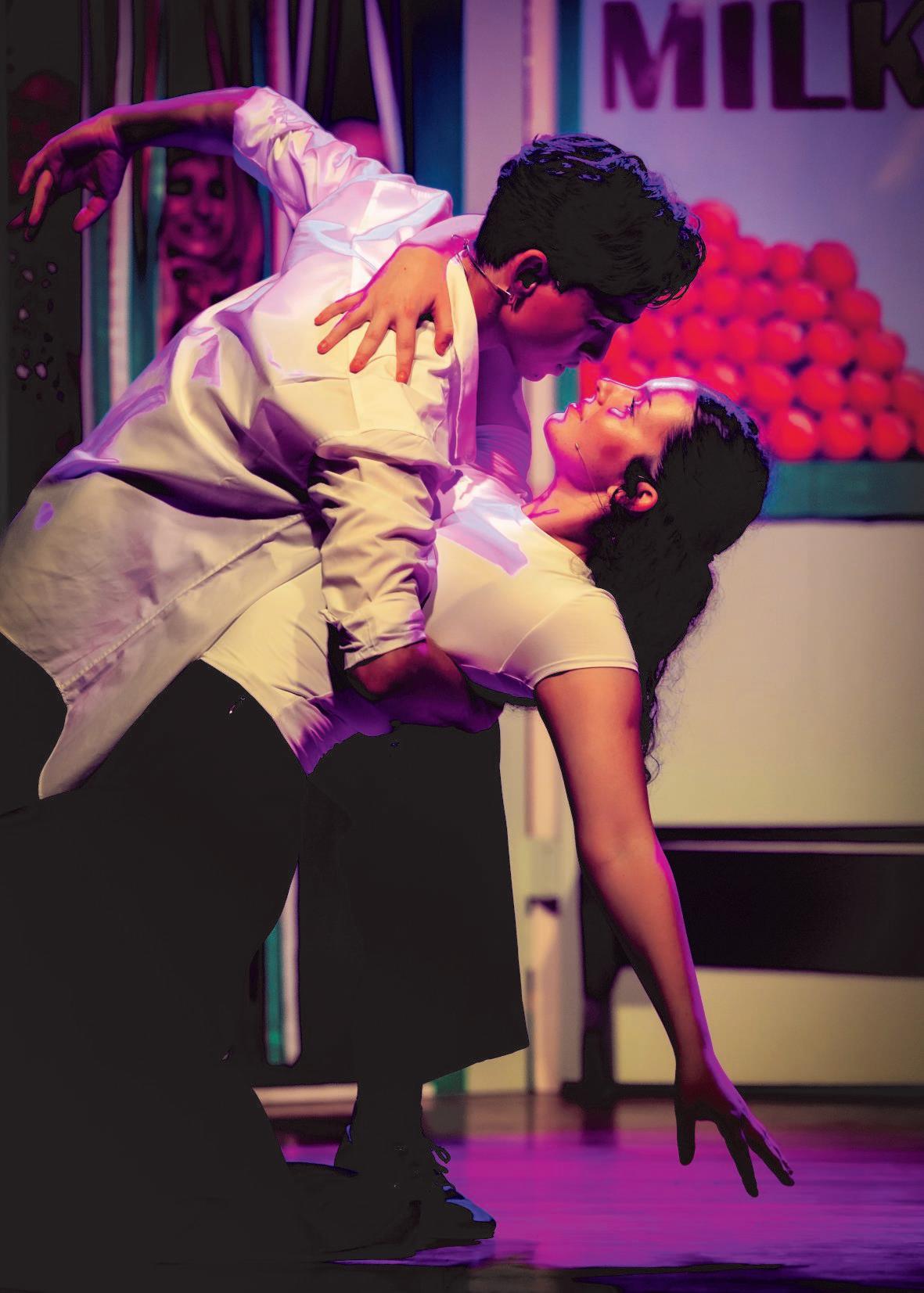
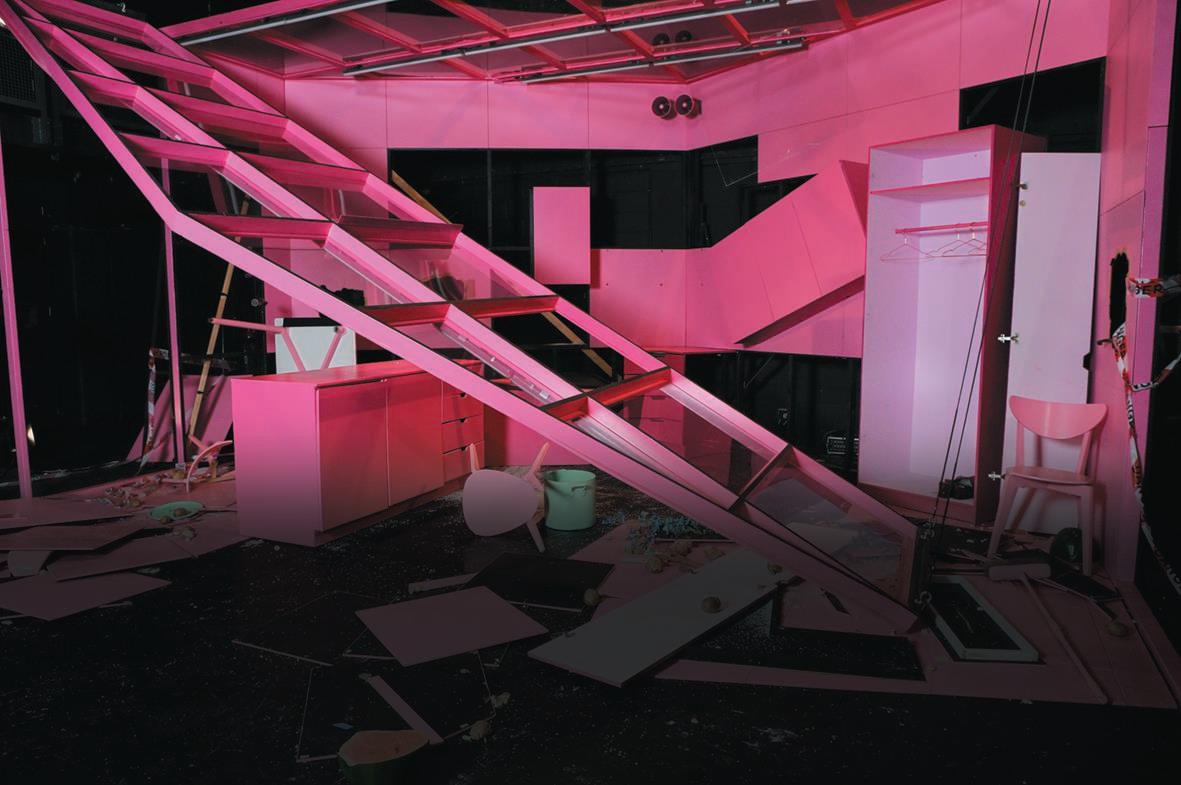
NIDA’s June Student Productions Season sent audiences on a spin with innovative scenic construction.
A production of the play Perfect Stranger placed the audience on the revolving stage, while Revolt. She Said. Revolt Again collapsed the full set during each performance, including the ceiling.
Perfect Stranger was written by Hilary Bell and directed by guest director Kate Champion.
“The challenge was to stage this play with 35 characters and 34 locations as a live theatrical experience,” said Kate.
“I was drawn into the visceral effect of its sense of perpetual movement. Even when reading it you sense it swirl about you with its intrigue and mystery. Intoxicating stuff but how do you stage such a play?”
Set Designer Hayden Relf and Costume Designer Hannah Taylor (both BFA Design for Performance year 3) met with Kate to tussle over how to bring this story to the stage.
“We wanted to avoid the
audience witnessing the many changes of scenery. We wanted the various scenes to seem to appear out of nowhere. We landed on the exciting idea of putting the audience on a revolve to create the spinning perspective from within!” said Kate.
The audience capacity was limited due to the maximum weight that the revolve could take.
“It was an incredible feat for the whole team, from the very demanding build of the set to lighting and sound design, quick changes and agile prop requirements. We also made the actor Ebony Tucker disappear in a puff of smoke and had Amy Joyce enter through a waterfall.
“My favourite moment was at the beginning of the play - the lights go down - Harrison Quast (BFA Acting year 3) enters as the old man, slowly walking in from the left of our vision then very gradually something unnerving happens - are the walls moving? Collectively the audience realises that the seating bank is turning - priceless. I even heard one woman quite audibly say ‘what’s
happening!’. It was like being at the start of a ghost train ride and that was just the beginning!”
Heather Fairbairn directed Alice Birch’s exposure of patriarchy in Revolt. She Said. Revolt Again. The play disrupts accepted models of storytelling by deconstructing language, character and form. The production was designed by Angelina Meany (BFA Design for Performance year 3).
Assistant Director Alexei YmerWelsby explained that “the concept behind the stage construction was to have the performers deconstruct the set by literally ripping it apart - a metaphor for their ‘deconstruction’ of patriarchal norms at the centre of the play.
“In rehearsals, we used a full-scale mark-up of the scenography so we could choreograph in a detailed and controlled way how the actors would go about pulling off cabinets, inverting tables and smashing plates. In the performances, this precision enabled the actors to safely go about ‘destroying’ the set while giving the
audience the impression that it was entirely spontaneous and anarchic.”
Matthew Hinton, in his final year of the BFA (Scenic Construction and Technologies), worked as the Constructions Supervisor. He explains that “the set was a dollhouse aesthetic pink room. It looked pristine from the start, but by the end of the show, most of the walls were stripped, cupboards were tipped, and a ceiling section had caved in.
“Working on a set that has to be pulled apart twice a day had unique challenges!” said Matthew.
“I learned a vast amount about prototyping and the ongoing development of ideas. I worked with a designer and our props supervisor Rachel Hallett (BFA Properties and Objects year 3) to ensure that each aspect of the set moved and fitted together as seamlessly as possible. A clear highlight was the first time that we dropped the ceiling in the space. Weeks of planning, building and installing all culminated in one moment of a test and justified the hundreds of hours the team had put into the production.”
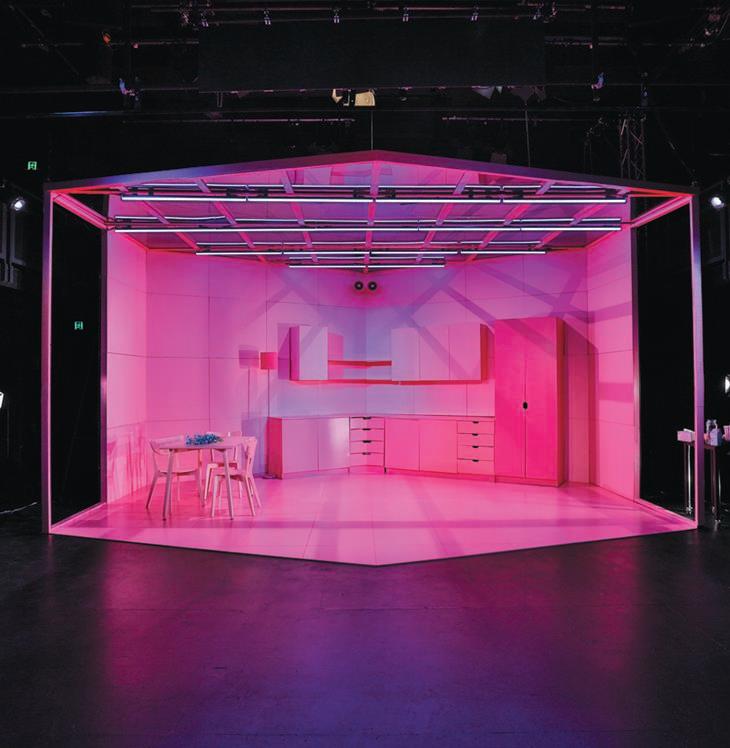
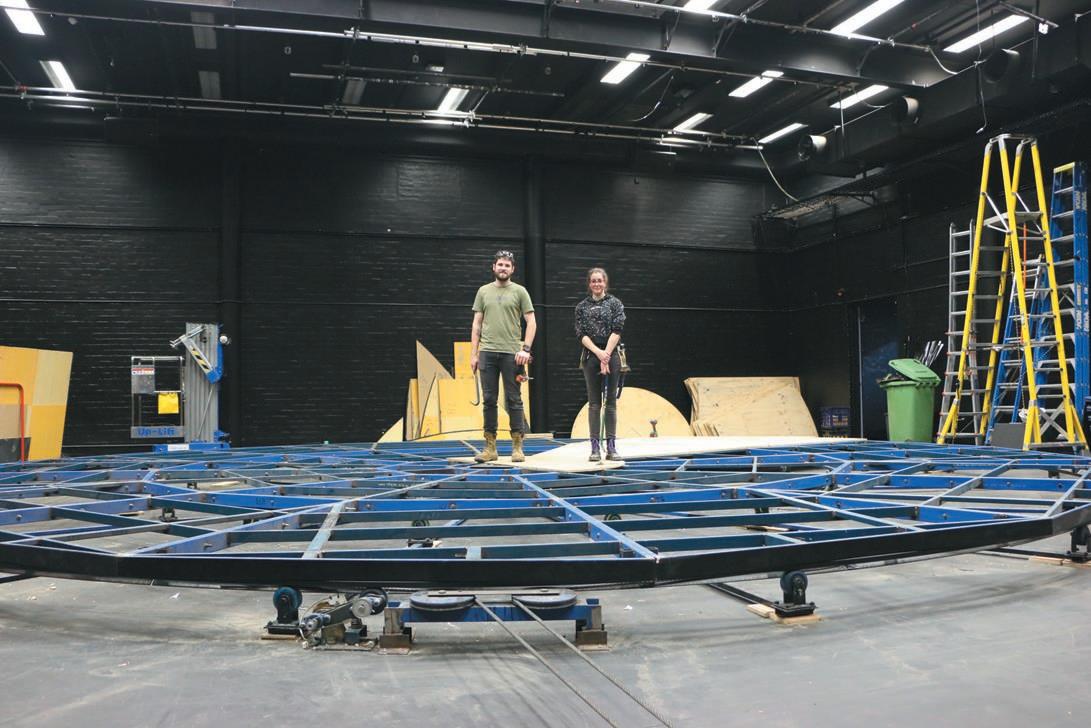
Community Theatres are facing their biggest technical challenge yetbuilding their own buses for productions of Priscilla, Queen Of The Desert. CLOC in Melbourne, Willoughby Theatre Company in Sydney and Platinum Entertainment in Perth take us for a peek under the bonnet.
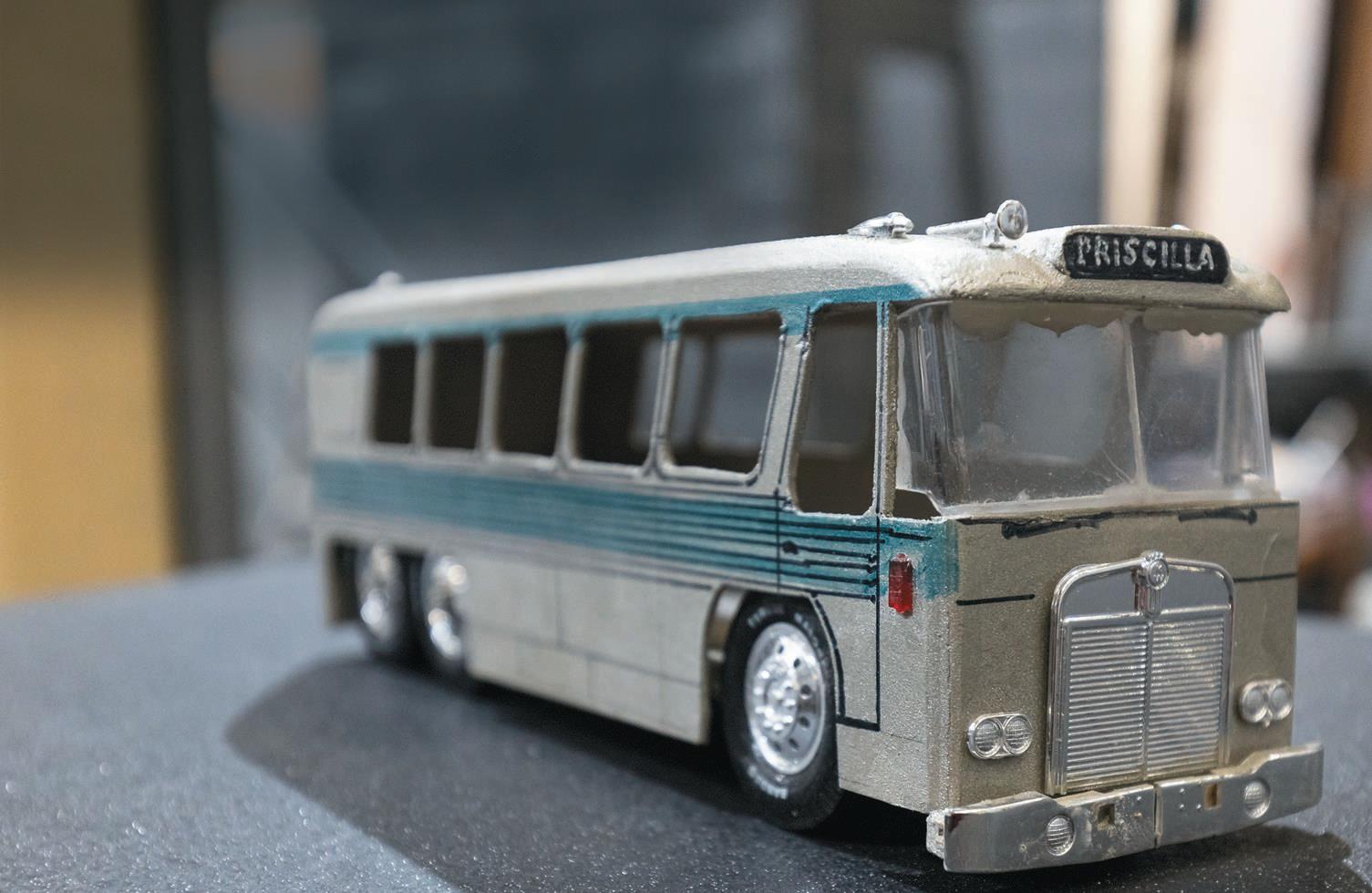
Karen Greenwood reports that Priscilla, the most expensive set piece ever constructed by the company, is a replica of a 1960s Leyland bus.
“In early 2019, which now seems like ‘a long time ago, in a galaxy far, far away’, Melbourne’s CLOC Musical Theatre started preparing for a visually and aurally spectacular production of Priscilla, Queen of the Desert, scheduled for May 2020. Rehearsals began in February, and by March, costume making and set building -
including the iconic bus Priscillawere well on the way.
“And then - well, we all know what happened. Rehearsals, costumes, sets, the bus and the production all came to a grinding halt.
“As community restrictions eased this year, CLOC decided to resume Priscilla rehearsals and preparations for an extended season in April-May 2021. With excitement, enthusiasm, masks and sanitisers, all departments - cast, crew, costume team, set builders, props makers - reconvened.
“Amongst the tasks to be completed was the construction of Priscilla, the titular bus and, in her own way, leading lady and co-star of
the show. The bus, the most expensive single set item ever constructed in a CLOC show, is designed by the co-director Chris White.
“Our Technical Director Grant Alley and his assistants Justin Karakai and Peter Turley translated Chris’ design into a life-sized steel framework. They solved all the mechanical challenges in making the bus sturdy whilst being able to fit under the gantry that spans the width of the stage. It also moves upstage, downstage and revolves on cue, as well as being totally portable and transportable for future hire.
“Chris, a petrol-head from way back, emphasises that from the outset that his aim was to make a life-size

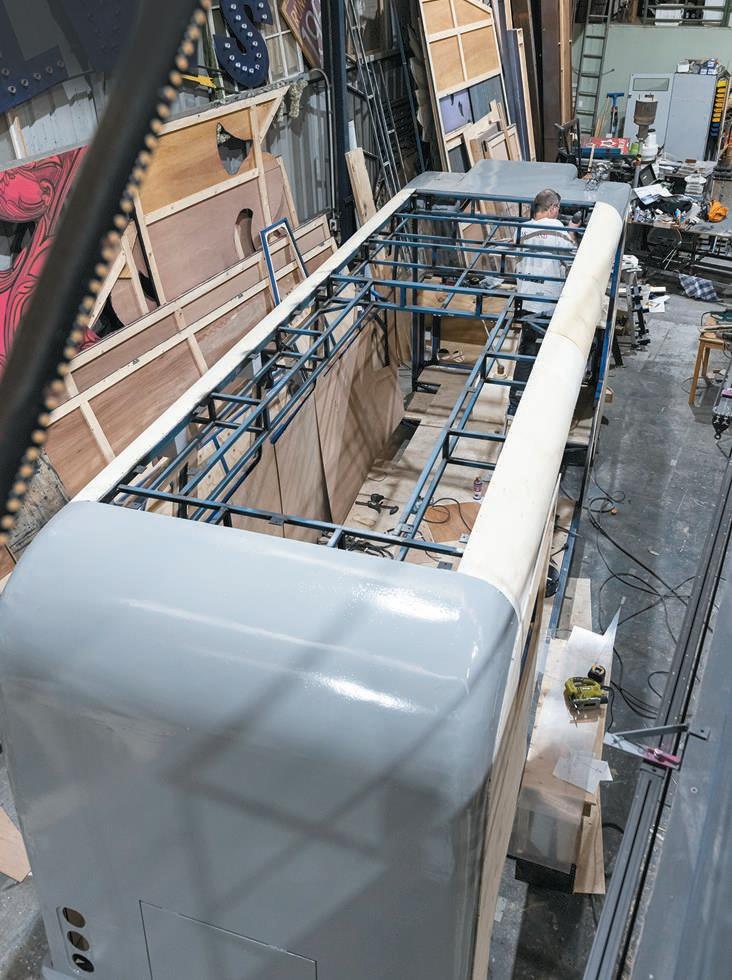

CLOC’s production of Priscilla, Queen Of The Desert played from April 30 to May 22, 2021 at the National Theatre Melbourne. cloc.org.au
bus with accurate proportions comparable to an old Leyland bus from the 1960s/70s.
“Amongst the features on the bus are real air horns, working headlights and indicators, an actual steering wheel from an old tramway bus, a cocktail bar, beaded curtains, clothes racks - all the kitsch decorative comforts of home - and of course, the famous stiletto shoe perched on top of the bus, recreated from the memorable opera scene in the Priscilla movie.
“The bus remains onstage during the show, masked by onstage cloths and projections, and will be operated remotely by a crew member.
“Audiences will also be treated to spectacular costumes, headdresses, lights, sets, choreography, a parade of famous 80s disco hits - and of course Priscilla herself, who will be her own special star of the show. With great excitement, CLOC cannot wait to welcome audiences back to rediscover the joy of live musical theatre.”
(Continued on page 126)
CLOC takes their custom-built “Priscilla” for a quick spin. Scan or visit youtu.be/D481rvPdLfE
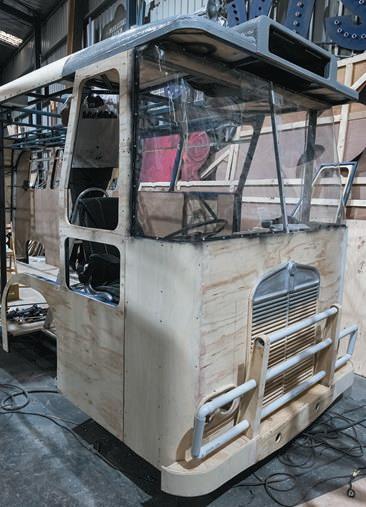
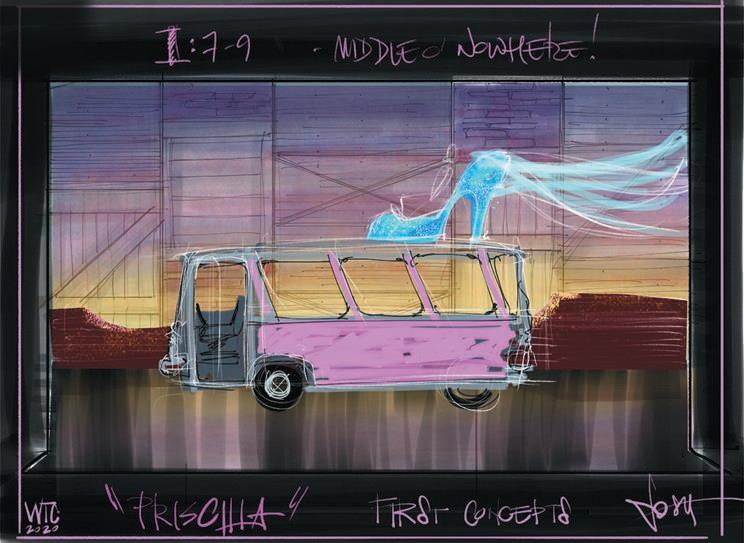
Peter O’Sullivan reports that Sydney’s Willoughby Theatre Company has included secret entrances on their Priscilla.
“The Willoughby Theatre Company was set to put on the spectacular show last year, but like all groups was forced to postpone due to COVID-19 restrictions.
“As the first community group to put the show on in New South Wales, the company has spared no expense to bring this larger-than-life adventure of three friends aboard a battered old bus bound for Alice Springs onto the stage. Their epic journey is a heartwarming story of self-discovery, sassiness and acceptance, and features some of the biggest pop hits of all time.
“At the heart of the show’s design is the big pink bus. It is a showstopping set piece that has had audiences internationally cheering as it makes its grand entrance in act one.
“To bring the overall vision of show’s director Adam Haynes to life, Willoughby engaged multi-award winning Queensland designer Josh
McIntosh to develop and construct the bus.
“Using 200 metres of steel in the frame, Josh has had to build the bus as lightweight as possible to ensure it can be moved easily and quickly by cast during and between scenes. The final bus only weighs approximately 350kg.
“Unique touches have also been added by Josh, and the bus comes
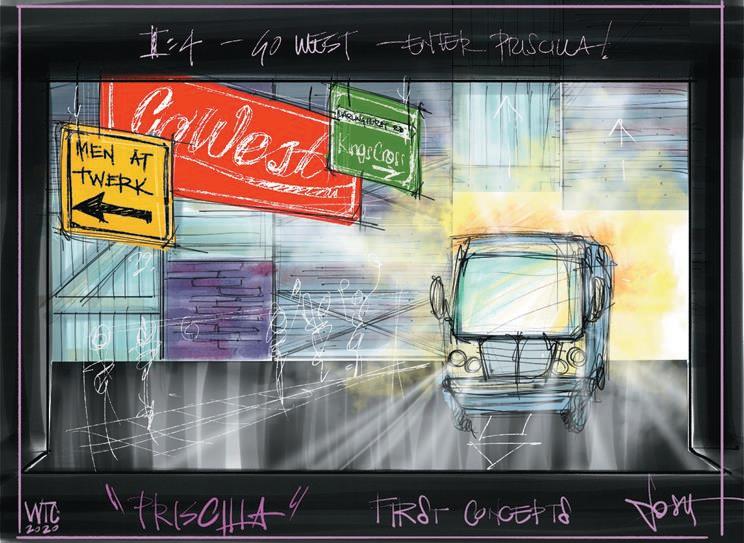
complete with working head and taillights, conventional bi-fold bus doors and removable side panels to create its different looks throughout the show.
“There are even secret entrances at the rear to hide the dressers for those impressive 20 second onstage quick changes for the three leads as they take the audience on their journey across the outback.
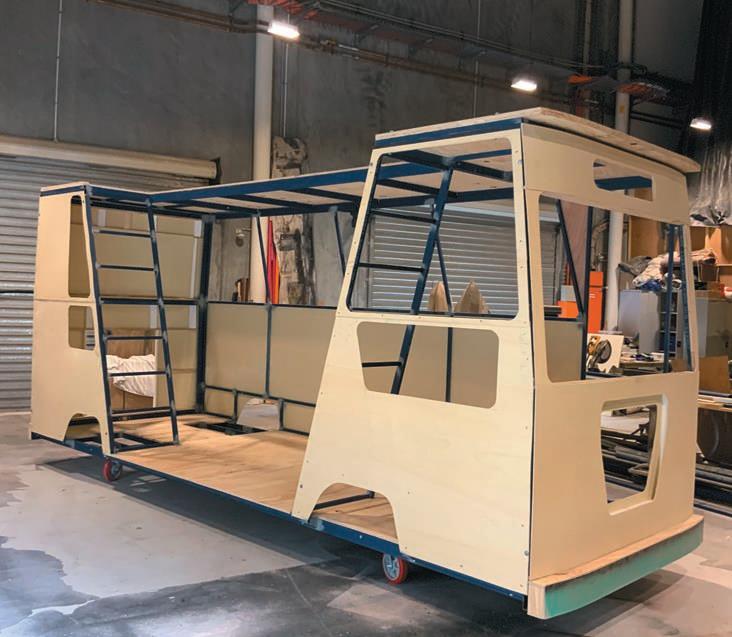

“Before even hitting the stage for the first time, the bus for the Willoughby Theatre Company production is already in high demand by other community groups.”
Willoughby Theatre Company director of Priscilla, Adam Haynes, said, “We can’t wait for audiences to see his spectacular designs, including the bus which we know will create
impact from the moment it arrives on the Concourse stage.
“We’re also looking forward to seeing the bus tour the country after our production has finished.”
For theatre companies interested in Priscilla set hire, including the bus, email Nikole Music nikolemusic@hotmail.com
Trevor Patient from Platinum Entertainment in Perth is recycling an old school bus to create his Priscilla.
“When I commenced planning for the musical, I had to decide whether to build, hire or buy a set from another company.
“I hunted around on Facebook Market Place and found a bus at a wrecker’s yard.
“Our resident bus mechanic gutted the vehicle, and our crew is refitting it for use on stage.
“We’re putting LED screens in the bus windows along one side so we can change the colour and add text.
“All of the external lights are being changed to LED fixtures controlled by wireless DMX. Our bus sits permanently on a revolving stage, which has power running to the bus via a slip ring.
“The LED screens are also controlled via wireless network, as indeed are PA monitors, so the singers can hear the music whilst inside. So, as you can see it’s a technical wonderland.
“Instead of strengthening the roof, we completely removed it and replaced it with staging deck on ‘scaffold’ poles. Access is via a set of steps that roll on and off from the side.
“When I went to pick it up, I noticed that it had a familiar logo.
“I started chatting to our cast about the bus and discovered that this very vehicle was driven by a cast member Chris Gerrish when he taught at Newman College, the school where it was from.
“Further investigation has revealed that certain cast and crew members would have ridden on the bus as students, so they will be very comfortable with the familiar surroundings.”
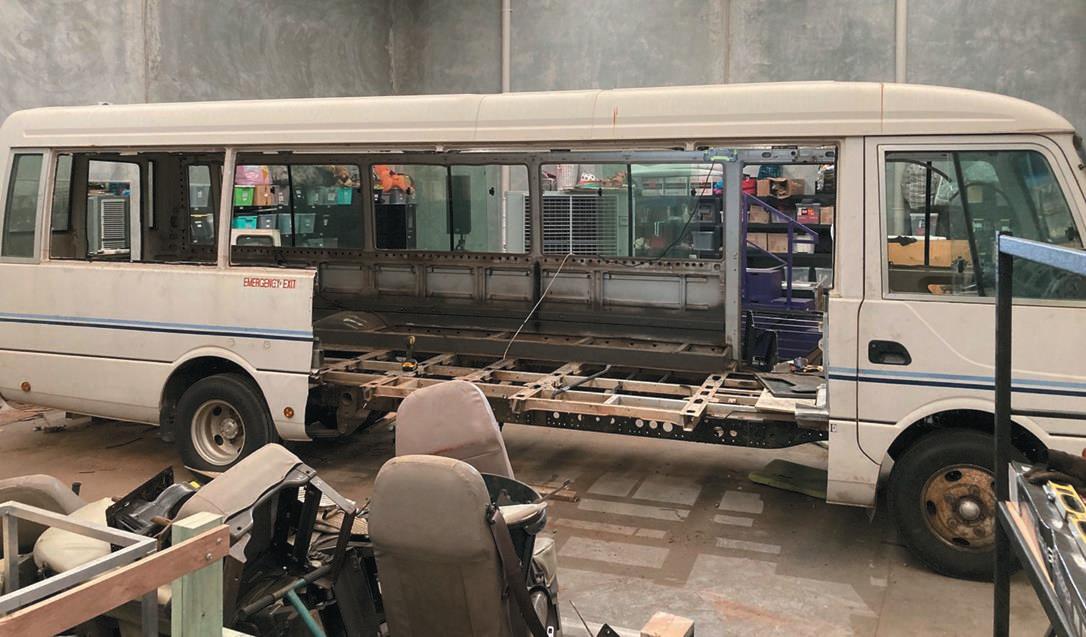
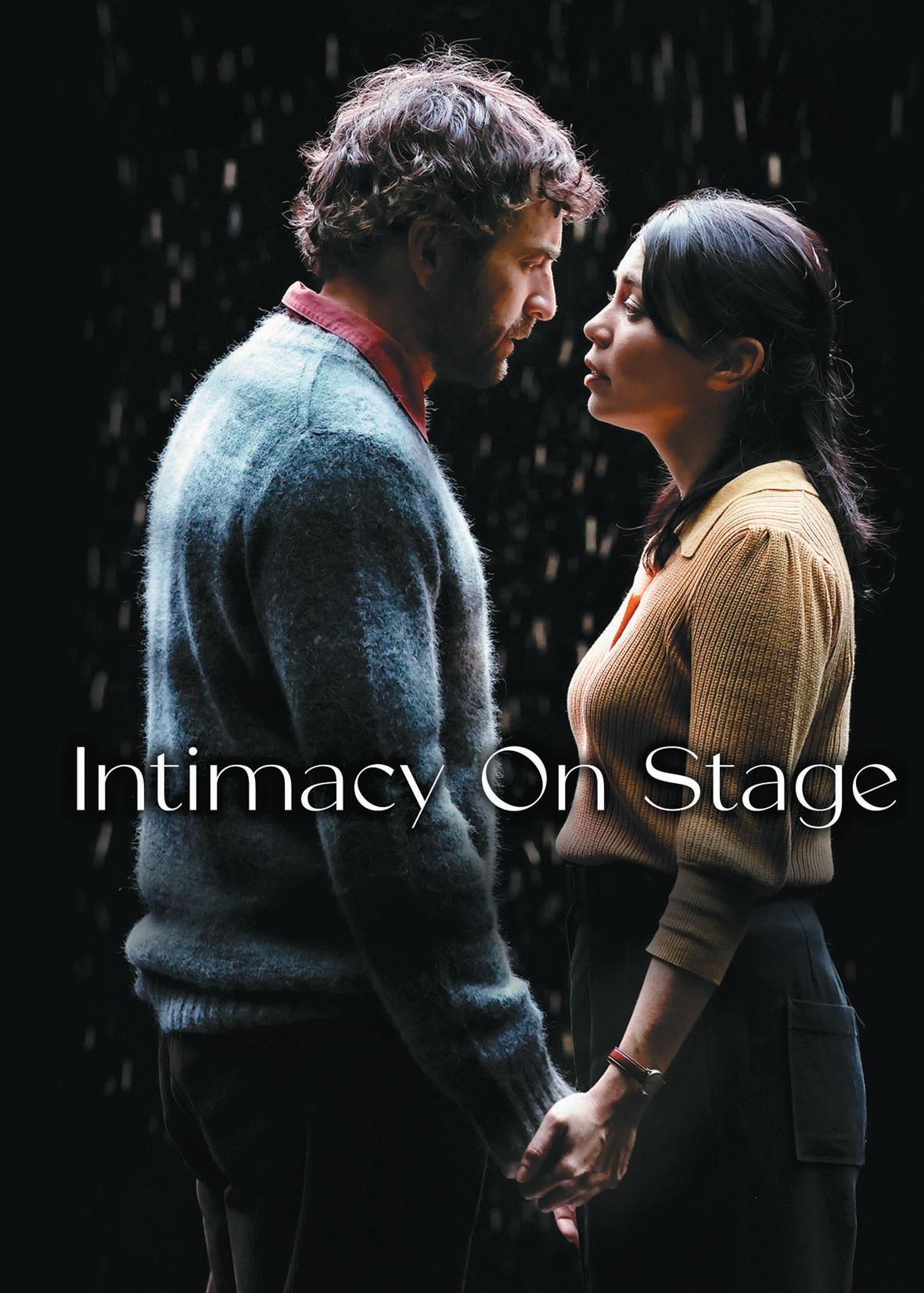
Cast members used to be asked to work intimate and hyper sensitive moments out for themselves. Carrie Thiel, a Wellington-based director, fight director, actor and intimacy co-ordinator, told Olivia Greenberg why intimate touching and violence on stage need to be co-ordinated and worked out sensitively.

My first actual kiss was a stage kiss. I was 14 years old, and I was playing Liesl in The Sound of Music. Luckily for us, the young man playing Rolf and I were good friends. Being community theatre, we all knew each other and the director was also a family friend of mine.
But I don’t remember there being any process around it. It was just assumed that we would do this thing, and I think we just got on with it. We never really talked about it. Looking back now, and certainly moving forward, I think it’s important that directors, in collaboration with actors, establish why the moment is in the script, and all are given the opportunity to say, “what are we comfortable with and how do we want to tell this story?”
You don’t have to have lip to lip contact to tell the story of love or attraction. There’s a myriad of ways to tell that story, through body language, eye contact, or other types of touch or kiss.
No one should be making assumptions about anyone coming into a creative process. You can’t assume people’s lived experience, sexual or otherwise, based on their age or gender presentation, or what boundaries they may have we don’t know what people are coming in with.
That’s why we have to check in and have a process around these sorts of moments. We need regular conversations. People might be fine with the content, but then they also might discover as they go that they’re not fine, and then feel unable to back out because they’ve already said yes.
When I’m teaching intimacy best practice, I use a version of the five pillars that were established by Intimacy Directors International. These include Context, Consent, Choreography, Closure, and clear, concise Communication which sits before, during, and after all those steps.
Before anything happens, there must be clear communication and everybody must know the context of the story. If you’re asking a designer to design sets or costumes, they are going to take into account many aspects of the script, along with the vision of the director, which will influence their design. It’s the same when we’re blocking any scene. You’re looking at the wider context. You’re looking at the motivations and intentions of the characters to inform the action.
Once you start working with violence or intimacy, lines can get blurred unless there is a structure in place. What’s the context of the moment? What’s the wider story? Where does the moment start? Who’s initiating it? Where and how does it end? You want to have a robust discussion about that and understand why you’re doing the things that you’re doing.
How it is structured really depends on the actors. You might have one actor say, “I’m fine with whatever.” But the other actor says, “I really need this marked out. I need to know the specifics of what we’re doing.” The aim is always to create a safe, repeatable, and effective moment of storytelling.
It’s important that you have these conversations. Many directors are hesitant to actually put time into direct intimate moments, because they either do not have the language for it or are unsure of how to go about it. This is precisely how the role of the Intimacy Director was born. Intimacy Directors can lead this process, identify any power imbalances and act as an advocate for cast and crew, while choreographing moments that sell the director’s vision. I always ask directors what their nonnegotiables are. If they have a particular vision, what are the things that they absolutely must have?
Things like if actors must have lip to lip contact or if they have to be fully or partially nude . Those are the things that actors need to know before they even agree to doing a role.
Often actors are left to figure out those moments for themselves. Which can lead them to feel anxious because they don’t know what is required of them, what exactly the scene will entail, how long it will take, etc. If there are no parameters and we are not talking about how the moment informs the story, then they can be left feeling like their own sexuality is on display, or even that they are being taken advantage of.
This is what happened to me as an actor, which led me to retraining as an Intimacy Director a few years ago. After many years working behind the scenes as a performance and fight director I got back on stage myself, and I had to play an intimate moment with a fellow cast member.
We were only a week away from opening and we had never rehearsed or even talked about this moment not even the broader context/scene. I finally said to the director, “What is the expectation here? What are you planning?” To which they replied, “You can go work that out for yourselves.” Sending two actors to privately work out a moment of intimacy for themselves is simply not a professional or appropriate practice, so I sought some
(Continued on page 130)
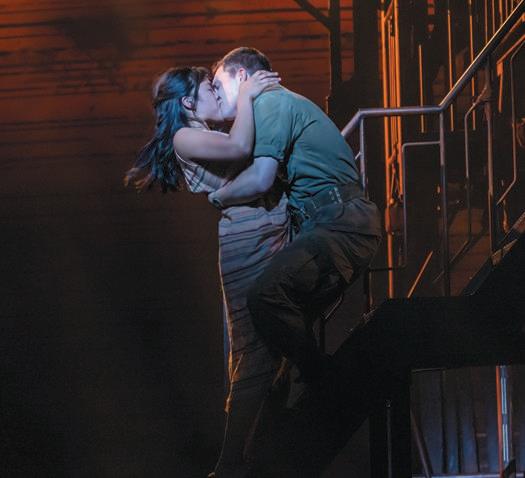

help from colleagues that were doing this work at the time, and now, after training as an Intimacy Director, I have a robust practice to help others with scenes like this.
I approach intimacy directing in a very similar way to fight directing. I create a risk assessment, break down what I’m seeing in the script and talk to the director about their vision before sitting down with the actors. Ideally I am brought on at the same time as other members of the design team, so that we can work collaboratively and communicate throughout the design and rehearsal process. The worst thing is when (and this has happened so many times) directors make assumptions that an actor will be fine with a particular thing, and then discover that, no, not at all. My main rule is don’t make assumptions.
We’ve heard stories now of people that very much felt taken advantage of, and coerced into doing things that they would have otherwise not said yes to. As actors, we are often trained to say “yes”, but I think it’s important that somebody is there to help people express their boundaries and choreograph action that is going to best tell the story.
Early on in my career as a Fight Director, I would create choreography, then pass it on to whoever I was working with. That’s an inappropriate thing to do in intimacy because we want to ensure actors work within their personal boundaries to find the appropriate action for their characters.
I have adapted my fight directing with this in mind as well.
(Continued from page 129) Find
Intimacy Directors aim to facilitate a space where people feel confident to voice an authentic “yes” or an authentic “no”, creating a safe emotional and physical space for people to be brave and creative.
We are not mental health professionals. Many intimacy directors come from movement, acting and directing backgrounds. While we have a lot of awareness and training around mental health, we don’t work as mental health practitioners. It’s also worth noting the importance of the stage manager, or a production manager, who is present for all the rehearsals.
Your stage manager would be taking the notation and running those rehearsals, and running a call before each rehearsal and show. Just like you would have a fight call to review choreography before each show, this gives a chance for the actors to check in and talk about things like, “Hey, how did that go for you last night?” So actors have an opportunity to say, “I felt like we rushed this part,” or, “Today I don’t want to be touched in this place. Can we adjust it?” It also gives the stage manager an opportunity to note any discrepancies in the choreography.
Communication is key at the beginning, middle, end, and all throughout the creative process. If everyone is on the same page, you will have a more enjoyable experience.
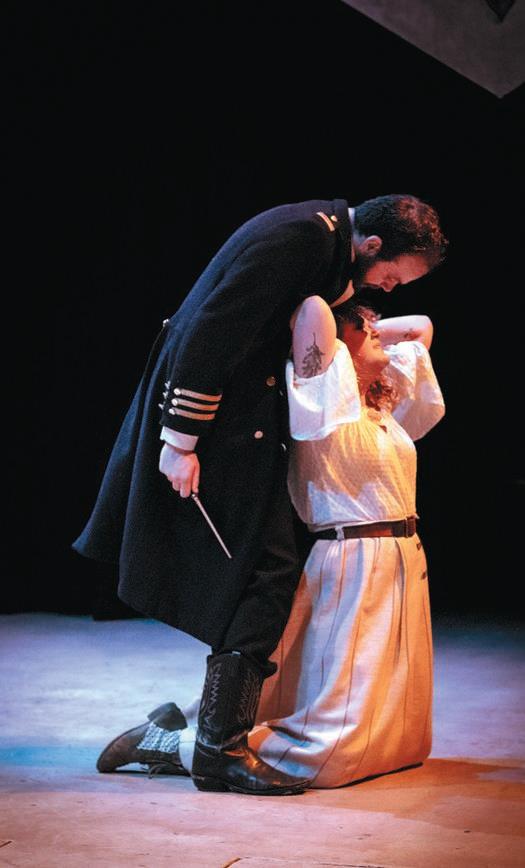
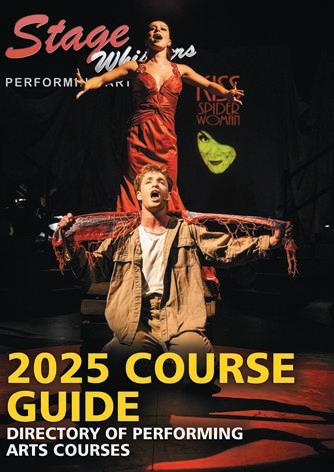
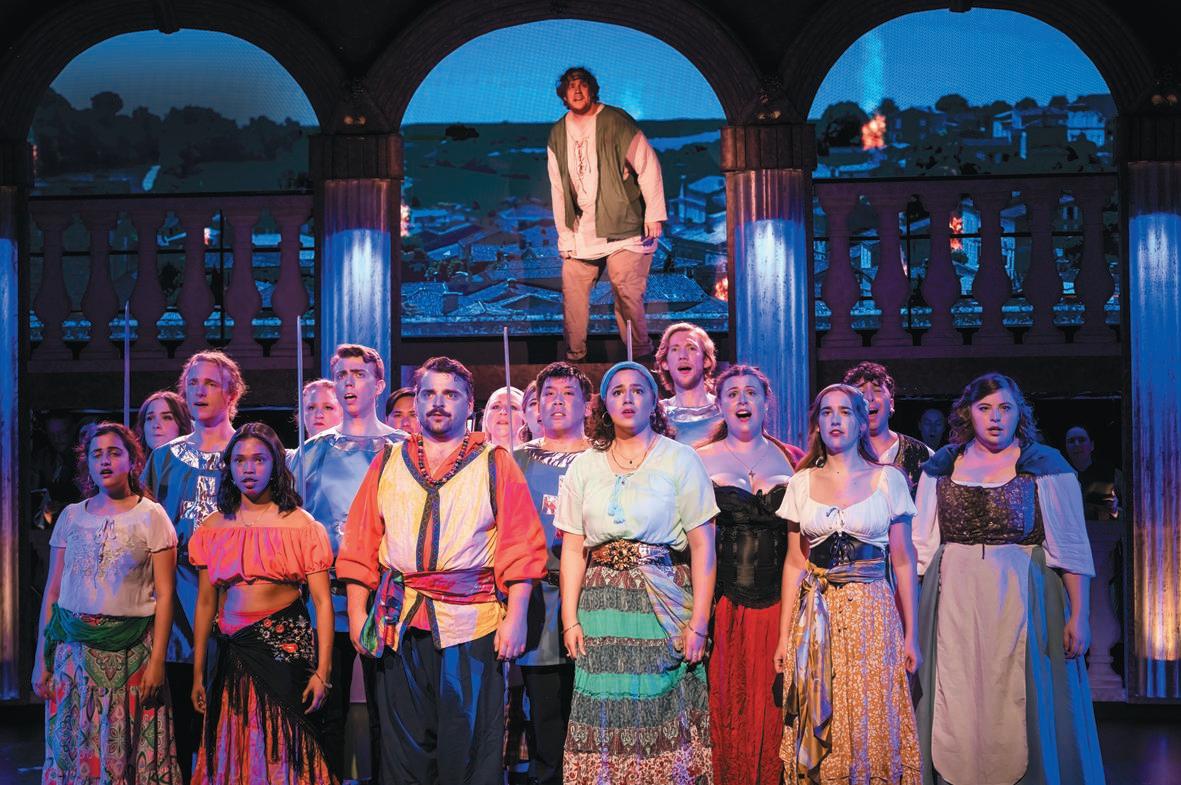
How do you stage a musical which has Quasimodo swinging down from Notre Dame? The Blackout Theatre Company rose to the challenge to stage the NSW Premiere of The Hunchback Of Notre Dame musical, a production described by Stage Whispers reviewer Nicole Smith as “Five star entertainment”, daring her readers to “see just how damn good community theatre can be”.
Directors Ciewern Newell and Luke Quinn recall their journey to the stage.
The first part was getting the “Yes”.
“I have been applying for five years straight and never heard back. Six months after another application was sent, we got an email saying: ‘approved’. Then there was this feeling of being overcome with ecstatic and looming fear can we pull this off,” says Luke Quinn.
One emergency meeting later, the committee agreed to bump the next round of shows which were locked in, in favour of Hunchback
Immediately the focus turned to the design. Hunchback is a staple
around the amateur scene in the northern hemisphere, but elsewhere it has rarely been seen live. A daunting challenge was how to fit the facade of Notre Dame into the Pioneer Theatre with its 4.5m roof.
Long-time committee member John Hanna birthed what became the design. A two tier set with the famous cathedral arches framing a 10 metre 4K LED screen with just enough space below to fit a choir.
“When Luke and I saw the set, it was instant love fusing technology and the grandeur of Notre Dame, allowing the scenes to come to life
and transition from one part of Paris to another,” says Cierwen Newell.
The rehearsal materials had arrived, and it was even more overwhelming. The 129-page production handbook which Disney prescribes is an astounding resource. It gives absolute detail on every reference, every source material, every character, every required prop, special effect and more.
The script is not so prescriptive and requires the director to assign lines to
(Continued on page 132)
(Continued from page 131)
the ensemble, which is an arduous task.
We started simply by giving the ensemble lines to the core congregants, hoping to distribute them fairly, although this meant needing double the number of mics.
The show demands a large cast with classical vocal skills and the ability to shape a scene with their presence and storytelling. We split the large ensemble into three factions: congregants, gypsies and choir. This allowed the three factions to hone their strengths without compromising their role.
The congregants are the storytellers of the scenes, the gypsies are the life and energy on the stage, and the choir is the cornerstone of the Alan Menken and Stephen Schwartz’s score. This did provide its challenges with integrating the cast as a whole unit; we were determined to make this cast a family.
Once we were ready to start blocking, it was exceptionally challenging to work simultaneously with the number of bodies on stage, allowing everyone their moment.
“Cierwen came up with such a straightforward medium of using pegs with the cast’s photos on a small table, and we blocked them into position to give us our bearings,” says Luke.
We would call each other at the start and end of each rehearsal, briefing and debriefing each scene until we found our groove once we started knuckling down with the cast about their role in the show.
Act 1 was problematic, as sustaining the audience’s investment for such a prolonged duration was hard. Four of the six big numbers are in this act, including the 12-minute intro, ‘Bells of Notre Dame’, the penultimate ‘Out There’, the spellbinding ‘God Help the Outcasts’, and the best villain song of all time, ‘Hellfire’. Between these big numbers, we initially struggled with ‘Top of the World’ and ‘Tavern Song’. Something wasn’t clicking. ‘Top of the World’ is essential in showing how kindness can change a person’s outlook on life.
“We re-blocked this scene three times, and it ended up being my favourite scene in the entire show by the end,” says Luke.
‘Tavern Song’ features the most prominent dance number in the show, showing the Romani people’s experience. Even though they were
suppressed and “outcasts”, they are portrayed with a positive outlook on life, in all their adversity, and gave so much love and laughter to their scenes; we initially struggled to convey this.
The stagecraft was intense, needing to convey heights with cast placement while working with levels of stairs, with a sense of depth in Notre Dame and travelling through Paris.
The stage directions call for a fire across Paris, with Quasimodo swinging down from Notre Dame to rescue Esmeralda in one fell swoop off a burning pyre. We achieved this through the congregants narrating the lines directly whilst Quasimodo was off-stage. When music reached a climax, he fended off the cathedral guard to rescue Esmeralda in a welltimed, choreographed fight scene. For the fire in Paris, we used custom made hand props of LED fire torches in combination with projections on screens masked by the façade of Notre Dame. Scenes visited earlier were now charred, smouldering or even still on fire. Intimacy and trust between the cast is a must, with love versus lust being a core theme. ‘Tavern Song’ has many intimate moments, with a passionate kiss between Esmeralda

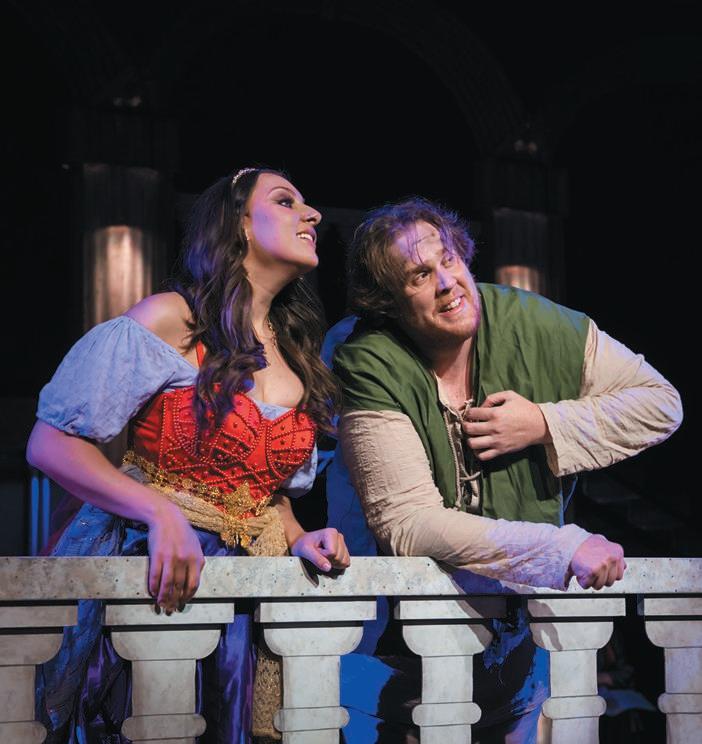
The Hunchback Of Notre Dame Request a perusal or apply for the rights from MTI mtishows.com.au/the-hunchback-of-notre-dame
and Phoebus, which lasts for nearly half a minute, very awkward to block at first blush.
Multiple battle scenes take place and demand even more trust between the cast and crew, with swords sometimes wandering off from the props table because of how fun it was (a good stage manager is screaming at the thought of this).
There is also the very confronting scene titled ‘The Assault’. The moment where Frollo attempts to sexually assault Esmeralda in his lustful rage. Both actors, Joshua Rogers and Dylan-Hayley Rosenthal, were incredible to work with, and trust was no issue. This scene solidifies the show’s stakes. Frollo is the monster.
We planned on much revision, but we only managed to get three nights of it due to the amount of material to learn. It was glorious once we began running the show in its acts roughly three weeks from opening, watching the cast stop thinking, be in the moment, and enjoy.
Sitzprobe came, and we were crying at how compelling the score and music were to hear live. There were collective ‘Oh My’ moments amongst the cast and crew during Matt Herne’s (Quasimodo’s) incredibly powerful numbers.
Once we got to the bump-in, hell broke loose (as it always does) with the intricate technical designs and challenges. Construction of the set and technical elements presented many challenges when first installed.
Redesigning the location on the go to adjust to what wasn’t right while re-blocking to adjust, plotting lighting and sound, and getting the cast used to the space felt like it had control of us, and we were at its mercy.
We would be on two hours of sleep, arrive at the theatre at 9am and go home at 11pm each day until managing to wrangle back control two nights before we opened with such a sense of relief that the show was ready and everything everyone had created was so worth it.

Lesley Reed cast an all-female acting ensemble for her production of this absurdist comedy, which also starred a lift, a bomb and a false leg.
The biting Italian political satire Accidental Death of an Anarchist had long intrigued me. Based on the bombings in Italy in 1969, institutional corruption and a tragic death in custody, I was fascinated with the involvement in political activism by the play’s author, Dario Fo, and how much this linked him to the actual events behind the play.
With institutional corruption and custodial deaths still happening worldwide, I was delighted that The Stirling Players was also excited about the potential of this classic play and scheduled the Ed Emery English edition for the company’s 2023 season.
In 1969 there was widespread political and social tension in Italy. On December 12, 1969, a bomb exploded in the Bank of Agriculture, Milan. Many people died. More bombs then exploded in Rome. Leftwing anarchists across Italy were arrested by right-wing Italian authorities. One, Guiseppe Pinelli, was interrogated at the central police station in Milan without any evidence of his guilt. On December 15, Pinelli plummeted from a fourth-floor police station window.
Police present at Pinelli’s interrogation gave several different versions to various enquiries into the
truth about Pinelli’s death under interrogation. There was much press and public speculation about a coverup. Well-regarded left-wing activist of the time, playwright and public figure Dario Fo also questioned the truth, as did a left-wing journalist. Although aware of Fo’s leftist activity, when authorities discovered the play he was now writing was a farce, they took their eyes off him. However, while written in comedic disguise, the play was an expose of the political corruption and probable coverup behind Pinelli’s death.
People flocked to Fo’s Accidental Death of an Anarchist when it opened in 1970 in Milan. Uproar occurred on the realisation that the storyline was a startling reflection of the recent real events in Milan. It involved a ‘maniac’ using disguise, quick wit and deception to outsmart bumbling police. Prosecutions for the 1969 bombings went on for decades. Right -wing, not left-wing, activists were eventually found guilty of the 1969 bombings. Some truths emerged on the circumstances of Pinelli’s death, but police weren’t charged.
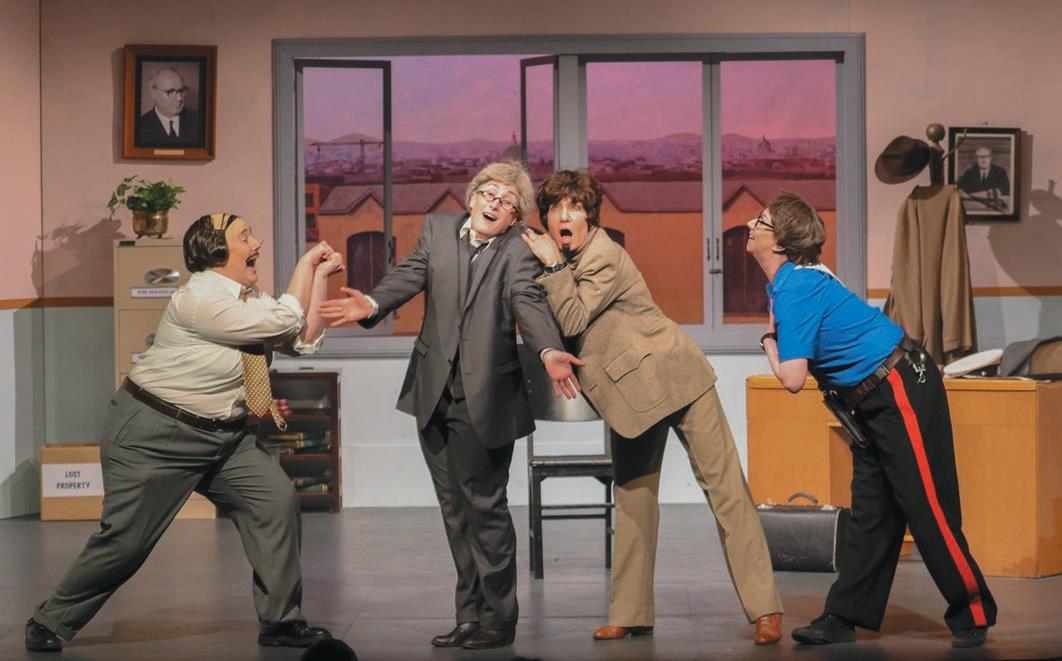
The major challenge for all contemporary stagings of the play, decades after the events behind it occurred, was to engage and immerse audiences who had no personal experience of the play’s underpinning events. Would they respond only to the comedy and not think further about the many dark, underlying themes?
I wanted to leave our contemporary audiences with aching ribs from laughing at the absurd comedy, but also with plenty to take home in terms of the play’s relevance in our times of oft-reported deaths in custody, fake news, worldwide extremism, and political corruption.
I also saw an opportunity to enhance the inherent absurdism, by casting all the male police with female actors, with them looking and acting as males. I saw this casting choice also as a strong means of commenting on power and its misuse, both in global terms and in the workplace, where males tend to have power unafforded to most women.
Male characters in the play include a Maniac, a Superintendent of Police, two Inspectors and two Constables (constables played by same actor). There is one powerful female character, Feletti, a journalist.
Auditions were held a year in advance to secure strong actors, with very good performers attending. The key role to cast was the Maniac, a wily, agile, trickster. Central to the action, he uses disguise and is the inquisitor, constantly questioning, challenging, and outwitting police. He was Fo’s invention and, unlike some other characters, not based on a real person.
Danii Zappia, an experienced actor and drama teacher, shone at auditions and was cast in the role.
The play’s author, Dario Fo, was an expert in the mediaeval Italian
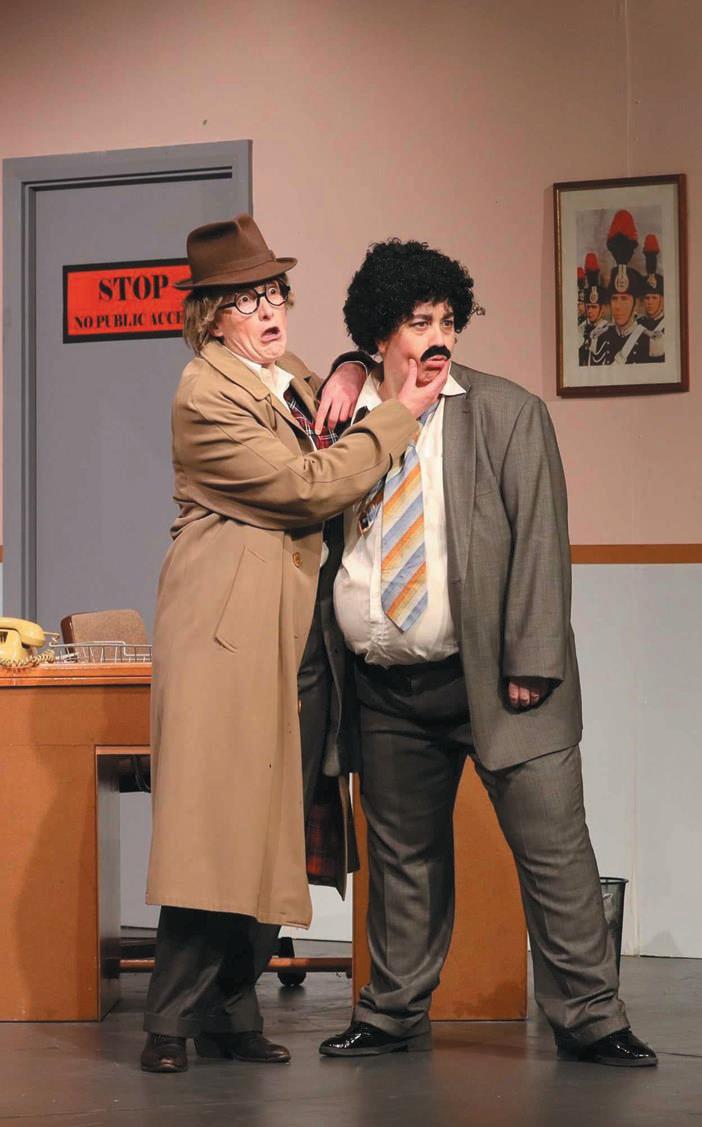
comedic form of acting, Commedia dell’Arte. Some of its characteristics include the use of physical comedy, masks and recognisable character types. These stock characters reflect various levels of power, a strong theme in Accidental Death of an Anarchist.
During the audition callout I was contacted by Doctor Corinna Di Niro, Australia’s leading expert on Commedia dell’Arte. Adelaide-based, she was keen to contribute her expertise to help the production. While we both agreed Accidental Death of an Anarchist was not a
Commedia play as such, we knew it contained an essence of the form in its characters, its physicality, use of disguise and trickery. Corinna provided a useful workshop in Commedia dell’Arte to the actors. She also put forward her views on which classic Commedia character most likely correlated with each character in the play.
Actors worked to develop key characteristics relevant to, but not dependent on Commedia dell’Arte. We also researched Fo’s likely ‘reality’
(Continued on page 136)
(Continued from page 135)
basis for each character for example, Inspector Pissani was likely based on a person present at the interrogation of Pinelli and who was said to have a penchant for forcing detainees onto high windowsills during interrogations.
Physicality was key to the farcical nature of the play. Actors were drilled in the short, choreographed song and dance elements and, for slapstick, by an expert trained in physical comedy. The result was very funny to watch and exhausting yet rewarding for actors, who had ensured good physical fitness prior to rehearsals.
Creating believable ‘males’ was a challenge. While each actor had the talent to achieve ‘male’ personas,
including physicality, the costuming, hair and facial appearance were also key to each character.
Costumes, such as male suits, were well achieved and wigs, including a hilarious ‘combover’ one, were used where needed. Facial hair and makeup for correct male bone contour needed to be realistic, and we achieved this through the skills of work experience students from an Adelaide makeup academy.
We set the play in its original 1970 timeline and place, Milan. Several of our actors were of Italian heritage and so accents were no major issue.
The play is set over two floors in police headquarters, with a shift up to the fourth floor following the first scene. A large frame, strong enough to hold an actor, was built in the upstage flat, with its window sections opening out into a void. Beyond the void, rather than projection of the
The Stirling Players. Sep 8 - 23, 2023.
Stirling Community Theatre, Stirling, South Australia.
Key Production Credits
Director: Lesley Reed
Assistant Director: Sally Putnam
Production Manager: Tim Williams
Stage Manager: Bronwyn Chapple
Props: Leah Klemm
Slapstick Coach: Bronwyn Palmer
Choreographer: Vanessa Redman
Singing Coach: Sarah Bradley
Commedia dell’Arte workshop: Corinna Di Niro
Set Design: Erik Strauts and Eleni Taylor
Lift Design: Andrew Phillips
Scenic Design: Lilita Daenke and Kathy Wurst
Sound and Lighting: Paul Tossell
Costumes: Gilian Cordell
Hairstyles: Kathryn Stevens
Makeup: Students of Media Makeup Academy International
Publicity: Les Laub and John Graham
Cast
Maniac: Danii Zappia
Superintendent: Georgia Stockham
Inspector Pissani: Anita Zamberlan Canala
Inspector Bertozzo: Olivia Jane Parker
Constables: Ashleigh Merriel
Feletti: Kyla Booth
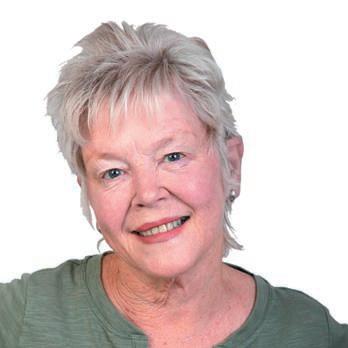
‘view beyond’ we used fine scenic design on a large rollup canvas. Actors worked in full view of audiences and with backstage help to ‘roll up’ the scene change in Act One, from the first to the fourth floor. To add to the illusion of multiple floors, a ‘lift’ was present and the floor number above the lift for the new 4th floor setting after Act One, Scene 1 was also changed by an actor in an amusing sequence during the scene change.
“...the scene transition for the first to fourth floor is an amusing piece in its own right...” -Stage Whispers review.
Props were a challenge, with a ‘bomb’, false leg and hands among the items needed, all of which were achieved creatively.
Our Contemporary Touches
Dario Fo was aware that future productions of Accidental Death of an Anarchist would need to reflect each production’s times in terms of the themes. He publicly gave this his blessing. We endeavoured not to make the contemporary relevance overwhelming but did focus on recent worldwide deaths in custody a little towards the end of the play.
Audience and critical response to the play, its comedy and its darker themes was pleasing and reward for the detailed planning and considerable dedication by all involved.
Read Stage Whispers’ review of the show at bit.ly/3SXd6QB
















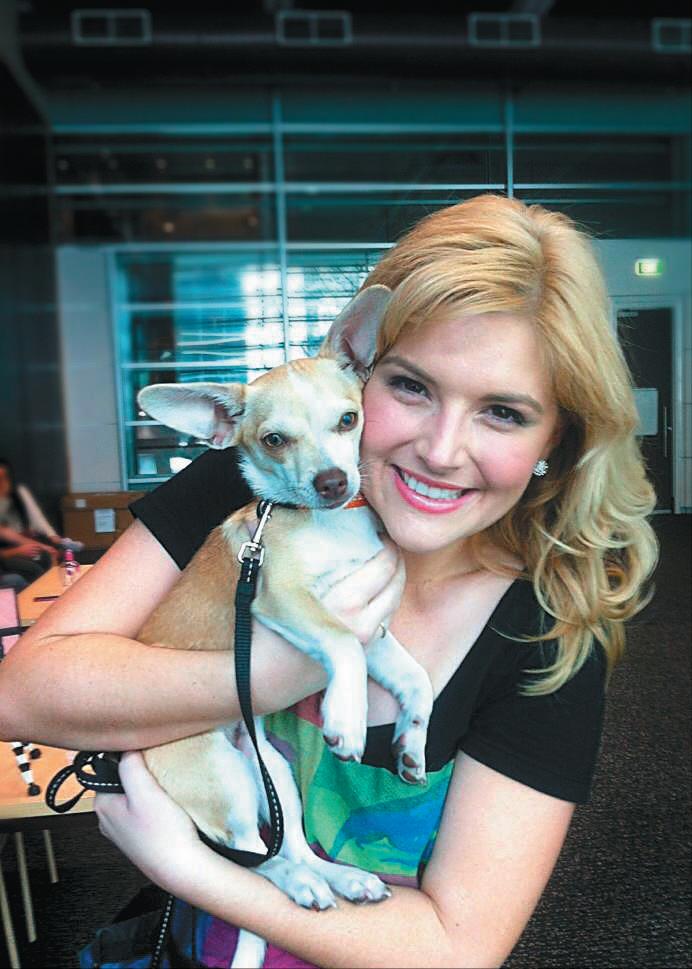

‘Never work with children or animals’ goes the saying. A desperate Debora Krizak, locked down in a COVID-19 hotspot, seeks help from a professional doggie stage trainer Peta Clarke and music theatre star Lucy Durack.
Please know, today was a good day, even though I don’t know what day it is anymore. It doesn’t matter apparently. Not until we reach 80%. It’s almost 11am and a flutter of excitement comes over me as I switch on the telly in anticipation of the daily press conference. For a split second, it feels like opening night nerves but then my mind catches up and I realise I’m still in my PJ’s, slurping unapologetically on my cup of instant coffee.
I’ve been thinking long and hard about my ‘Behind the Scenes’ feature this month but it seems somewhat futile to spotlight the fabulous work being done by my peers when, let’s face it - the lights are off and everybody’s home. So, I’m coming to you live from my locked down LGA in Sydney where Gladys has finally closed Bunnings and every parent in lockdown grapples with the reality that home schooling is like being trapped in an episode of Survivor
It’s time for P.E. and the twins have been instructed to do something “physical”. They both look pale and unengaged so when they plead with me to do the latest Gladys workout posted on Tik Tok, who am I to say no? I can’t sugar coat this whole fiasco any longer. If they want to attempt a burpee every time Gladys repeats herself, they can knock themselves out. While they’re at it, they can knock me out too and wake me up when we’re at 70% - just so I
have enough time to primp and preen myself before we reach that magic 80% and are released back into the wild.
In the meantime, I’ve been lured into the online world of puppy scams. The kids thought we should utilise our time in lockdown to get a puppy. Feeling sorry for them, I start browsing the net. This proves to be a welcome distraction from arguments with anti-vaxxers on Facebook who claim that Ivermectin is the cure for coronavirus. Lockdown brings out the worst in us all - especially the scammers - but like all the antivaxxers, they underestimate the power of proven research. I digress...
We welcome our new puppy “LuLu” into home detention, and I suddenly remember what it is like to be locked up with a destructive toddler. Nothing is off limits and I have unwittingly become the sole carer of a weeing, pooing, chewing ball of brown chocolate fluff. Luckily, I have nothing else to do - thanks Gladys. The cuteness factor lasted an entire day for the kids until LuLu decided that bedspreads and pillows were the ideal place to do a number two.
It was time for some serious puppy training. But where do I start? Time to call in the big guns, which leads me to my next artist in spotlight - animal trainer Peta Clarke from “We Do Animals”.
Peta has been training animals in film, TV and theatre for years. Some of her credits include professional stage productions of Legally Blonde, Annie, Chitty Chitty Bang Bang and feature films such as The Invisible Man, Top End Wedding and the soon to be released My Life Is Murder. She knows that picking up poo is par for the course. Likening her profession to “running away and joining the circus”, Peta initially studied for a degree in child psychology, but it was animal behaviour that piqued her interest. I asked her what traits an animal trainer needed in the entertainment industry.
“You need to have good problemsolving skills as well as the ability and patience to observe animal behaviour. You also need to have the backbone to say no when a job is not in the best interest of the animal. You are the animal’s voice and need to ask all the questions for them.”
I ask Peta what she thinks about the saying ‘never work with children or animals’. Her response - “You’ve never worked with us!”
Her passion and love for animals clearly outweighs the challenges. A workday for Peta can be anything from working with writers, to producers and directors, actors and animal owners, as well as making sure her animals are trained to the script.
(Continued on page 140)
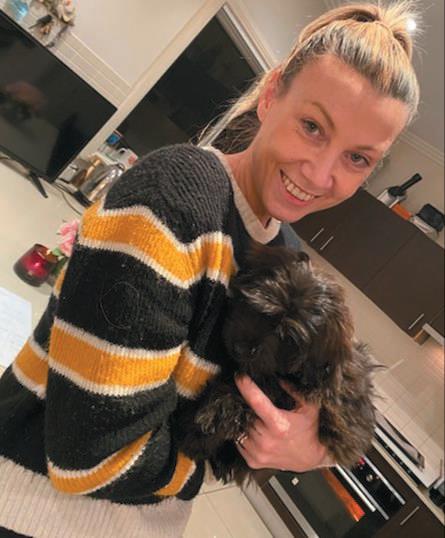
(Continued from page 139)
“At script development stage, we offer insights into the natural behavioural repertoire of the species in question, creating believable animal action on screen. We liken ourselves to puppeteers and love creating behaviours and actions that evoke an emotional response from our audience, which helps to establish the animals as strong characters within each story.”
Perhaps the most important training aspect is to instil a confidence in the animal to feel comfortable and settled in their work setting. The emotional and physical well-being of Peta’s animals is paramount.
“We are consistently thinking about real world exposure. A film or theatre set can be a scary and unusual place for an animal. It’s not for
everyone’s pet. Every day, every interaction, every time they are exposed to something in their environment - we are shaping their response to it.”
So, how is an animal selected for a career in the entertainment industry? Surely, they’re not subjected to hours of unpaid auditions and self-tapes from the doghouse? I recently discovered that LuLu’s father is, in fact, a performing toy poodle. Clearly the universe thought we needed another locked down performer in our house. When it comes to choosing the right animal for the job, Peta considers the overly confident and enthusiastic character traits perfect opportunities to cast the right animal. Sometimes the best trained dog isn’t the best performer because they are ‘over trained’.
“Like actors, we have to audition our animals. It’s all about confidence and bounce back. They need to be able to take anything the ‘make believe’ world can throw at them.”
This is beginning to resonate with me. All actors are experts at bouncing back and we’ve all worked with overconfident types. Perhaps there is a career in this for my LuLu after all. She seems to bounce back effortlessly when I pull her off my brand new, white duvet.
Whilst some animals may impress with their ‘audition’ skills, performing the task consistently, night after night, requires specialised attention to detail. Some of that training includes scent work, where an animal relies on their sense of smell in locating objects and is rewarded with a treat at the other end. On movie sets, where a trainer may not be able to reward the animal immediately, a clicker is used and the animal instantly recognises that the treat is coming. Stick training is also used for specific sightlines on set, but the main tool used by most animal trainers is repetition.
Peta was the animal trainer responsible for the roles of Bruiser and Rufus in the 2013 musical Legally Blonde, starring Lucy Durack as Elle Woods. I asked Peta what it is like for animals to work with actors’ eight show-a-week schedule.
“The dogs know the difference between a rehearsal and an actual show. It’s as obvious to them as it is to us. We make sure all the training work gets done before and during rehearsals so that we can maintain consistency on stage. Things can fall apart very easily. The repetition of the same thing can be a massive help, but if things do go wrong, or something changes, it can be a huge hindrance. One of the funniest things that happened was when my little Chihuahua, who played Bruiser in Legally Blonde, had a cameo at the end of a scene and had to walk on set and cock his leg on a tin can and walk out. He was listed in the credits as the Pissing Dog.”
As actors, it can be both a challenging and rewarding experience to work alongside animals on stage.
But how do they develop a rapport with their human co-stars while learning to navigate uncharted territory? I spoke with Elle Woods herself, Lucy Durack, about how this impacted her show preparation and rehearsals.
“I felt very lucky. Each morning I would have at least an hour to get to know and play with all the dogslearning how they worked while playing and rehearsing. Only those of us who worked with the dogs on stage were allowed to play with them, so it felt like a great privilege!”
How do the cast on stage adapt their performance when things go awry? I remember seeing a preview performance of The Wizard of Oz when Toto proceeded to lick the lead actress for an entire song. It made for wonderful viewing but I’m sure the sentiment of the song was completely lost on the audience.
Lucy recalls the time when one of the understudy dogs had to have knee surgery and a new little dog was brought in to start the bonding process with the actors. Lucy said that one of the perks was being able to take the dog home for the night in order to fast-track the training. Being familiar and comfortable with a lead actor is a necessity when it comes to delivering scenes together. But just like human actors, the dogs all bring their own personalities to the role and respond to varying types of positive reinforcement.
“The Chihuahuas would always perform for food and the bulldogs would perform for hugs! They all had such interesting and different personalities. Quinn was lovely and a bit more reserved, Audrey was a bit of a princess and Sparrow was legitimately a star - reincarnated from Hollywood!” says Lucy.
Star power aside, having witnessed the antics of my very own puppy over the course of a week, I think animal trainers themselves deserve a Helpmann. Whether it’s treats or hugs that motivate these cute and complex creatures, I’m still a long way off getting this ‘Ugg boot obsessed’ puppy of mine to “Pissing Dog” credit status.
Most memorable job description?
Peta Clarke: Rat Trainer. I trained 100 rats for Mel Gibson’s movie Hacksaw Ridge!
Stage or Film?
Peta Clarke: Theatre is one of my favourite places to work. I love the sense of family and camaraderie amongst the cast. The actors often come into the dressing room to spend time with the dogs every day. There’s a consistency with theatre that the dogs respond to well.”
Biggest “fur” pas
Peta Clarke: Not warming up one of the Chihuahua’s voices before a show and he couldn’t bark on cue!
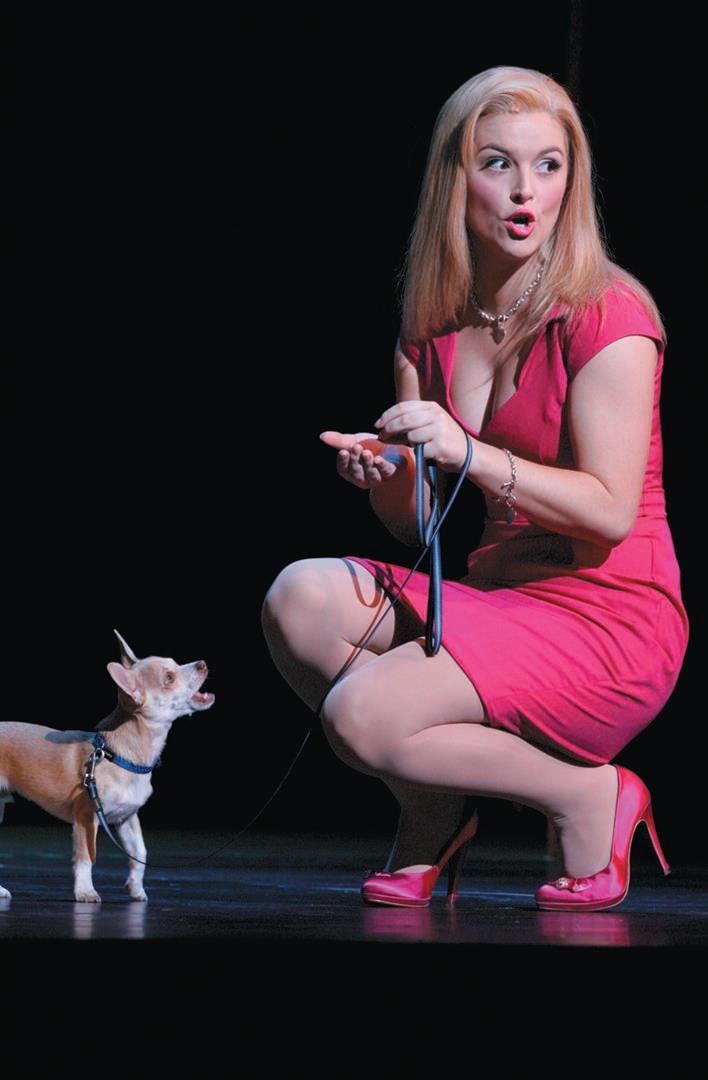

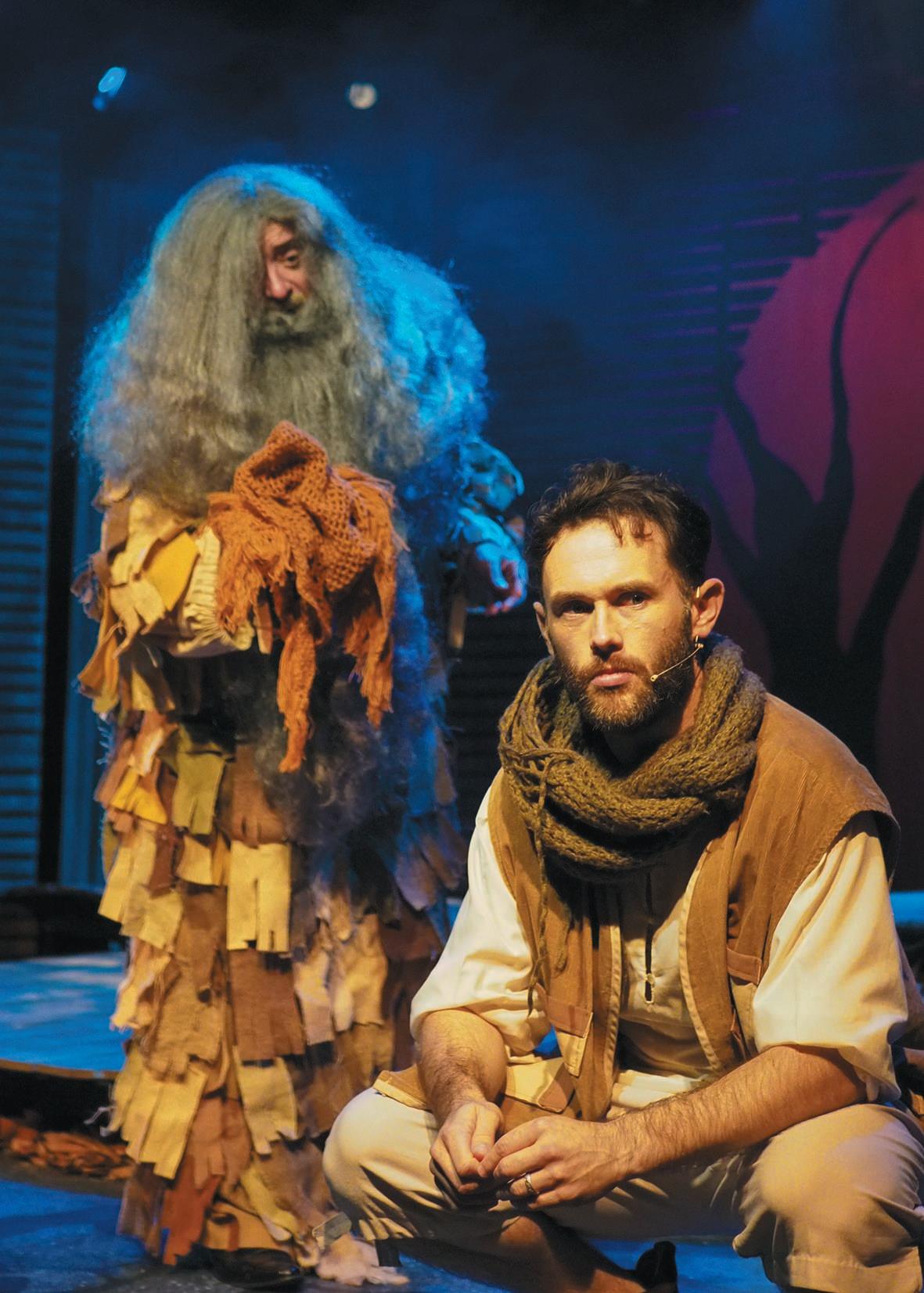
Director Kimberley Shaw thought she was out of the woods when COVID-19 restrictions eased in Perth during the final rehearsals for the musical Into The Woods in July 2021. Then came a dripping sound as the heavens opened. Was their production alright on opening night? Read on to find out.
Into the Woods had a conventional rehearsal period, or at least a COVID-19 conventional rehearsal period.
We auditioned in January, had an excellent turn-out that saw about 200 people audition over four days, and were thrilled with our chosen cast.
Planning to start rehearsals the week before Easter, Perth’s February lockdown had little impact on our production.
April’s lockdown affected us slightly. The Stirling Players’ production preceding ours, To Kill A Mockingbird, was shut down on its projected opening night, costing us three early rehearsals. Mockingbird opened a week later, extra performances were added within their scheduled run, and they closed only a day later than originally planned, meaning just one extra rehearsal in an alternative venue.
Rehearsing in masks was trickybut not impossible - especially relatively early in the rehearsal process. With a flight attendant set designer and another flight attendant in the cast, there was always a risk that one of them might have to go into isolation. Ironically, during this period, our Rapunzel’s Prince, flight attendant Zac, was forced to skip a rehearsal while waiting for test results, but it was because he shopped at Coles at the wrong time.
In the theatre on the morning of Sunday June 27th, we received the announcement that masks would become compulsory within the hour. I ran to the chemist (thankfully only a couple of doors away) to pick up a packet of masks (and inform the pharmacist that she may be in for a busy afternoon). Actors, crew and orchestra members who arrived without having heard the news were handed a mask, and we did our best to do a masked sitzprobe.
The next evening we were in rehearsal when our phones started pinging with messages that Premier Mark McGowan was about to hold an unscheduled press conference. I sent stage manager Mollie out to listen, then paused rehearsals to tell the cast that we were going into a four-day
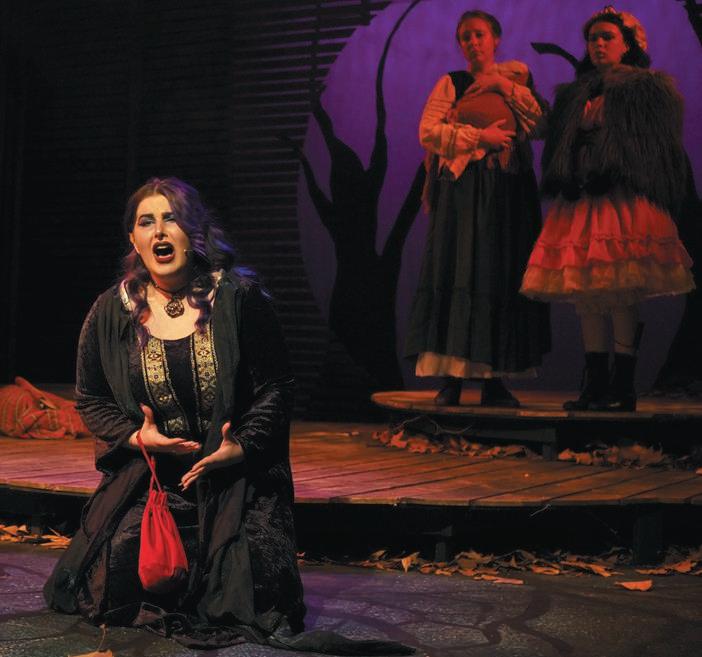
lockdown from midnight. We completed that rehearsal, knowing it would be our last for the week, and hoping desperately that we would be clear to rehearse properly for ‘Hell Sunday’ (tech, dress and orchestra) the following week. We had a Zoom rehearsal midweek - but as many know, time delays make rehearsing a musical on Zoom only moderately helpful at best.
Our set was almost complete, save for a small amount of painting on the stage floor - a specialty job that our set designer Wayne had planned to do himself. Having returned from Northern Queensland, Wayne was thrown into two-weeks’ isolation, meaning that not only would he need to make other arrangements to get the floor painted, but sadly, he would miss opening night.
News came the following Friday that lockdown was ending, but there was now a limit of twenty people inside a venue for the next three days. We had planned a full day rehearsal for the Sunday - the first time that we would properly combine cast and orchestra, implement sound, do full lighting, and have full dress. With
eighteen in the cast, an orchestra of fourteen, a crew of three, stage manager, lighting designer, sound designer, and costume designer, even operating without committee members and any other helpers we would be well over the limit.
We determined that we could make it work. We started with a crew rehearsal, using the time to set up the sound, rehearse quick set changes such as manœuvring grandma’s bed, trying out our flying (Cinderella’s birds, her dress drop, and the growing beanstalk) and rehearsing only actors that had tricky stage business involving the crew.
The crew and sound designer went home, and the plan was then to run the show twice with the cast (using Rehearscore) and then send most of them home and rehearse the orchestra. Stage Manager Mollie was keeping a careful tally of the number in the building, calling cast members in as the crew departed. It was raining steadily, so she had people wait in their cars until called.
(Continued on page 144)
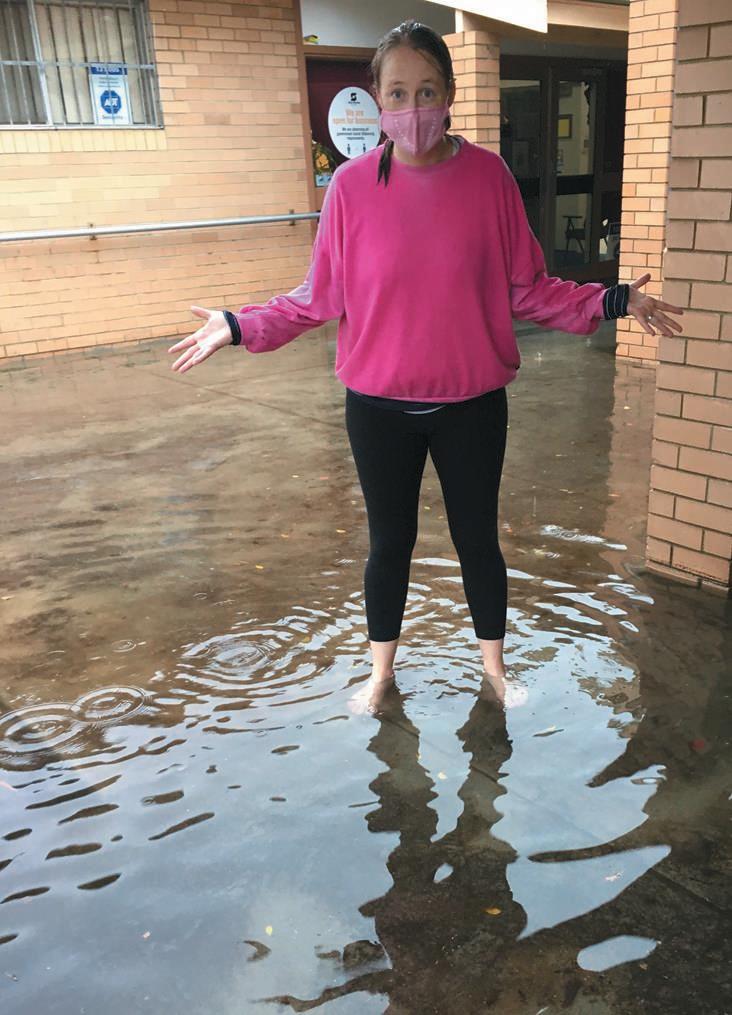
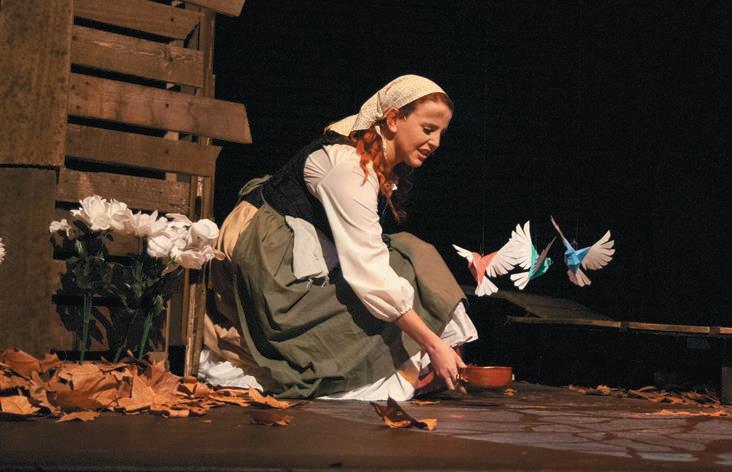
(Continued from page 143)
Running a little late, we ran Act One and decided to break for lunch. We had just given the five-minute call to resume when Mollie queried, “Can anyone hear dripping?”
Our band was to be housed in a craft room just to the right side of the auditorium. Sound designer Aaron had spent the morning session laying microphone cabling, so the floor was covered in cabling and orchestra seating nicely laid out.
We suddenly had two major leaks in that room’s ceiling, one beneath a join in what was once two rooms, the other in a skylight. Cast scrambled to find containers to catch the considerable drips and I climbed up to remove the black masking from beneath the skylight (getting very wet in the process). Suddenly we realised that flood water was coming through the two external doors to the room.
“Rip up the cables!” Mollie cried, and within seconds two hours of Aaron’s careful work was yanked from the floor.
“It’s coming in the foyer!”
Actors rushed to find fabric or towels to try to block the flow of water now pouring into both our orchestra room and the foyer. We opened the costume storage area to find that water was coming under the door there too.
Suddenly actors were everywhere, stemming the flow and getting things off the floor in the three rooms now affected. Phone calls were made to Aaron, the club President, and the Rangers (it is a council building). Outside the foyer doors, water was five or six cm deep, and drains were not coping. Actors ran out into the rain to attempt to clear drains, with others building a makeshift dam across a path down which water was cascading like a river. We managed to keep the water out of the auditorium, while the stage and dressing rooms, being on ‘higher ground’, stayed dry.
The rain flow slowed, and about two hours later we had the orchestra room mopped out and sort of dry, an industrial dryer “on the way” from the council and rehearsal resumed - albeit
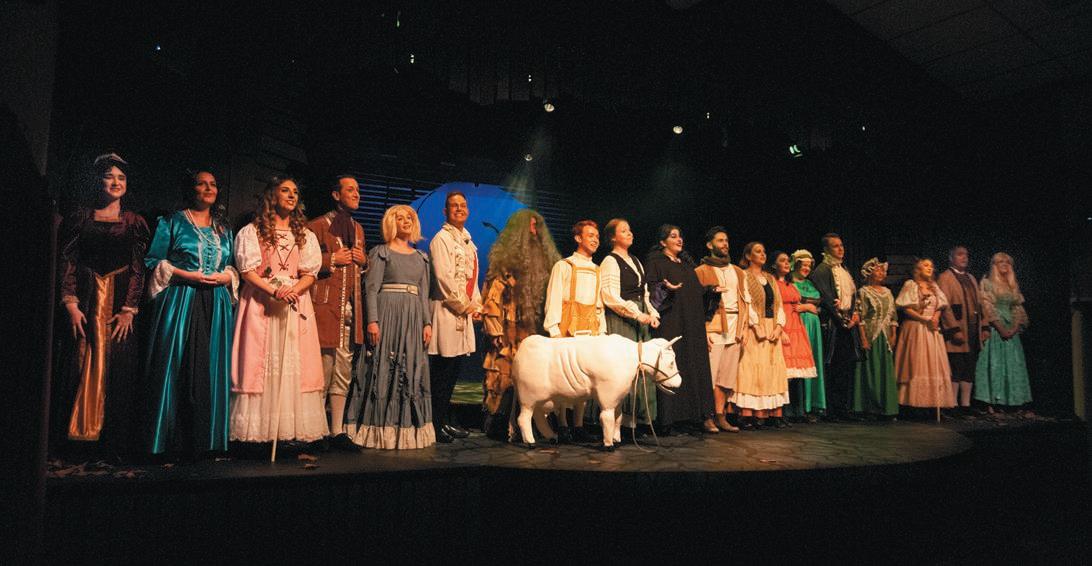
Kimberley Shaw is also Stage Whispers’ tireless Perth reviewer. She could not review her own production, which Breanna Redhead described as “delightfully charismatic”. stagewhispers.com.au/reviews/woods-15
with actors who were still literally dripping. We only managed to complete the one run.
Due to the restrictions, we had to rearrange our tech week rehearsals slightly. We skipped our Monday tech rehearsal, then moved everything back a day. By Tuesday we were allowed full rehearsal capacity although actors needed to be masked when not on stage, as did crew and non-wind orchestra - and we finally managed our first tech and dress.
Council workers worked on the roof most of the week, and we were assured that it was repaired - that the previous weekend had been a ‘once in a decade’ occurrence and that we didn’t need to worry.
After a successful preview that went as smoothly as we could hope, we were looking forward to Opening Night.
Ever the nervous director, I arrived at the theatre in the early afternoon, just to do little jobs and offer any help to front of house.
Around 3pm I was helping committee member Elaine prepare the auditorium. It was raining, so we were occasionally checking the band room ceiling, even though the roof repairmen had been at the theatre
when I had arrived and reassured me that it was watertight. Suddenly we heard a familiar dripping.
Rushing to find something to catch the drips, there was flooding under the doors once more. Within seconds the band room was flooded and although I attempted to get everything off the floor, this time it was simply too fast, especially with only two of us in the building. We managed to build walls to stop the water entering the auditorium, but the band room flooding was deeper, extending through the foyer and toilets. I had sent an urgent message to the group chat - I think it was simply “Help, flood!” - and within a short time we were being inundated by cast, Stirling Players members and their friends.
Despite the efforts of many, we were unable to open that night. We couldn’t guarantee that we wouldn’t flood again, the foyer carpet was completely sodden, we needed to make arrangements to ensure that our orchestra would remain dry and we had managed to drown (and kill) the power source to one of the keyboards.
Thanks to the generosity of others, we were able to open, albeit a day
late. Stirling Council found us two large industrial driers to dry the foyer and sent a magic machine that sucked the bulk of the water from the carpet. The orchestra was kind enough to squeeze into what was essentially a large cupboard on the other side of the auditorium (not at all comfortable), and the Roleystone Theatre (whose own temporary theatre space had flooded that weekend) lent us curtaining to dampen the echo in that space. Having spent the day on an unsuccessful search for a new power source, a plethora of Perth theatre people offered us keyboards, with Taui Pinker driving his beautiful and precious keyboard to us an hour before curtain.
While we remained nervous for the rest of the run, and a team of actors led by our Cinderella, Grace, flood barricaded the theatre between every show, we were lucky enough to enjoy a successful, well received and completely sold-out run.
I am very thankful to have had a cast and team who smiled through adversity, laughed instead of cried and remained kind to each other through a very stressful last couple of weeks. To miss multiple rehearsals and face such major upheavals would break many shows, but this team was simply awesome.
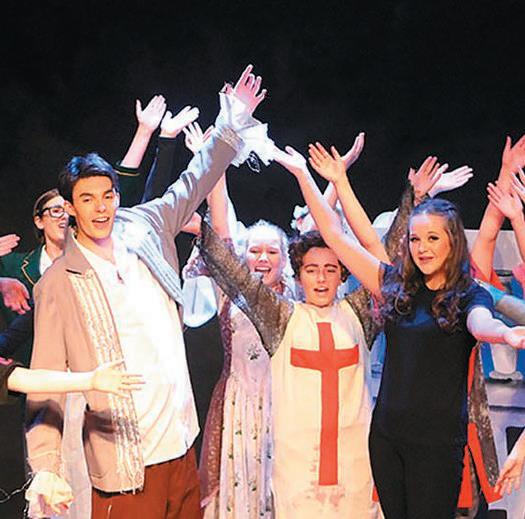
Simon Denver is represented by Maverick Musicals.
This year the company, founded by Simon’s family, was proudly taken over by new owners Rachel Fentiman and Howard Tamplin. Between them they have over 50 years of theatrical experience.
“We believe we have the best job in the industry: helping you, your school or theatre group discover the best play for your needs,” they told Stage Whispers.
“It’s our privilege to guide teachers, directors, producers and everyone in-between, all over the globe, to find that perfect play. We will help you narrow down plays that have the right cast size, theme, genre and whatever else you’re looking for to make your play a roaring success.”
For samples and online rights applications visit maverickmusicals.com
seemed like an impossible journey over a frighteningly short time frame.
Years ago, I read the results of an international survey on fear. The greatest fear facing an individual was not Thermo-Global Nuclear War. Neither was it cancer, terminal illness or extinction-level events such as asteroids, volcanoes, tsunamis or climate change. The eventual winner left them all in its wake. Divorce, losing your job and the aforementioned fears were all in the shadow of the undisputed number one: the fear of public speaking. No wonder the rest of society looks upon performers in a strange way. It's not that we don't have this fear - it's because we have learned to rise above it. And how? Here is a recap of what belonging to a youth theatre, or being in a school musical or play, should teach you.
All theatre is a huge trust exercise. And just as you are trusting everyone will get their bits right, they trust that you will get your bit right. When working to a deadline you don't have time to develop your "relationship" with everyone; certain shortcuts must
be taken. You have to learn to trust your co-workers from the get-go. You forge an effective working relationship with people, whether you like them or not. You must learn to trust early and completely.
The more disciplined and rehearsed any theatre team or ensemble is, the better the result. Getting something right is never easy. If it was easy then everyone would always get everything right. It sounds strange but the more disciplined the rehearsals, the more the team has fun and finds solidarity. It's never a case of learning your place in the team, it's about realising that the team actually needs you and it isn't quite the same without you, and vice versa.
The friendships you make in youth theatre stay with you for life. Why? Because you share that special time that "outsiders" just don’t understand. You were part of a highly emotionally charged project which had what
You soon learn to take a pride in your work. No matter whether you are chorus, lead or backstage you should take pride in your work and strive to constantly be better. A chain is only as good as its weakest link. Your pride in yourself and your project should make sure that this is not you.
Any show is a monumental achievement in its own right. This achievement gives you confidence in yourself. I recently went to a youth theatre reunion. Dozens turned up. One of the common topics discussed over a few refreshing ales was confidence. Many claimed youth theatre had given them skill sets, led by confidence, to guarantee they'd never fail a job interview.
A great skill set to hone. The more theatre you do, especially improvisation, the more you learn to think laterally. Theatre tends to present us with almost inconceivable problems that need us to come up with some incredible solutions. It teaches us how to explore a situation from more than one viewpoint. In short - it keeps you on your toes.

Can one prop alter the mood of a play? Director and writer Jacinta Sciusco believes it can, in the right hands.
Stagecraft is a vital thing. It can add to or detract from a play. The messy, untameable wig; the fake but delicious looking burger; the unbalanced theatre flat; props aim to bring realism to the stage.
A favourite prop of mine made its debut on the stage of a University theatre, where the seats were slightly uncomfortable, but the performance made up for it.
The fake red glow of a cigarette prop captures the eyes of the audience under the stage lights. It’s a quiet moment. Even the audience, sitting shoulder to shoulder in the small black space, feel the frozen energy of the scene. The actor holds the prop between their fingers. This has been rehearsed so many times that even the cigarette knows its cues. Stay still, get picked up, dialogue, dialogue response, someone takes a drag. A beat is taken as the character sucks in a quiet breath, lips pursed and ready to bring the cigarette to their waiting mouth.
It was easy for this cigarette to rocket to fame. It enjoyed a stunning role in the Moat Festival (2019) production of The Drag - inspired by the life and plays of Mae West, adapted and directed by Cole McKenna.
The old, forgotten Facebook event reads: “A party in the 1920s is our window into the lives of New Yorkers and newlyweds Roland and Claire. The play delves into a world of decadence and ruptured mundanity, exploring strained relationships and the pain that comes with having to hide who you are.”
Like many plays at La Trobe Student Theatre, The Drag explored serious topics, centred around LGBTQ+ rights in the 1920s. It’s no question then
that Menzies Theatre housed a meaningful exploration of hiding and emerging, and smoking was a way for characters in The Drag to support conflict and conversations with one another.
Rolly, a married and closeted homosexual man finds a place where he is accepted and free to be himself amongst his gay friends. The cigarette is held by a beautifully dressed drag queen, who holds it up towards her lips throughout the heated discussion. The sequinned glow of her red dress and her bright red lipstick complement the fake flame. She takes a drag. The cigarette plays its role, providing the queen with ease and calm.
The first time I saw it, I was freshly graduated, in my first year of Uni, and astonished at the props, sets, and costumes stored away in the Union Building of La Trobe University. The drama department of my small-town high school, great as it was, couldn’t compare. The array of painted set designs, props from sunglasses to plastic flowers, costume pieces belonging to clowns and businessmen; they all waited there, perched in their places, as if standing silent in the wings of a theatre for the moment they could finally take a step into the light.
In a comedic play about a crashlanded plane, where three vacationers and a pilot get stranded on an island, the cigarette was passed between Elliot and Corbin, childhood friends who never quite grew up. Under the warm lights of the Menzies Theatre, it brought laughter to a crowd of strangers who would, in the years to follow, become dear friends.
Next, my first time directing one of my plays. Any working creative knows how it usually goes; doubt while
writing it, crippling doubt while rehearsing it, and at the end of closing night, the embarrassment of your dear work being perceived. It was an intergenerational commentary on society, culture, and the state of the world, called X and Above. The cigarette was in each rehearsal, each bump in and bump out, always waiting but always ready. Picture a nine to five bank employee, drained to the point of exhaustion, desperately huffing a cigarette during break time.
From opening to closing night, the cigarette had registered the warmth of lights on its surface at the same hour for a week. It had known what it was like to be held, to be placed at arm’s length, and greeted warmly when needed. And as it rested in the still storage room, it began to collect dust. It’s foil flame no longer shone so brightly. It didn’t move in months.
Unbeknownst to the cigarette, it had many siblings scattered under chairs, behind theatre flats, stuck in tiny crevices, long forgotten, and misplaced between bump ins and bump outs. They sit, to this day, waiting to be found, amongst the growing dust of a vacant and distant life.
Passed from fingertips to fingertips, characters take drags to feel like they can breathe. Sometimes they take puffs to look cool at a party.
Sometimes they light up before dropping life-changing news onto those they love. But mostly, they pass the prop between friends, bonding, and they enjoy their time together with one another. And though these cigarettes get misplaced, forever lost, and badly broken, it is in these moments that the audience will remember the shining red glow crystallised in the scene, until the next performance.
Jacinta Sciusco is a third-year creative arts student at La Trobe University, where she studies theatre and writing. She’s a long-time member of the student theatre community where she writes, directs, and acts in plays and performances.